Tower Hill
A VISION FOR TOWER HILL
Q&A with 11th Head of School Sarah D. A. Baker

Honoring the Experience and Expertise of THS Teachers
Centering the TLC as Students’ GPS
Bulletin | Fall 2023

COMMUNICATIONS OFFICE Amy Schrei Director of Communications and Marketing Kimberly Smith Assistant Director of Communications and Marketing Natalie Hobbs Communications Specialist ADVANCEMENT OFFICE Kristin Mumford Director of Advancement and Enrollment Management Laura DiVincenzo Director of Advancement Services Julie Donohue Director of Annual Giving Linda Ogden Administrative Assistant Justin Hicks Associate Director of Alumni Relations Melissa Pizarro Associate Director of Advancement and Interim Director of Alumni Relations PHOTOGRAPHY Jim Graham, Kimberly Smith, Natalie Hobbs LAYOUT Amy Schrei, Kimberly Smith The Tower Hill Bulletin magazine is published twice annually to share how alumni, faculty, staff and students embody the school’s motto Multa Bene Facta, Many Things Done Well. Send Class Notes to thsalumni@towerhill.org with a high-resolution photo. TOWER HILL SCHOOL 2813 W. 17th Street Wilmington, DE 19806 302-575-0550 | towerhill.org HEAD OF SCHOOL Sarah D. A. Baker 2023-2024 BOARD OF TRUSTEES Benjamin duPont ’82, Chair Jack Flynn, M.D., ’81, Secretary Marna Whittington, Ph.D., Treasurer Suzanne Ashley Kimberly Wright Cassidy, Ph.D. Régis de Ramel Robert DeSantis Heather Richards Evans John Gavenonis, Ph.D. Laird Hayward ’02 Henry Mellon Catherine Miller David Nowland ’85 Lisa A. Olson ’76 Matt Plumb Logan Read ’10 Sonal Sheppard Kenneth A. Simpler Genelle Trader ’70 Isabella Speakman Timon ’92 Carmen Wallace ’93 Gina Ward Earl Ball, Ed.D., Emeritus Tower Hill School does not discriminate in its educational, admissions and personnel programs and policies or activities on the basis of race, color, national or ethnic origin, age, religion or religious creed, sexual orientation, gender identity and/ or expression, disability or any other characteristic protected under applicable federal, state or local law. In This Issue Sarah D. A. Baker’s Vision for THS Graduation How the English department develops communicators Faculty Focus Campus Improvements 6 24 38 48 68
On the Cover
 Sarah Baker moved into the school’s house, Hayward House, this summer and looks forward to welcoming the community at events this school year as Head of School.
Sarah Baker moved into the school’s house, Hayward House, this summer and looks forward to welcoming the community at events this school year as Head of School.
Tower Hill BULLETIN FALL 2023
From the HEAD OF SCHOOL
Dear Tower Hill Community,
I am delighted to introduce you to our fall 2023 edition of the Bulletin, an issue of the Tower Hill School magazine that reaches back into our past to celebrate our present and to contemplate our shared future. The theme “Roots and Branches” is redolent with hues of green and speaks to the strength, solidity and reliability of a sure foundation and to the expansive and broadening appeal of new growth.
In short, the pages to follow reflect our community’s pride in its long history of excellence and its desire to stretch and grow out from that place. It was an honor and a joy to begin my tenure as Head of School at Tower Hill this summer and to plan for the opening of the 2023-2024 school year, which is for me the very most wonderful time of the year. Throughout the summer, I had the happy

opportunity to meet with teachers, alumni, parents and students who told me their Tower Hill stories, introduced me to their Tower Hill people, explained what they believed should never change, and explored what they believed should evolve.
Those who have worked closely with me already know that I am a note-taker, rarely without my Tower Hill green notebook and a good pen nearby. I continually reread the notes from my summer meetings, turning individual perspectives in the light and watching for the glint off of the many facets that give each a very specific color and brilliance. While I look for trends and will continue to do so this year as I listen and learn more, I honor each community member for the purity and truth of the experience that Hiller has lived. I am grateful to those who have shared with me and to those who will do so.
2 Tower Hill Bulletin Fall 2023
Sarah Baker, her husband Scott Adams and children Cover ’36 and Alice are grateful to place Tower Hill at the center of their lives. The photo above was taken on the porch of Hayward House this summer.
The students and faculty featured in the pages you will shortly read are sources of great pride for this school, both for the talents that they share so generously and for the spirit of mentorship that they evidence—core to who we are. We share one roof, something that is rare, even in the independent school space. Those students and faculty within our one school building live in a community of constant collisions. Fresh eyes meet veteran gazes. New ideas meet tried and tested strategies. Today’s traditions, which were yesterday’s innovations, meet tomorrow’s hopes. You will read about all of that here, and if it has been some time since you have come to campus, I hope that you will come back to experience it anew.
As we continue a strategic planning process this fall, the crossroads of who we always have been, who we still are and who we seek to be feels like exactly the place to stop and look around. Our strategic planning committee has devoted itself to recognizing the core character of our school as it has considered how that character can be reinforced by strategies that meet the contemporary needs we face. Working groups focusing respectively on academic excellence, faculty, community, place and space, and financial stability have sought to foster the growth of the branch while taking good care of the roots. Priorities for the group have been honoring our tradition of Multa Bene Facta while leaving space for students to dive deeply into discovered passions; providing a nourishing and enriching work environment for faculty and staff; creating senses of belonging for all in our community; and building a physical plant and a financial model that is mission-driven,
mission-sustaining and can stand the test of time. For a timeline that explores the upcoming stages in the strategic planning process, please see below.
Having closed our 2022-2023 school year in a strong financial position, details about which can be found on page 76 in a report by our CFO Eric Norman, we are fortunate to be taking action now even as we are planning for tomorrow. Major campus improvements are underway, and a number that were started this summer have already concluded with beautiful results. While you can see some progress photos on pages 68 and 69, I hope that instead you will visit with us over Homecoming Oct. 13 and 14 to experience our gleaming new facilities firsthand.
Please enjoy this issue of the Bulletin, taking care to note the smashing success of our Class of 2023 in its college admission process. These young alumni have settled into dorm rooms all over the nation in the last few weeks. It is my fond hope that they have brought with them from 17th Street confidence in their own capacities and an inclination to reach out a strong hand to another who needs it. Indeed, having shared the Upper School halls with these students for their junior and senior years, I can tell you that I believe in them and that they make me believe in us.
True to Tower Hill, Sarah

3 Tower Hill Bulletin Fall 2023
STRATEGIC
Strategic Planning Committee meetings (Sept. 2023) Update to Board of Trustees (Oct. 2023) Community engagement (Oct.-Nov. 2023) Board adoption of plan (Dec. 2023) Launch new strategic plan (Jan. 2024)
PLAN TIMELINE
Around SCHOOL
Middle School Fair
New York Trip
The Middle School Fair is a fun end of year tradition that brings our older and younger students together and fosters the student community across grades. This year’s fair included games, snacks and a petting zoo. Seventh and eighth grade students set up games for the fair, and fifth and sixth grade students helped guide their younger counterparts around the event.
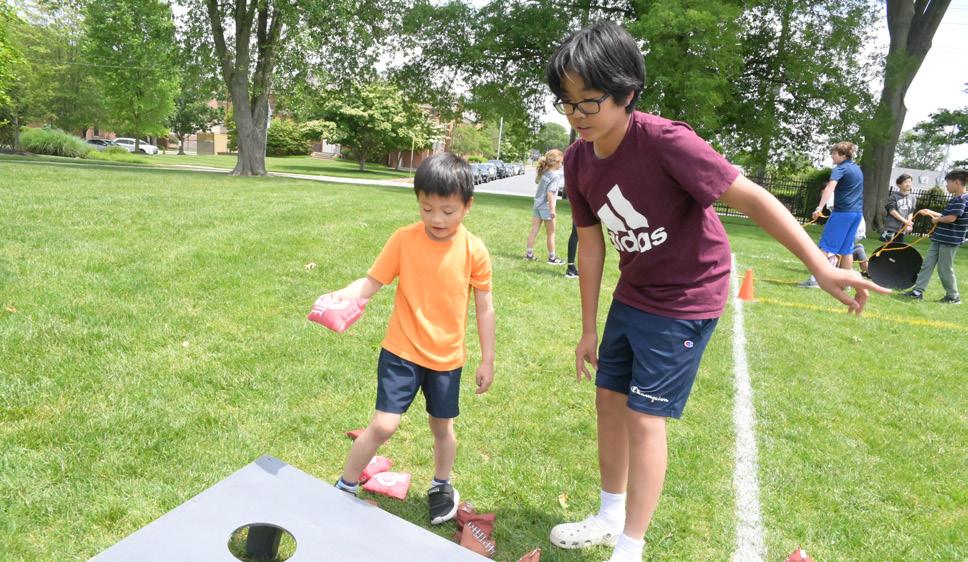
On April 28, members of the senior class along with faculty advisors and teachers traveled to NYC, where they took in the glorious New York skyline and sites from Top of the Rock. They spent time in Central Park and the surrounding area before touring the Metropolitan Museum of Art. They saw The Play that Goes Wrong! It was a long trip filled with terrific memories for friends and classmates.
Australia Exchange
A group of seven THS students participated in an exchange program with St. Catherine’s School in Melbourne, Australia. They spent three weeks with host families in Australia, attended classes at St. Catherine’s and made lifelong friendships. Tower Hill hosted seven Australian students and their chaperones in April. A reception was held for all the participating students, their chaperones and THS host families. The St. Catherine’s students spent time with Lower Schoolers teaching them about Australia and helping them learn about other countries and cultures.
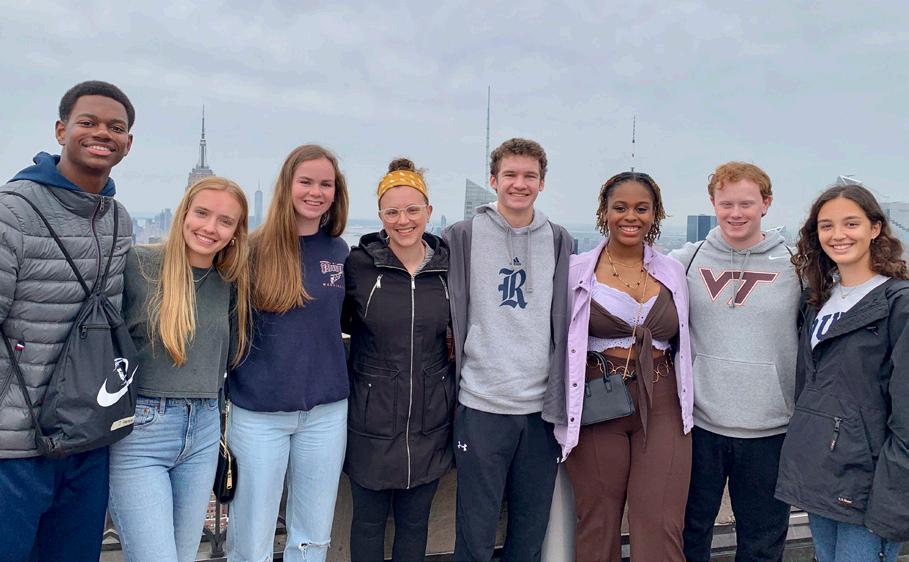
Sea Turtle Bake Sale
The Tower Tots raised $400 with their Sea Turtle Bake Sale. The funds supported The Gumbo Limbo Nature Center in Boca Raton, Fla. The sale concluded their curricular unit on sea turtles. The students ran the sale and sold the treats to their Middle and Upper School peers.

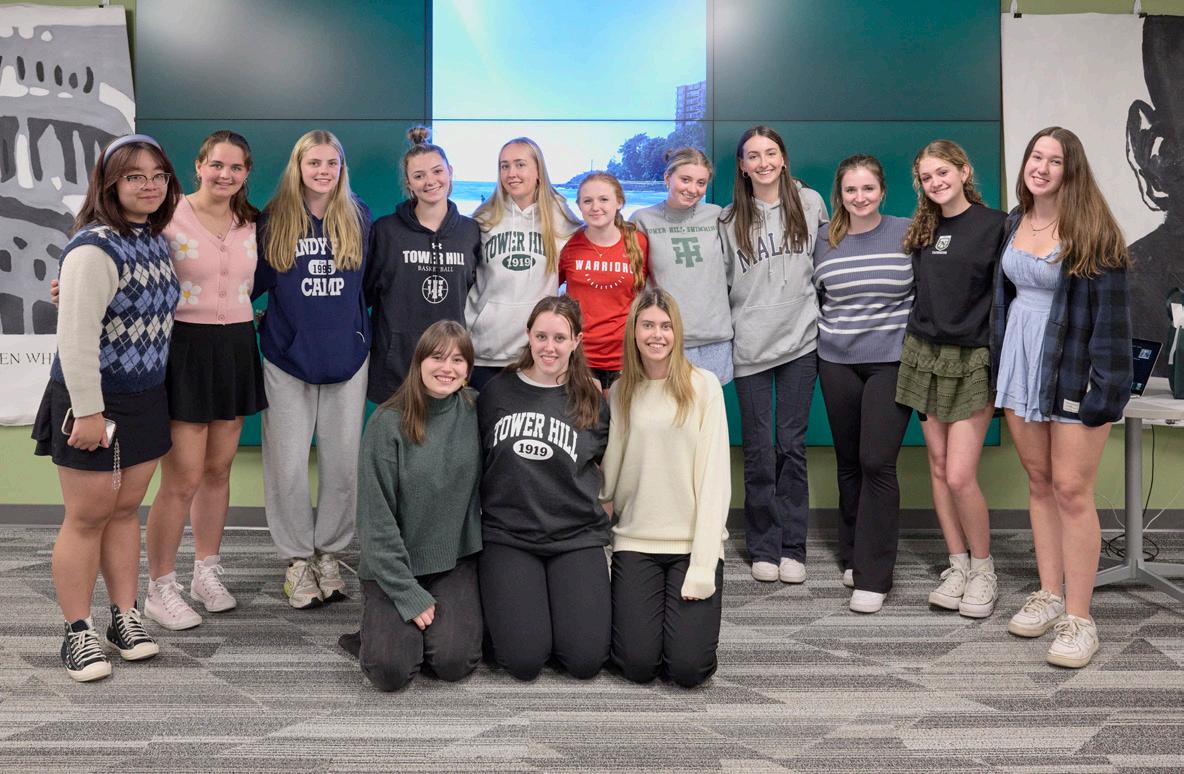
4 Tower Hill Bulletin Fall 2023
Middle School Gift of Service Week
Middle Schoolers engaged with service learning for a week this spring. The fifth grade, under a theme of growing literacy, had “Poetry Slams,” decorated bookmarks, made literary art, forged a bond with Lower School readers and supported the West End Neighborhood House. The sixth grade celebrated all things dogs. The students baked dog treats for the Delaware Humane Society, learned about service dogs with Paws for People and offered pet portraits to benefit the Delaware Humane Society. The seventh grade had a bike theme. They helped pre-K students learn to ride bikes on the track and learned about adaptive bikes with a visit from Fusion Racing. Eighth grade focused on environmental service by preparing our outdoor classroom for planting, sanding and painting the mud kitchen and art tables, and also took an environmental trip to Rockford Park next door.
Latin Day
The annual Latin Day was held at Upland Country Day School this year and included students from Tower Hill, The Independence School, Sanford School and The Tatnall School. Multa Bene Facta in action!
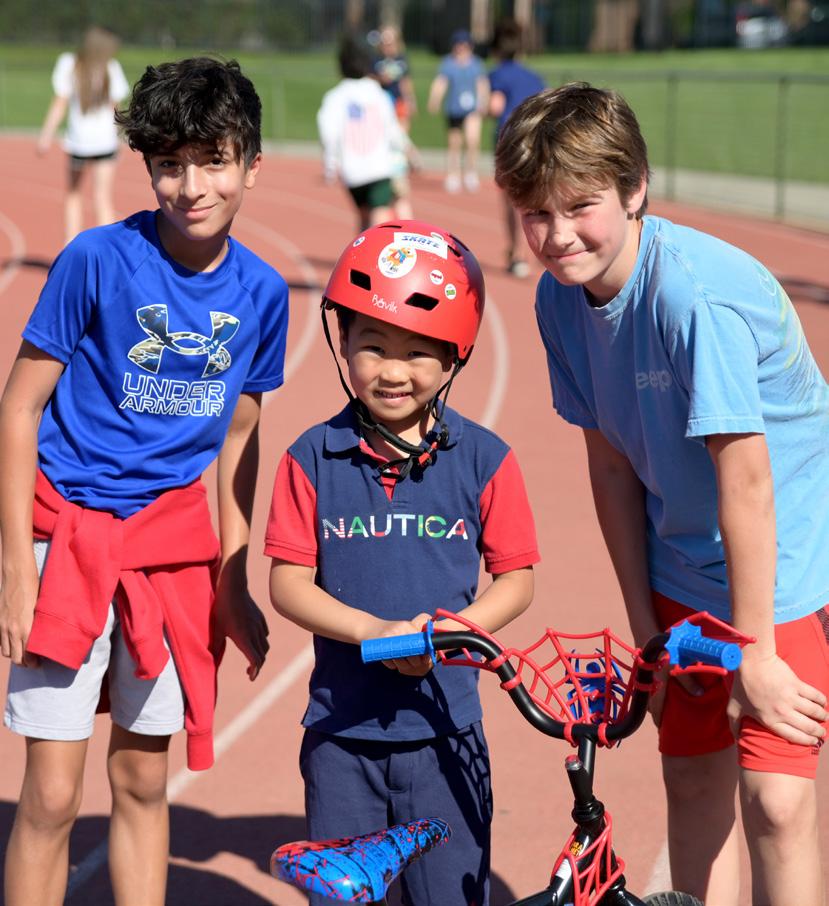
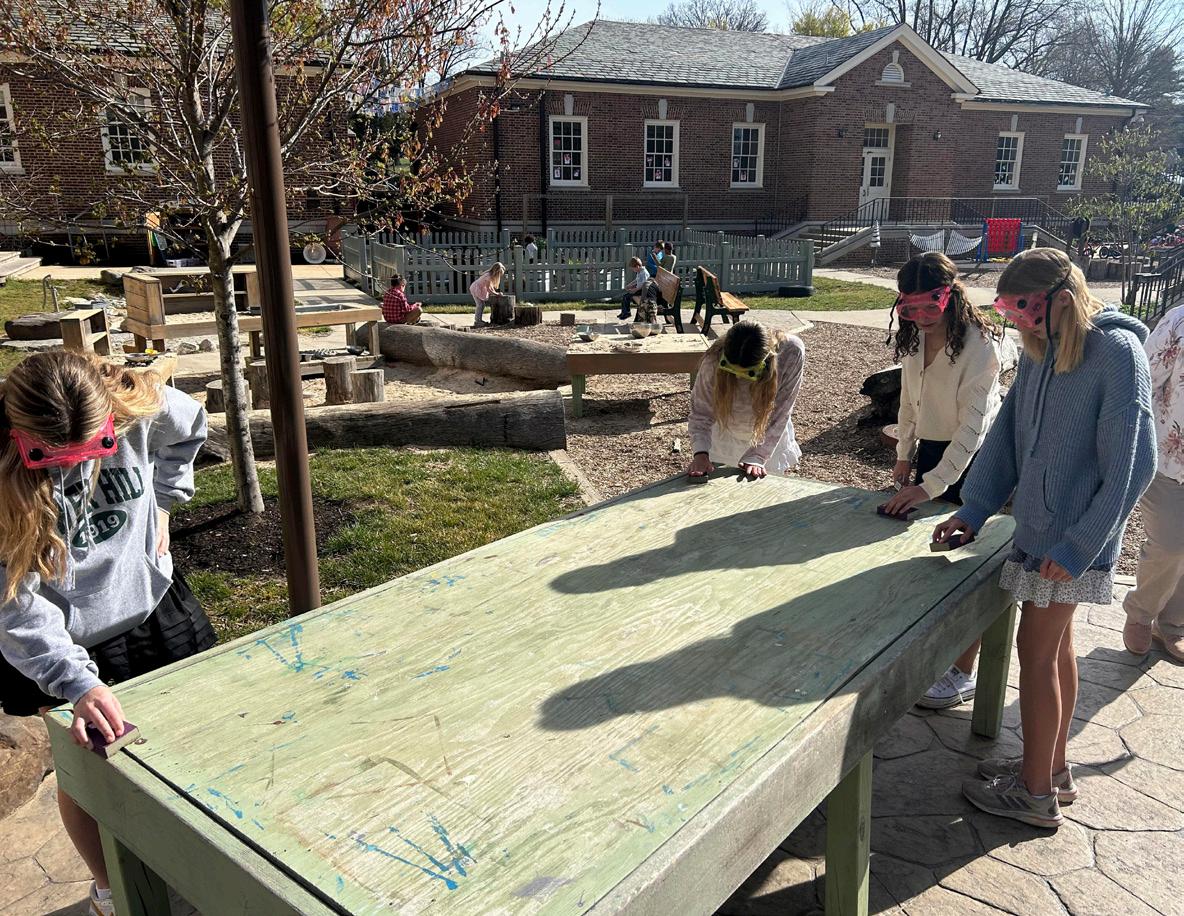
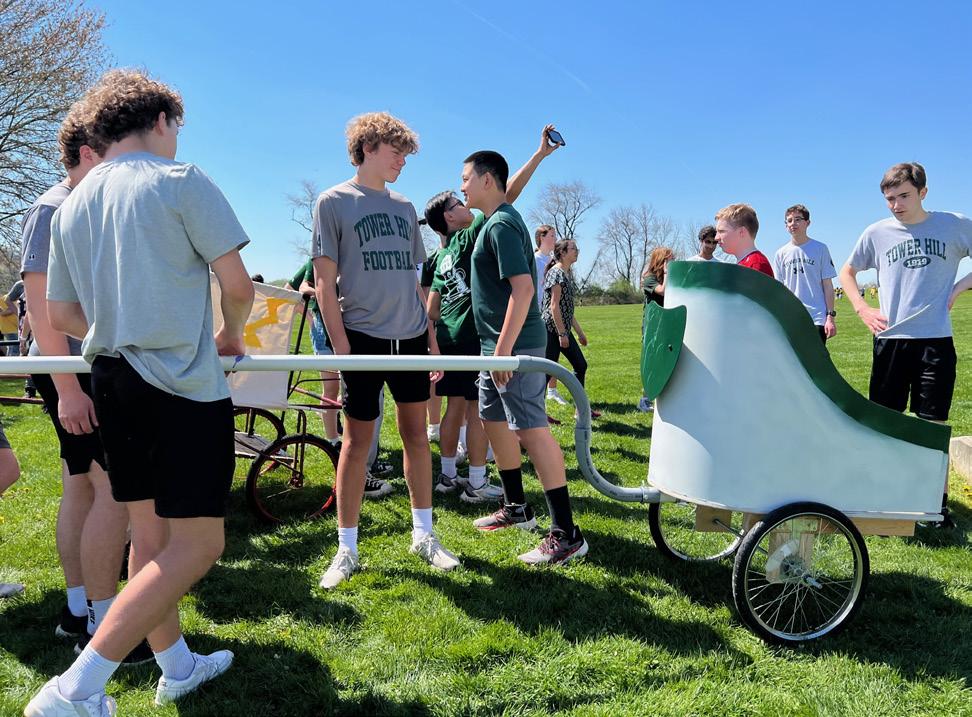
Olympic Panel Discussion
Ahead of the 2nd Annual Bob Behr Invitational track meet, Tower Hill held The Bob Behr & Friends Olympic Panel Discussion for community members and supporters. The Panel included Olympic Trials Qualifier Danielle HobsonLynch (right), Olympic Gold medalist Anthuan Maybank (center) and Olympian Steve Brown (left). Tower Hill School alumni Ginger Smith ’66 and Curtis Smith ’99 were also recognized during the evening.
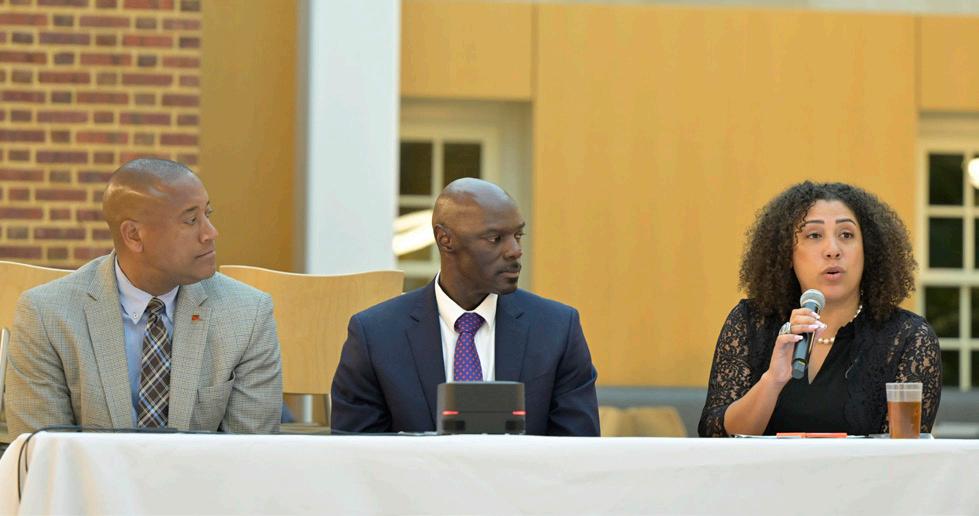
5 Tower Hill Bulletin Fall 2023
ROOTS AND BRANCHES
SARAH D. A. BAKER’S VISION FOR TOWER HILL
BY MAURA C. CICCARELLI, FREELANCE WRITER
Tower Hill School Head Sarah Baker on the vocation of teaching, the impact of an independent school and its community and the future of Tower Hill’s unique “Green Zone” where students and staff thrive.
The roots of Sarah D. A. Baker’s belief in an independent school education go deep. She grew up inspired by devoted teachers at her independent school alma mater. As an educator herself, she is committed to her life’s work of not only teaching academic skills to and sharing knowledge with every child, but also striving to build the kinds of environments that instill in students the “raw joy of learning,” the capacity for focus and an inherent confidence in their own abilities and value.
“I believe in Tower Hill so deeply,” says Sarah, who became the 11th Head of Tower Hill School in its 104year history this summer.
When she joined Tower Hill as Upper School Head in 2021, she was immediately impressed by how the school believed in and was living its mission and its motto, Multa Bene Facta—many things done well.
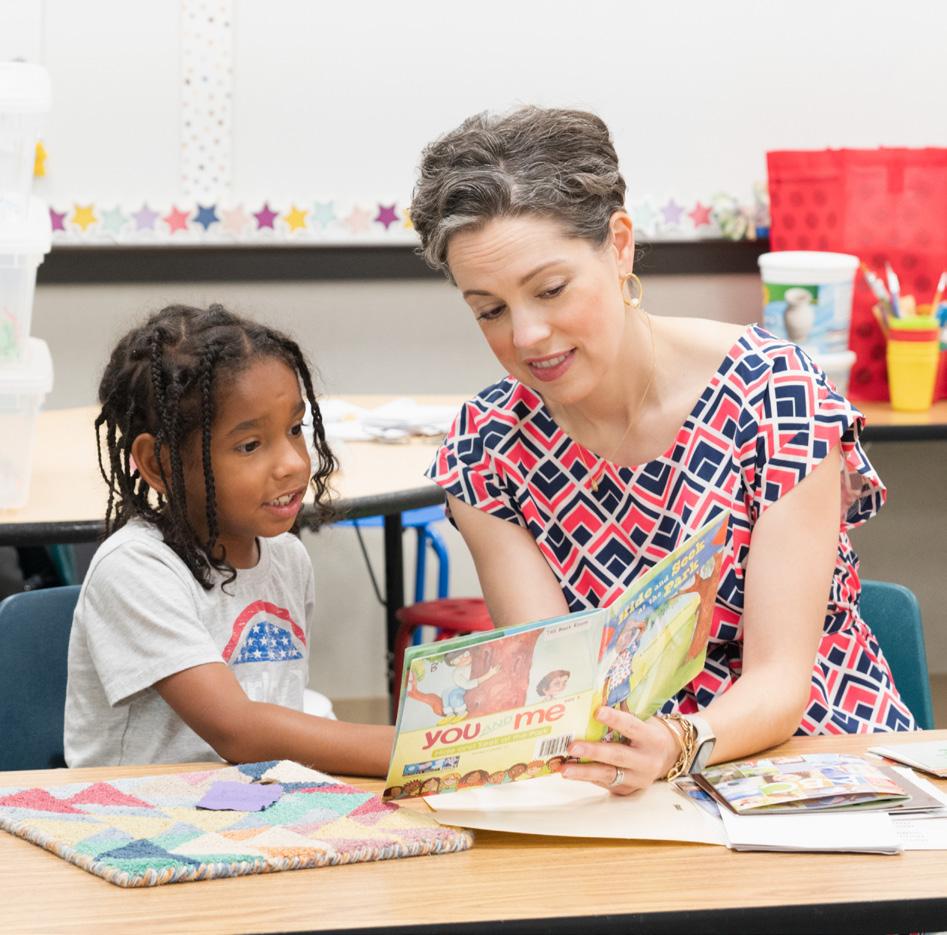
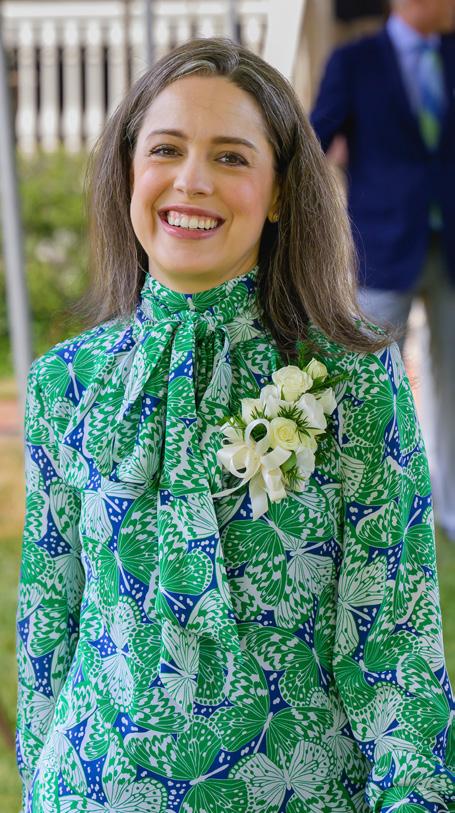
“I could tell that this was a charactered place,” Sarah says. “Ultimately the question of whether to relocate my family to pursue this new opportunity came down to where my husband, Scott, and I would want my son Cover and daughter Alice to be educated and, in a real sense, raised. We want our children to have access to the kind of Renaissance program that we offer at Tower Hill so that they can discover and develop their gifts. We chose Tower Hill as parents first.”
The school’s educational philosophy resonates with her own, in which she shares the following:
“Students should graduate believing that they are valued and valuable participants in a communal and global effort to understand better and more. A student who has cultivated this identity has learned not only to live in the world but also to appreciate it and its people, to question it and its conventions and, moreover, to strive to improve it and its ethos. The student has learned to live an ‘examined life’ in the service of self and others and in deference to the beauty of ideas and of progress.”
6 Tower Hill Bulletin Fall 2023
Branches of a career in education
Baker started her education at The Episcopal Academy in Merion, Pa., where she was a “lifer,” attending the school from kindergarten to grade 12. Although she then went on to Duke University considering a career in law, the family business, she decided after hearing a perspective-shifting sermon one morning in Duke Chapel to follow her heart toward teaching. She eventually earned a B.A. in History, with a minor in Latin and Developmental Psychology and took her first teaching job as a Middle and Upper School Latin and History teacher and cross country coach at The Agnes Irwin School in Rosemont, Pa., in 2005.
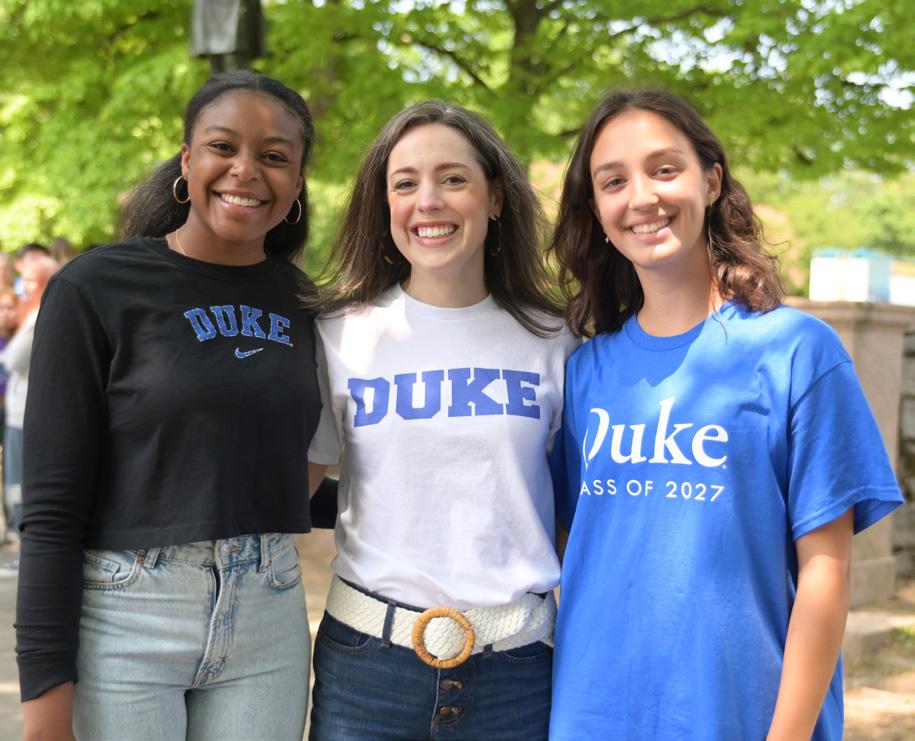
In 2007, Sarah’s alma mater was launching a historic capital campaign, and she returned to Episcopal to assist in coordinating and fundraising for that effort. While these were her primary responsibilities, she insisted on teaching and advising, too, and did so in the Upper School, where she taught Pre-modern History and literature courses and served as an advisor.
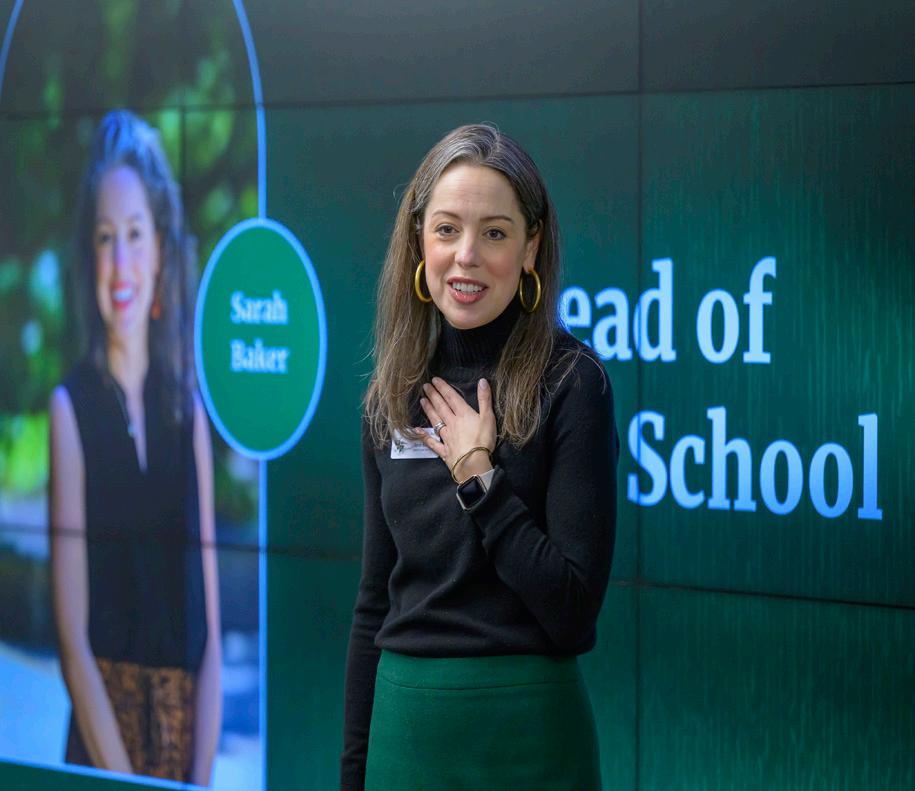
After earning her M.S.Ed. in Educational Leadership in 2010 from The University of Pennsylvania and with the conclusion of the campaign, Sarah left Episcopal’s Development Office to serve as a Form Dean in Episcopal’s Upper School. Four years later, she moved from this role to become English Department Chair at the school. She taught throughout this time.
Nine years into her career at Episcopal, Sarah met and married her husband Scott Adams, and the two of them, Philadelphia natives who had spent most of their lives on the Main Line, decided that it was time to learn from a new experience elsewhere in the nation. Sarah launched a national search
for an administrative post, and the couple landed in Richmond, Va. For five years prior to coming to Tower Hill as Head of Upper School in 2021, Sarah served as Assistant Head of Upper School at Collegiate School in Richmond, Va., where she also taught Advanced Junior and Senior English. For the past decade, in addition to her independent school teaching roles, Sarah has served as an associate instructor in the School Leadership program at University of Pennsylvania’s Graduate School of Education, helping develop the next generation of independent school leaders. Her focus is on best practices for literacy instruction, models of mentoring systems that encourage institutional growth and effective crisis communication in schools. She also mentors one student each year in their work in the program, serving as a coach for their internship work and a guide for their research and writing.
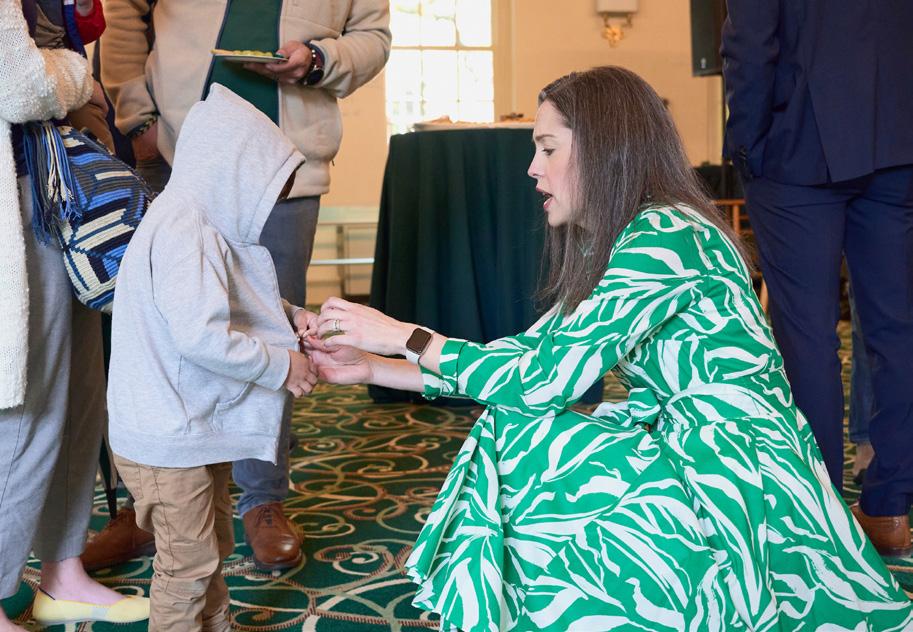
ROOTS AND BRANCHES
7 Tower Hill Bulletin Fall 2023
Photos: (opposite page left) Sarah processes into graduation. (opposite page right) Sarah spent time with students in the Horizons program this summer and worked with them on literacy. (above left) Every spring, seniors wear their college shirts, and faculty and staff are encourged to join in for community building. Rising Duke freshmen Cameron Haskins (left) and Amelia Gregory (right) share a picture with Duke alumna Sarah Baker. (above top right) Sarah helps XYZ with his jacket during the spring Meet & Greet with the 11th Head of School. (above bottom right) Sarah speaks to incoming Upper Schoolers at the new student reception.
Q&A WITH SARAH BAKER
BY MAURA C. CICCARELLI, FREELANCE WRITER
In an interview this summer, Sarah shared more about her background, vision, and joy as she takes the helm at Tower Hill as its 11th Head of School.
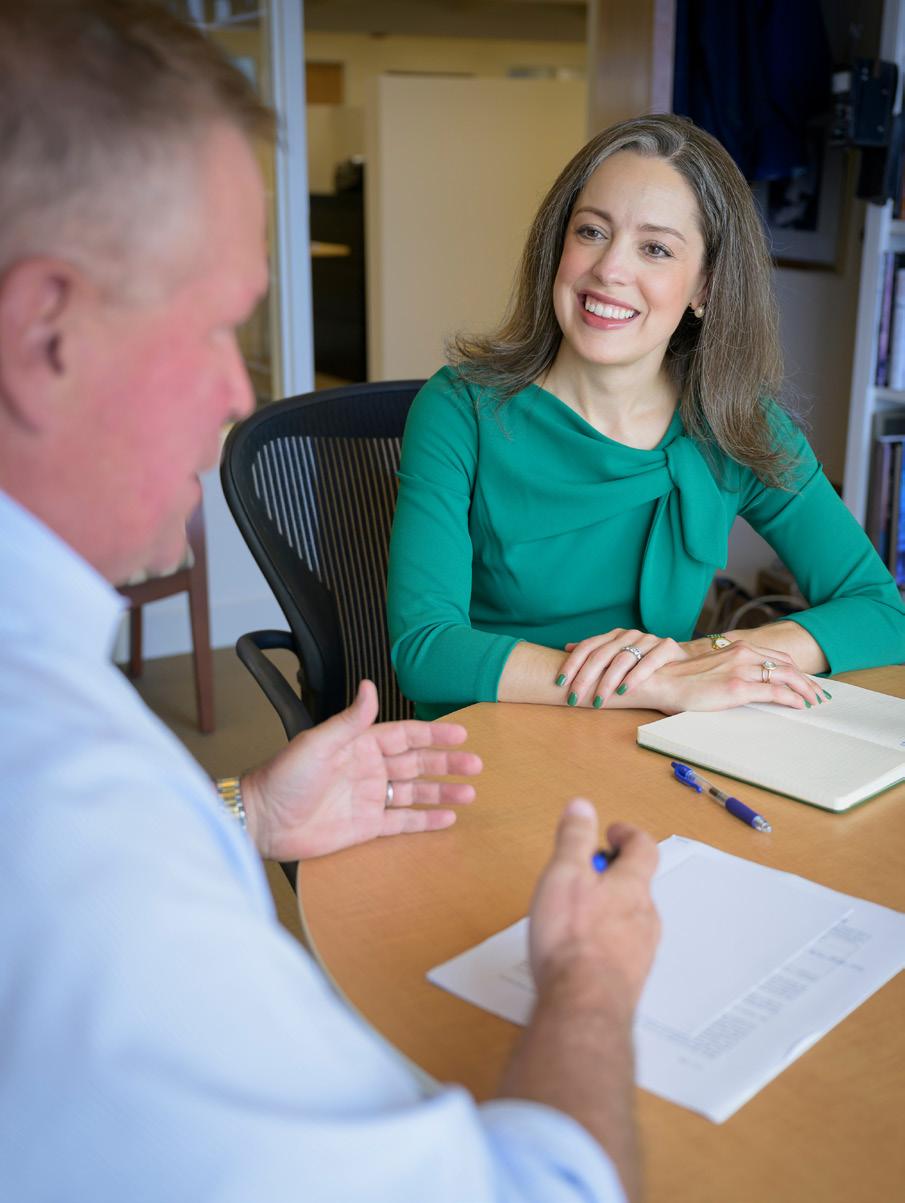
had a deep and enduring impact on me. Kids are honored by our genuine interest in them, and they feel like they have something of value to say if we let them see that we think that they do. So that is something I wanted to live my life doing as it was done for me.
Teaching feeds me, especially when listening to my students talk about literature. But my favorite thing about teaching is the extraordinary act of challenging young people with expectations that are high enough to inspire their growth and providing support that is solid enough to foster that growth. Master teachers assess students’ gifts and talents and build programs that cannot help but cultivate those gifts.
There is research out there that if a teacher says to a child, “my expectations are this high because I know you can meet them,” student performance will rise above where it would have rested without this encouragement. And of course this extends to human motivation across settings and activities, not just to classroom environments. This just makes sense.
Tower Hill teachers do a beautiful job of coming alongside students, never doing the work for them, but providing them the resources they need to achieve what they might have considered to be unachievable. Our teachers don’t believe in the unachievable. That’s the kind of life-defining confidence-building that comes from a trusted teacher who expects greater things from you than you expect from yourself. That’s paradigm-shifting for kids. It has always been my greatest privilege as an educator to be this particular force for good in the lives of students, and it has been my greatest privilege as an administrator to direct my efforts toward providing faculty the support they need to live into this role for their students.
Q: What drew you to independent school education as a profession?
A: Young people are fascinating human beings, and they teach us more than we teach them. With their fresh eyes, they see things that our eyes don’t and hear things that our ears don’t. My five-year-old son is far more incisive than most adults. He can get to the heart of something right away. Most parents, I believe, have this realization as they raise their children.
I had teachers, particularly one English teacher at Episcopal, Mr. Spear, who really wanted to understand me, my peers and our perspectives. I could tell that we students were genuinely fascinating to him and that
This good work grants us a great gift at the end of every year. We sit at graduation and look out over this group of young people, most of whom have been at this independent school for a long time, most of whom we have sat shoulder-to-shoulder with, and we think, “I knew they could do it.” It is important to me that the graduates, too, can look out over a sea of their teachers—from the youngest years to the oldest—to remember their journey and mark their gratitude. It is my job as Head, and my team’s job alongside me, to create an environment that supports long tenures and honors the importance of them. The student’s journey is meant to be shared.
8 Tower Hill Bulletin Fall 2023
Throughout the spring and summer, Sarah engaged deeply in the work of transition with Board Chair Ben duPont ’82, as pictured above.
At this spring’s awards ceremony, as senior after senior earned awards for growth and achievement, I noticed that one of our preschool teachers, Theresa Shorey, was occasionally standing up as she clapped. It was for her kids, the kids she’d had when they were four. I’m going to get emotional thinking about it. This teacher taught those kids how to form letters, how to treat their friends and how to count. And now Department Chairs are up there, reading awards presentations that say they moved from concrete levels of thinking to the abstract and, for example, that one young woman blew us away in the sciences or one young man designed and programmed the complicated stage lighting for all our shows. That preschool teacher was the reason this happened, and she was there to see the fruits of her and her own colleagues’ labors.
Q: What was it about Tower Hill that made you want to be Upper School head and now Head of School?
A: Our motto is Multa Bene Facta—many things done well—and we live it. I think it is important to be clear about what we mean when we say Multa Bene Facta. The motto is not Omnia Bene Facta—all things done well. Children are discovering their passions and joys. As faculty and administrators, we need to be the best at what we do—rigorous academics, highperforming athletics, soulful arts and character education through mentorship—so that they can be really good at whatever they choose. And they need continual exposure and encouragement to cultivate talents they know they possess and uncover those that lie hidden. The world is encouraging specialization too early, which I think is to the detriment of overall growth. We help our students write their stories and hone in on their gifts, but we do it in the context of openness to continual learning and change. It was Emerson who wrote, “The voyage of the best ship is a zigzag line of a hundred tacks.” In this world, we must sail confidently, and we must not be afraid to tack.
I should also note that I love building teams and I read a lot about how to build effective teams. Ultimately, this is a team of over 150 people. This includes every teacher and every staff member contributing to the delivery of this program to our students. That means taking a systems approach. We need to see how every element of the school from the communications office to the Lower School and the health office and indeed how all that we do contributes to who we are as a community and to serving every child. That’s always been of deep interest to me. For some time, I have wanted to be able to serve an institution in this way. But I wanted to wait for the right school that truly aligned with my own philosophy, as I think that is a critical synergy that
cannot be manufactured.
One of the things that makes this place different from others is that we have 3-year-olds through 18-yearolds in one building, which is the heart of the school. There’s connectivity that exists between the 3-yearolds and the 11-year-olds and the 14-year-olds and the 18-year-olds. They’re using the same physical plant and are crossing paths continually. My son knows the seniors’ names. And they know him. We are a small community and a small world.
This spring, I kept being reminded of all that I have read and so many of us have heard about the “blue zones” around the world where people live the longest, happiest lives. We know that this has to do with food and air quality and things like this, but it also has to do—it has been proposed—with a sense of purpose, community and social connection. Tower Hill should be called a “green zone” for its insistent focus on belonging, on becoming a place where community connectivity is fostered by all community members seeing themselves in the school, feeling that their dignity is honored by the school and that they are valued by and matter to the school.
Q: What is your philosophy as an academic leader?
A: I believe that academic leaders are here to model the kind of optimism, expectation, support and deep belief in the greatness of what we are all doing together that we want to see—and we do all see at Tower Hill—in our classrooms for our students. Every student and every teacher and every staff member is on a journey, and our job is to make sure that what the school does enables and facilitates growth.
Folks will see this reflected in The Teaching and Learning Center (TLC) under the leadership of Dr. Kelly Hunter. She refers to that committed group of learning support professionals as a GPS system, which helps students access support and, eventually, to learn the way without relying on directions. We are dutybound to equip our students for what they will need at the next stage, which for our students is learning at the next level in college. I have great faith in this school to accomplish that for every learner under this roof. Kelly and her team are critical to that goal.
I should note that while I have stressed that we are here to sit in the space of curiosity with our students and help them to discover new joys and pursue those passions they already know fuel them, this is equally true as to our duty to our teachers. Our teachers will serve our students best and will experience their work as most fulfilling if they themselves are always growing. I believe in fostering a culture of fearlessness
9 Tower Hill Bulletin Fall 2023 ROOTS AND BRANCHES
in trying something new, devoting yourself to something unforeseen, and following our motto, which should also mean for adults that we won’t define ourselves too soon and will leave room for the joy of discovery.
Q: Can you give us insights into the school’s strategic planning process, which is now underway?
A: When it is at its best, strategic planning is a deeply collaborative community effort between students, faculty and staff, trustees, families and administrators. Our process was well designed and began last fall by gathering insights in listening sessions to inform the structure of and ideation around the plan. Throughout the year, focus groups of collaborators from across the school met to discuss what was gleaned regarding the school’s strengths and opportunities, as well as to set goals for the academic program, faculty and staff support, cultivation of community, and physical plant and financial stewardship. This fall will be a critical time for us to socialize and collaborate broadly again, as a community, to ensure that we have a plan by January 2024 that we can all feel invested in and deeply good about.
This magazine’s theme of “roots and branches” hints at how I am feeling about this process. We are not designing an about-face. In fact, the final plan will begin by stressing who we have been and are and what about that won’t change. This institution is a storied one with a long history of greatness, and our job is to build on that tradition of excellence with current and contemporary forces, needs and imperatives in mind.
Our core function is to help our students map—and remap—their journeys, and with the assistance of trusted Tower Hill School guides, reach a destination that convinces them of their own power. As we consider our growth, it will be important to hold fast to our motto, our mission and the sort of one-roof experience that makes this place so special, as well as the core sense of belonging that can be affirmed for every community member in such a place as this.
Q: Can you share a little about your personal life?
A: My family is the core of who I am, and I am lucky to say that I found and married my best friend at age 30, even though we’d grown up around the corner from each other but had never met! My husband Scott and I have a five-year-old son, Cover, and a two-year-old daughter, Alice. Most of our favorite pastimes revolve around food—shopping for it, cooking it or planning expeditions to new gastronomic destinations. My son’s favorite dish is
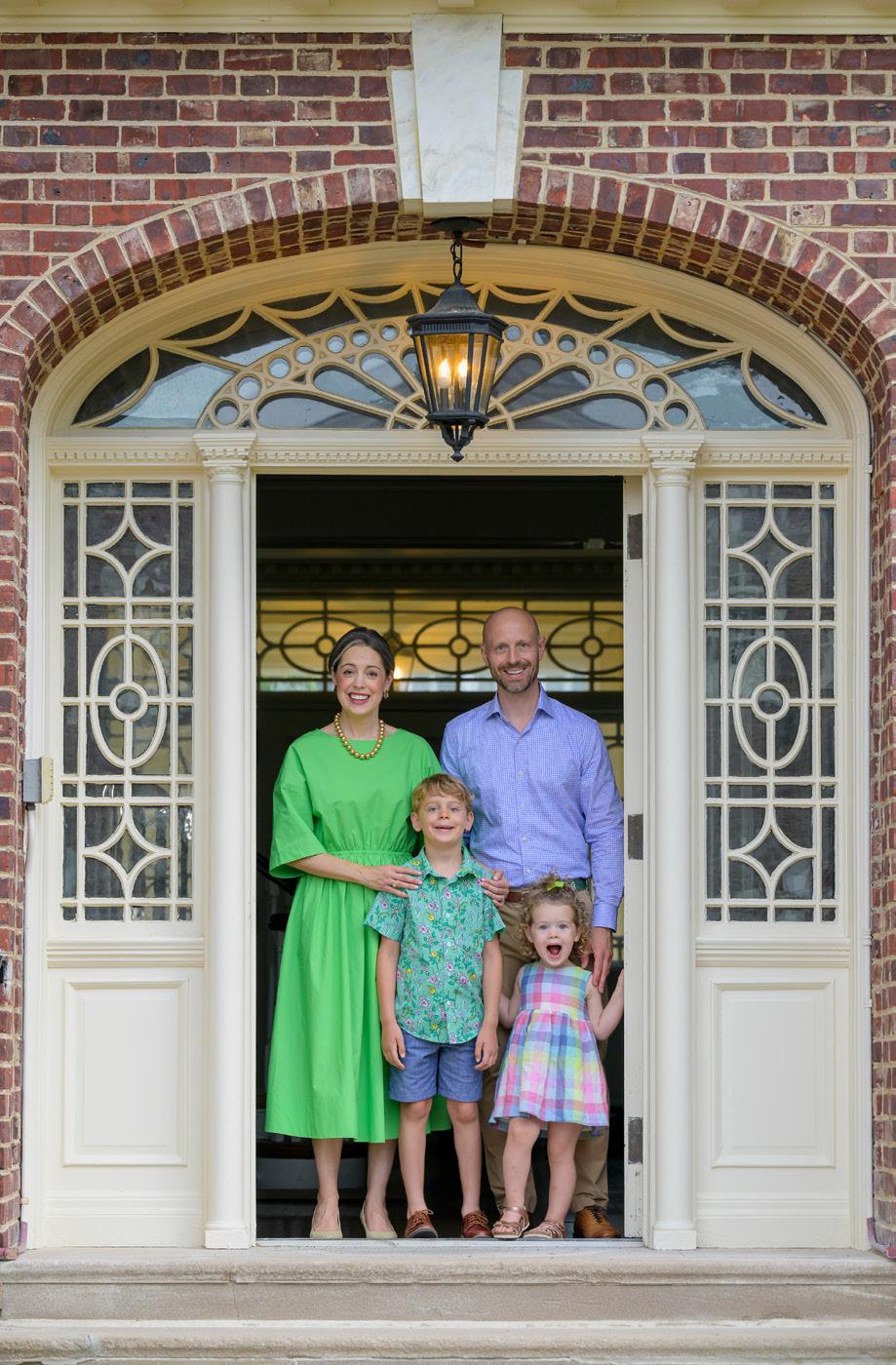
escargots, if that gives you a sense of things! This summer we went to The Netherlands, and we discovered a new food culture entirely. My husband’s sister runs a restaurant in Amsterdam, so we were lucky to have the inside scoop!
I love to swim and practice yoga, and I set myself a goal of reading one book each week, which I actually share in the signature of my emails. It gets great conversations going, and I get my best book recommendations from those conversations. I don’t always attain my reading goal, by the way, but again, there’s real power in high expectations even for oneself! I am usually reading three books: a piece of fiction, one of nonfiction and one focused on food. We are fortunate to live near our parents, who are on the Main Line outside Philadelphia, and so grandparents are deeply woven into the fabric of our lives. Most weekend mornings involve pancakes and playing with one grandparent or another. And last but not least, I was raised a Michigan football fan and a Duke basketball fan, family schools for us. To call us fans may in fact understate it. These affinities, like that of our loyal alumni base to Tower Hill, are simply unbreakable.
10 Tower Hill Bulletin Fall 2023
BRANCHING OUT
BY MAURA C. CICCARELLI, FREELANCE WRITER
Learn the stories of six of our teachers, who share their educational philosophy, how their own teachers and their school colleagues influenced and enriched their careers, and what they love about teaching at Tower Hill.
Michelle Kennedy Coulter Lower School Teaching and Learning Specialist
At Tower Hill since 1992
For more than 30 years, Michelle Coulter’s career passion has been teaching elementary school students, mostly from prekindergarten to first grade. Last year, she became a Lower School Teaching and Learning Specialist, working with kindergarten to fourth grade students and their teachers to support learning, particularly in math.
“I really seek to teach for meaning,” Coulter says of her personal teaching philosophy about math. “One of my main goals is to make sure students understand deeply, rather than just follow a series of steps or procedures without thinking.”
One example is teaching the base 10 system with blocks so students can physically regroup numbers to perform an operation. The number 42 can be thought of as four 10s and two ones, but can also be represented as 30 and 12.
“Understanding the number makes it easier to comprehend the process of regrouping, as well as learning to calculate in your head,” she says. “It is also important to share thoughts and ideas, recognizing that there may be only one answer but many ways to solve.”
Coulter joined Tower Hill in 1992 after earning her bachelor’s and master’s degrees in teaching from Tufts University, with certifications in early childhood and special education. Along the way, she served as assistant and co-director of Tower Hill Summer Sessions for five years and then, for four years, as assistant director of admissions.

Recently she’s enjoyed being a “next door neighbor” with fourth grade teacher Melinda Martin.
“She has so much to share with me and I appreciate that greatly,” Coulter says. “Melinda held leadership positions at international schools. She has talked to me about ways to run committee meetings or strategies to help other teachers get into the conversation and pull together on the same cause.”
In addition to getting “really excited” together about the topic of mathematics, Coulter says, “We both understand and push each other and help each other move forward in a way. As a teacher, I always want to be learning. We are continually sharing resources such as online websites, articles and tidbits we learn on podcasts. Collaboration benefits teachers, which, in turn, benefits the students.”
She’s also enjoyed spanning all the Lower School grades. “To be able to witness that kind of growth is remarkable,” she says. “They’ve grown and matured, but their unique personalities are still there. It’s fun.” What she loves most are the “aha” moments when students say, “I get it now.” “That’s very rewarding,” she says.
Melinda Jo Martin
Fourth Grade Lower School Teacher
At Tower Hill since 2021
Fourth grade teacher Melinda Martin’s career has spanned the globe but the challenges of living abroad during the COVID-19 pandemic made her want to be closer to family. The Tower Hill job was the perfect community, academically and personally, for her to join.
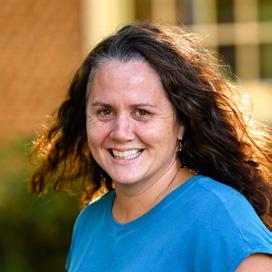
Martin’s career journey began in 2003 after earning her bachelor’s in human development from Cornell. She taught English at language schools in South Korea and then Taiwan, taught first aid training for primary schools in Southern New Zealand, and then became a fifth grade teacher at Kaohsiung American School in Taiwan. Next, she became a grade 5 team leader at International Academy - Amman in Jordan and pursued her master’s from SUNY Buffalo in multidisciplinary studies with a focus on educational technology and information literacy. She was the primary program coordinator for the International Academy - Amman before coming to Tower Hill in 2021.
“There’s such a rich culture of living and working overseas, which is completely different than traveling,” she says. “All the schools where I worked had a very large percentage of teachers who were local. The relationships I had with these teachers and my host families were just pivotal. I continue to maintain those contacts to this day.”
At Tower Hill, she’s become close with the fourth grade teaching team as well as learning specialist Michelle Coulter, who has been at Tower Hill for more than three decades. With offices right next to each other, it’s easy for them to “geek out about” some of their mutual academics, such as teaching math fluency.
“One day Michelle had talked on the phone to an expert in that field, Dr. Nicki Newton, and she told me about it. Her eyes were on fire and she said, ‘I had to come and tell you because I knew you would get it,’” Martin says.
The collaborative approach taken by the fourth grade teaching team “reminds me of the old fashioned, tight-knit small town where I grew up,” she says. “The school has a strong sense of community.”
She also enjoys that the Tower Hill community gives teachers an immense amount of trust to do their job in the best way that they see fit.
“Tower Hill enjoys this incredible range of folks who have been here for many years. They have incredible institutional knowledge and are part of the fabric of the community,” she says.
“Plus, I just love my class,” she adds. “They are complex little people who are so much fun.”
ROOTS AND BRANCHES
When you look around the ranks of Tower Hill’s teachers, you see a wide variety of backgrounds, years of experience and expertise. These educators create the branches that reach out to teach generation after generation of Hillers.
11 Tower Hill Bulletin Fall 2023
Kitchel Chilton ’14 Physical Education Teacher, Athletics At
Tower Hill since 2020
A chance encounter led Kitchel Chilton to discover a career he didn’t know he’d been preparing for since he was a teenager.
After finishing his geography degree at Appalachian State University, he originally planned to move to Colorado to work in geographic information system (GIS) mapping for the gas industry. Before that happened, he was home and went to a Tower Hill field to play soccer with a fellow Hiller. That’s where he ran into Chris Aitken, his former soccer coach.
“He told me they needed a PhysEd sub, so I said I’d love to come out and help,” Chilton says.
When the COVID-19 pandemic began soon after, his plans to go to Colorado weren’t possible. Instead, in September of 2020 he joined Tower Hill as a full-time PE teacher to kindergartners through sixth graders. He’s also coached both boys and girls Middle School track and tennis and was assistant coach for boys JV and varsity soccer and varsity squash. While assistant coach for boys varsity tennis, the team won the state championship.
Sports—tennis, in particular—have always been part of his life. He played on Tower Hill’s varsity tennis team (both singles and doubles), earned four varsity letters and was captain of the team that finished second in the state in 2014. He also had years of summertime experience as a tennis coach and camp counselor at a variety of places, including Vicmead Hunt Club, Tennis Delaware and Kennett Square Country Club.
“I never really thought about teaching until I started subbing at Tower Hill,” he says.
Rejoining the school community as a teacher was an easy transition because he already knew all the athletic staff. Plus, he was coached by Aitken for Middle School lacrosse and basketball and then Upper School varsity soccer.
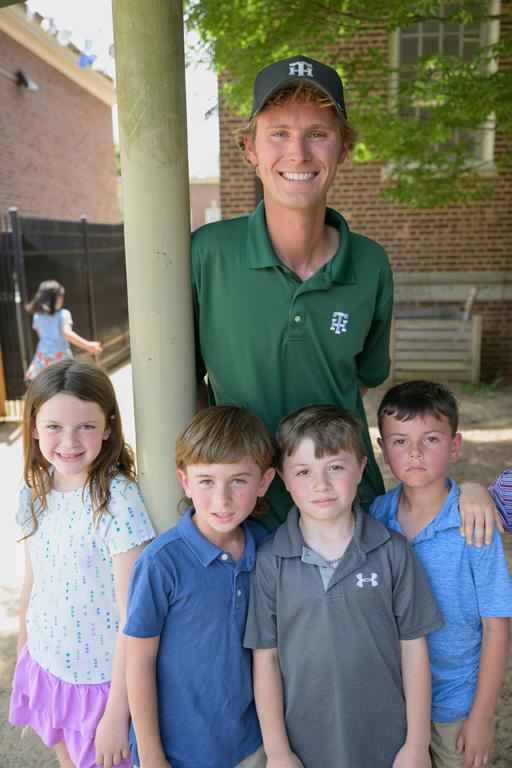
As for his teaching philosophy, much of that is informed by his own experience as a Hiller and as a tennis coach.
“Last year, a third grader was very upset, telling me he didn’t think he was good enough and was letting his teammates down,” he remembers. “I told him, ‘first of all, you’re in third grade—you’re not letting anybody down. You’re playing soccer. What you have to do is imagine you’re in the classroom. We’re out here to get better. Because we’re playing games doesn’t mean that we’re not out here to learn.’”
From that day forward, Chilton says, “I’ve stressed that we’re here to have fun and learn about sportsmanship, games, building muscles and exercising. I also get a lot of joy out of teaching kindergarten in the morning. They’re so fired up when you walk into the room.”
Chris Aitken
Physical Education Department Chair, Athletics
At Tower Hill since 2004
“Sports and physical education are built deeply into the Tower Hill curriculum from the youngest to the oldest students because it’s truly an essential part of a child’s education,” says Chris Aitken.
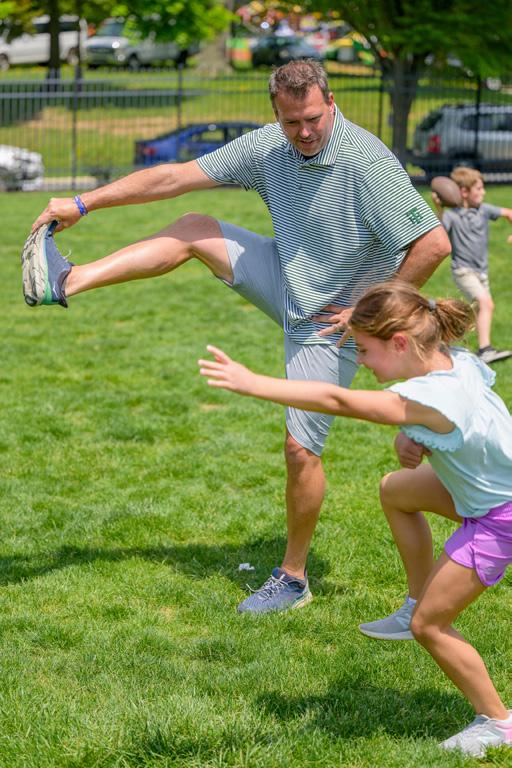
“In this day and age of the rise in obesity and mental health issues, the number one thing is providing a fun, safe place for kids to enjoy themselves and giving them a variety of active things to do,” he says. “I’m a big believer in challenging kids and allowing them to explore what their passions are and stepping out of their comfort zones while celebrating all the great things that they do and helping them improve along the way.”
Because the PE teachers see kindergartners through sixth graders every day, all year long, the teachers can really dive into the nuances of skills in a particular sport or game. Plus, all Lower Schoolers have recess every day, giving them more than an hour of structured or non-structured physical activity, which we know can improve their learning and alertness all day long.
“It also makes for a fun and welcoming environment where kids can be themselves and have opportunities to shine in a variety of different ways,” he says.
Because all Hillers are exposed to so many different sports from early on, by seventh grade they are ready to make a confident decision as to which sports teams they will compete on. These choices allow them to stay active and competitive as they continue their athletic career into high school.
“The ultimate goal with the connection of our PE program and our sports teams is to show our students that they can live a healthy lifestyle,” Aitken says. “It allows us to teach kids to work hard and see that such dedication benefits them.”
The camaraderie of the PE department is the natural outgrowth of two factors, Aitken says: that the six teachers, including former student Kitchel Chilton ’14, share an office, and that coaching is an essential part of their work with students, which extends into mentoring each other.
Aitken says he’s also proud that the staff has the flexibility and imagination to use many different spaces on the campus, from the gym, field house, various fields, to even the classrooms. The team re-imagined what they could accomplish using technology during the pandemic. As a result, PE classes continued online, every single day. In May 2020, they ran the 98th annual Field Day competition virtually through Zoom to continue the time-honored tradition. (The score, by the way, was 20-20 for a Green and White tie.)
“There aren’t many professions where we start our day with 3-year-olds and walk off the field at 6 p.m. with 18-year-olds,” says Aitken. “It keeps you on your toes and keeps your brain working. It’s a pretty unique position that we’re in.”
12 Tower Hill Bulletin Fall 2023
Toby Huttner Upper School English Teacher: American Literature and Electives At Tower Hill since 2022
Toby Huttner joined Tower Hill last fall to teach not only writing, which he did at Johns Hopkins University for seven years, but also his other great love: literature.
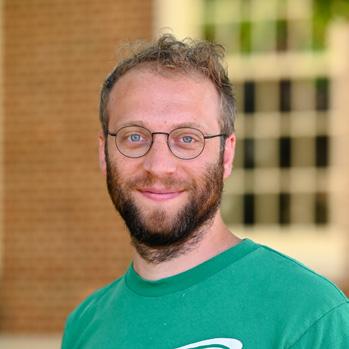
“I really enjoy the day-to-day culture of working with students and colleagues here,” says Huttner, who teaches American Literature to 10th graders and two electives for juniors and some seniors: What Does Poetry Do? and advanced critical writing that explores genre fiction. He’s also advisor for Tower Hill’s Laurel Society and the English honors program.
“I appreciate how at ease the students feel with the faculty in general,” he says. “It’s easy to form intellectual relationships with the students around their growth. At the faculty level, it’s really collaborative. The work happens on a really high level but there’s an easygoing feeling to it as well.”
Prior to joining Tower Hill, Huttner was a postdoctoral fellow and instructor at Johns Hopkins University. There, he earned his doctorate in English Language and Literature/Letters in 2020. He also was associate editor for Johns Hopkins’ ELH: English Literary History academic journal. Previously, he earned a master’s of philosophy in English, criticism and culture from Cambridge University and a bachelor’s in English from Cornell University.
Coleen Hubler
Upper School English Teacher: American Literature and Electives
At Tower Hill since 1997
Coleen Hubler joined Tower Hill’s English Department in 1997, after being intrigued that she could develop her own electives in addition to teaching full-year Upper School literature courses.
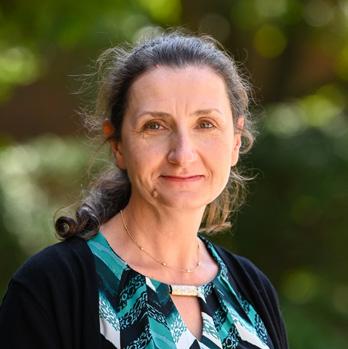
“When I first arrived, I was mentored by John Robinson, who was very supportive,” says Hubler, who teaches 10th grade American Literature and also electives such as Haunted Minds: Studies in Gothic and Horror Literature. “He was a go-to resource for lots of information. I enjoyed being able to go around and talk with colleagues about their experiences, the material they used and their classroom exercises. It was a chance to talk about what my electives ideas were and hear suggestions. It was a fabulous department for mentoring a new teacher.”
Her mother and father inspired her love of reading and continual learning as she was growing up.
“There’s always an opportunity to learn more,” she says about her teaching philosophy. “You might teach a book 20 times, but then you suddenly have a new angle or way of approaching it, or choose an entirely new book. The kids are great about that. They bring in new ideas. There’s always something that is growing and expanding. It’s a chance for me to constantly learn.”
Hubler earned her bachelor’s in English at Ithaca College and earned a master’s in English at the University of Delaware, where she also studied Renaissance literature in the doctoral program.
She was inspired to pursue an English degree by Mr. Ceryk, who taught at her upstate Pennsylvania high school. “He was a wonderful teacher because he gave us some exciting projects and was always helping us with our writing. He had a really exciting way of approaching literature,” she says.
He says the Tower Hill electives allow for the development of students’ academic research and writing skills, and he enjoys working with them to apply those skills to topics of interest to them from pop culture, including music, sci-fi and reality TV. “It’s been fun to have them see what is possible with the things they’re already watching on their own,” he says. Huttner says he’s enjoyed being part of the English department’s ongoing discussion about curriculum and has found it helpful to hear what his colleagues share about teaching high schoolers.
“It’s nice that I can just pop into other teacher’s offices and classrooms to ask a question,” he says. “There seems to be a real culture of mutual interest, curiosity and respect between students and the faculty.”
He adds, “There’s also an emphasis on flexibility around meeting students’ needs. For me, that means really wanting to know what the students think and helping them articulate what they are thinking. I frequently ask follow up questions, such as ‘what are you trying to say here?’ I’m interested in understanding where they’re coming from and how they are seeing the material that we’re looking at.”
“Students should be challenged and challenge each other, but in a space that is safe and that encourages sharing,” she wrote in her teaching philosophy statement. “I strive to make my room a place where students feel free to ask questions and drive the discussions, but I insist that they respect each other and themselves in the process.”
She also recounted a discussion with a student who had heard her speak about gothic literature when she was a guest lecturer in his class.
“You were so enthusiastic about the subject matter that I wanted to read it,” he told her. “I like when teachers care about their classes and their subjects. Then, I get excited about the classes, too.”
13 Tower Hill Bulletin Fall 2023 ROOTS AND BRANCHES
“It’s easy to form intellectual relationships with the students around their growth. At the faculty level, it’s really collaborative. The work happens on a really high level but there’s an easygoing feeling to it as well.”
“I strive to make my room a place where students feel free to ask questions and drive the discussions, but I insist that they respect each other and themselves in the process.”
DENDROLOGY
BY LUISA SAWYER, SCIENCE DEPARTMENT CHAIR
Dendrology is a branch of study of woody plants, also known as trees. Beneath their towering canopies lies a treasure trove of ecological wonders, historical narratives and scientific discoveries. From the subtle intricacies of their bark to the vibrant hues of their foliage, trees hold invaluable insights into the intricate web of life on our planet.
At Tower Hill School, we integrate dendrology into our Stream Watch program in fifth grade science, though it pops up informally throughout our curriculum, in science and beyond. There are many things to learn about the silent giants that surround us, so let’s get to the root of it all.
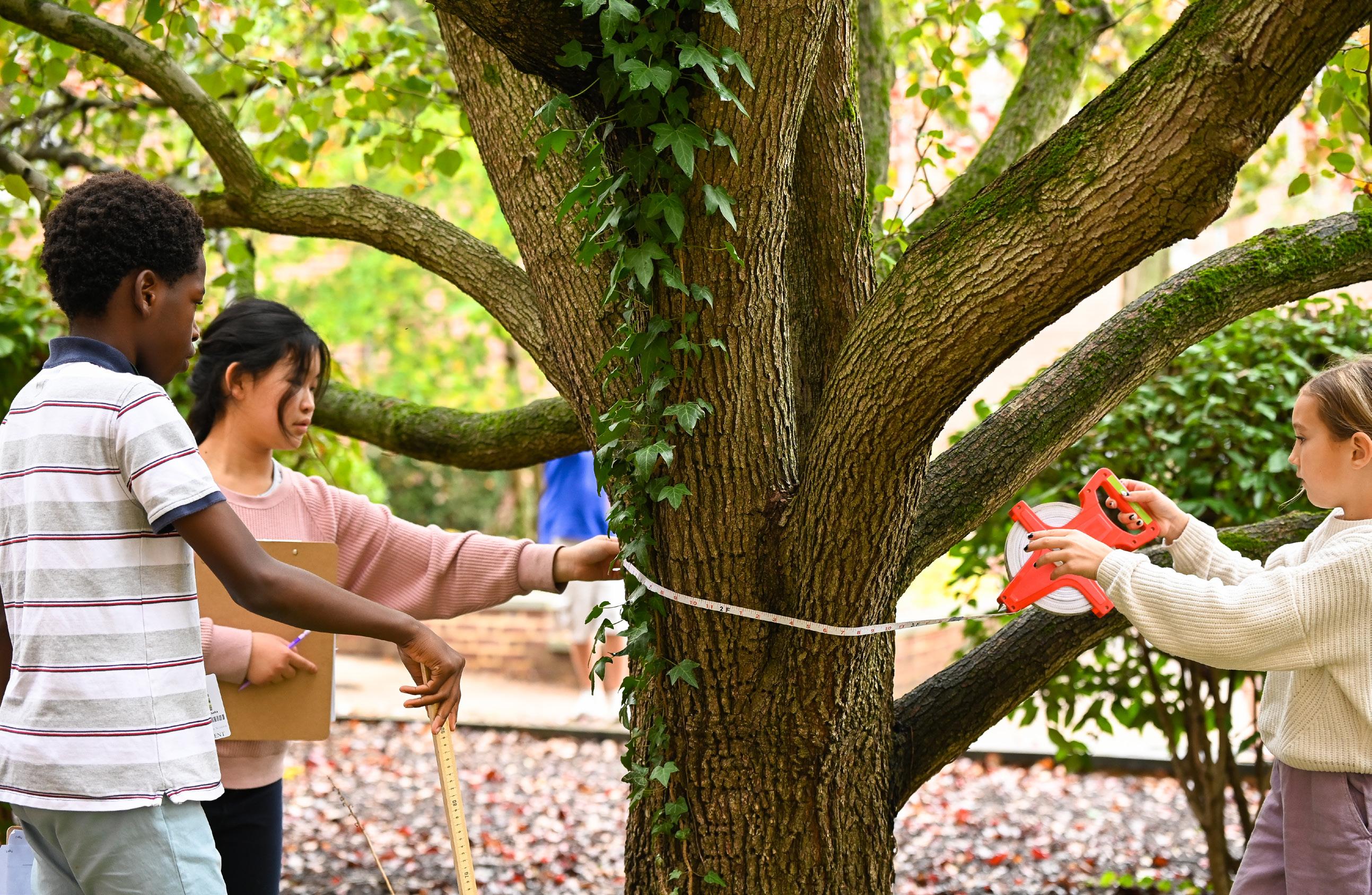
360 million years ago, during the Carboniferous Period of the Paleozoic Era, the first trees with a true
woody stem developed. With these wooden trunks, trees now had the structure to grow to new heights. The Carboniferous Period is named after the coal deposits that date to it. The coal was formed from prehistoric vegetation, notably bark-bearing trees, which is the same coal we burn today. We have evidence of this time period locally, as one of the subdivisions of the Carboniferous Period is called the Pennsylvanian period, named for the state because the rockbed hosts many of the fossils and coal from that time. The prehistoric vegetation conducted so much photosynthesis that there was a surplus of oxygen in the atmosphere, allowing for giant invertebrates to grow. Atmospheric oxygen levels peaked around 35%, and thank goodness we’re down to 21% now because I don’t want to encounter any two meter long centipedes any time soon.
These photosynthesis powerhouses are still prolific today, with some of the top ones being douglas-firs, spruces, true firs, beeches and maples. You can find many of these trees on campus at THS, particularly the lovely Red Maples, Acer rubrum, which change
14 Tower Hill Bulletin Fall 2021
their leaves from true green to deep red in autumn. These trees are nature’s air purifiers, as they help maintain the quality of the air we breathe. Through the process of photosynthesis, trees absorb carbon dioxide and release oxygen. Photosynthesizers like trees, grasses and shrubs, act as powerful carbon sinks, storing carbon in their internal structure rather than increasing the carbon in the atmosphere, which in turn helps mitigate climate change by reducing the concentration of greenhouse gasses. So next time you take a break to go “forest bathing,” thank the trees for their hard work.
The anatomy of a tree is fascinating. Trees have many parts to their structure, but if you were to cut the trunk of a tree across, you would see many rings. By counting these tree rings, we can discover how old the tree was; every wide ring is a spring growing season, and the narrow ring next to it is the summer growing season. So the following wide ring would be a new year. This type of tree aging is done on trees that have fallen or have been cut down, or may also be done on a tree branch, though that would only show how old the branch is, not the whole tree.

Looking more closely at this cut cross-section, we can see that aside from the tree rings, the circles on it are different colors. The outermost ring is the bark, this section is similar to our skin and protects the tree from diseases and insects that could harm it on the outside and keeps moisture trapped on the inside. The next layer below the bark is the phloem, also called the inner bark, this layer is a pipeline that carries sap with water, sugar and nutrients (liquid energy!) from the leaves down to the rest of the tree. After the phloem is the cambium, this layer is very thin but has a very important job. It is made up of special cells that can become anything the tree needs; when needed, the cells of the cambium can multiply into branches,
roots, phloem, bark or sapwood. Next is the sapwood which works in reverse of the phloem, carrying water and nutrients from the roots up to the leaves. It’s also known as the xylem and is made up of the youngest layers of wood the cambium creates each year. The last layer on the inside of the tree is called the heartwood, this is the most dense part of the tree and is not able to transport sap or water. The heartwood is dead wood and is old xylem that has its transport vessels filled with resin. When builders use trees for their construction materials, they prefer to use the heartwood because it is less likely to rot than the softer, living sapwood.
Trees and nature are great for human health. One study by the International Journal of Environmental Health Research found that for people who live in a city, spending time in a park can have a positive impact on a person’s sense of wellbeing. Beyond that, the practice of forest bathing, or shinrin-yoku, has been found to lower blood pressure, heart rate and levels of harmful hormones, like cortisol, which your body produces when it’s stressed. In addition, studies have found that simply spending 10 to 20 minutes a day outdoors can lead to increased wellbeing and happiness and decreased amounts of stress. Richard Louv, author of The Last Child In The Woods, warns about Nature Deficit Disorder, an idea that children have been spending less time outdoors than they have in the past, and this leads to behavioral problems. Luckily, he provides hundreds of solutions, many of which we are already doing at Tower Hill School: studying weather, nature and clouds; planting a garden; reading poetry or other quiet non-screen work outside; the list goes on. So like our students, take a moment to pause outside, breathe some freshly photosynthesized oxygen and rest assured that these trees have got you covered.
To help with your newfound tree appreciation, please check out these tree identification apps: VTree, iNaturalist, and PlantSnap.
15 Tower Hill Bulletin Fall 2022 ROOTS AND BRANCHES
MINDFULNESS UNDER THE TREES
BY AMY SCHREI, DIRECTOR OF COMMUNICATIONS AND MARKETING
This spring, Lower School students went outside to enjoy the weather and take a moment to practice mindfulness under the trees in Rockford Park. Regular mindfulness practice enables students to train their minds to stay present and focused, which in turn enhances their ability to concentrate during class, complete assignments and engage in learning activities more effectively.
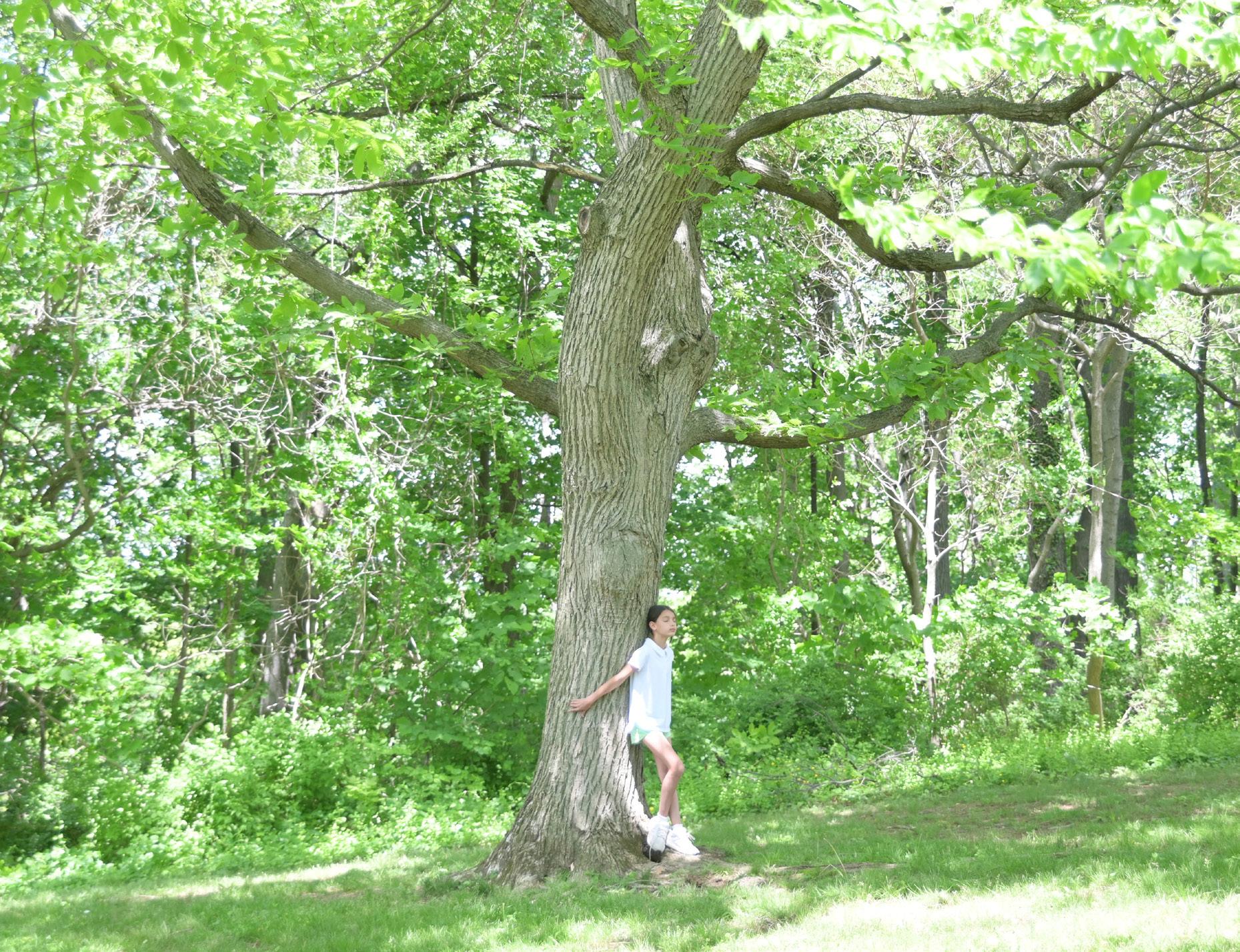
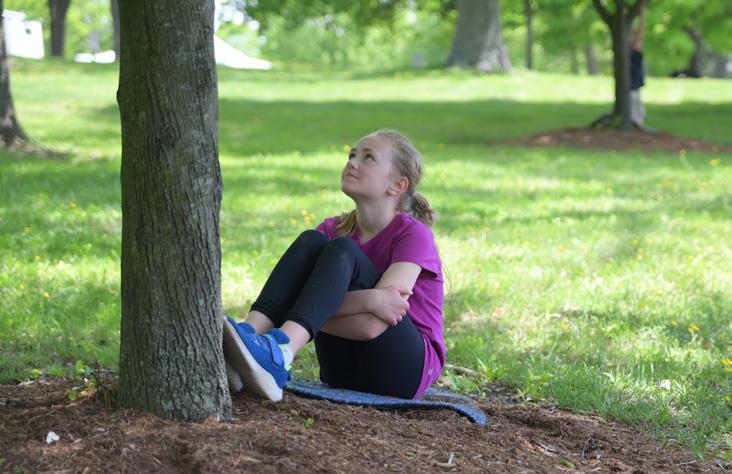
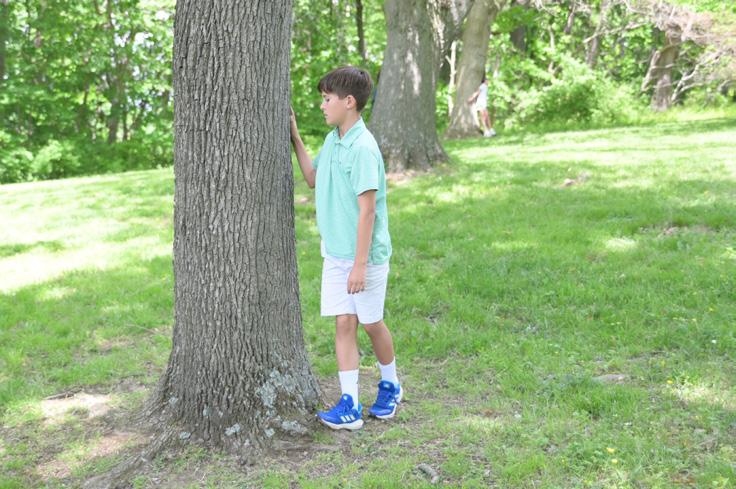
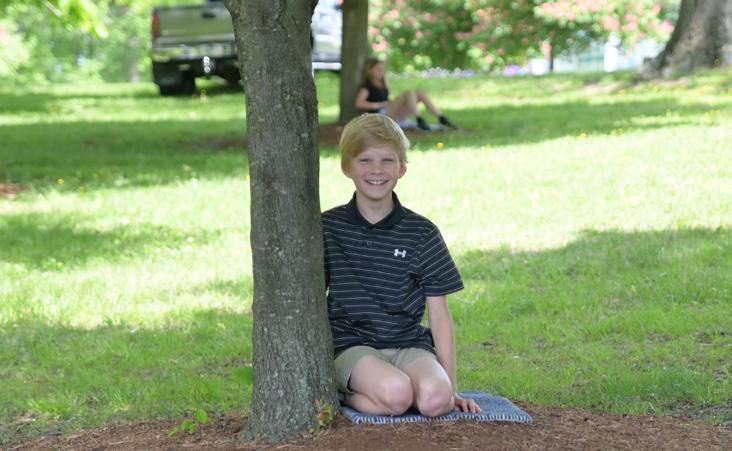
The trees provide a tangible place for students to focus their attention. Director of Service Learning and of Mindfulness Andie Sarko instructed students to, “think about the trees and all the wonderful things nature provides to help us with our mindfulness practice. The roots of the tree secure it to the Earth just as our feet anchor us to the ground. Notice the bark, the leaves, the grass, the branches and the sky. Your mind will wander but then bring it back to your tree.”
Mindfulness cultivates emotional wellbeing and resilience in young students. By paying attention to their thoughts and emotions, students learn to identify and regulate their feelings in a healthier way. This emotional intelligence enables them to manage stress, anxiety and challenging situations more effectively, fostering resilience and promoting a positive mental state.
After several minutes of quiet contemplation, Sarko asked students how they felt. Here are some of their responses:
“I feel calm, because the shadows make calming shapes.”
“The tree brings me joy, because I can play on it.”
“It feels good to be outside.”
“I felt cold.”
“I felt peaceful being away from all the stress.”
“I felt the sun beating down on my back.”
“I felt comfortable and loved.”
“I felt safe.”
Mindfulness and overall wellbeing are critical to school and student success and are a key priority for Tower Hill. By investing in the wellbeing of students, we can contribute to the overall growth and happiness of our students, setting them up for a fulfilling and prosperous life.
16 Tower Hill Bulletin Fall 2023
HORIZONS
BY AMY SCHREI, DIRECTOR OF COMMUNICATIONS AND MARKETING
This summer Tower Hill School welcomed 14 rising first graders to its inaugural Horizons program.
The students were engaged in an intensive, six-week learning and enrichment program that provided a culturally inclusive and responsive curriculum while incorporating social-emotional and whole-child teaching practices. Students were recruited from nearby Wilmington schools, Harlan Elementary and Eastside Charter.
Each child received both differentiated, individual care and group instruction led by Elizabeth Capone ’06, who served as the primary teacher. Several Tower Hill teachers volunteered with mini-lessons and 16 Tower Hill students volunteered over 800 cumulative hours. The program had a strong focus on literacy, and THS reading specialist, Ellen Ellis, worked with students to ignite a love of reading. The children loved being able to discover new “reader super powers.”
In addition to academics, the program provided twice a week trips to the pool at Windybush Swim Club, where students learned to swim and built their confidence. Swimming is a hallmark of Horizons. Arts and crafts were a fan favorite and made a regular appearance on the schedule. Nutrition was provided with daily breakfast, lunch and a snack.

Dr. Amy Cuddy, Tower Hill school psychologist, worked closely with the students and their families on social emotional learning (SEL). Students learned how to begin recognizing and regulating their emotions. Weekly yoga was part of the emphasis on SEL.
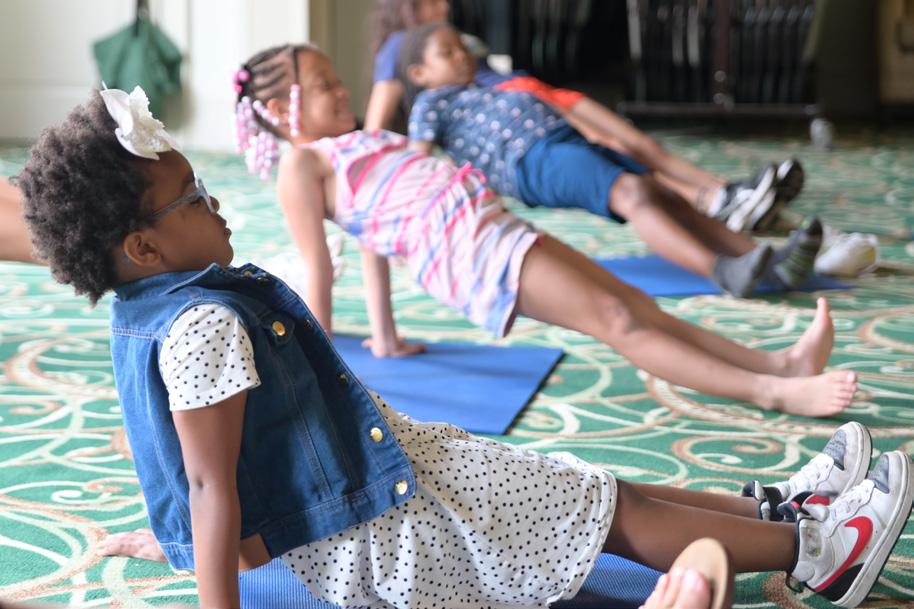
Executive Director Violeta Castro Stolpen ’05 (Miss V. to the students) said, “The students’ confidence grew every day and as they became more comfortable they let their walls down and truly opened up.” Horizons parents reported that their children would always talk about the program and were disappointed to not attend on the weekends or holidays.
The students, families and teachers will gather three times during the school year to maintain a connection. This year’s students will attend in summer 2024 and beyond and will be joined by a new class of rising first graders.
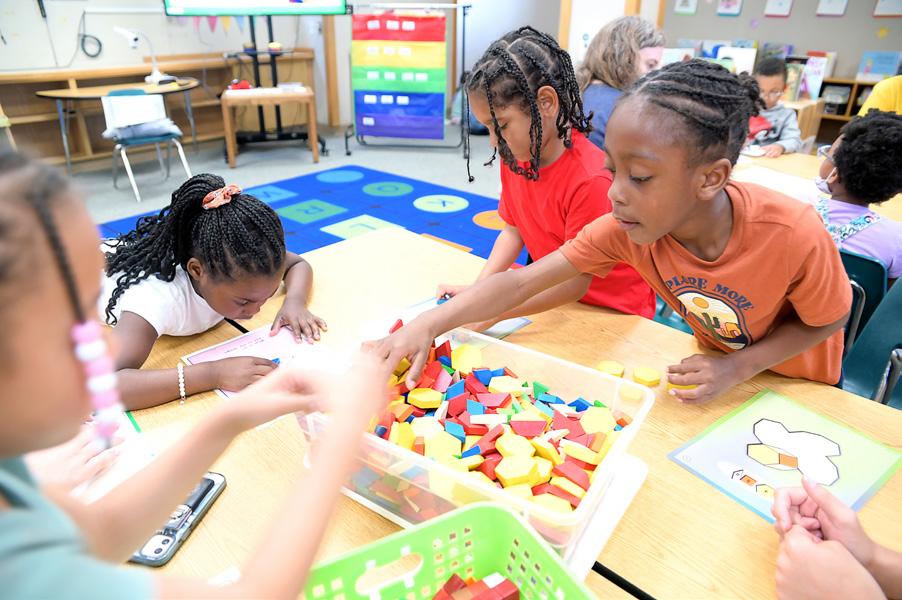
Horizons at Tower Hill is fortunate to have been earmarked for two grants totalling $57,000 from New Castle County’s ARPA Program and from Horizons National. Fundraising will continue to support the program moving forward. (See page 87 for Horizons donors.)
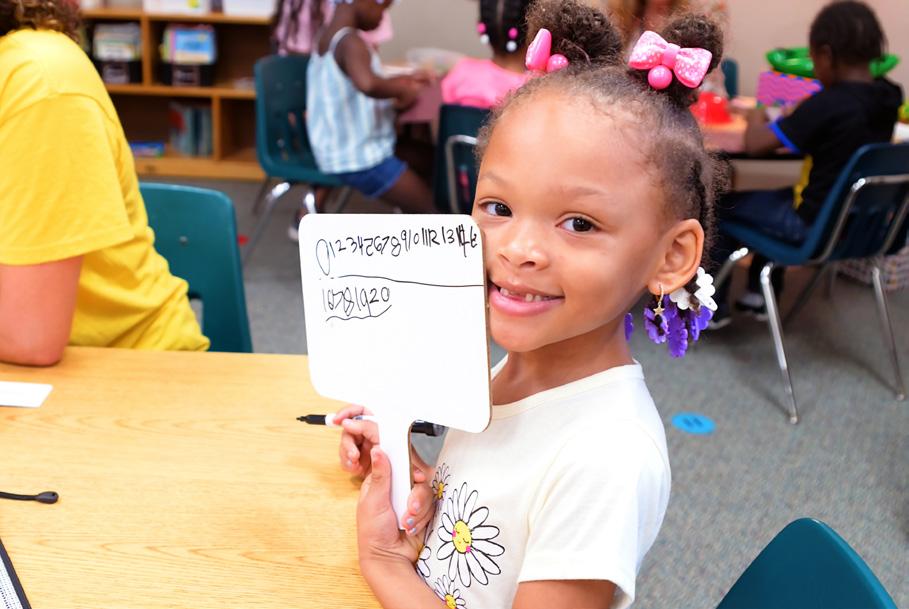
17 Tower Hill Bulletin Fall 2023 ROOTS AND BRANCHES
DANISH EXCHANGE
BY WILLIAM MILLER ’23
I have always had an intense interest in people and issues beyond our country. Therefore, I was excited when Tower Hill introduced a month-long foreign exchange program with Rungsted Gymnasium, a public high school of 900 students in an affluent area outside of Copenhagen, Denmark. After an application process, I was excited to be among five rising seniors chosen to participate in this incredible opportunity. Right on the heels of those feelings of excitement, however, I felt some apprehension; I had never visited Scandinavia before or lived abroad, nor did I speak one word of Danish.
Once I arrived in Denmark in August 2022, my concerns soon melted away. Living with the welcoming Hassel family, I learned that the positives far outweighed any uneasiness of being in an unfamiliar environment. Furthermore, English is widely spoken among Danes. I stayed on the island of Zealand where the capital Copenhagen is, and where about half of Denmark’s population is located. My Danish family lived off of Strandvejen, the scenic coastal road along the Øresund, the body of water that separates Denmark from Sweden. While the country is extremely flat, I was struck by the beauty of the buildings and the charm of the sea. Along
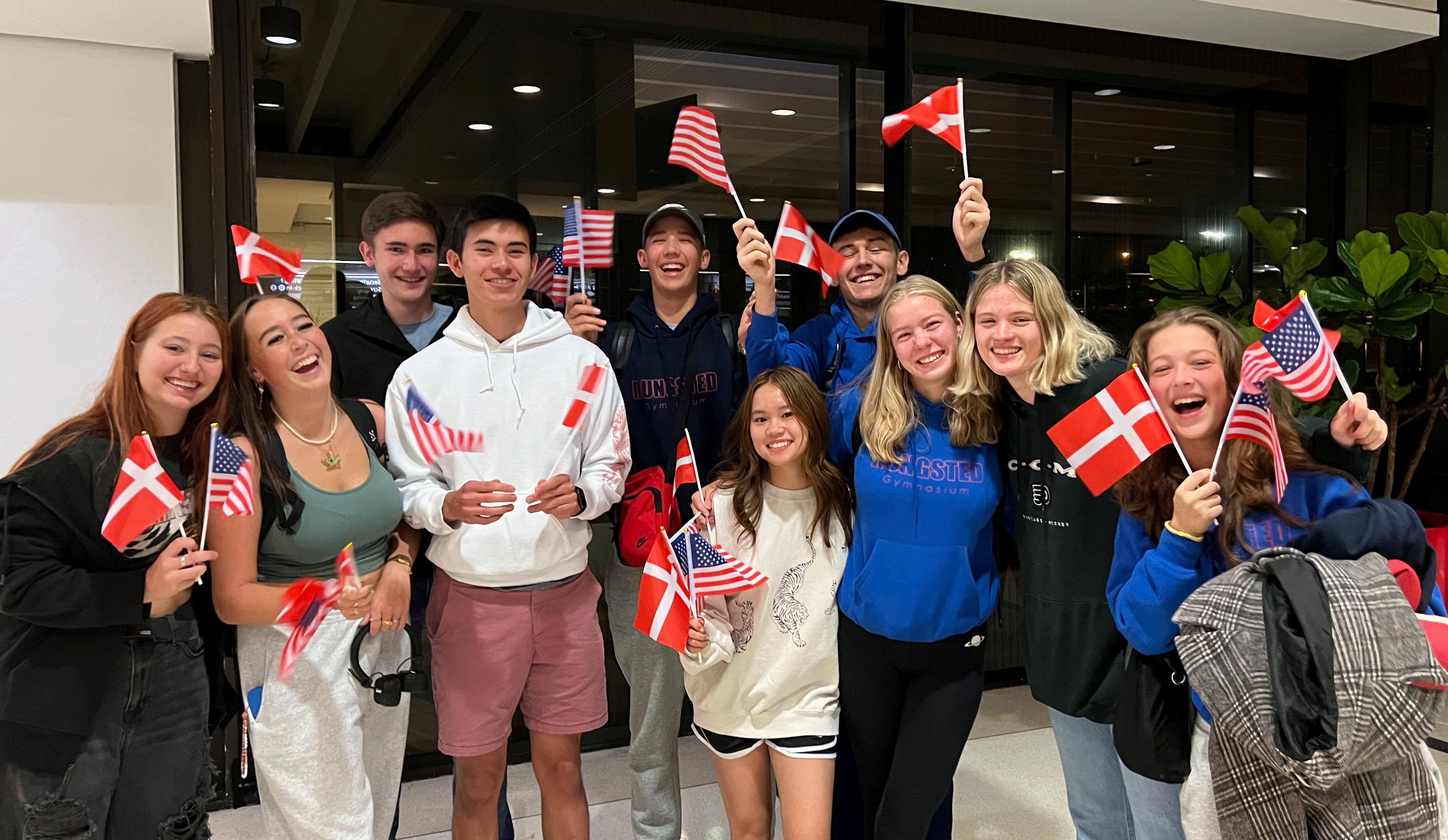
Strandvejen, white houses with black Danish tiled roofs balanced a modern and traditional look, and every few miles there would be a harbor, beach and small town area. These were great meeting places to spend time with friends due to café trucks, restaurants and beach activities.
Almost immediately, the Hassels mentioned the word hygge. Carl, my host brother, defined it as an “atmosphere of wellbeing, warmth and good vibes.” This is a key cornerstone of Danish culture. Danes seem much more laid back than Americans, especially east coast Americans. Businessmen do not wear ties, and children call adults by their first names (including their teachers). The work-life balance appears much more favorable to the worker, and Danes do not solely focus on their careers. There is no Amazon in Denmark. Most Danes opt to shop at small, local businesses in person in order to preserve their “way of life.” They also lead a very active lifestyle with plenty of time outdoors. These reasons contribute to Denmark being one of the happiest countries in the world. Sometimes I thought I was in a sort of magical fairytale world due to the relaxed pace and happy faces.
18 Tower Hill Bulletin Fall 2023
One of the things that made the greatest impression on me was Denmark’s commitment to combating climate change. While staying with my host family, I separated my waste into six separate bins according to food waste, residual waste, paper, plastic, glass and metal. Although this made cleaning up after dinner slightly lengthier, I was deeply impressed and inspired by the Danes’ commitment to protecting the environment. The once polluted waterways within Copenhagen have been thoroughly cleaned, and there are now sections designated exclusively for swimming. Denmark has large wind farms, and it also reduced carbon emissions from transportation. Within the city of Copenhagen, there are massive bike lanes, sometimes the same size as the road, and many people commute with bikes. This also helps to clean up traffic congestion within the city. I found public transport readily available and easy to use. Within a few days of my arrival, I was able to travel independently on buses and trains with the Rejseplanen app.
Another difference I noticed was the taste of food and drinks. Possibly due to more intensive EU regulations, food and drinks often tasted better. When I tried orange Fanta, I could actually taste a genuine orange flavor that seemed more natural and less processed. Fruits and vegetables tasted fresher. Fruit trees and plants were fairly common on residential properties, and I would be remiss to not mention elderflower. It was a refreshing treat to mix elderflower extract and water on a hot day.
I also learned about the perception of America outside of our country. The United States lies in a contradictory state in the Danish mindset. Some Danes remarked they were surprised that we five were not “fat and stupid.” Some of these stereotypes were fueled by social media clips of Americans failing to identify a single country on a map or people confusing the meaning of similar sounding words such as suffrage and suffering. Furthermore, the Danes were confused how a country with only two political parties could be so polarized and in such gridlock, which was in stark contrast to their multi-party parliament. Teenagers were extremely curious about and fearful of schools in America. They wondered how we were able to go to school with so many school shootings. However, they all remarked on how they wanted to visit America. Many Danish newspaper headlines were about America, and my host father, Jens, would discuss the politics and current events in the U.S. as easily as if he lived here.
My month in Denmark was a life-changing experience, and what was just as much fun, was seeing the U.S. through the eyes of my Danish brother, and the other four Danish students who arrived for the month of October 2022. Some differences they pointed out were America’s huge food portions, massive grocery stores and school sports teams. Of special interest was the prevalence of cars for transportation, especially among teenagers. Because of the cost of obtaining a driver’s license in Denmark (about $1,800 USD), many people do not get one when they turn 18. Another interesting fact about driving in Denmark is that right turns on red lights are prohibited. This difference caused Carl great anxiety when I did these turns legally in the U.S.
This exchange taught me the great value of pursuing and facilitating international exchanges and cross border communication. Denmark’s free health care and education but high taxes made me think about the merits and drawbacks of government spending, and whether Danish practices could be scaled up from a country of 6 million to one of 340 million. The experience has fueled deep thought and an expansion of my perspectives. Despite the many differences between our countries, ultimately we are all human. This summer, I returned to Denmark to visit my friends. I have a good feeling that my friendships and learning about Denmark will continue to grow throughout my life. For this and many other reasons, I am deeply thankful to Tower Hill.
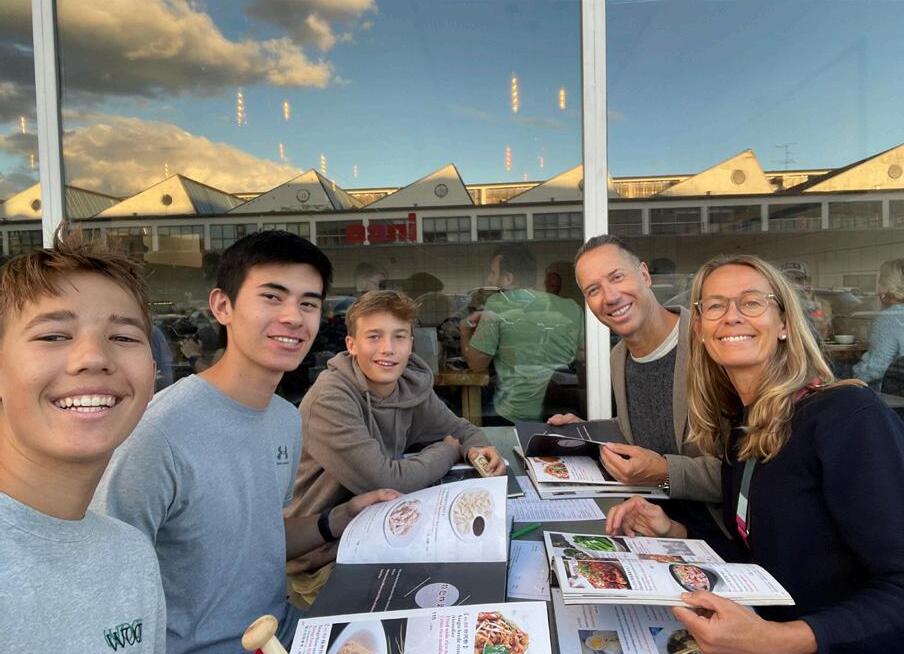
19 Tower Hill Bulletin Fall 2023
“HYGGE: an atmosphere of wellbeing, warmth and good vibes. This is a key cornerstone of Danish culture.”
ROOTS AND BRANCHES
CAITLIN SMITH ’23
BY MAURA C. CICCARELLI, FREELANCE WRITER
In fourth grade, Caitlin Smith ’23 read her story, Football Girls, on the du Pont Theatre stage, recounting how she and her dad watched his high school football videos, which inspired her to want to play football someday.
Another person who remembered that moment was football coach and her future ninth grade math teacher Kevin Waesco, who filmed her presentation with a big video camera in hand.
Fast-forward to the summer of 2022 when her dad— father of three girls—teased her, saying “Is my dream of you kicking for the football team over?”
“He probably never thought he’d have a kid dressing in pads and suiting up to play football,” said Smith in her senior speech. “But maybe one of his offspring would take after him after all. Yup, that would be me.”
When the placekicker position opened up for the fall season of her senior year, she decided to try out. “It was my last chance to do something like this,” says Smith, who has been at Tower Hill since pre-K.
She and her friend, then-freshman Alexa Rohrbacher, tried out. While it was a new thing for Smith, Rohrbacher had played on a boy’s middle school team as the only girl athlete before coming to the Upper School.
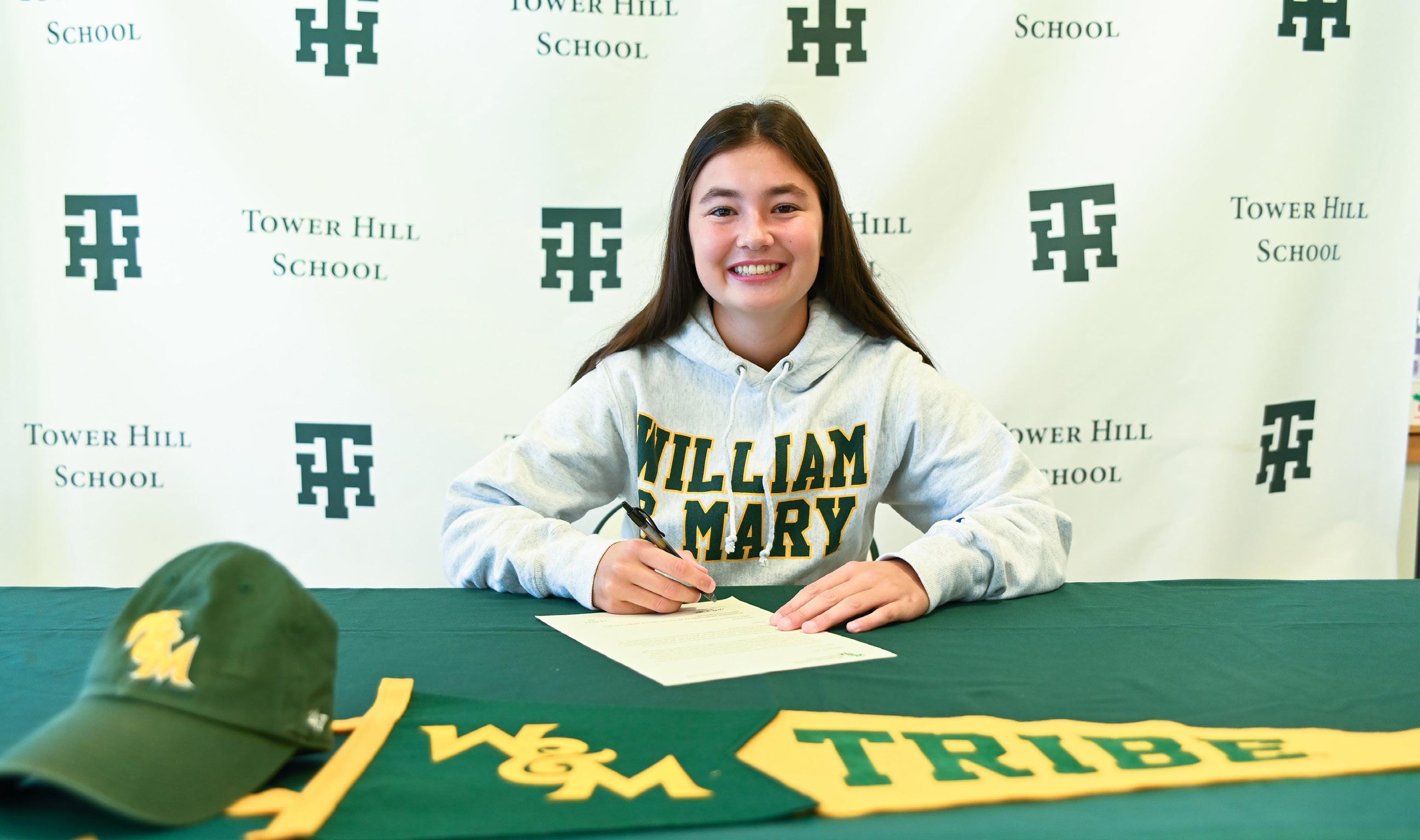
In her senior speech, Smith said: “To be honest if it wasn’t for the courage and bravery of my friend, Alexa Rohrbacher, I might not have taken the risk. With her by my side, tackling this challenge of being the first girls at THS to play football was not only fun but so memorable. Dreams can become reality.”
“I developed some really cool relationships with guys I grew up with as well as the coaching staff,” she explains during an interview. “It also showed me how boys and girls are coached differently and how they approach constructive criticism. I gained a new respect for the way things are done on the ‘other side.’ And this experience helped me become a better allaround athlete.”
The most memorable moment was her first PAT (point after touchdown). When Coach Waesco sent her onto the field to kick the extra point, she says she was, naturally, very nervous.
20 Tower Hill Bulletin Fall 2023
“He looked at me, so calm, and said, ‘Have fun out there,’” she recalls. “I wasn’t expecting him to say that at that moment. So, I went out there with composure, made the kick and all my friends in the stands were cheering. That was pretty cool.”
Learning how to place kick involved thinking about it like a math problem, Waesco explained to her in summer practices. “There were numbers everywhere, right triangles to create, angles to measure, parabolas to analyze,” she said in her speech. “Did football just become math class or did math class just become football? The word problems I had worked hard to solve with [Coach Waesco’s] guidance in ninth grade had become a reality in front of us.”
She scored the first points by a female student-athlete in Tower Hill football history with her successful extra point in the team’s season opener in 2022. Her main sport is soccer, which she’s played since she was three years old; she plays a forward. She finished her girls soccer career with 46 goals in 38 games—a remarkable 1.21 goals per game average.
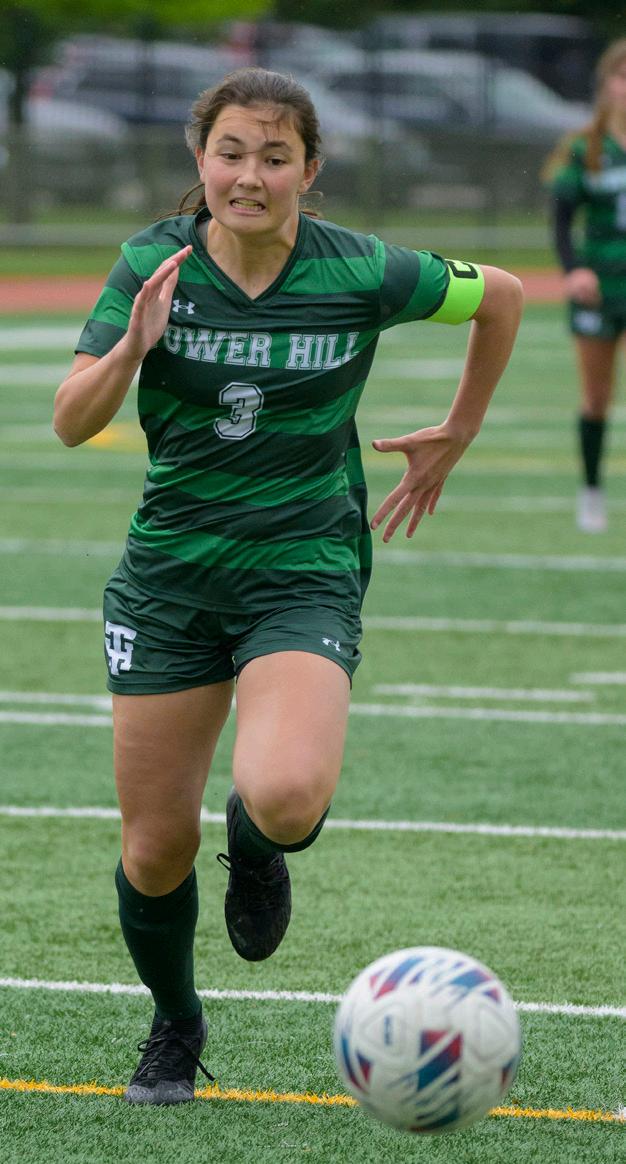
In addition, basketball has been in her life since she was five. She played point guard for the varsity team. Over five years, she scored more than 1,000 points, giving her the distinction of being the 10th Tower Hill basketball player to join the “1,000 point club” and the first one since 2014 to do so.
She also excelled at field hockey. Her overall stats are impressive. By graduation, she had earned 16 Varsity Letters, joining the late Nancy
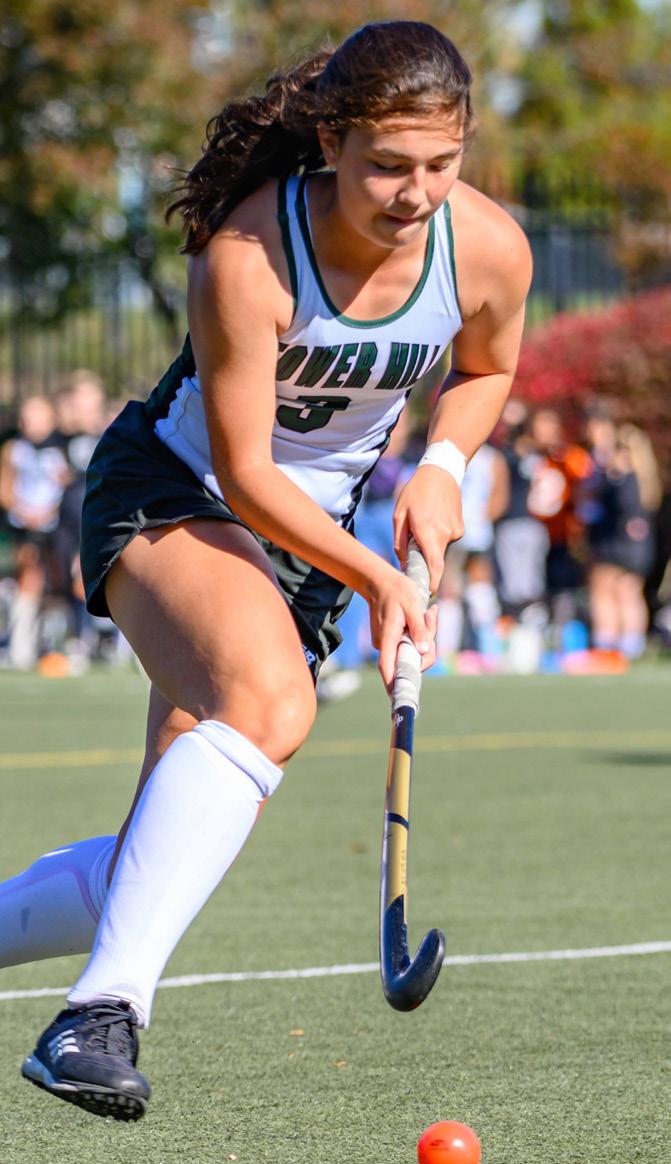
(Keith) Lefevre, Class of 1953, as the only Tower Hill student-athlete to ever reach this mark. During this time she served as a team captain of eight teams and was recognized with all-state honors in field hockey, basketball and soccer. Additionally she was selected to the Delaware Interscholastic Basketball Coaches Association Blue Gold Senior All-Star game.
Aside from athletics, Smith rediscovered a love of woodworking while sitting out a season due to a knee injury in her sophomore year. In fact, she later decided to pursue her dream of playing football because she was healthy and it would be her last chance to play the game.
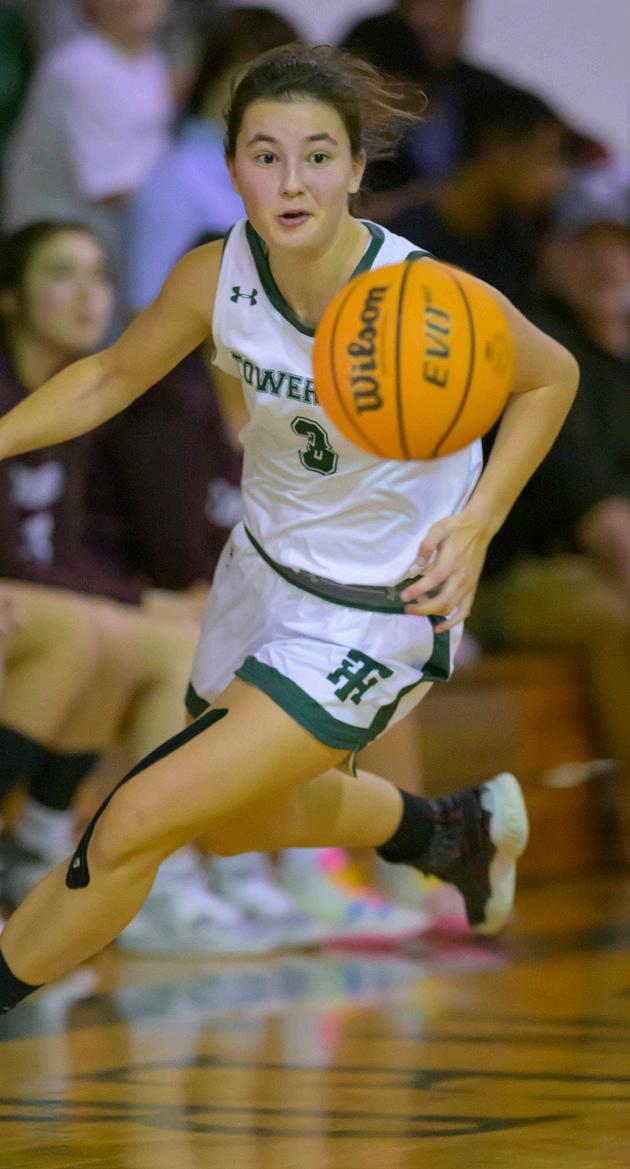
At William & Mary, Smith will play soccer and explore what major to settle on.
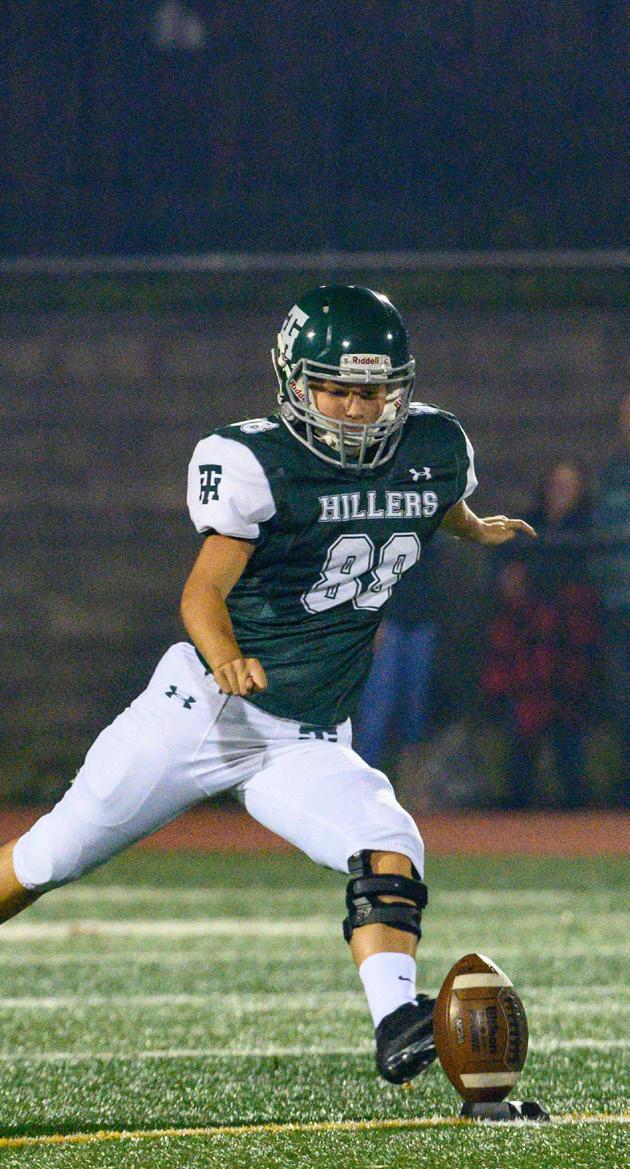
“The team has a really cool and unique culture that they’re developing,” she says, noting that the head coach and associate coach for her soccer team are both women and alumni of William & Mary.
As for the impact her Tower Hill education has had on her, Smith says the biggest lessons she’s learned center on the importance of developing relationships, whether it’s with classmates or faculty and staff.
“Relationships are really the core of your experience and you can learn from each other,” she says. “It’s important to be part of your little micro community within your sports teams or your classes, but also in the broader community. You can feel the importance of having those links. I think that’s the biggest thing that I’ve learned.”
21 Tower Hill Bulletin Fall 2023 ROOTS AND BRANCHES
MARTY COYNE ’23
BY MAURA C. CICCARELLI, FREELANCE WRITER
For Marty Coyne, there have been many highlights during his four years at Tower Hill. They’ve included baseball and basketball, close-knit friendships and being active in the school community, which included sitting as a student rep on the Tower Hill strategic planning committee.
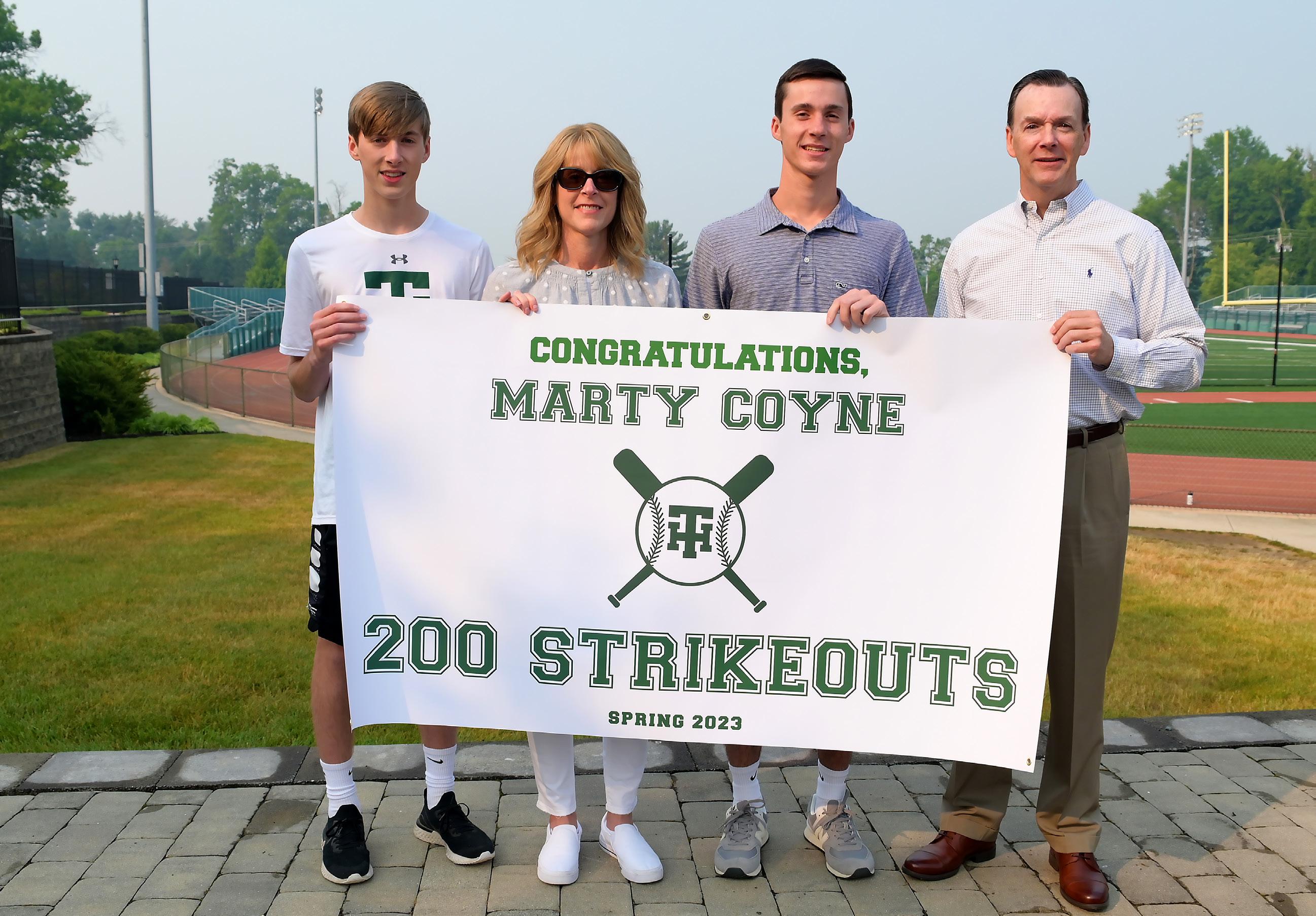
A star baseball pitcher and standout basketball shooting guard, Coyne is now at University of Pennsylvania studying finance at the Wharton School. He’s set to pitch for the Penn Quakers in the Ivy League Conference this spring.
SPORTS HIGHLIGHTS
Coyne began playing baseball when he was about 6 or 7 years old. He’s played center field and outfield but
loves pitching the most. He spent a decade playing travel baseball and most recently played for Delaware Fury.
His brother, Ryan, a freshman last year, also played on the varsity team, which was the first time they’ve played together.
In the spring he pitched the Tower Hill team to beat the No. 1 team in the state, Delaware Military Academy, by a score of 6-4 in a game that came down to the wire.
As for basketball, during his first year at Tower Hill, his JV team went 18-0. In his junior year, his varsity team won the Delaware state championship against Salesianum School, 79-43. This past winter Tower Hill had an impressive season making it to the Delaware Interscholastic Athletic Association quarterfinals.
22 Tower Hill Bulletin Fall 2023
STRONG FRIENDSHIPS
In his senior speech, Coyne described the good natured competition among his set of friends to find a “good seat” at the lunch table they’ve shared for two years. While he and two friends are content to sit in the same seat on the left side of the table, the others always race to get a place on the other side to avoid being the last person to arrive.
Sometimes one of the lunchmates would mix it up, taking someone’s “regular seat” and watching the good-natured chaos ensue.
“These guys have become some of my closest friends at Tower Hill as we’ve made countless memories in the classroom and on the athletic fields. From sharing a class together to making history for Tower Hill on the basketball court, my friends and I have had so many once-in-a-lifetime experiences and laughs along the way that I can always look back on. My four years at Tower Hill have been filled with unforgettable friendships and lasting memories that I’m so grateful for.”
ACTIVE IN THE TOWER HILL COMMUNITY
“When I was looking at high schools, academics came first, but I was looking at athletic programs as well,” says Coyne, who went to The Independence School through eighth grade.
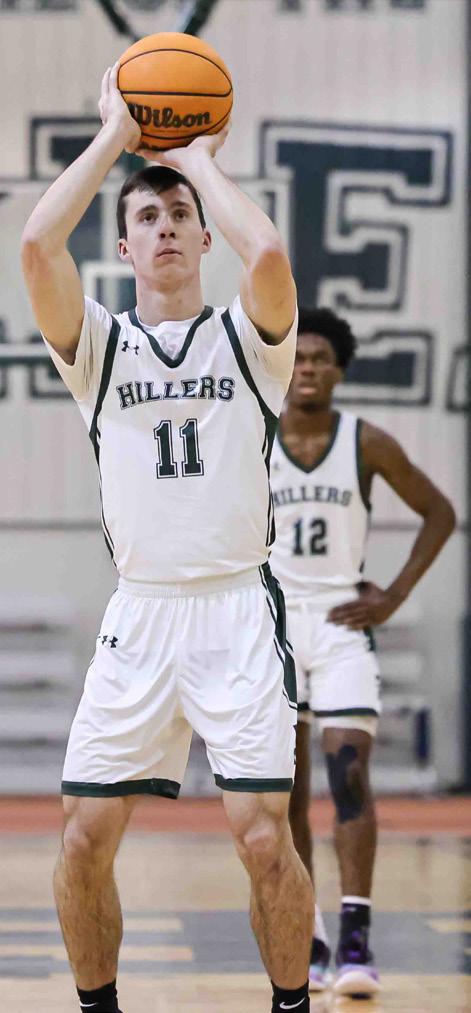
“I was really intrigued by Tower Hill’s baseball program in particular,” explains Coyne, who in his junior and senior year was a Green Keys tour guide for prospective Upper School families. “They had two coaches who had been here for many years— specifically Billy Cannon, who has a really good name in high school baseball. When I heard about that and
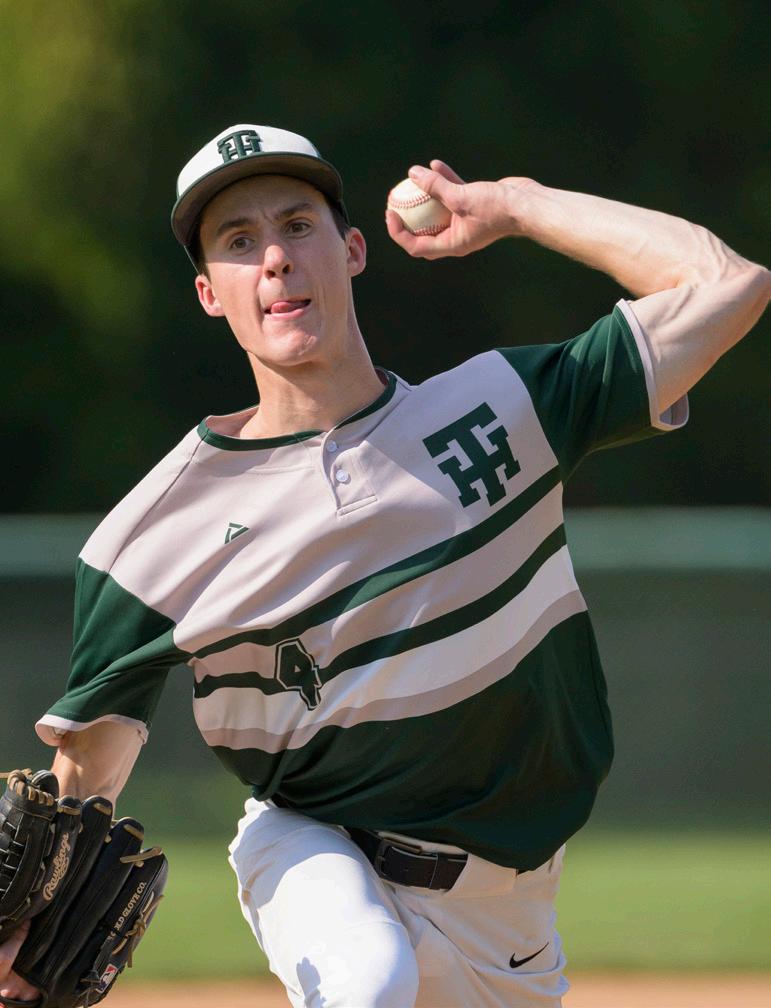
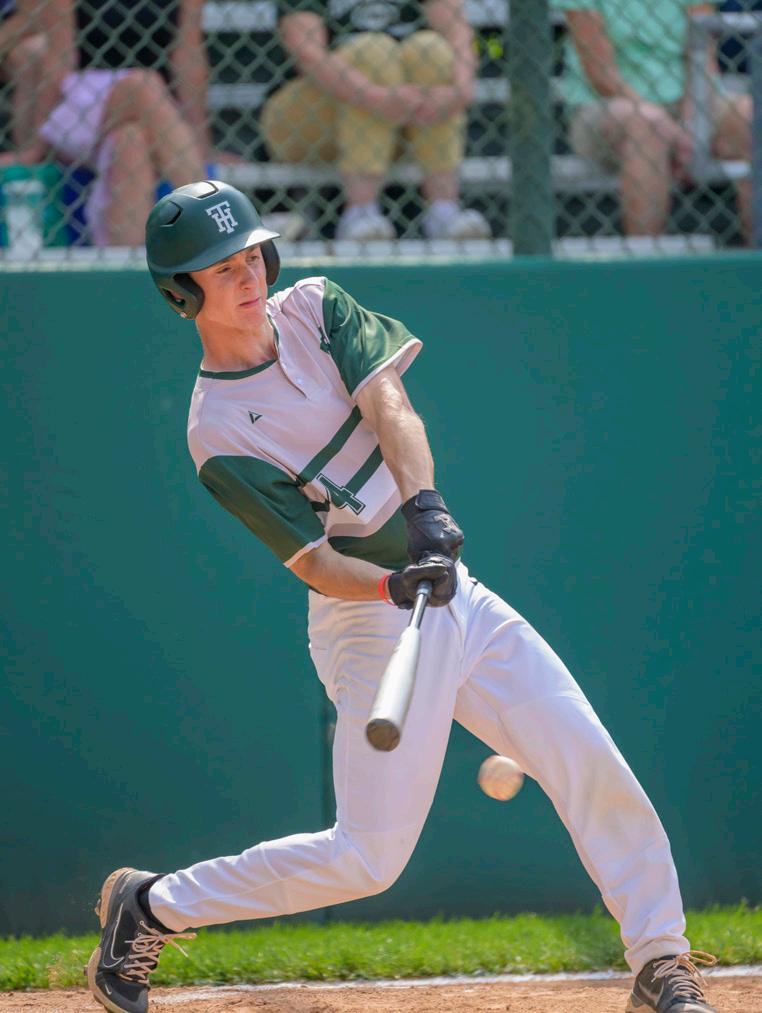
all the good things about their program combined with Tower Hill’s strong academics, I decided that this would be the right place for me. I couldn’t be happier.”
Along with sports, Coyne was Student Government Vice President of his 2023 class and served on the athletics board, promoting upcoming sporting events to students and faculty.
He also was tapped to serve on the strategic planning committee, which included administrators, alumni, parents and teachers. “Envisioning what we want Tower Hill to look like going forward has been a cool experience,” he says.
LOOKING TO THE FUTURE
Now that he’s at Penn, Coyne says he’s not sure what his ultimate career will be when he graduates. But, he is interested in exploring the field of finance, which is his father’s career, because it balances detailed technical knowledge along with building client relationships.
“I’ve seen my dad balance those two really well. It takes a lot of skill and he does a really good job of that,” he says.
That idea links back to his senior speech, where he said forming strong relationships with classmates was the most gratifying thing about his time at Tower Hill.
“Tower Hill is unique in that even in ninth grade you have the chance to be on the varsity team and become friends with kids in the upper classes,” he says. “As a senior, it’s been interesting to see how I’ve become friends with kids in other grades as well. In a smaller school like Tower Hill you get to be friends with kids in different grades and that’s really cool.”
23 Tower Hill Bulletin Fall 2023 ROOTS AND BRANCHES
CLASS OF 2022 3
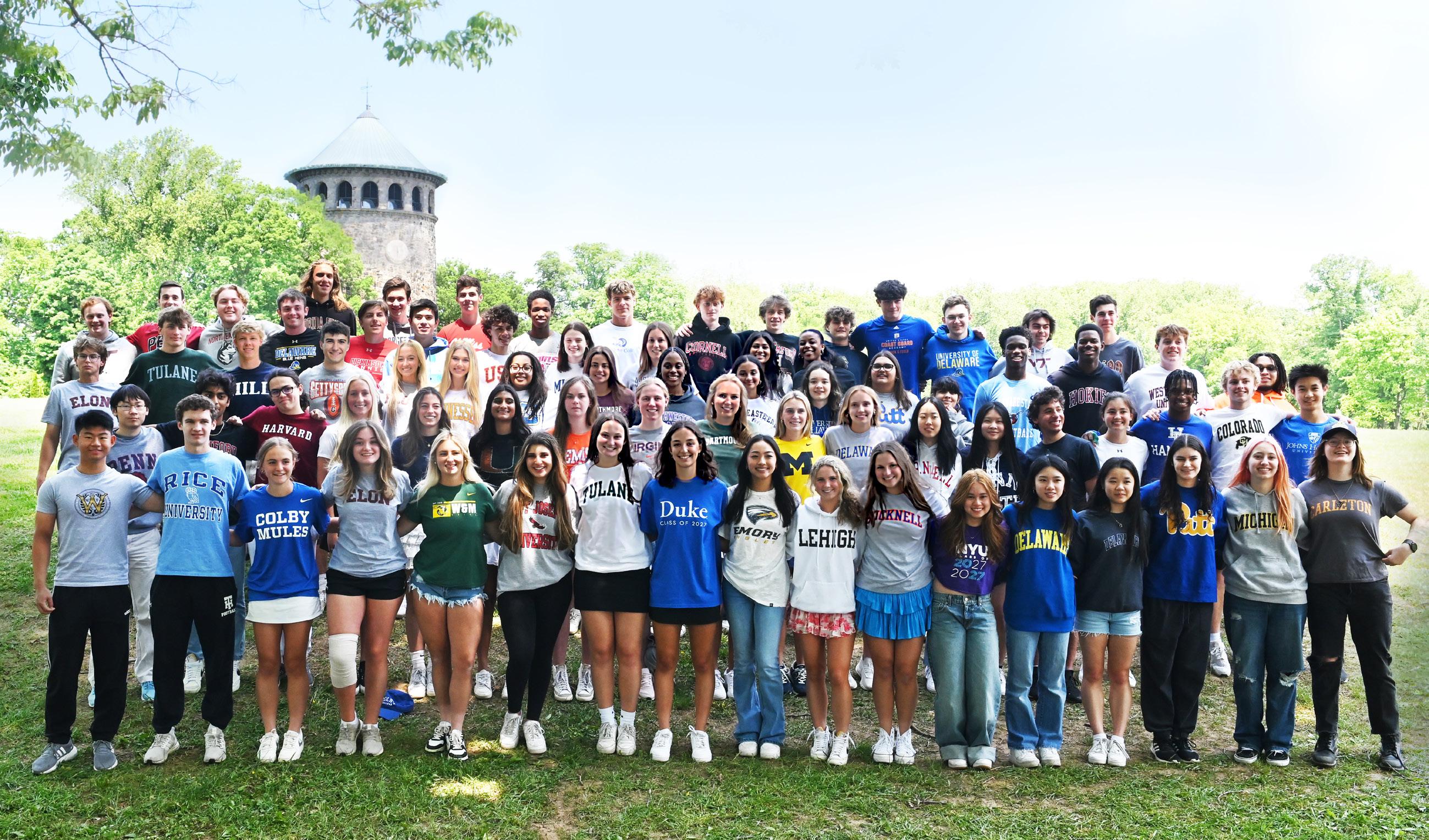
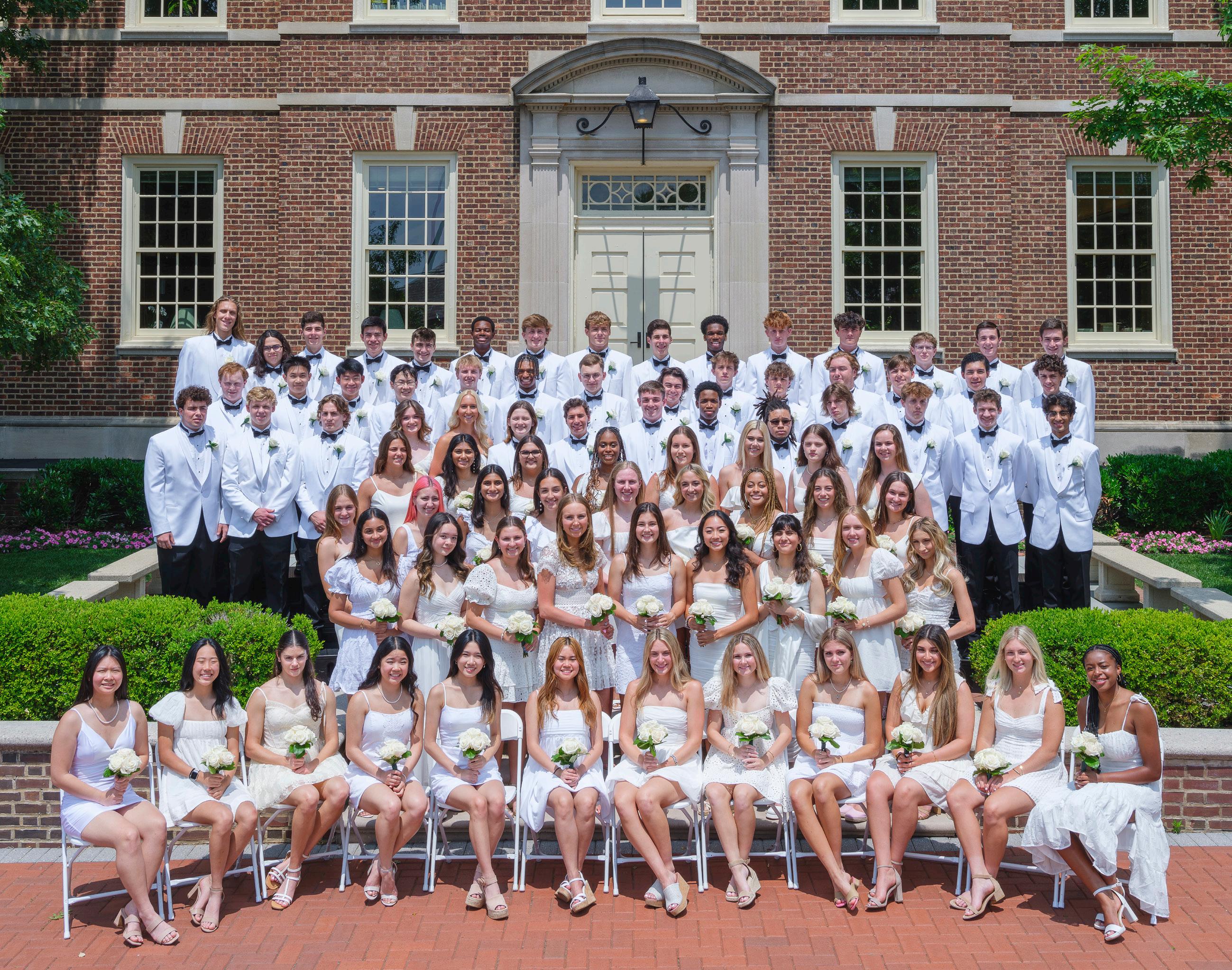
SOFIE AIRD Swarthmore College
GRACE AITKEN
University of Delaware
ANDREW ALLEN Dickinson College
ELIZABETH BARR James Madison University
SOPHIA BELLINGHAM Lehigh University
RYAN BEYER Tufts University
LEYNA BIDIC University of Virginia
LIAM BOULOS University of Southern California
RILEY BRINSFIELD Dartmouth College
BRIANNA CHI Emory University
SAGE CIMALORE Saint Joseph’s University
THOMAS CONATY Amherst College
MICHAEL CONNOLLY Georgetown University
MARTY COYNE University of Pennsylvania
ALEEZAH EHTASHAM University of Pittsburgh
CHARLES FRIZ Rice University
RACHEL GRAVELINE Clemson University
AMELIA GREGORY Duke University
BROOKE GRIFFIN Temple University
VINCENT GRILLO III United States Coast Guard Academy
CHARLES HABGOOD University of California, Berkeley
JOSHUA HALL Hampton University
SOPHIA HALMAGYI Rowan University
JORDAN HARMON Virginia Tech
CAMERON HASKINS Duke University
GAVIN HECK
The Hill School (PG program)
AVERY HEFLIN Elon University
MATTHEW HEINLE Northeastern University
GABRIEL HUANG University of Pennsylvania
BENJAMIN JORDAN University of Delaware
ANVITHA KOYA Northeastern University
AVA KYRANAKIS Lynn University
CHARLOTTE LANGLOIS Colby College
EMANI LARKIN Northwestern University
NINA LEE Cornell University
EASON LI
Johns Hopkins University
JACOB LISA Elon University
ALICE LIU University of Delaware
SARAH LIU University of Delaware
MADELINE LONG
University of Michigan
ANTHONY LUCIAN
New York University
RYAN LUO Wake Forest University
JULIANNA MALICK University of Tennessee
LEO MALIK
Florida State University
HENRY MARONEY Cornell University
WILLIAM MILLER Tufts University
ZIPORA MORRISON University of Delaware
CONSTANTINE MOUTSATSOS Haverford College
LAINEY MULLINS University of Virginia
ANTHONY MUSCELLI
University of Delaware
DRAKE MUSE
University of Mississippi
JACKSON MUSE
Savannah College of Art and Design
EDWARD NACE
Tulane University
NICHOLAS NEAL
Harvard College
MARISA NYGARD
University of Michigan
ANYA PATEL
University of Miami
ARIANA PATEL
Northeastern University
ANGEL PEDRAZA
Rochester Institute of Technology
DOMINICK PIETLOCK
Gettysburg College
ANDREW PRATT
Trinity College
CHLOE SACHS
Tulane University
CLAIRE SAUNDERS
Carleton College
KATHERINE SAUNDERS
University of Michigan
DEAN SHEPHERD
Delaware State University
DYLAN SHEPHERD
West Nottingham Academy (PG program)
CAITLIN SMITH
The College of William & Mary
JORDAN STEPANIC
University of Delaware
SYDNEY STRASSER
Bucknell University
MOLLY SUGALSKI
New York University
KIERAN SULLIVAN
West Chester University
PATRICK SULLIVAN
West Chester University
AVA SVINDLAND
The College of William & Mary
AVA TATASCIORE
University of Pittsburgh
HOLLY URBANEK
Northeastern University
ALESSANDRA VALENTINE
Elon University
THOMAS VANNI
Haverford College
ANDREW VELLA
West Chester University
GAUTAM WADHWA
Stanford University
STEVEN WOLHAR
Virginia Tech
JACKSON YOVANOVICH
Virginia Tech
HANNAH ZHAO
Penn State University
25 Tower Hill Bulletin Fall 2023
GRADUATION 2023
GRADUATION
103RD COMMENCEMENT JUNE 9, 2023
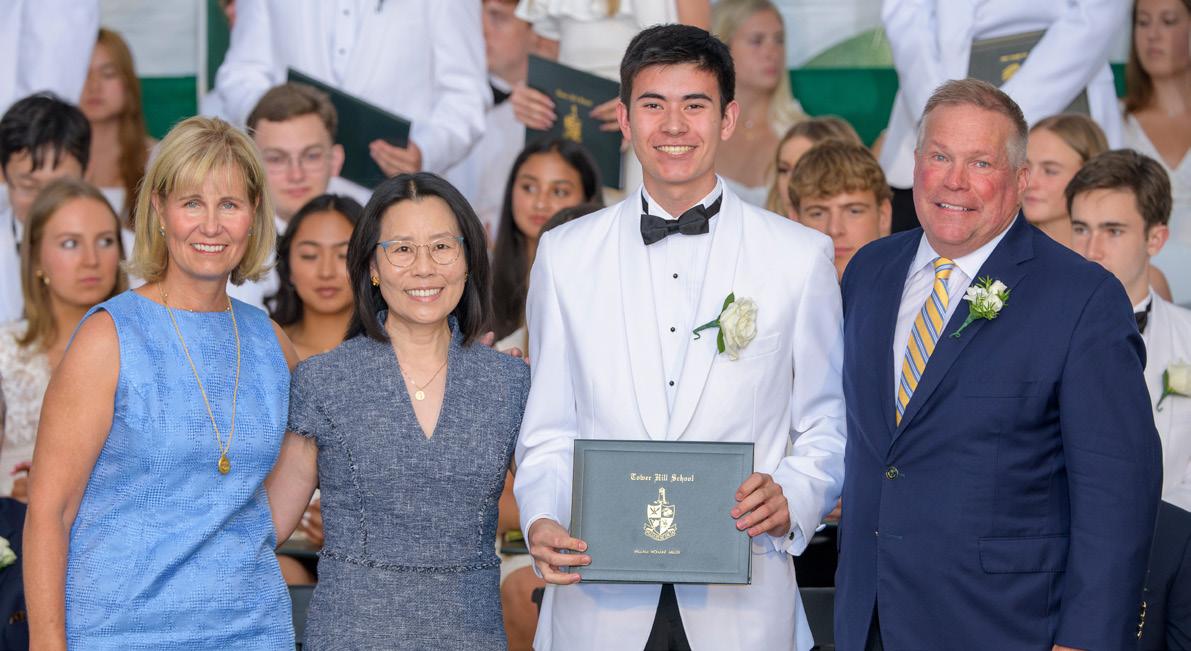
[Seniors] you have continued to model hope, humanity, and love throughout. You have shown our community that the hard work of love, respect, honesty, humility and real understanding can carry the day. Thank you for that!”
 — Elizabeth C. Speers 10th Head of School
— Elizabeth C. Speers 10th Head of School
We have grown up in an ever changing world constantly being forced to adjust to avoid being left behind. Embracing change is no longer an assignment, but an expectation. You will consistently be urged to convert, to adapt or to conform in order to succeed. And yes, while this is necessary to accomplish your goals, don’t just embrace change, enjoy it. Enjoy finding fresh and unique solutions to problems that have been dealt with the same way for years. Grow in directions that haven’t been explored before. Innovative growth is far more valuable than repetition.”
— Charles Habgood ’23 Student Government Association President
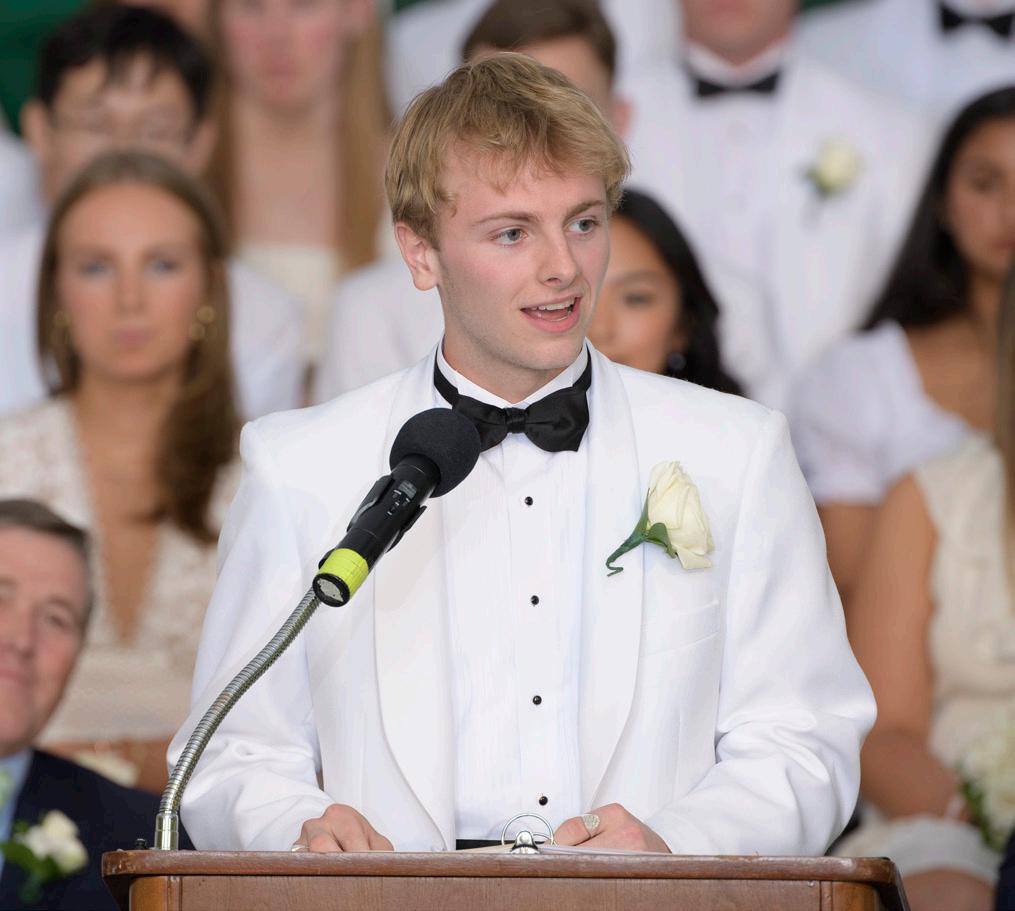
At this school, we’ve pushed ourselves past our intellectual bounds to learn about the known from our wonderful teachers and research the unknown with their guidance. It’s where we’ve learned that making mistakes does not make us failures, and failing does not make us unsuccessful. The true measure of success is how we learn from mistakes and how we persevere through failure.”
— Leyna Bidic ’23 , Class of 2023 Elected Speaker
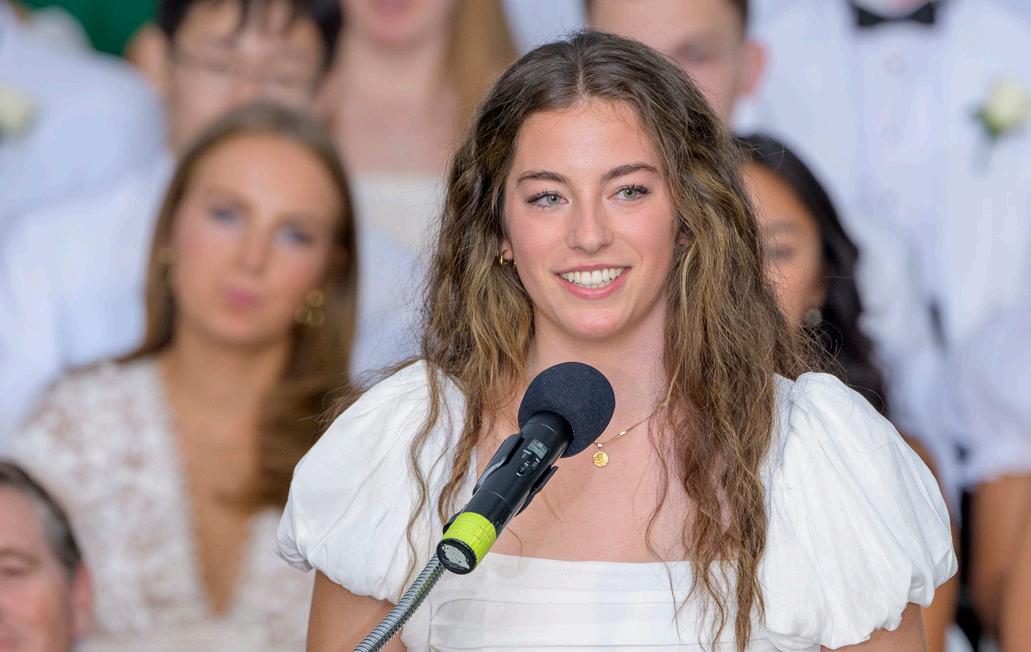
26 Tower Hill Bulletin Fall 2023
“
“
“
And my final wish for you is... that you have a mind and a heart that know no limits. Continue to take risks, to acknowledge what you’re not sure of, and to move forward with humble confidence. Above all else, nurture the human connections that make you feel limitless, that fill your heart, that are too big to explain. I know this kind of love exists thanks to all of you, my wonderful class of 2023.”
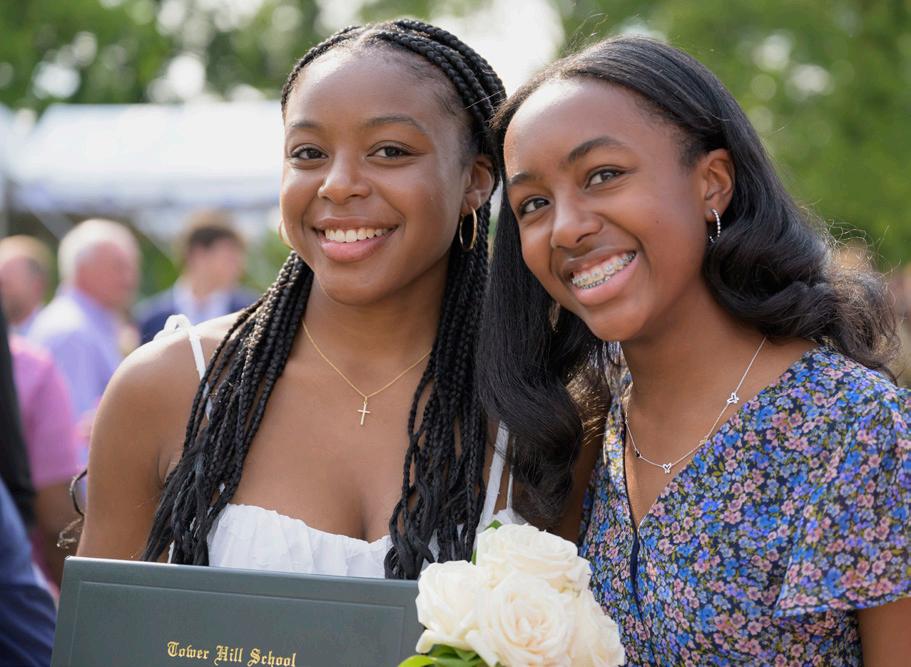 — Miriam Pallant, Spanish Faculty Member
— Miriam Pallant, Spanish Faculty Member
Opposite from top: Charles Habgood ’23 SGA President delivers his speech. 10th Head of School Bessie Speers pictured with Trustee Catherine Miller, her son Will Miller ’23, and Board Chair Ben duPont ’82 Leyna Bidic ’23 was elected to give the Class of 2023 speech. Above from top: Seniors Marisa Nygard, Michael Connolly, Eason Li, Molly Sugalski and Ava Tatasciore pose together. Fin Maroney, Thomas Vanni, Drew Pratt and Vincent Grillo celebrate after the ceremony. Miriam Pallant was the faculty member chosen to address the class. Cameron ’23 and Kennedy Haskins ’26 enjoy the day together. Eason Li’s dad helps him with his tie. Julianna Malick and Madeline Long are super excited to have earned their diplomas. Jacob Lisa and Jordan Harmon share a celebratory hug.
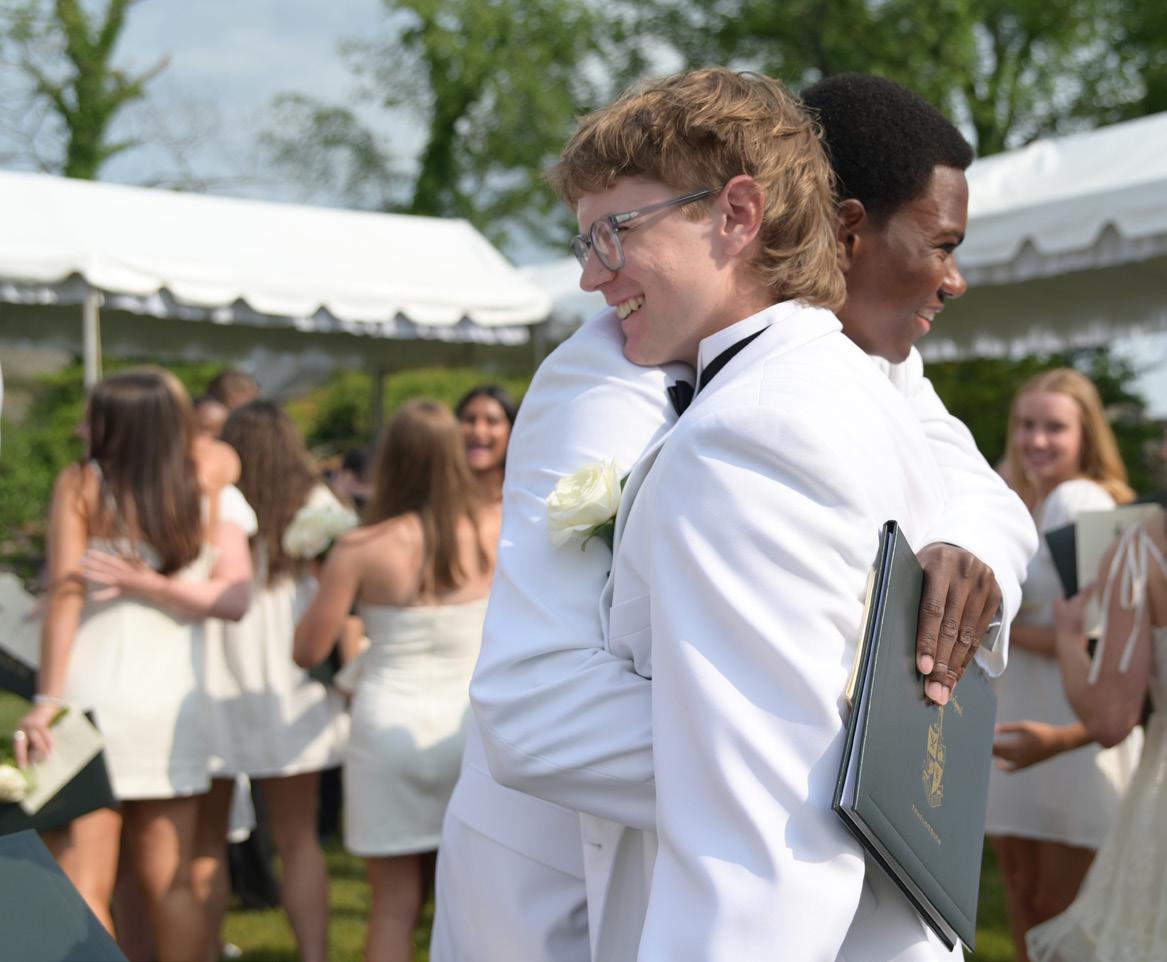
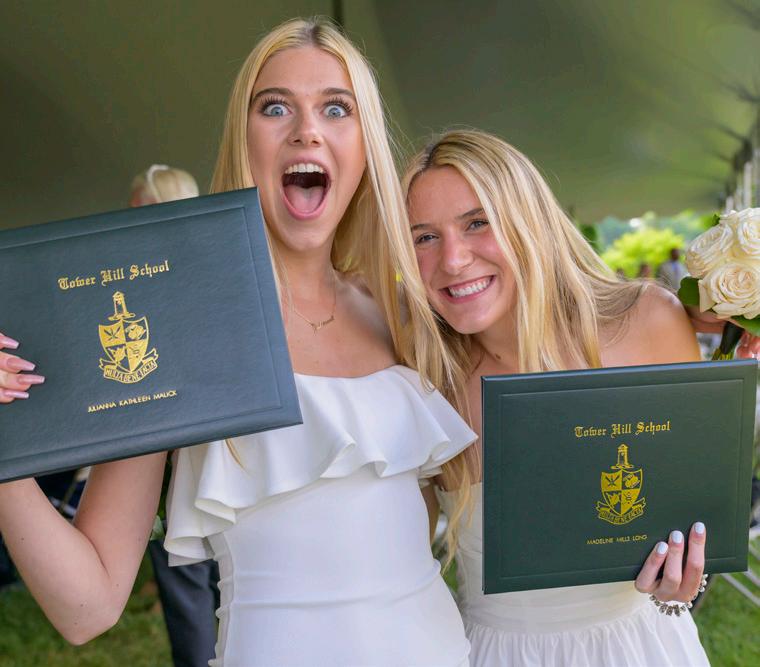
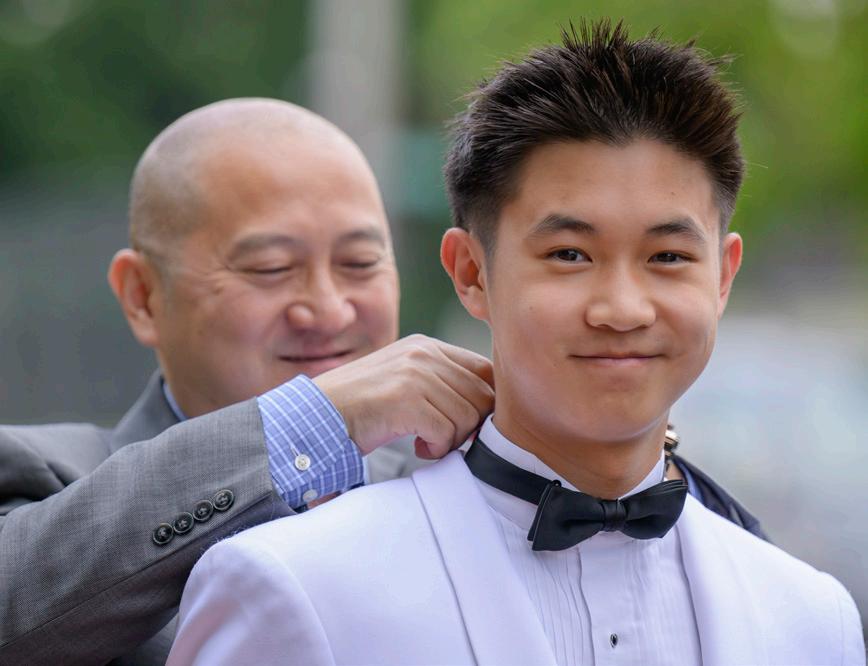
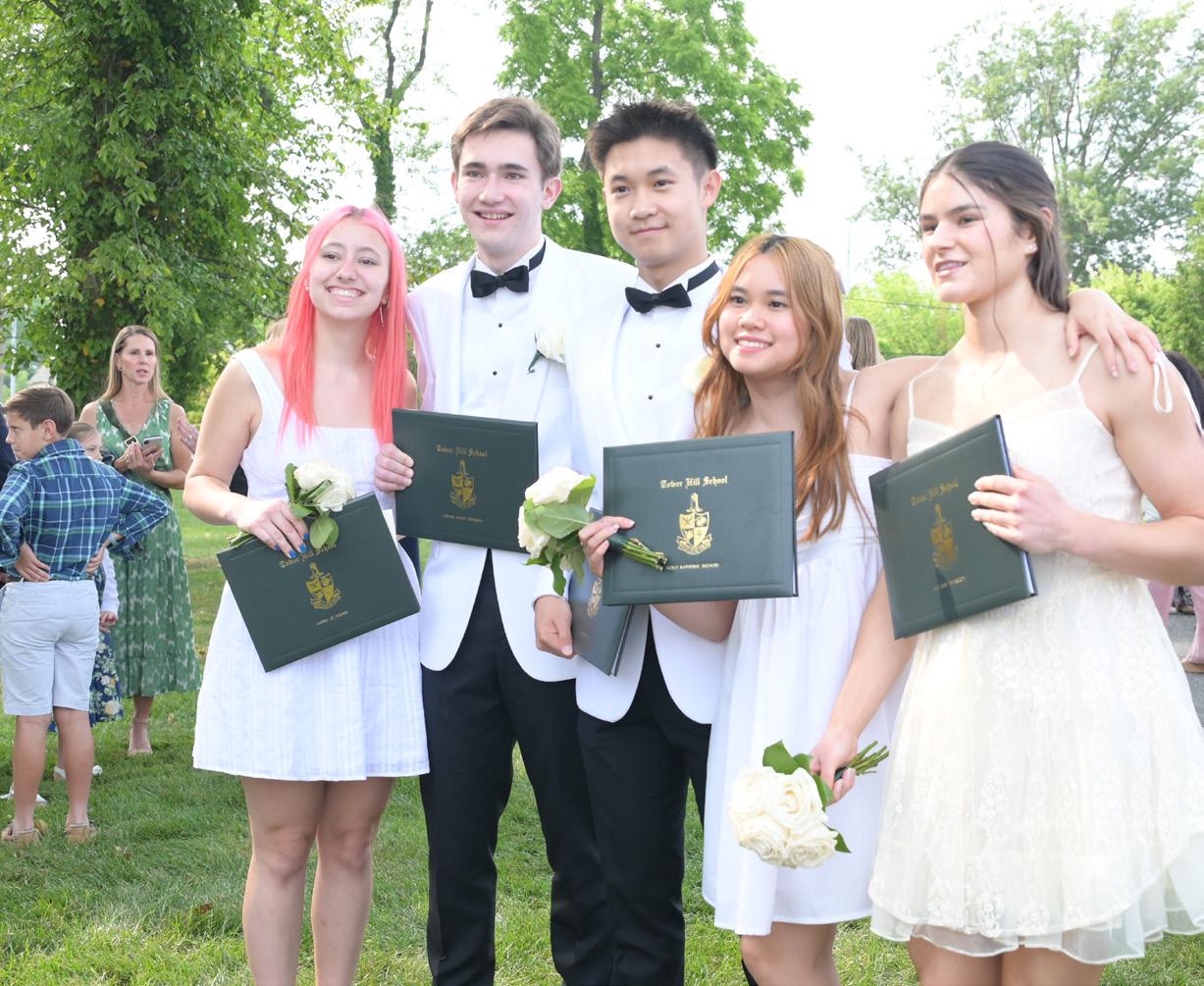

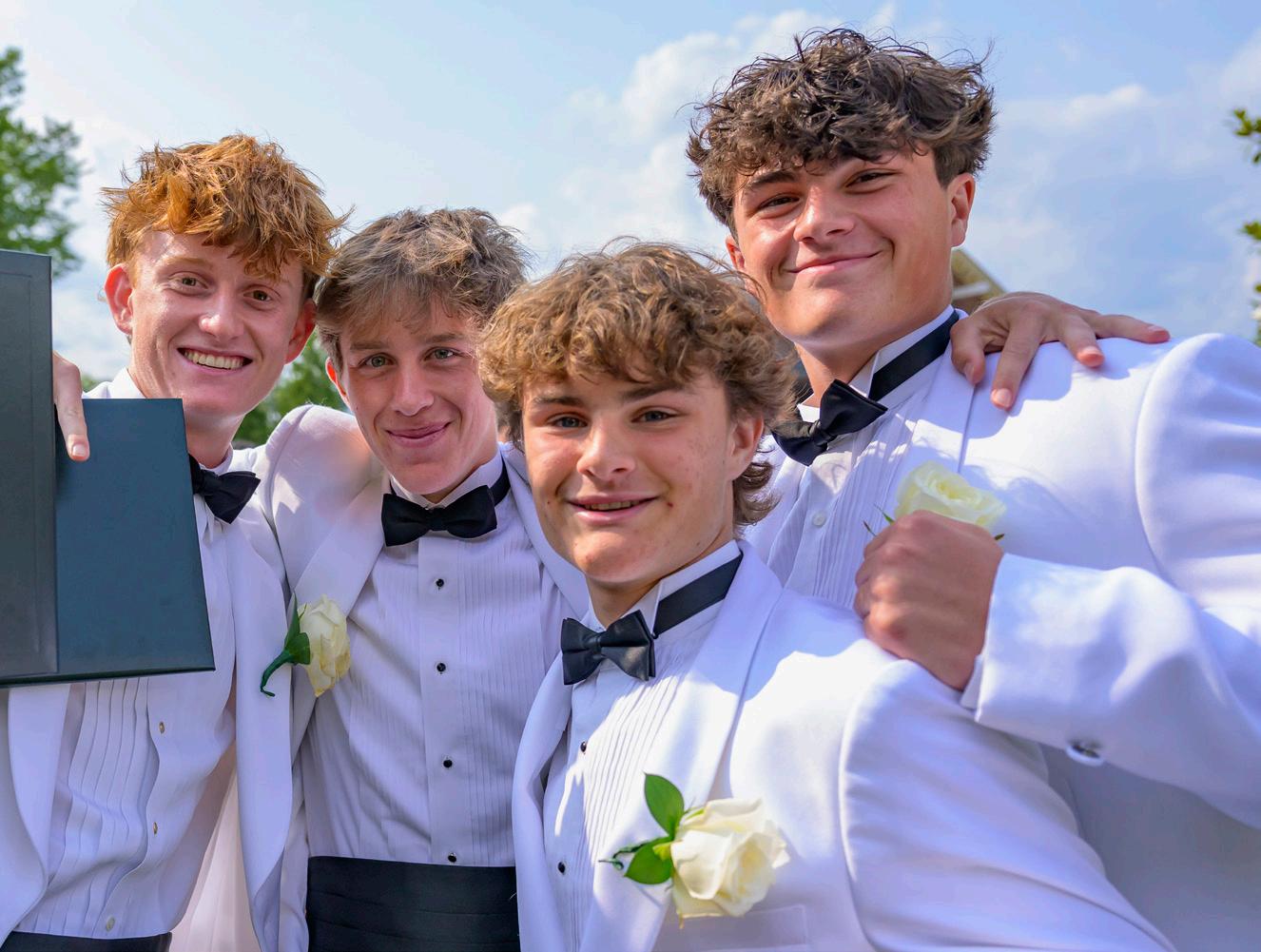
27 Tower Hill Bulletin Fall 2023
GRADUATION 2023
“
SENIOR AWARDS
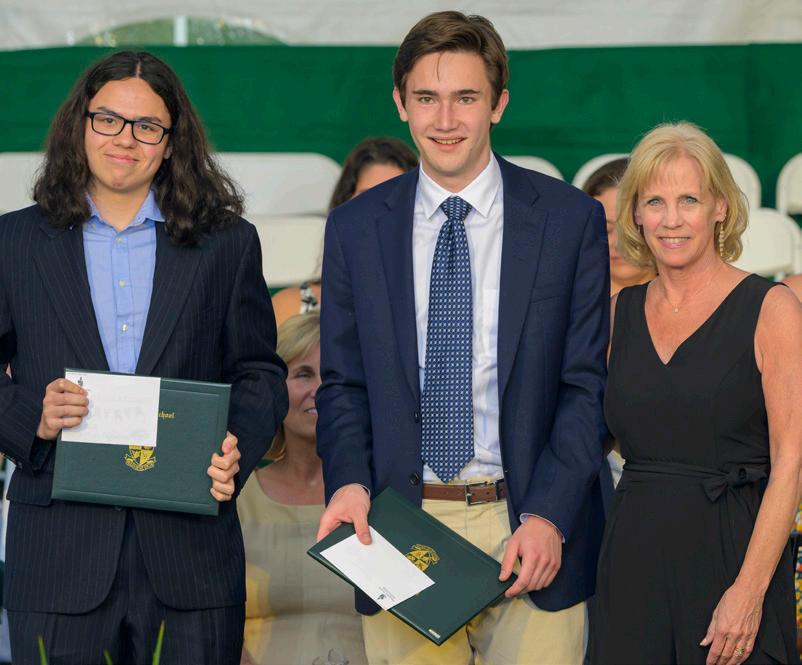
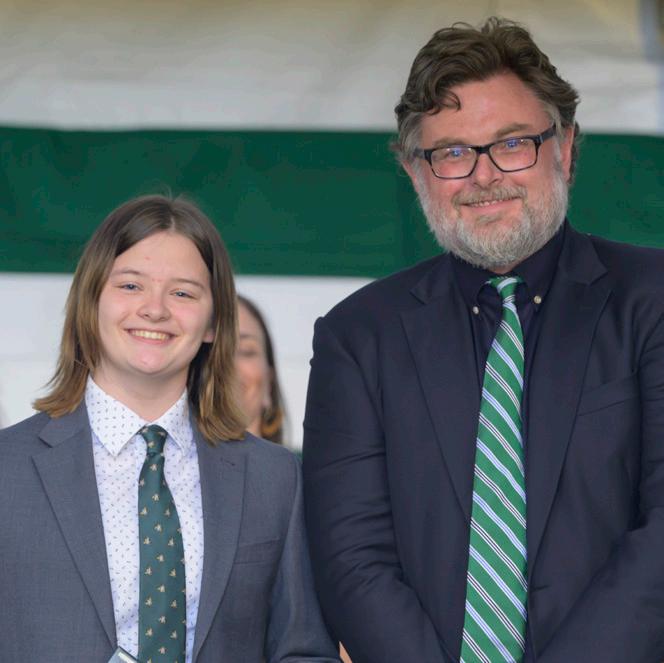
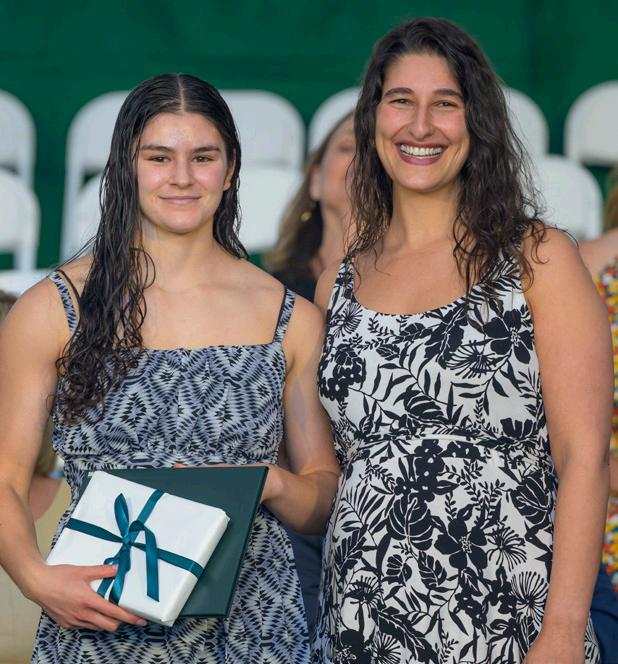
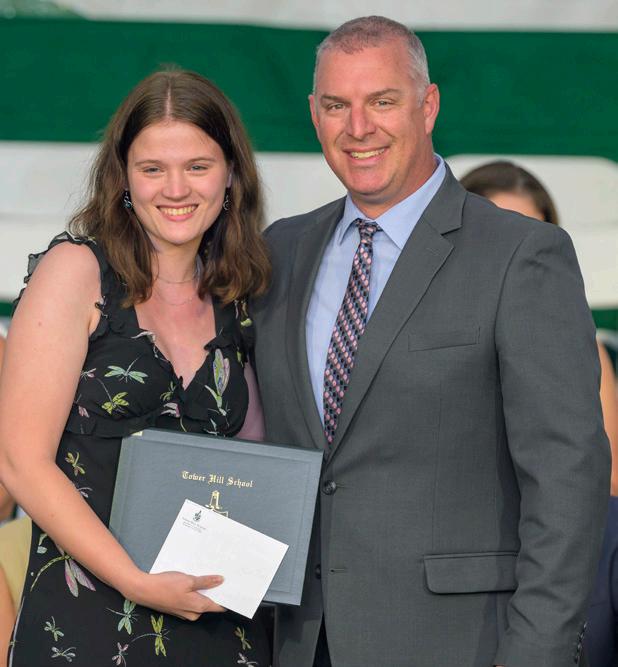

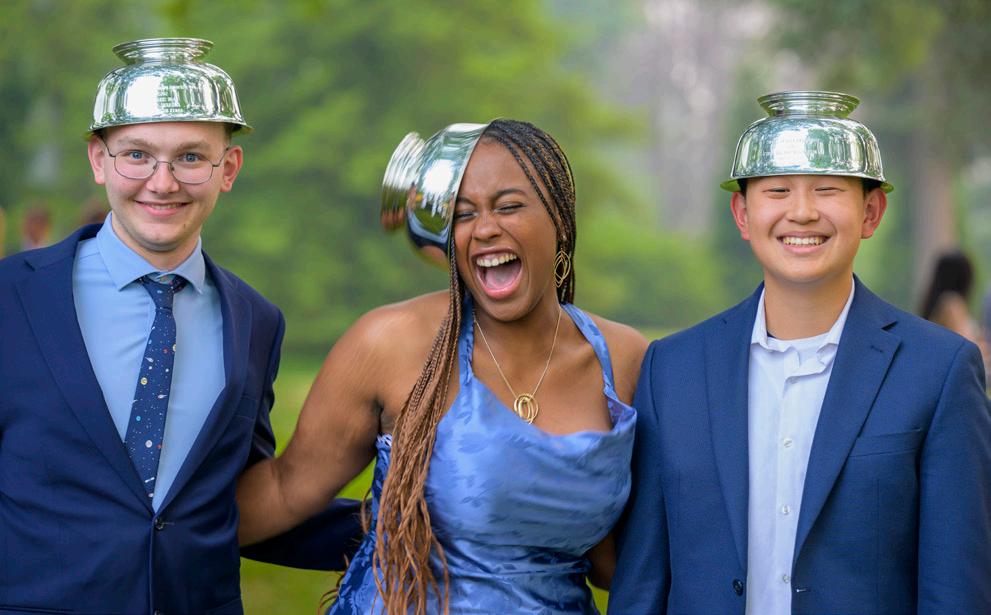
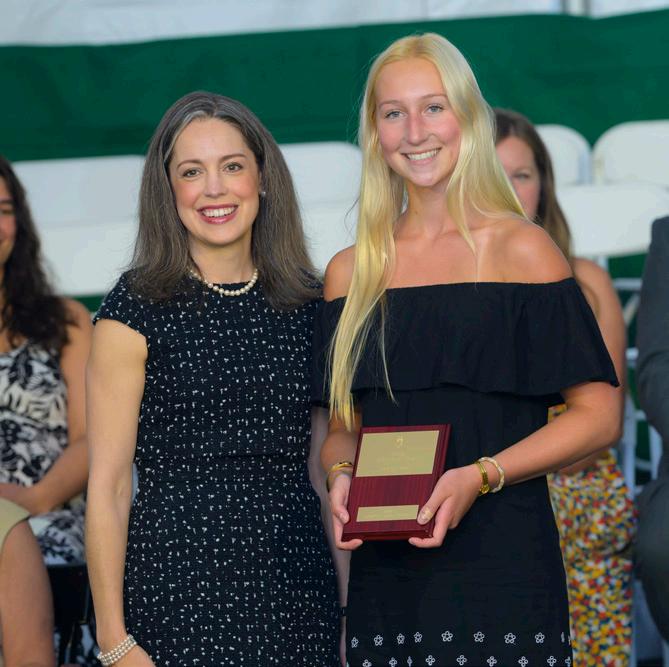
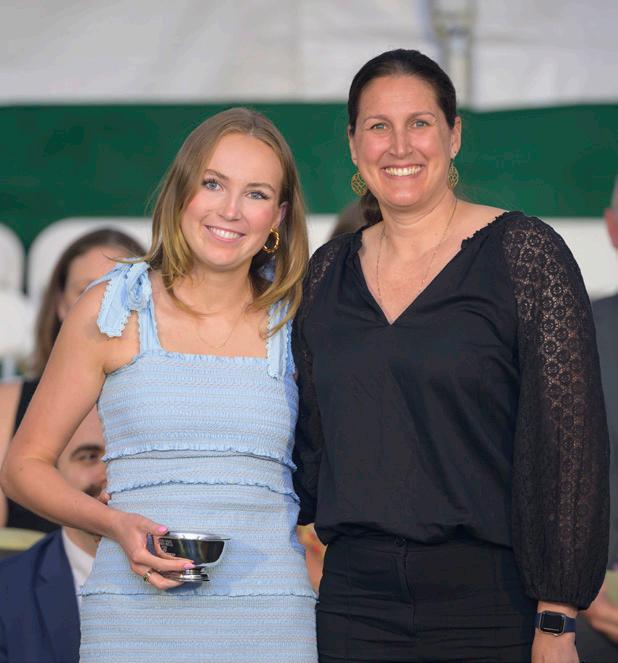
28 Tower Hill Bulletin Fall 2023
2 1 3 4 5 6 7 8
1. Riley Brinsfield receives The Tower Hill School Community Service Award from Andrea Sarko. 2. Brooke Griffin was awarded the Spiller Achievement Award by Sarah Baker. 3. Katherine Saunders was presented the William J. Carveth Music Award by Drew Keim. 4. Global Certificate Scholars. 5. Ava Tatasciore was awarded the Frank C. Ashby Language Award from Dr. Anna Miller. 6. Nicholas Max Neal and Michael Connolly both were awarded the Algard Mathematics Award by Noreen Jordan. 7. John Bartlett presents Claire Saunders with the Haon Award in Art. 8. Ben Jordan, Emani Larkin and Johnathan Zhang have fun with their awards after the ceremony.
CUM LAUDE INDUCTION
(pictured below)
Seniors inducted at the end of their junior year:
Leo Malik
Katherine Saunders
Nicholas Max Neal Gautam Wadhwa
Marisa Nygard Steven Wolhar
Claire Saunders
Seniors inducted at the Senior Awards
Ceremony:
Leyna Bidic Amelia Gregory
Riley Brinsfield Robert Habgood
Michael Connolly Gabriel Huang
Charles Friz Eason Li
Global Certificate Scholars
Riley Brinsfield
Constantine Moutsatsos
Brianna Chi Chloe Sachs
Anvitha Koya Caitlin Smith
Charlotte Langlois
Sydney Strasser
Emani Larkin Thomas Vanni
William Miller Hannah Zhao
Class of 1966 “Of Wilmington and of the World” Award
Johnathan Zhang
Katherine Ann Darnell
Multa Bene Facta Award
Aili Inguito
Haon Award in Art
Claire Saunders
RECOGNITION
David E. Scherer Dramatics Award
Emani Larkin
Benjamin Jordan
Certificate of Honor - Katherine Saunders
Certificate of Honor - Angel Pedraza
Hugh Atkins Award in English
Claire Saunders
Certificate of Honor - Katherine Saunders
Algard Mathematics Award
Michael Connolly
Nicholas Max Neal
Frank C. Ashby Language Award
Ava Tatasciore
Certificate of Honor - Riley Brinsfield
P. Edward Hughes History Award
Michael Connolly
Certificate of Honor - William Miller
Oliver Crichton Science Award
Benjamin Jordan
Certificate of Honor - Nicholas Max Neal
William J. Carveth Music Award
Katherine Saunders
Certificate of Honor - Joshua Hall
Certificate of Honor - Marisa Nygard
Certificate of Honor - Jackson Yovanovich
Cover Tower Term Leadership Award
Julian Spagnolo-Crowne
The Tower Hill School Community Service Award
Riley Brinsfield
Green and White Club Awards
Sofie Aird Charlotte Langlois
Drew Allen Madeline Long
Elizabeth Barr Leo Malik
Riley Brinsfield Zipora Morrison
Brianna Chi Anthony Muscelli
Amelia Gregory Edward Nace
Vincent Grillo III Dominick Pietlock
Charles Habgood Drew Pratt
Joshua Hall Caitlin Smith
Jordan Harmon Patrick Sullivan
Cameron Haskins
Home and School Association Athletic Awards
Edward Nace
Caitlin Smith
Spiller Achievement Award
Brooke Griffin
Trustees’ Award for Academics
Nicholas Max Neal
Trustees’ Award for Service
Benjamin Jordan
Alison Arsht Leadership Award
Emani Larkin
National Merit Commended Students - These students placed among the top 5% of more than 1.6 million who entered the 2023 National Merit Scholarship Program competition.

Brianna Chi
Michael Connolly
Amelia Gregory
Robert Habgood
Cameron Haskins
Alice Liu
Leo Malik
Marisa Nygard
Chloe Sachs
Claire Saunders
Ava Tatasciore
Gautam Wadhwa
29 Tower Hill Bulletin Fall 2023
National Merit Finalists - These students placed among the top 1% of more than 1.6 million who entered the 2023 National Merit Scholarship Program competition and fulfilled additional requirements.
Liam Audley-Digges Boulos Charles Walker Friz Gabriel Huang Eason Y. Li
GRADUATION 2023
Ryan Luo Nicholas Max Neal
SENIOR DINNER
ANDREA VALENTINE ’89 SHARES ADVICE AT ALUMNI COUNCIL SENIOR DINNER
At the Alumni Council Senior Dinner on May 3, keynote speaker Andrea Valentine ’89, mother to Ally ’23, addressed the Class of 2023.

It’s such an honor to be here tonight, serving as the Alumni Council’s speaker for Tower Hill’s Class of 2023 Senior Dinner. When the alumni team invited me to speak, I wasn’t exactly sure what I should say or share with you that you’d find meaningful. Let’s be honest, you’re the class that entered high school six months before a global pandemic and only this year have you returned to “normal!”
So for tonight, I’ve decided to simply share a couple of the most meaningful lessons I learned from my time at Tower Hill. To do that though, I need to set the scene... I arrived on West 17th Street in August 1986. Venus, by Bananarama, was at the top of the pop charts, and my family had just moved to the area from New Jersey. I considered myself an athlete and soccer was my sport—a sport that wasn’t a girls’ high school sport in Delaware yet. I had a thick Jersey accent—and, in addition to starting a new school in a new state my sophomore year, I would also be taking geometry again since it didn’t go so well for me in ninth grade! Full disclosure here—I still hadn’t recovered from my turbulent ninth grade geometry experience and did not on any level consider myself a “math person,” so having to spend another year in geometry and, on top of that, start a new sport, field hockey, had me feeling less than enthusiastic and pretty apprehensive about what the next few years had in store. [Insert sweating emoji face here.]
Fast forward to my senior year. Remarkably (my parents might say shockingly), I was now a capable, confident math student—I didn’t necessarily have the highest grade or go on to take advanced math in college, but my footing was strong. Athletically, I found my passion for field hockey and specifically goalie and was excited to continue playing in college.
So how did this happen? Behind the scenes in math, my ability to persist and become who I was senior year, was fueled by the genuine care of my teachers, specifically Ms. Anderson (now Mrs. Pepper) and Mrs. Griffith. They invested countless hours in me, during study halls and after school to be sure I had a solid understanding of key concepts. They understood that I had the capacity to learn the content at times when I didn’t believe it myself. Little did we know that my solid foundation in math would transform me into a “numbers person,” which would help open doors for me throughout my career.
On the field hockey side, while at the time I wasn’t quite sure what to make of my teammates’ insistence that my soccer skills made me the best candidate for field hockey goalie, I decided to give it a shot. Ultimately, my inspiration to really make something of the situation came from the parent of my teammate and best friend, who volunteered his time to train me day after day into the best field hockey goalie I could be. His name was Ruly Carpenter.
I’ll never forget that preseason in August before my senior year, out on what is now Richardson Field. Mr. Carpenter and I would practice at the goal on the far end of the field. Each practice started with me doing a
30 Tower Hill Bulletin Fall 2023
series of sprints in all of my goalie gear as he timed me with the stopwatch hanging around his neck. The deal was this—I had to do three sets of each sprint, improving my time on each sprint—meaning that my last one had to be my fastest one. I remember one morning feeling a bit dizzy after my sprints so I laid down on my back in the grass next to the goal. Mr. Carpenter came running over with the hose, spraying it in the air, asking in a concerned voice, “Dre, hey, Dre, are you ok in there?” not realizing the hose had dropped to his side and was pouring directly onto my face inside my helmet! Needless to say, I popped up quickly.
Then, later on in the season, at the end of practice on Tower Road field with the state tournament around the corner, I peeked down W. 17th Street to see if Mr. Carepenter’s big, old Wagoneer was in front of school. I didn’t see it so I thought the coast was clear. I walked off the field and began packing up for the day when all of a sudden I heard a loud creak—I jerked my head around to see the Wagoneer parked at the corner and there was Mr. Carpenter in a very bright red, plaid suit—plaid jacket, plaid pants—opening the back of his truck to grab a tall bucket of baseballs and his fungo bat, along with a towel from the training room that he had flung over his shoulder. I knew what the drill was, so back to the cage I went. This was a drill we practiced more times than I could count, especially since we lost in the state quarterfinals the year before in penalty strokes. Mr. Carpenter laid the towel on the stroke line, kneeled down and proceeded to simulate penalty strokes “ala fungo bat” for the next 20 minutes. At the end he said “Dre, we’re ready!” And I believed him. A couple of weeks later, we went on to beat that same team in the state semifinals in penalty strokes.
From those experiences and my time at Tower Hill, I learned two key lessons.
The first was not to be afraid of change. Change can be really powerful and positive as soon as you realize that life is all about navigating changes—and that just because something is different, doesn’t mean it’s bad. For me, the move to Delaware and to Tower Hill and playing field hockey, presented the opportunities for change that I needed, although I may not have realized it at the time.
The second lesson I learned was about the importance of showing up. I wouldn’t have accomplished what I was able to in high school, college and my career had my math teachers and Mr. Carpenter, along with so many other people throughout my life, not shown up for me.
Now back to you, the Class of 2023. You’re graduating next month having successfully navigated changes beyond any I experienced during my time at Tower Hill. For two-and-a-half years your school and social life were turned upside down. During that same time, you also saw Tower Hill—teachers, staff and coaches—show up for you in ways that most schools didn’t. You also
showed up for yourselves and each other. This wasn’t easy! While daily symptom checking, one-way hallways, quiet lunches and masks were not what you envisioned for your high school years, you did it and are here today.
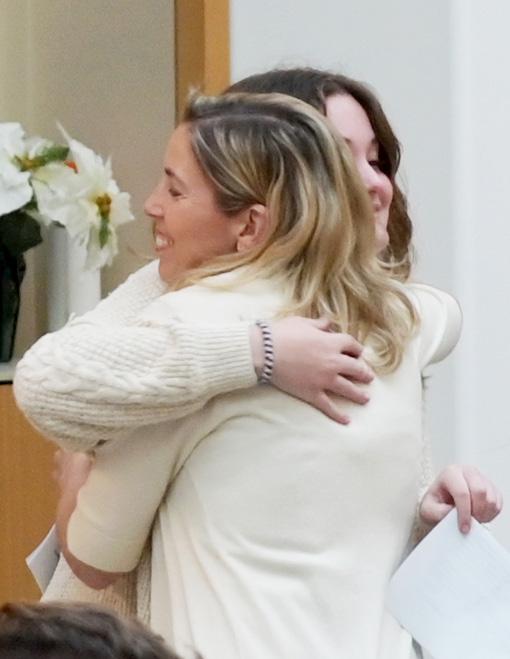
As you move on to what’s next, you’re equipped not only with the knowledge you learned from your classes and activities, but also with ability and wisdom beyond your years on how to persevere through change, a lot of change, and to do so while staying focused and with grace and compassion.
Throughout my career, I’ve seen firsthand that being able to navigate change AND having the strength to show up, even in the most difficult times—that this combination is essential to leading well. Leadership isn’t about always being in charge or being able to do everything perfectly or by yourself. Rather, at its core, leadership is about knowing yourself, using your talents to help others and accepting help from others when you need it. This give and take is critical for any team to function at its best—it’s what builds thriving cultures and communities.
When you graduate next month, you’ll have opportunities to continue refining these skills—seeking to understand change, sometimes being a driver of change and showing up for your new communities, just as you did here at Tower Hill, even when it was hard.
You enter this next phase of your lives with a truly unique perspective and set of experiences that will bond you, the Class of 2023, together forever and help you reshape the future in ways we can’t imagine today. I’m excited to watch as you chart your new paths forward. And, on behalf of the Tower Hill Alumni Council, we’re thrilled and honored to welcome you into the Tower Hill alumni family.
31 Tower Hill Bulletin Fall 2023
“Change can be really powerful and positive as soon as you realize that life is all about navigating changes—and that just because something is different, doesn’t mean it’s bad.”
GRADUATION 2023
Above: Ally Valentine ’23 introduces her mother Andrea Valentine ’89 followed by a good luck hugs.
LEGACY FAMILIES
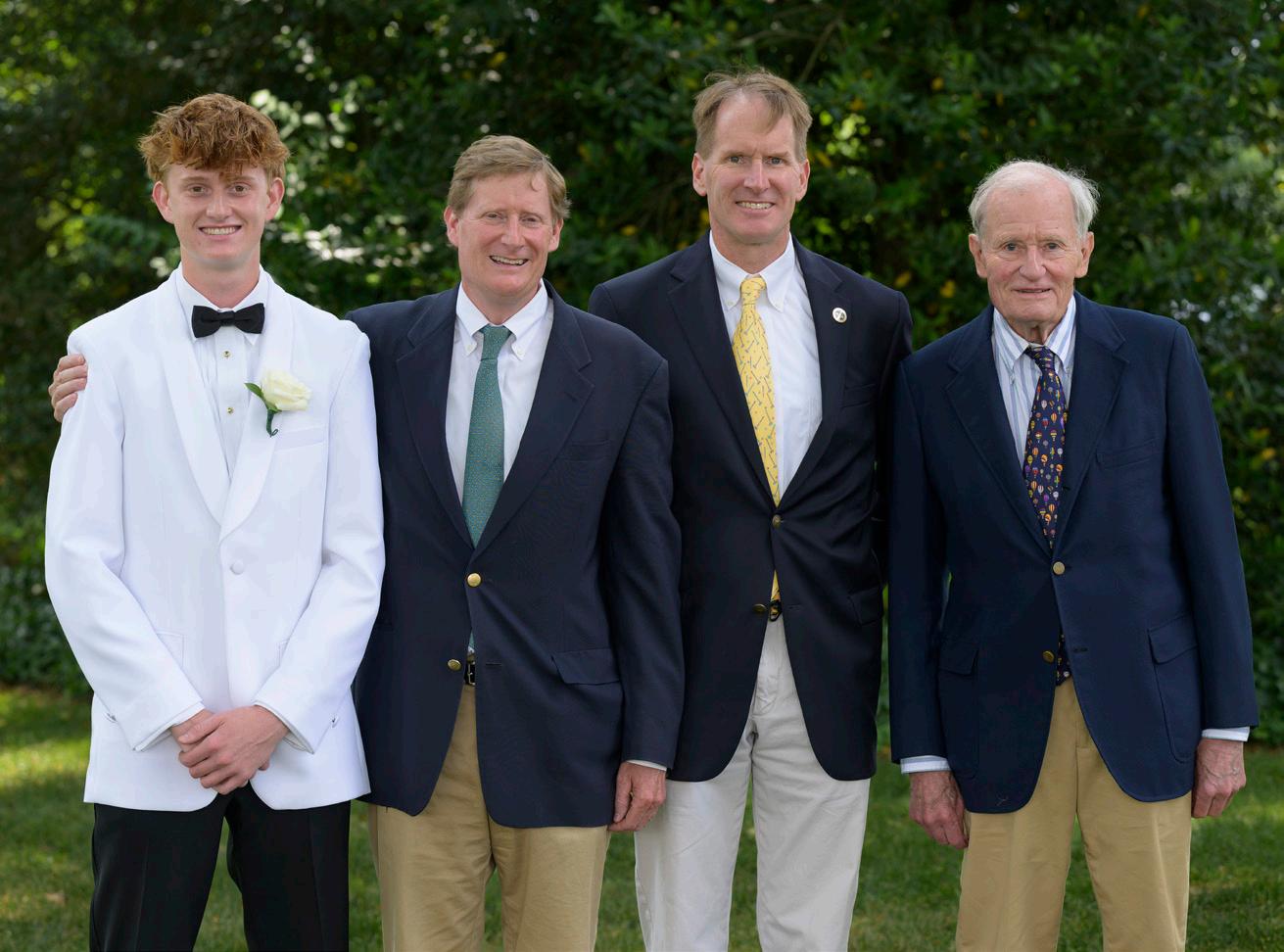
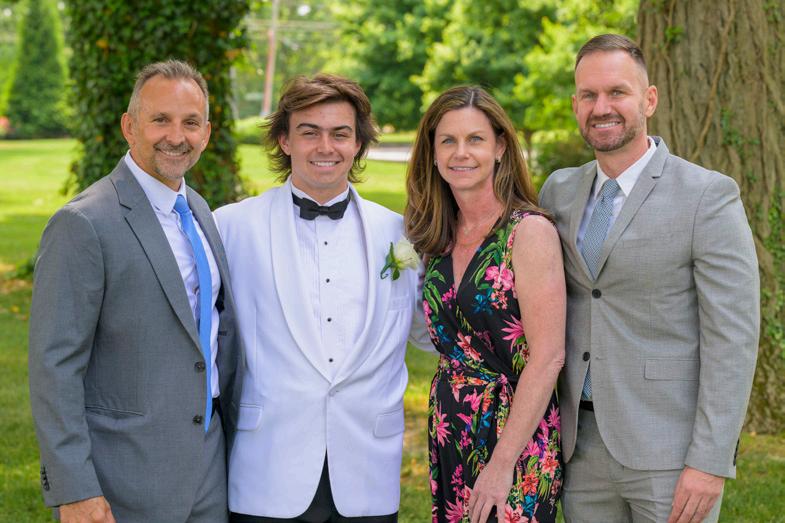
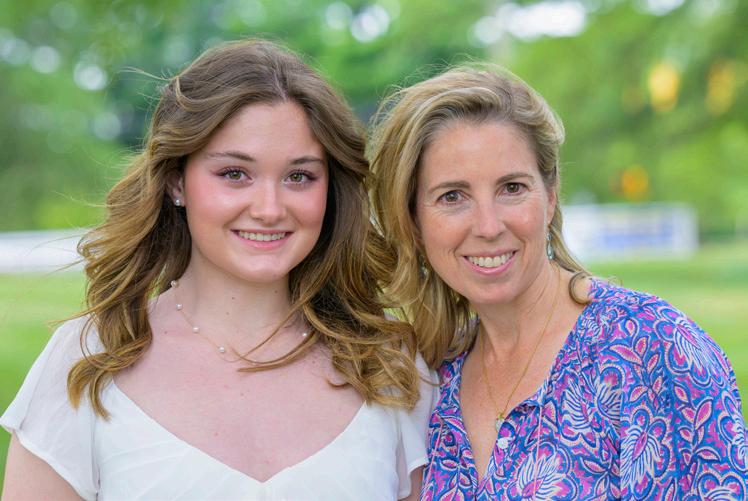
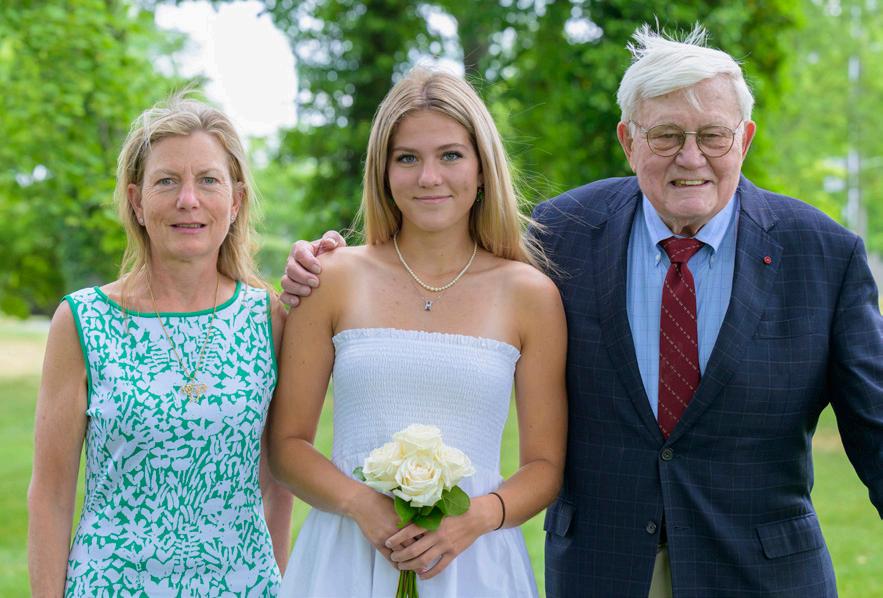
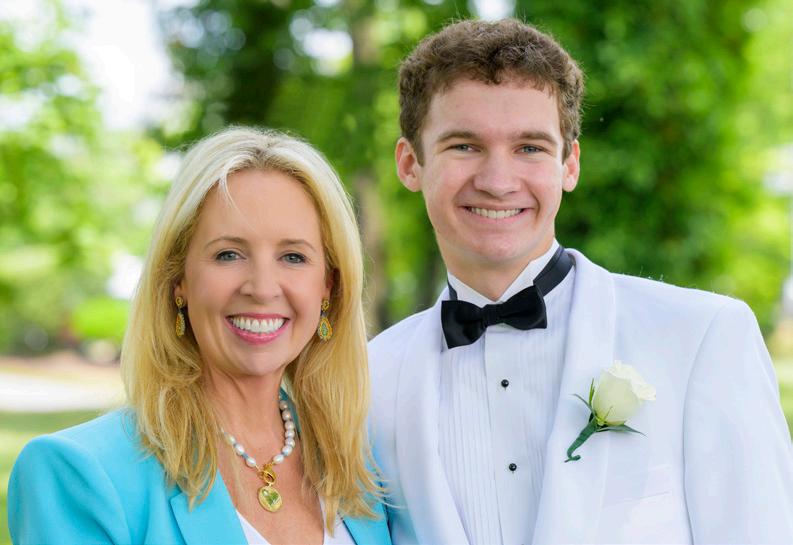
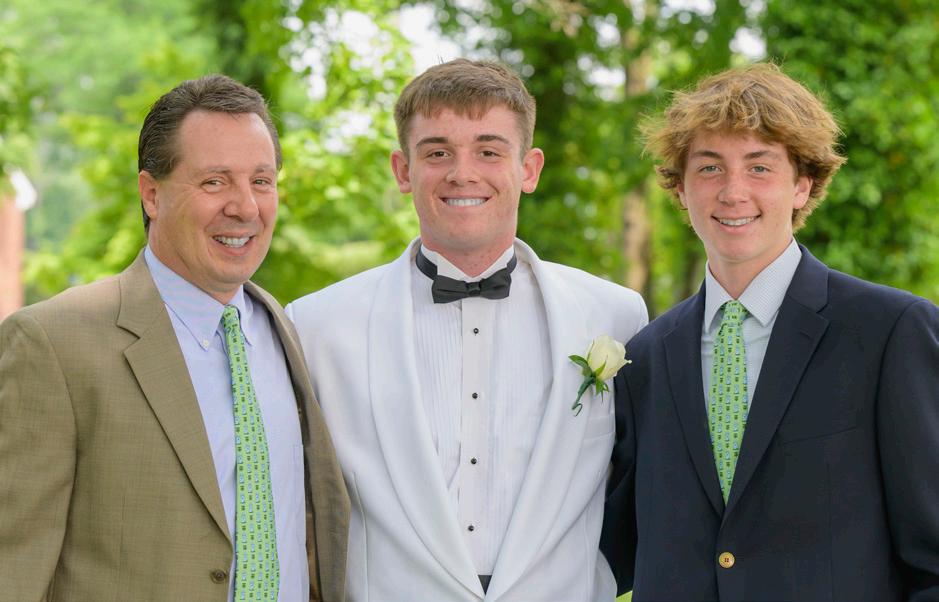
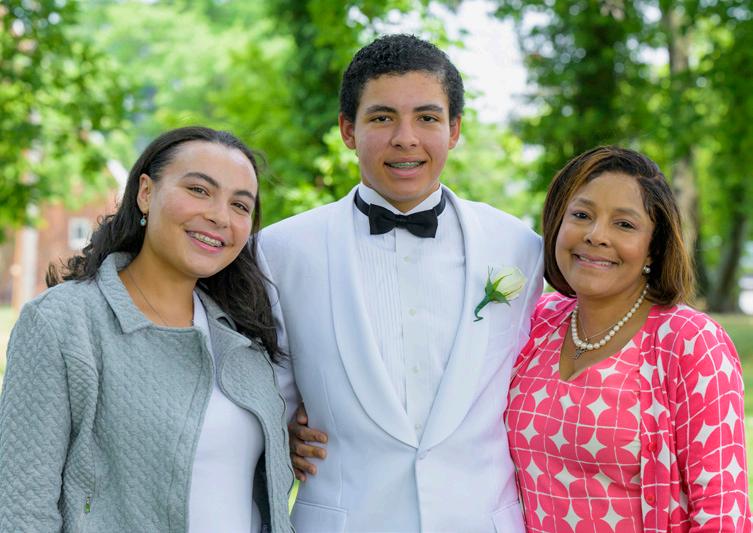
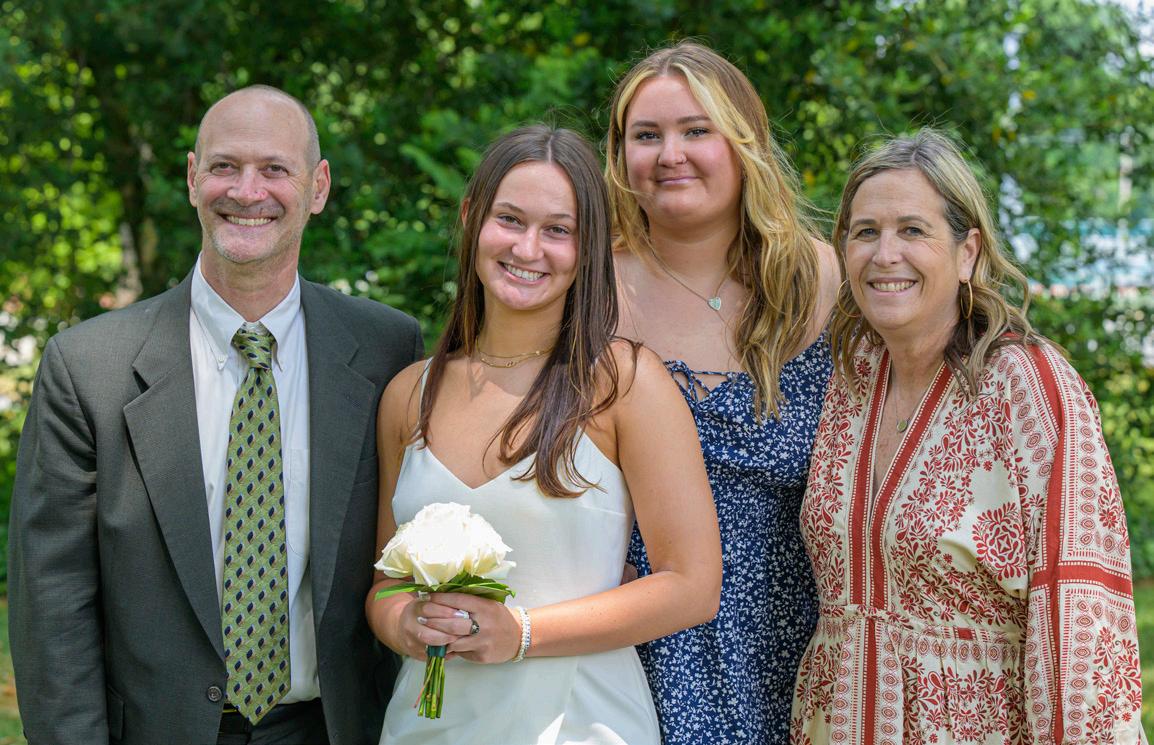
32 Tower Hill Bulletin Fall 2023
1. Henry Maroney ’23, Whit Maroney ’87, Rod Maroney ’85, Ron Moroney ’59
2. Amanda Friz ’92, Charlie Friz ’23
3. Gary Yovanovich ’92, Jack Yovanovich ’23, Deb Colbourn ’92, David Colbourn ’96
2 1 3 4 5 6 7 8
4. Meredith Beyer ’22, Ryan Beyer ’23, Courtney Collier-Beyer ’82 5. Michael Sachs ’86, Chloe Sachs ’23, Maddie Sachs ’19, Sheryl Brotman ’82 6. Ally Valentine ’23, Andrea Trippitelli Valentine ’89 7. Betsy Bynum Barr ’83, Elizabeth Barr ’23, Walter Rowland ’57 8. Anthony Muscelli II ’84, Anthony Muscelli III ’23, Elam Muscelli ’26
8TH GRADE MOVING UP DAY
Tower Hill recognized the eighth grade class at the annual Moving Up Day ceremony on June 8. Family, friends and faculty gathered to hear advisers share insights about each student’s accomplishments and contributions to the class. In addition to the three awards presented, Head of Middle School Tim Weymouth noted the many talents of the eighth grade as a class.
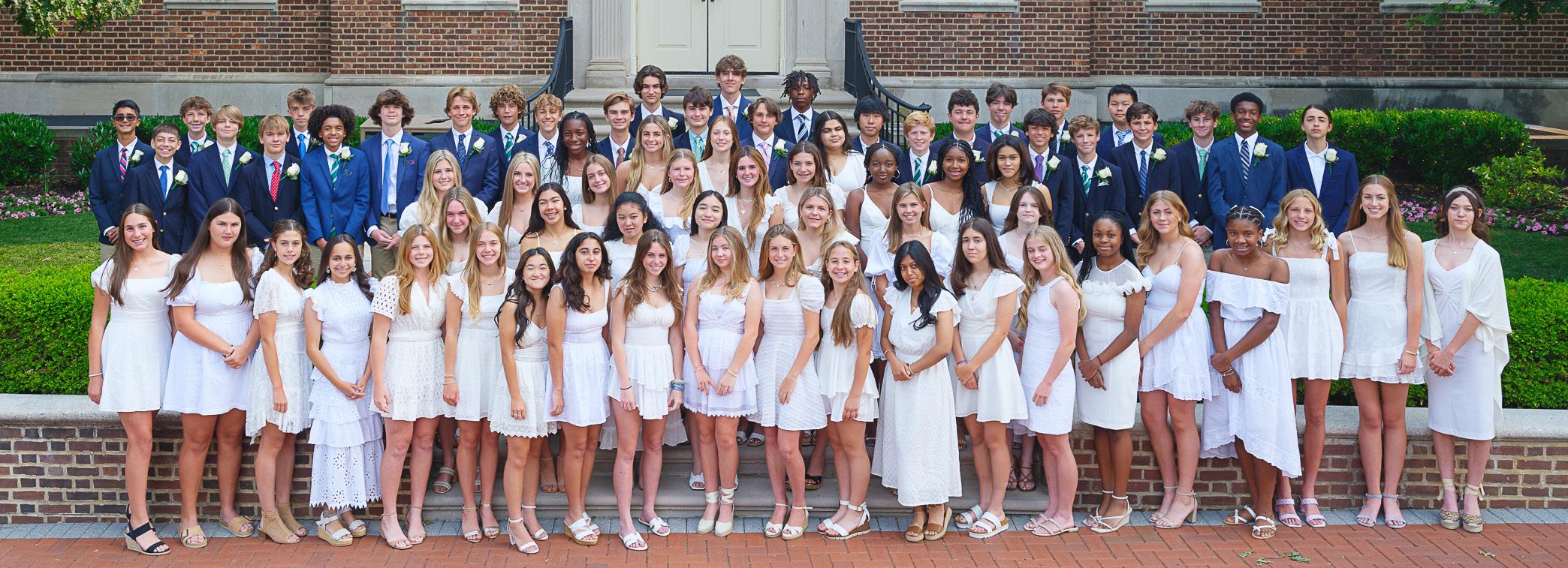
George “Mills” Maroney and Eli Browne received the Tower Hill Humanitarian Award, given to the eighth grader(s) who, in the opinion of their classmates, has been the best friend to all. Margaret “Margo” Weymouth received the Cecile M. Buckles Award, given to the eighth grade student who best exemplifies enthusiasm, effort, cooperation and energetic involvement. Tatiana Hynansky received the Alumni Association Achievement Award for demonstrating particular growth in citizenship and scholarship. Congratulations to the Class of 2027!
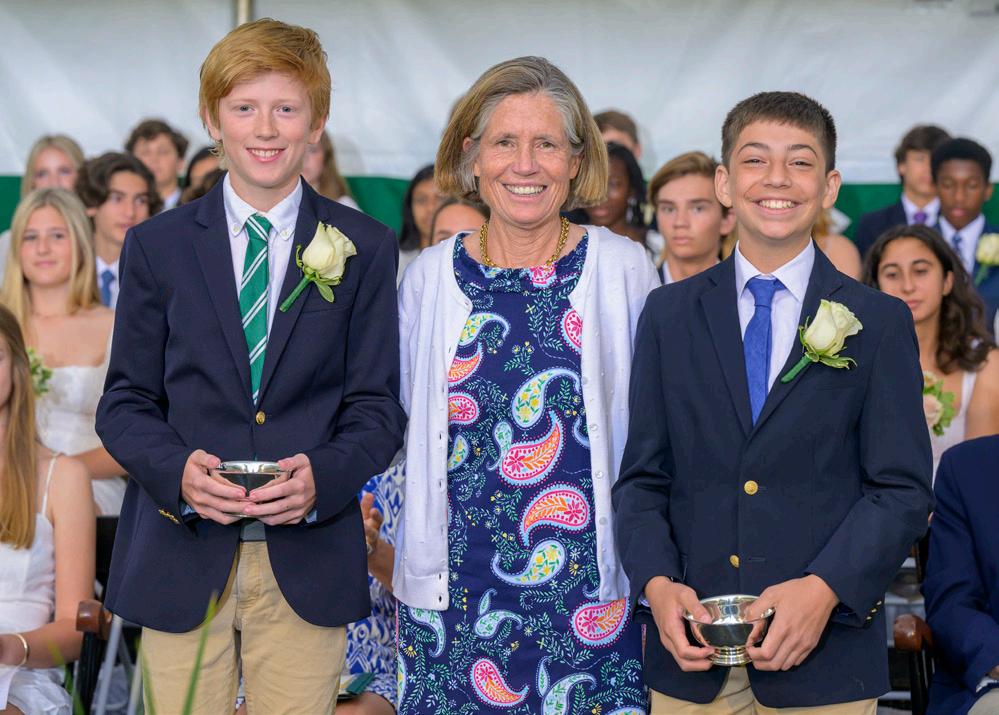
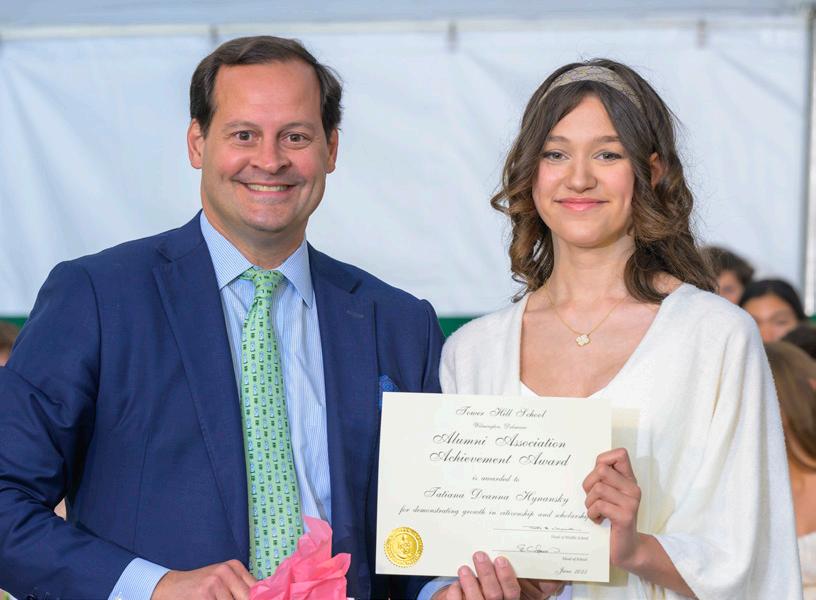
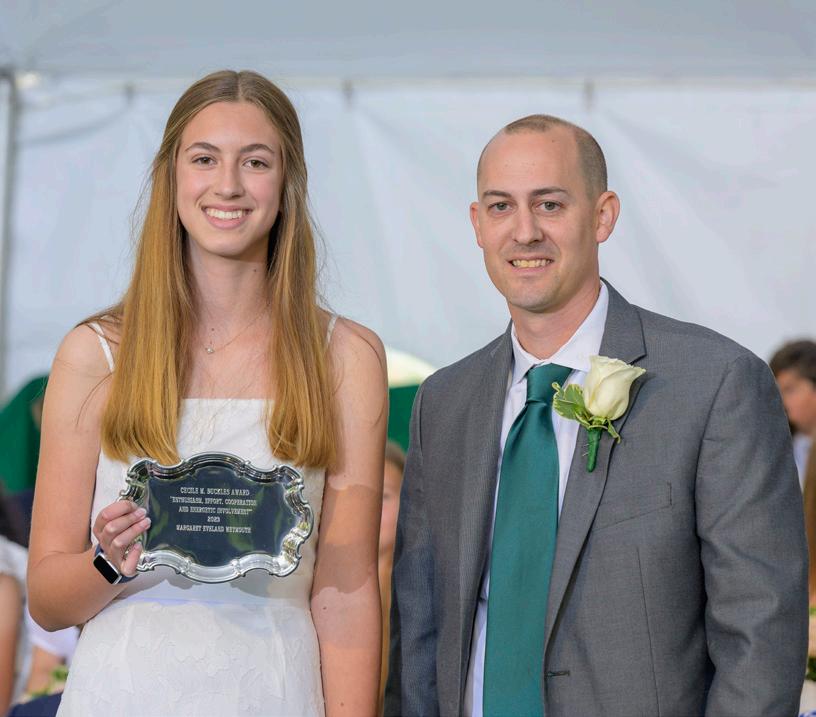
33 Tower Hill Bulletin Fall 2023
Ashley Altschuler ’90 and Tatiana Hynansky ’27
MOVING UP DAY
Margo Weymouth ’27 and Paul Mulvena
Mills Maroney ’27, Wiz Applegate ’79 and Eli Browne ’27
ACADEMICS
BATTLE OF THE BOOKS
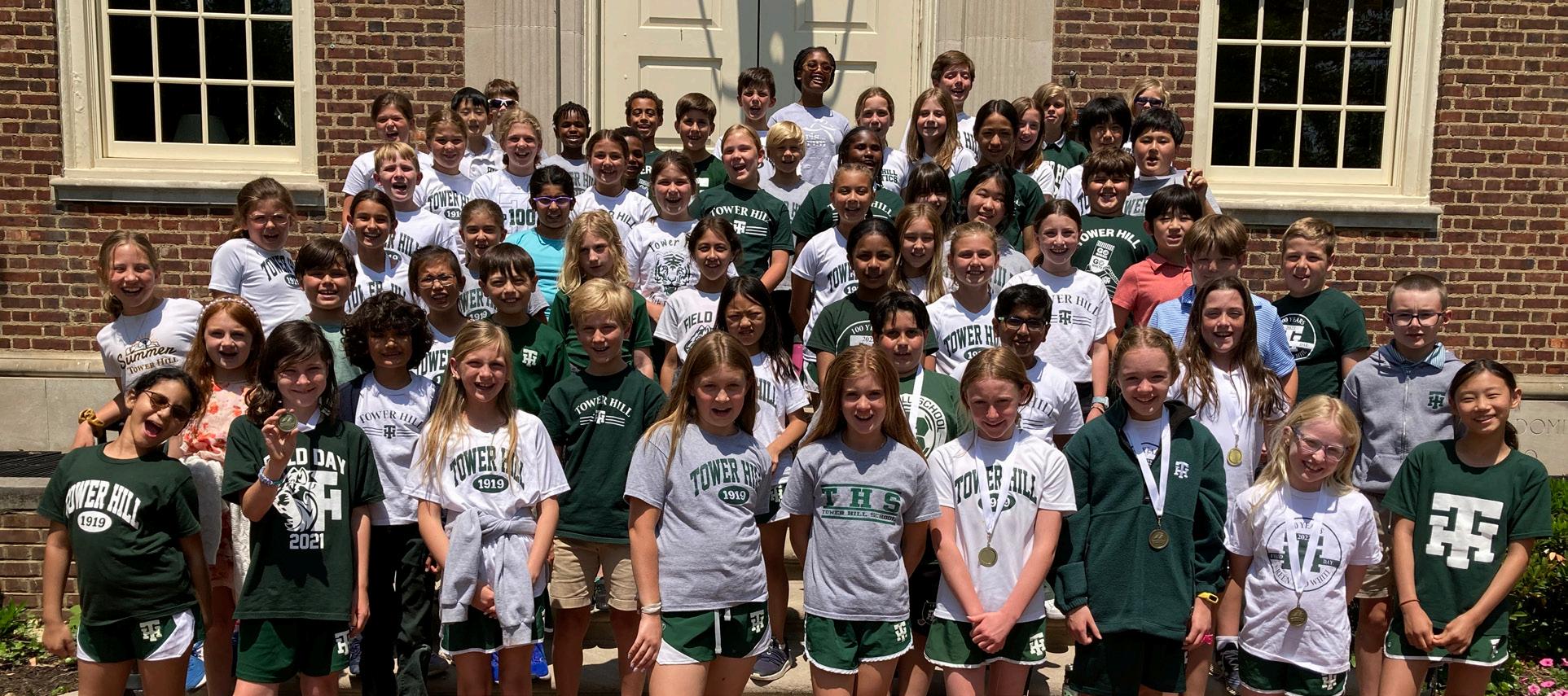
Big Battle of the Books (BBB) brings together fourth and fifth grade students from Wilmington-area independent schools in a voluntary, friendly reading competition that spans the entire school year. The Battle begins in October and culminates in a tri-school trivia battle at the end of May. This year, there were 14 total books in the Battle representing a mix of fiction and nonfiction as well as different genres, offering varying lengths and text density. This year we had almost 70 students representing Tower Hill, split evenly between fourth and fifth graders. Host school Wilmington Friends opted for a “collaborative” showdown, so much to the dismay of our highly competitive THS students there was no single school winner. The total number of books read was 554! Special achievement medals were awarded to ‘super readers,’ those students who read 10, 12 or all 14 books.
LATIN AWARDS
Congratulations to the students who earned medals and certificates in this year’s National Latin Exam awards. Grade 7: magna cum laude: Alexa Neal, Cici Flynn. cum laude: Valeria Liu, Claire Connolly. Grade 8: summa cum laude: Margo Weymouth. cum laude: Everett Bradley. Latin 2: maxima cum laude: Aashritha Koya, Alex Neal, Michael Waesco, Johnathan Zhang. magna cum laude: Thatcher Flynn. Latin 3: maxima cum laude: Zaden Lockwood. magna cum laude: Nicole Neal. Advanced: Summa cum laude: Kate Connolly. magna cum laude: Michael Connolly. cum laude: Cassie Dong.
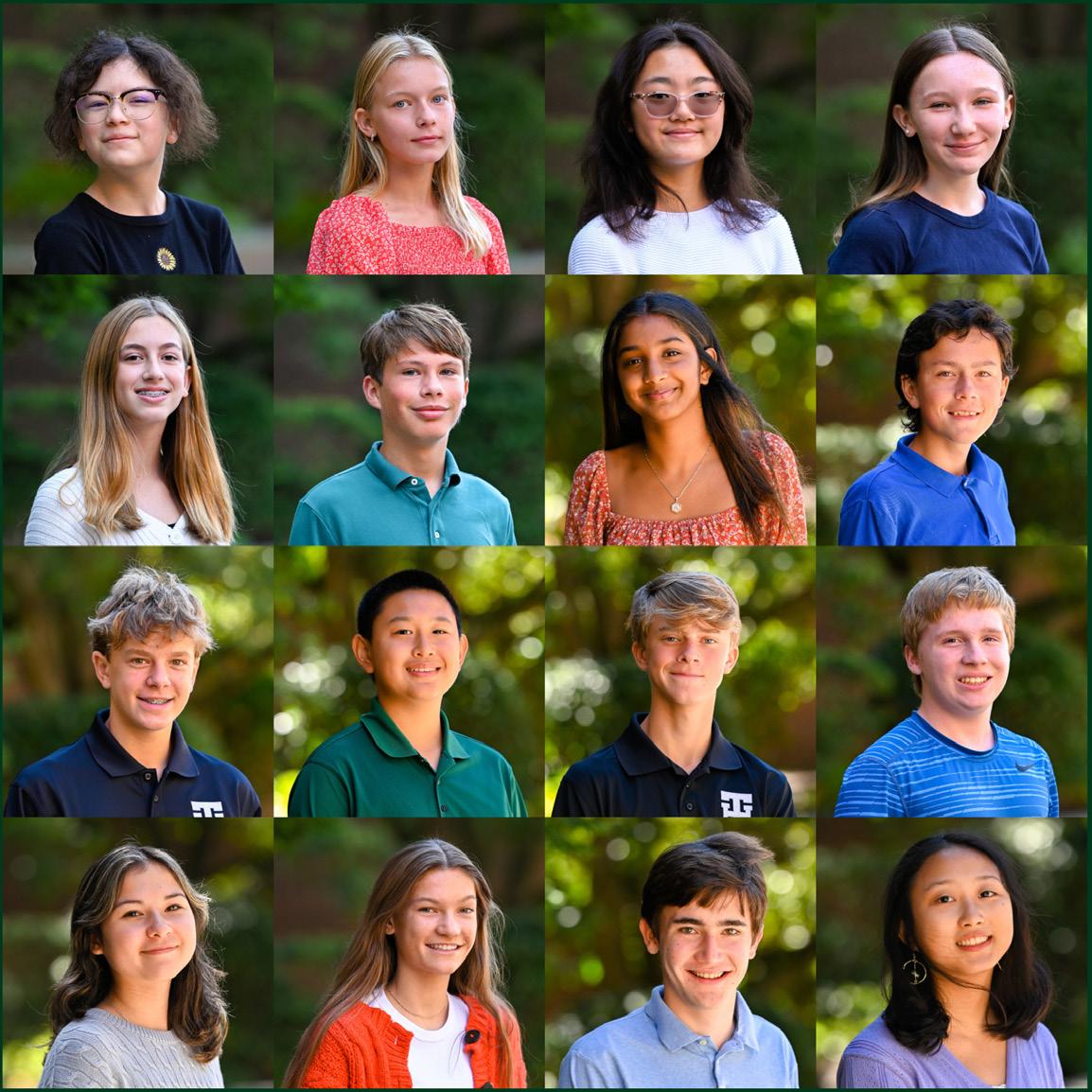
34 Tower Hill Bulletin Fall 2023
ROBOTICS SHOWCASE 2023
Fifth grade students showcased their LEGO Robotics final projects for their friends and family at the Delaware Museum of Nature and Science. Students constructed various robotic animals that performed behaviors using ultrasonic sensors, color sensors and touch sensors. There was a chicken that danced around its coop, a cheetah that attacked its prey and even a flamingo that enjoyed a shrimp martini! (L-R): Lilly Preininger,
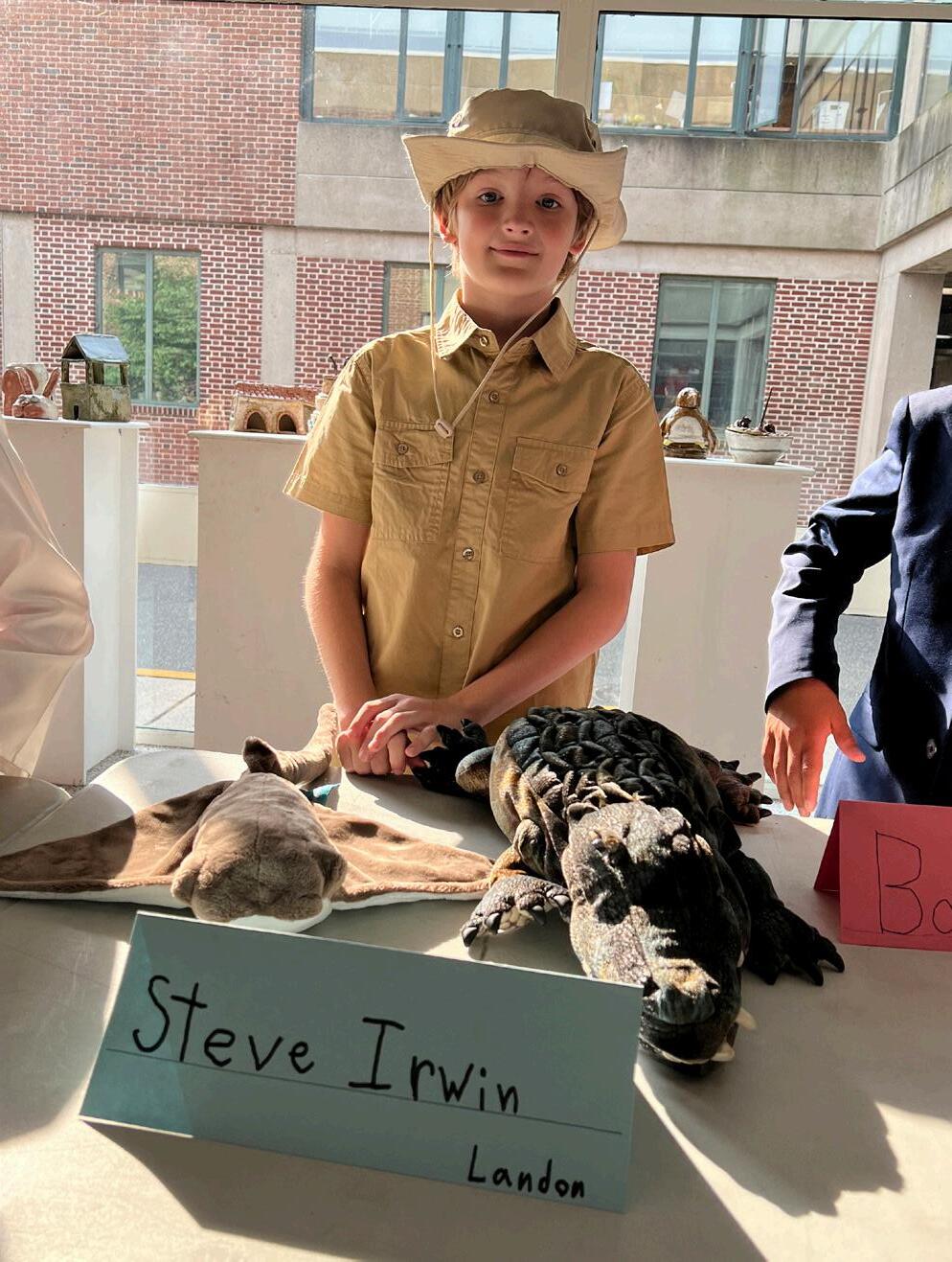
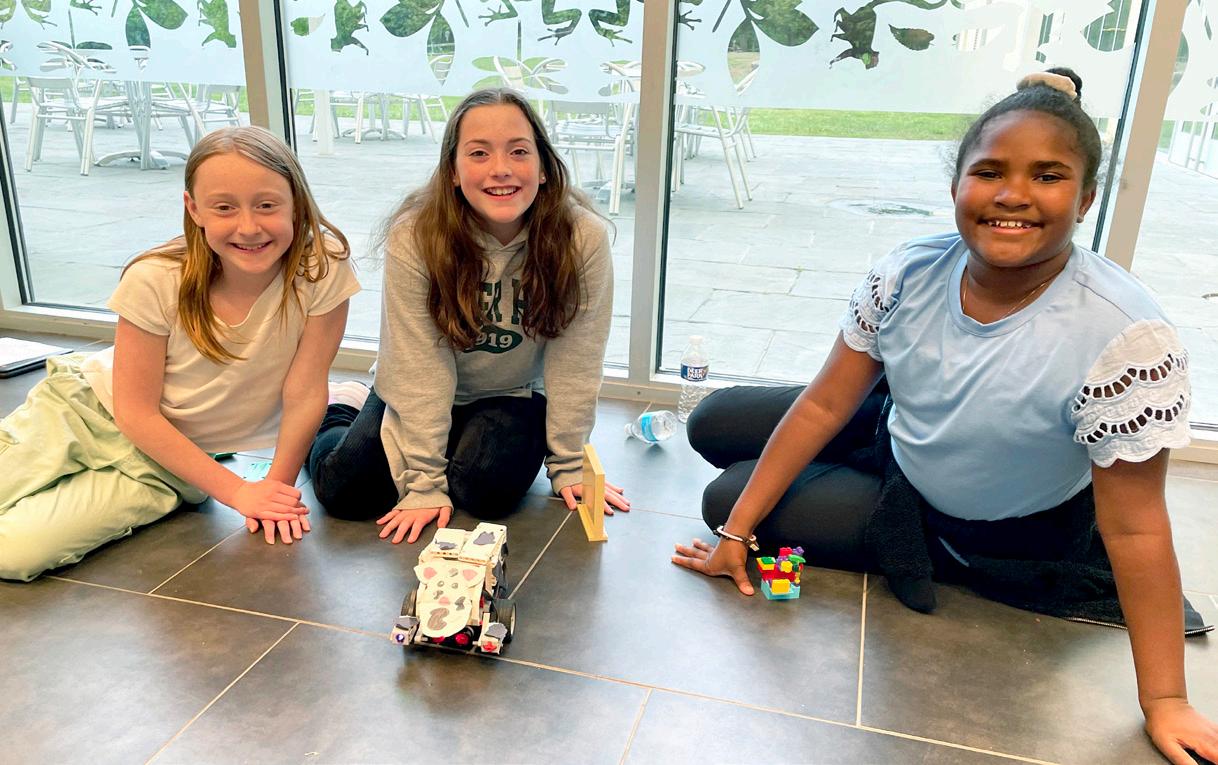
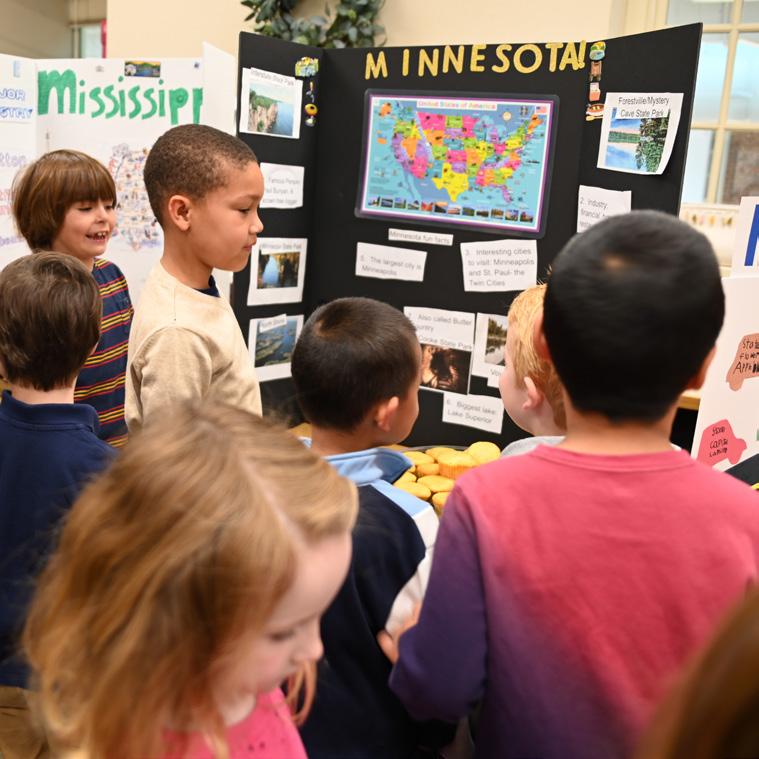
STATE FAIR
After an in depth study of the regions of the United States, second grade students put their early research skills into practice to learn about their chosen state and to celebrate with original and enticing displays highlighting both well and lesser known state facts. From Vermont to Georgia and Arkansas to Montana the State Fair project represented the uniqueness and beauty of our country.
Third
GLOBAL SCHOLARS
Tower Hill’s Global Scholar Certificate Program provides Upper School students with opportunities to explore global dynamics, leadership and cultural growth. Participating students complete academic coursework related to global inquiry, educational travel, extra-curricular enrichment and service with a global focus. Seniors (Hannah Zhao pictured) in the program produced and presented capstone projects proposing solutions to various challenges in different geographic regions within the framework of the United Nations’ 17 Sustainable Development Goals.
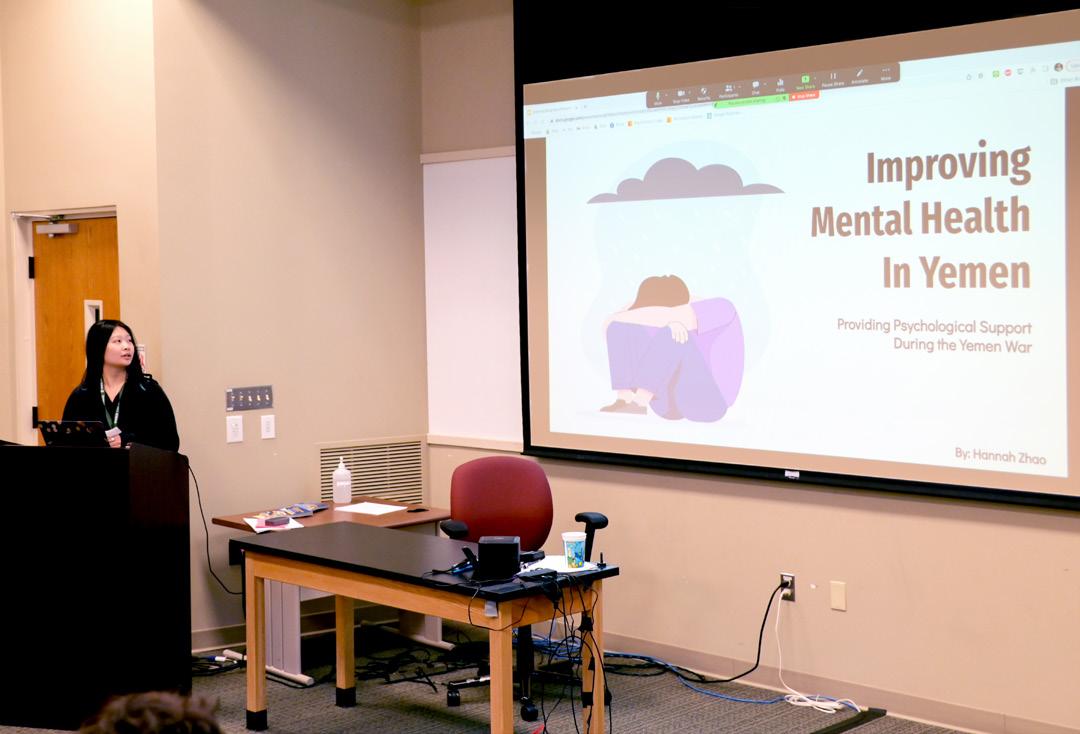
35 Tower Hill Bulletin Fall 2023
ACADEMICS
graders researched and presented chosen Change Makers to family and friends. Shown above Landon Ashbrook presented Steve Irwin.
ACADEMICS
WORLD’S FAIR
The Lower School concluded the Global Study Passport Program by giving presentations on a region within the continent they studied this year. Global studies offer our students the opportunity to focus on a culture or region while introducing them to geography, climate, art, music and lifestyle. Each grade level from Tower Tots through fourth grade participates.
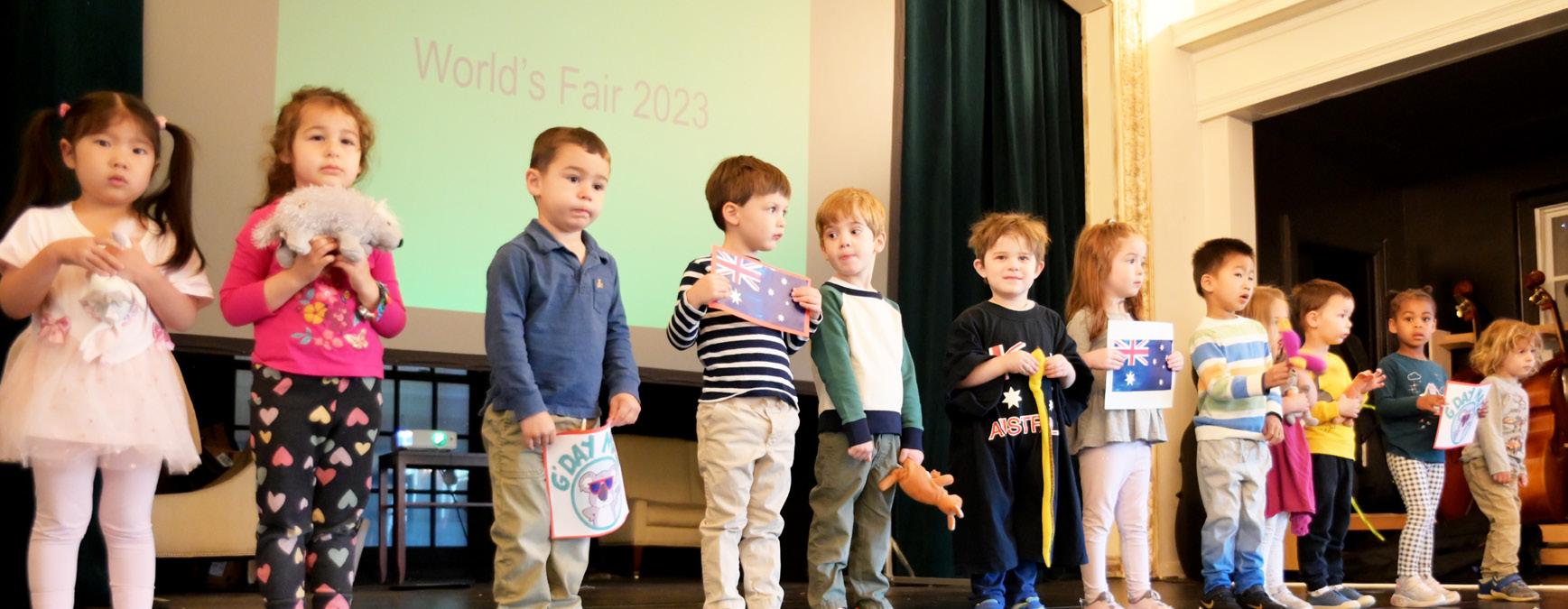
INTERACTIVE SOUND SCULPTURES
Sixth grade students (Dahlia Garnick pictured) constructed “interactive sound sculptures” as part of their study of sound waves: frequency, wavelength and amplitude. The Middle Schoolers shared their learnings with Lower School students during an outdoor showcase. The sixth graders used microphones connected to their computers to graph sound waves and display the specific sound frequency and amplitude of their projects.
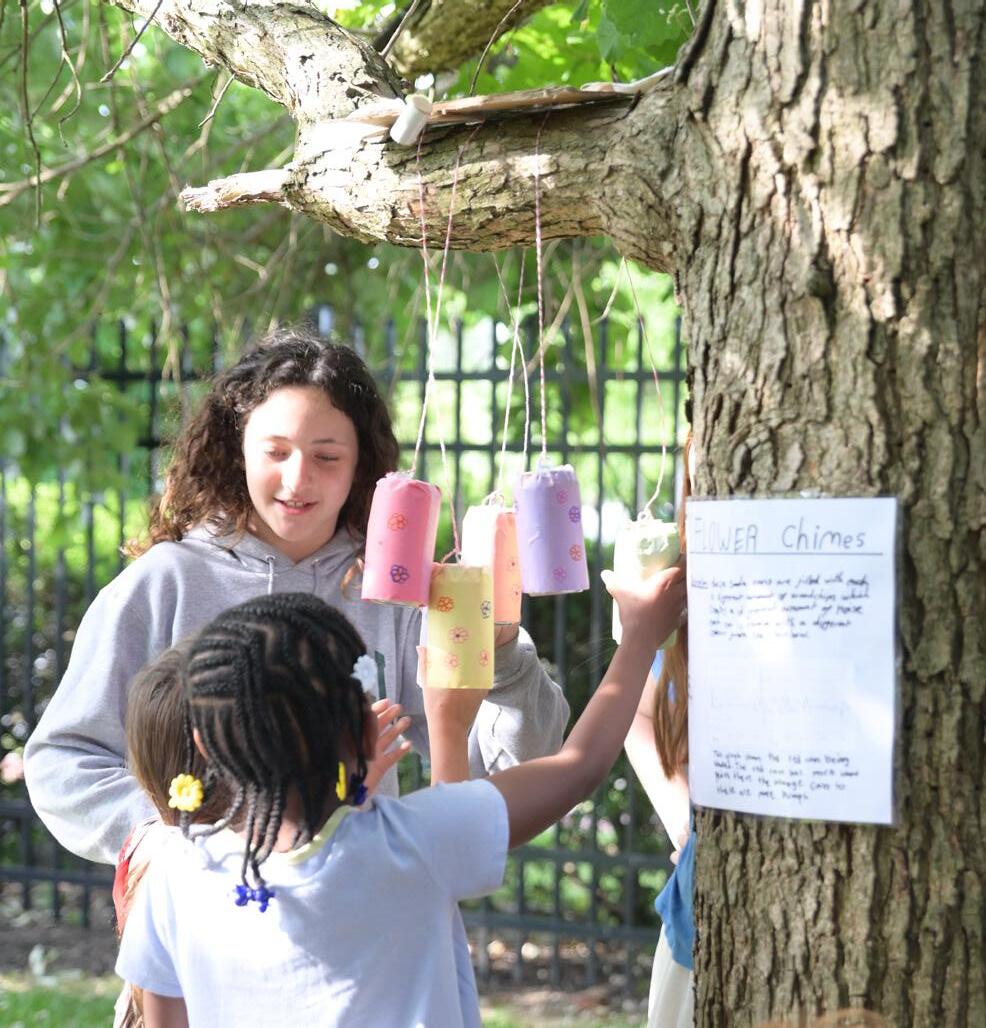
4TH GRADE ECONOMY
Fourth graders (James Elton pictured) bought and sold a variety of treats, items and services to fellow students and teachers using class “money” as part of an economics project to learn about financial responsibility. What a fun way to learn entrepreneurial skills and how things work in an economy!
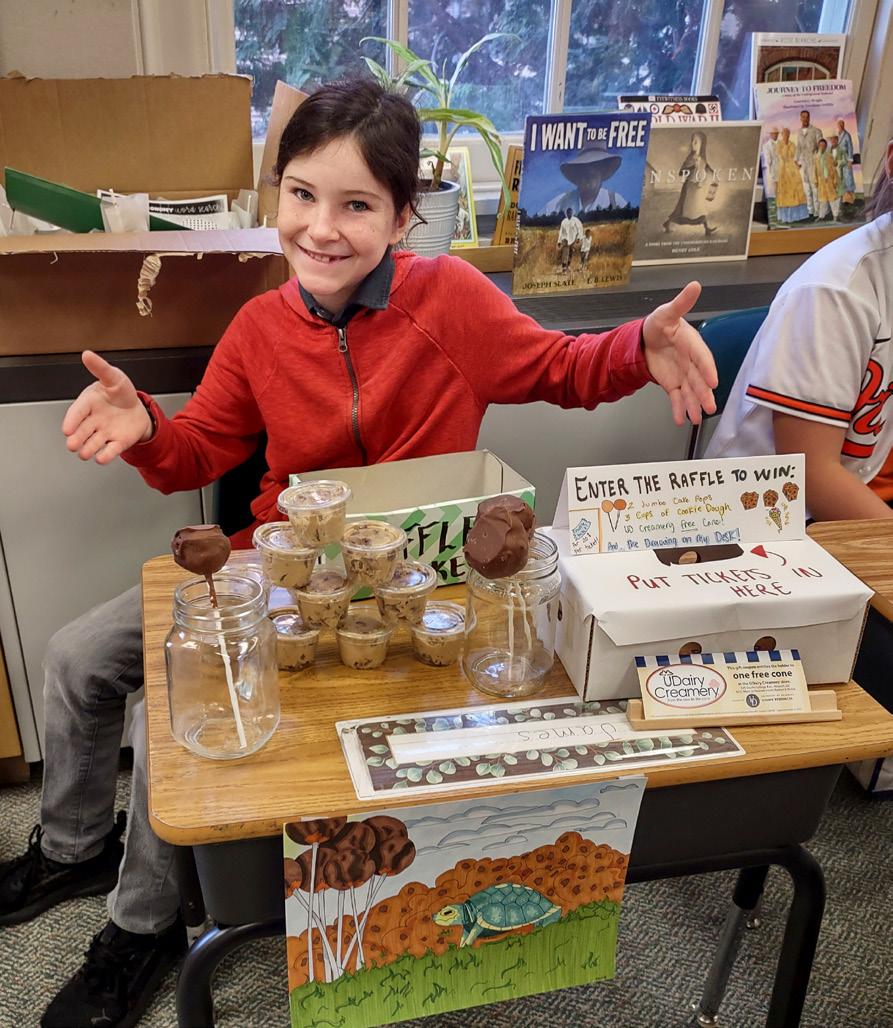
36 Tower Hill Bulletin Fall 2023
THE LAB THAT WENT WRONG
Advanced Physics II students (Ryan Beyer ’23 pictured) met with two sections of grade six science classes as part of their end of course projects. The students presented “The Lab that Went Wrong” to parallel the play they saw in NYC the previous month. The Advanced Physics II students had prepared demos that intentionally didn’t work quite right. It was up to the sixth graders to fix the problems and save the day.
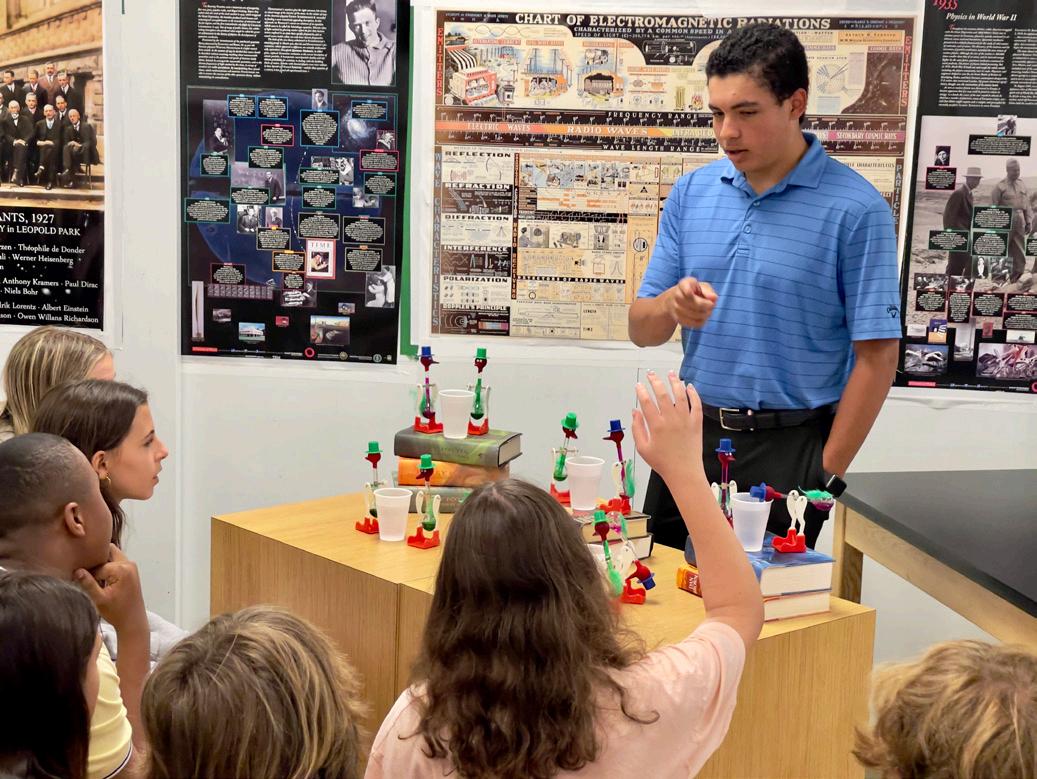
FRACTURED FAIRY TALES
Fifth graders performed their Fractured Fairy Tales, a unit during which students learn the elements of a fairy tale, “fracture” the tale by manipulating characters, setting or plot and then adapt the narrative to a script format.
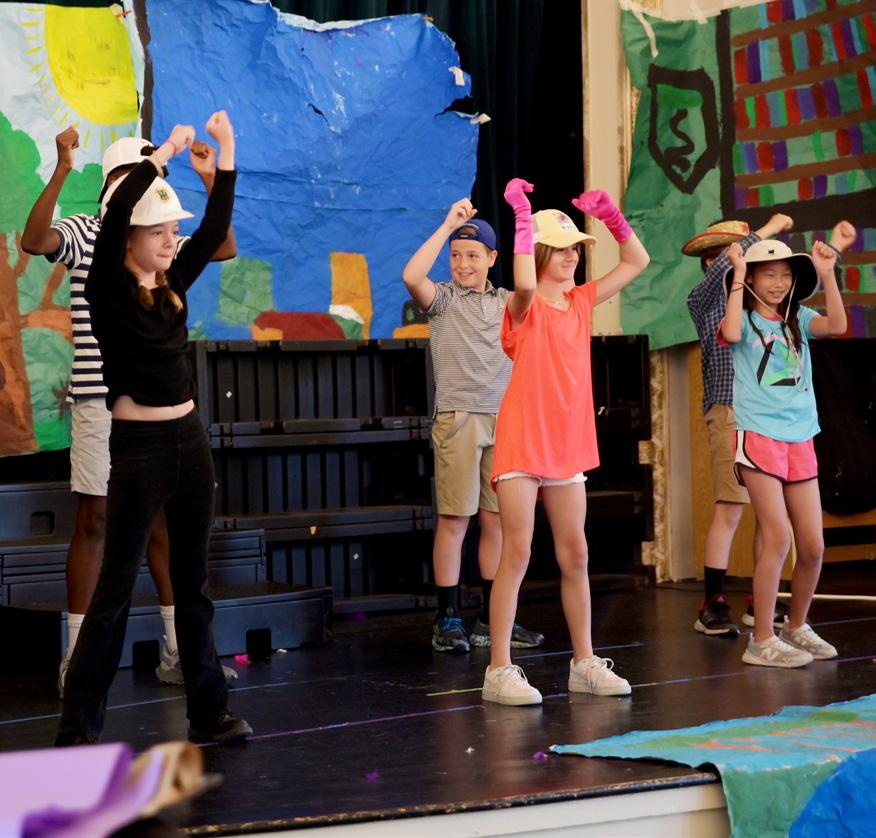
MATH HOOPS
All year long fifth and sixth graders competed in NBA Math Hoops, a fun and mathematical board game sponsored by the NBA (specifically the 76ers for THS). Every Wednesday morning, since January, students competed with other teams within their grade level. The “season” ended with the top two teams from each grade level advancing to a regional tournament that was held in Philadelphia in June. Two of our teams, 6th graders Zachary Deadwyler and Jack D’Emilio, 5th graders Rayaan Kazmi and Abby Stroud, advanced to the Final Four and had to compete against each other. Zach and Jack advanced to the Finals but lost in a close game. A fun and math filled evening was had by all participants! From left to right: Connor Boughner, Savir Damle, Emmett Lowry, Brian Cheng, Cameron Dalecki, Rayaan Kazmi, Jake Peterzell, Jack D’Emilio, Zachary Deadwyler, Abby Stroud.
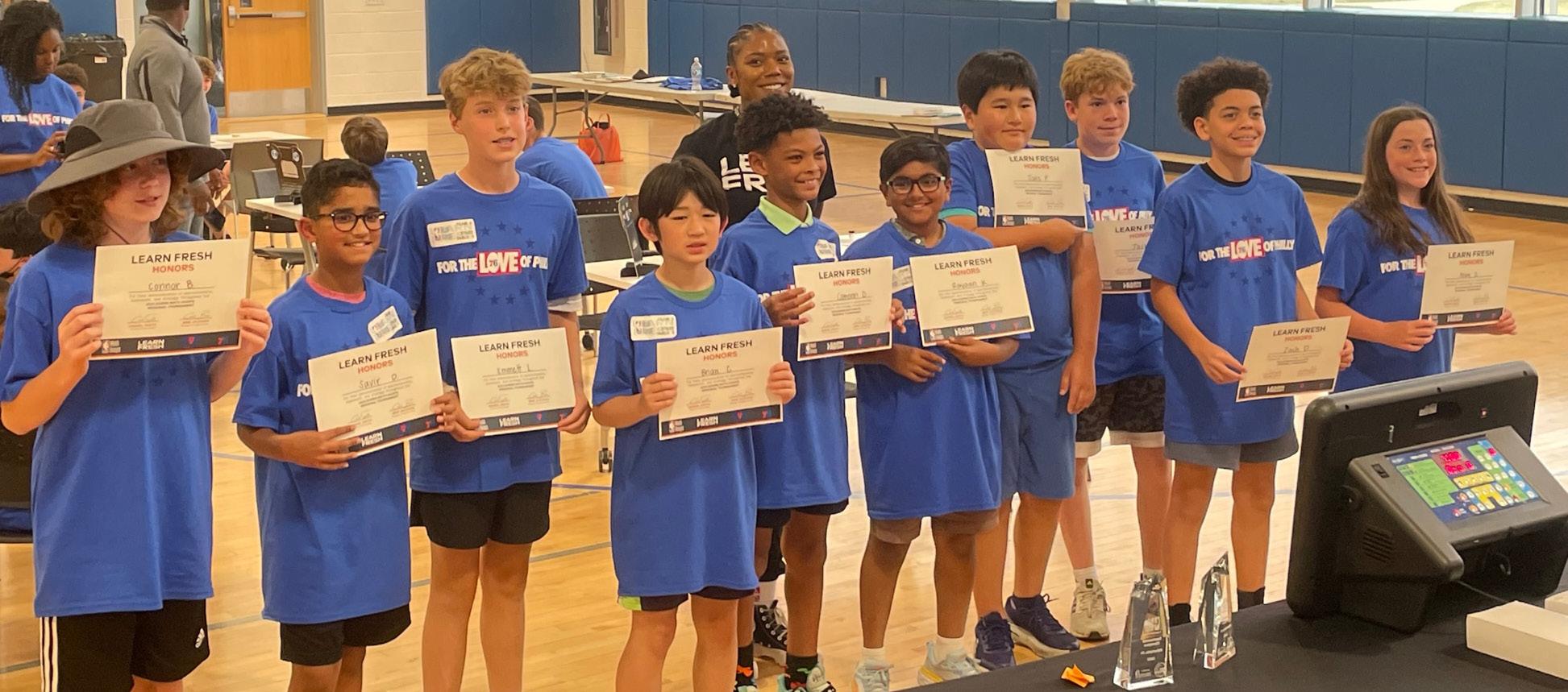
37 Tower Hill Bulletin Fall 2023
ACADEMICS
ENGLISH DEPARTMENT DEVELOPING
THOUGHTFUL, ANALYTICAL READERS AND COMMUNICATORS
BY MAURA C. CICCARELLI, FREELANCE WRITER
transformation of wide-eyed fifth graders who blossom into confident, self-assured sixth graders is impressive.”
From roots formed by developing reading and writing skills to branches that extend to advance students’ critical analysis, selfawareness and confidence in their own ideas and world views, Tower Hill’s English program is an everevolving art and science.
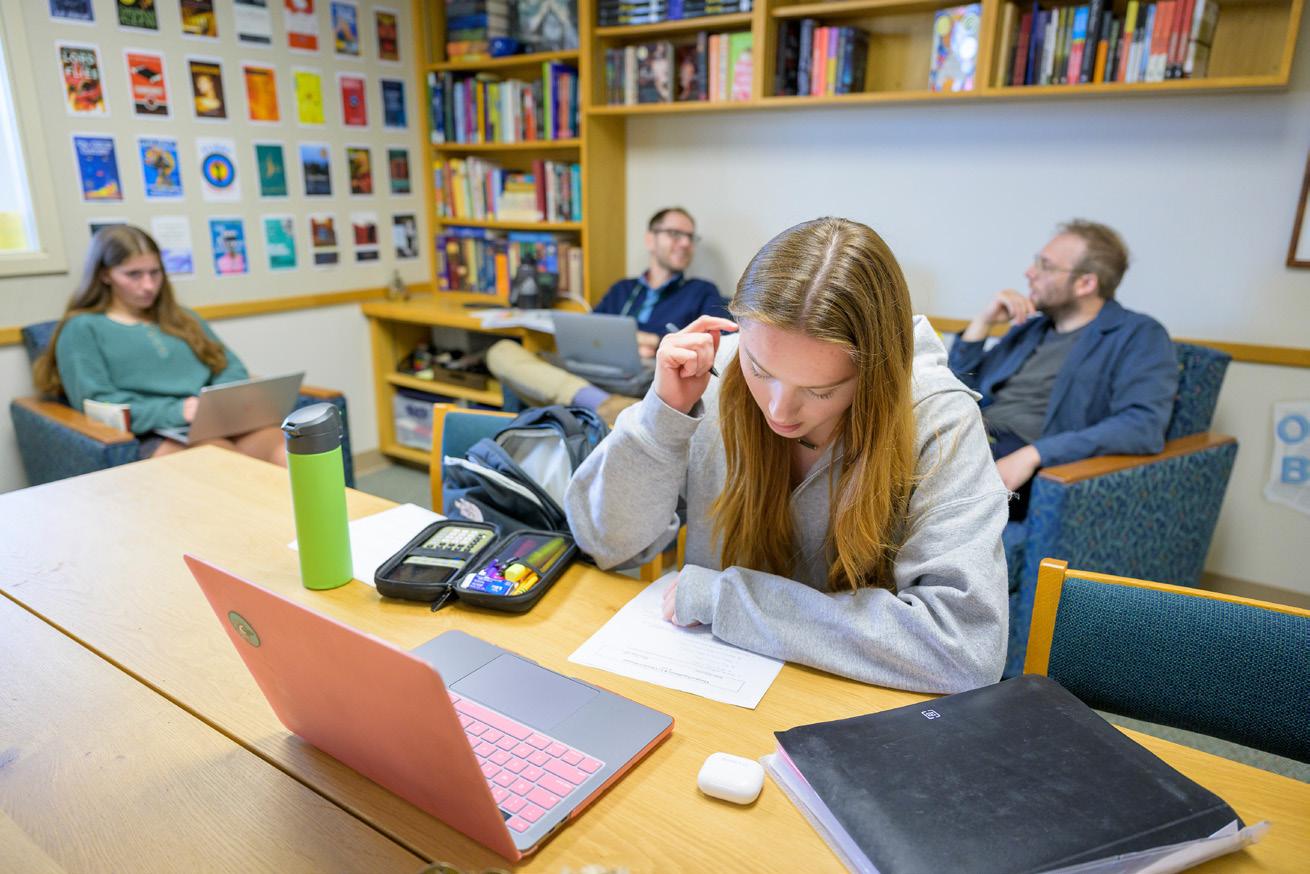
For the 10 teachers who cultivate their students’ learning from the fifth to 12th grade, they not only love their subject area wholly and completely, but they also love the sheer delight they get in watching their students develop incrementally through the years.
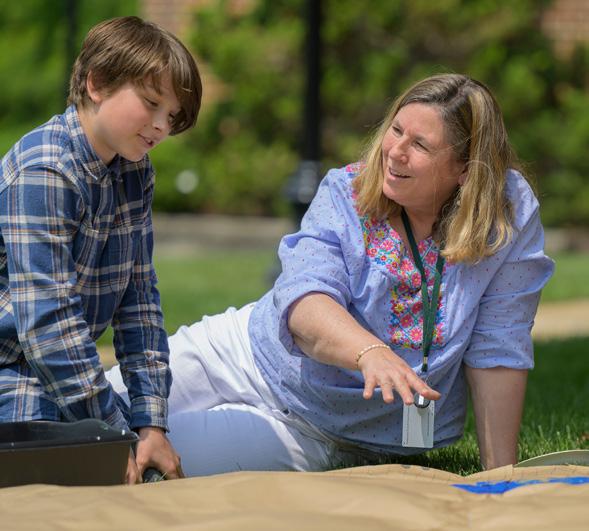
Department Chair Rachel Ashbrook, who teaches ninth grade (an age she says she “adores”), puts it this way: “There are these endless opportunities to find joy within the content and it always leaves teachers with a different understanding of their students, which is why I
think any teacher is in the classroom in the first place. I learn so much about [my students] by what they point to in the content and their interpretation. It ends up not only being a lens into the text but also a lens into the mind of a teenager as well, and that’s always a fascinating place to get a glimpse.”
Thirty-five-year Tower Hill educator Laurie Edinger, who teaches fifth and sixth grades, adds that teachers “tend the garden, ensuring our students are provided the nutrients to become critical readers and curious thinkers and develop their voices to articulate and express their ideas. We shower them with thoughtprovoking novels, short stories, articles and poetry. In English, we shine the light on models of good writing for students to analyze and emulate. And then we celebrate the fruits of their labor. Watching the
CURRICULUM PHILOSOPHY AND EVOLUTION
Ashbrook, who has taught English at Tower Hill for four of her 14 years as a teacher, says the English department roots itself in literary analysis, but not just to “march through” canonical texts.
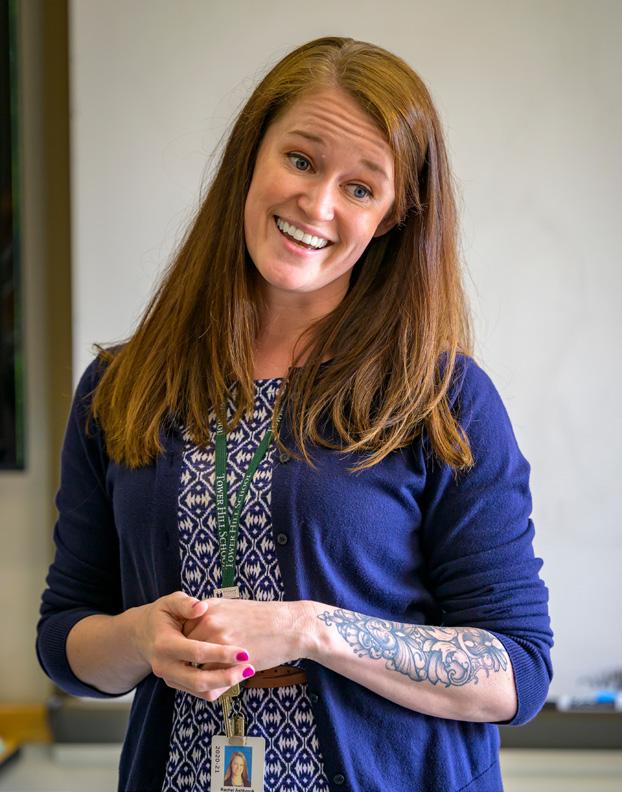
“We make sure we’re engaging students with experiences that allow them to feel empathy for others, to go into other worlds and look through the lenses that they would never have a chance to do otherwise,” she says. “The arc of our course catalog is centered on texts that allow students to ask difficult questions, especially of themselves, as we’re evolving into the future of our communities.”
To build on that analytic core focus, Ashbrook says the English staff regularly review content taught in each course and broaden the range of texts being used, as needed.
“This responds to both the student need for a diversified worldview as well as the critical thinking skills students will need in our current world,” she says.
“We’ve always had elements of this but we are now looking back through our courses to see the branches within our content area
38 Tower Hill Bulletin Fall 2023
and how we allow students to find places where they can thrive,” she explains. “Some of their critical thinking might be more of a nonfiction interpretation of events and telling a narrative tale, not only about what’s happening at school but also what’s happening in their imagination.”
The periodic full-scale curriculum review, which had been scheduled for the end of the 2020 school year during the pandemic, was put on hold so that English teachers could focus on their students, including helping them to process their emotions through text.
The latest review happened this summer, with teachers meeting in grade-level teams and then sharing with the whole department their successes as well as areas where they’ll adapt in the coming year.
Ashbrook says the process generates documents that track the evolution of the curriculum, giving the teachers “insights into how we’re creating really meaningful instruction” and has generated fruitful broader conversations about the scope and sequence of skills as well as what content is going to best get students there.”
“Teachers have brought a lot of imagination, creativity and their own professional knowledge of best practices to be able to ensure that we are addressing the students who are in front of us,” Ashbrook notes. “What independent schools do really well is meeting those individual needs.”
Middle School English teacher
Jennifer Houston, who has been at Tower Hill for 16 of her 20 years as a teacher, adds, “This is a department that has no problem saying, ‘let’s try it!’ as well as ‘well, that didn’t work.’ We are a flexible group who are constantly evolving to fit the needs of our students.”
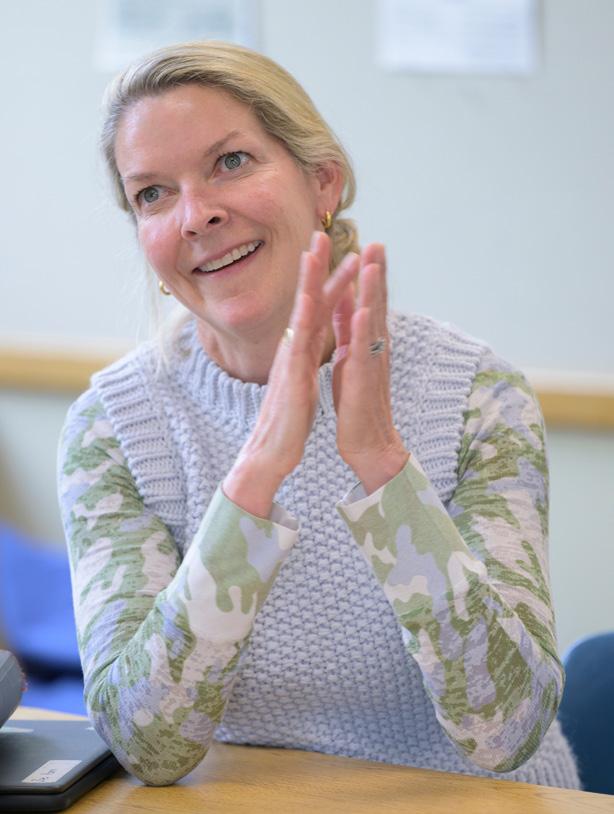
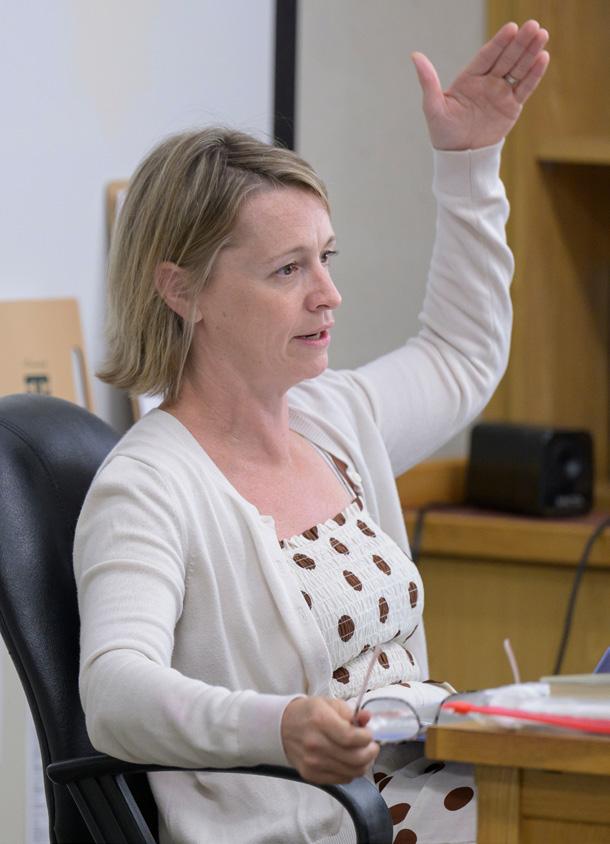
Edinger, who joined the Middle School English team 11 years ago, agrees.
“While the English department is constantly examining and
reexamining our curriculum, best pedagogical practices, and the thread that ties our program together, we never lose sight of what is really important: our students. How do we promote student agency, self-determination and growth to communicate effectively with others? What skills and tools do future students need to lead the way? How can our department help to best prepare them to take on the challenges of the world?”
to write a proper thank you note, email, speech, paragraph, etc. This skill takes great practice, like any other academic skill taught to young people. The nice thing is that you see marked improvement with writing and grammar. It is fun to have the students look at entries from September and then scroll down to the bottom of their English Google Doc to see how far they’ve come!”
While teaching grammar, spelling and vocabulary has changed very little, Zehner says she uses drills but adds more games and less straightforward rote memorization. And since there are kids who do not gravitate to reading to relax outside of school, she, like the other Middle School English teachers, dedicates a portion of class time each week for students to “get lost in great literature” so they can become “quality thinkers who are curious about the world.”
Houston, who teaches seventh and eighth grades, says that while English lessons today share a lot of similarities with those of decades ago, times have also changed.
“We’ve embraced technology as a teaching tool, which has enabled us to connect with the world more easily and effectively than ever before,” she says. “We can read a memoir about the Holocaust but then use the internet to virtually explore a concentration camp or listen to first-hand accounts of survivors.”
MIDDLE SCHOOL TRANSFORMATION
“Being able to spend my days diving into a great story with students is a gift,” says Jill Zehner, who teaches fifth and sixth grade English and reading classes and has been at Tower Hill for 13 of the 25 years she has been teaching. “I believe that everyone should know how
Edinger, who calls herself a “grandteacher” because she’s now teaching some children whose parents were in her classes years ago, says she has “the unique opportunity to watch her students grow from wee little tots to confident seniors walking across the stage at graduation. Empowering students to read, write and express themselves in a meaningful way is something to be cherished.”
Continued on page 40
39 Tower Hill Bulletin Fall 2023
ACADEMICS
UPPER SCHOOL: STUDENT AGENCY AND INDIVIDUALIZED LEARNING
Upper School English begins with ninth graders studying archetypes in different world literature and 10th graders focusing on American literature. In the 11th and 12th grades, students take two semesterlong electives each year, for a total of four courses. All 15 electives are college-level and focus on critical writing and analysis and eventually persuasion.
“We’ve long been preparing them to make those choices of topic or genre through their ninth and 10th grades, which is earlier than most people assume,” says Ashbrook, who teaches ninth grade as well as two electives: Journalism: Introduction to News Media and Communication and Rhetoric: The Art of Persuasion.
From crafting questions the class will study to inquiry-driven writing prompts to connecting to crosscurricular content such as from history, Upper School students “drive the way their literary analysis gets to something that’s more universally human,” Ashbrook says.
“English class allows students the freedom to say, ‘I can believe whatever I want to or hold whatever opinion if I can prove it and develop meaningful support for it.’ They can decide how to use evidence from a single text and explain how they back it up with historical context,” she adds.
“In my journalism course, students have to grapple with an analysis of a news source and think about how the language articulates a viewpoint or a bias,” Ashbrook explains. “They are employing close reading strategies and doing what they learned in ninth grade about meaningful fiction and the author’s purpose. All the lessons from when you read Fahrenheit 451 apply to reading a news article or engaging with an academic source. The English department is playing the long game.”
Michelle Wrambel, who teaches four electives, notes that “students are able to pursue subject matter
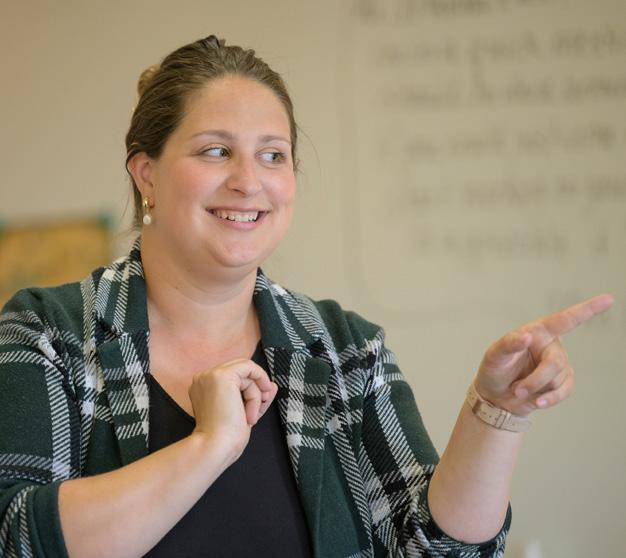
that they are invested in, taught by teachers who are deeply informed and passionate about the course. We work in concert with our ninth and 10th grade teachers to craft vertical teaming strategies that spiralize the curriculum, building on the skills that students have learned in the previous year and enhancing their level of difficulty. These courses prompt students to ask and answer their own questions through detailed inquiry.”
The seminar-style format of the Upper School electives uses a student-led, collaborative approach to discussions, problem-solving and learning in an open and encouraging atmosphere, known in the field as a Harkness discussion.
His key educational strategy for the 10th graders is to help students feel more comfortable in group discussions and make “room for students who aren’t disposed to eagerly jump into conversations.”
To that end, Huttner moves discussions from small to larger groups and incorporates free writing sessions so students have a chance to articulate their ideas within their own learning and personality styles.
“No matter what a student’s worldview is, we want them to be able to feel like they can have a voice in the classroom, and that they are not regurgitating a teacher’s interpretation of the text,” says Ashbrook. “They are finding their own voice and being able to champion that. Every student should feel that they can convey their interpretation and are not being guided in a particular direction. We are facilitating their discoveries.”
Noting that she’s had students discover something unique in centuries-old texts, like Shakespeare’s plays, she adds, “There’s a moment of wonder and realization that students get when they have a true conversation with the text and they’ve discovered a message that is truly original and surprising both to themselves and me. That is such a moment of magic and wonder in teaching.”
INSPIRING EACH OTHER
It’s an approach used all the time by Toby Huttner, who teaches 10th grade literature, along with two electives: poetry, pop music/culture and advanced critical writing that explores genre fiction.
“You have a higher level of responsibility for student learning and growth at this level,” says Huttner, who previously taught for seven years at Johns Hopkins University, in both the English Department and University Writing Program.
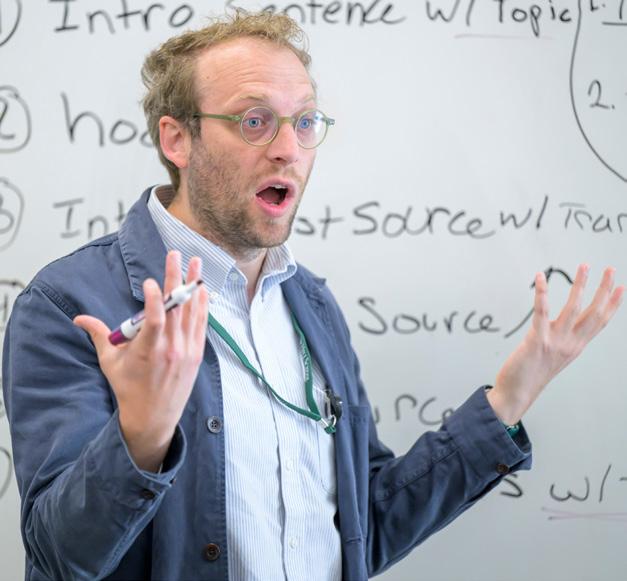
Each summer, many powerful professional learning experiences happen during the school’s opening week faculty seminars, where teachers lead classes on topics they’ve studied themselves. Last year, Ashbrook gave a presentation on Harvard Graduate School of Education’s Project Zero Thinking Routines, which use sets of questions to help students go deeper into the meaning of the course content.
“If you, as a teacher, can make the process of thinking and how ideas are developed not just like sprinkling magic dust, that really empowers students at every cognitive level,” Ashbrook says. “They realize they
40 Tower Hill Bulletin Fall 2023
have strategies to get to the subtext and really discover significant meaning. It’s a really empowering experience for students. I enjoyed sharing that with my colleagues.”
Wrambel shared what she learned in pursuing her master’s degree studies about teaching texts that center on difficult topics in a session called Using Trauma-Informed Practices in the Classroom.
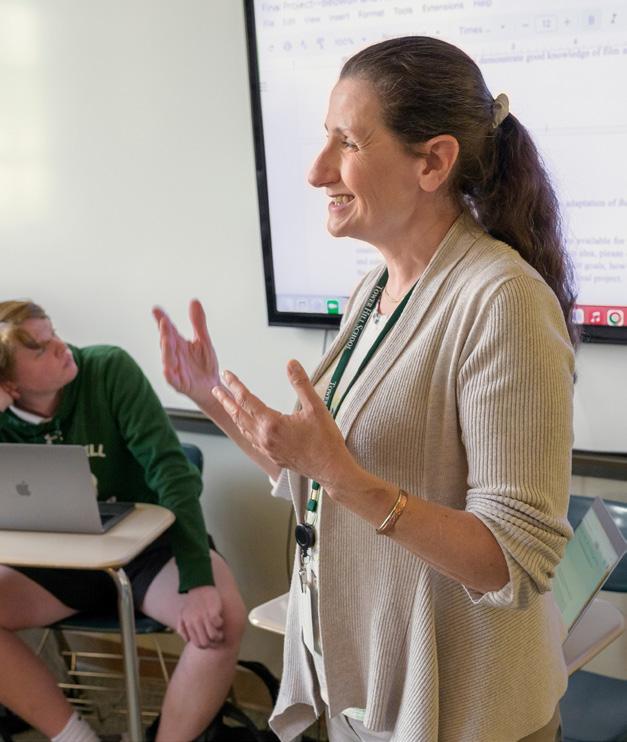
“I believe that there is an inextricable connection between literature and life,” says Wrambel, who has taught at Tower Hill for six of her 15 years as a teacher. “In my Trauma and (Re)Memory elective, students read literature with traumatic content, which may be triggering or upsetting. I’ve constructed the class, and my classroom itself, to be trauma-informed, but I also offer my students ‘therapy Fridays,’ where we engage with both top-down and bottom-up processing techniques used in trauma therapy, such as guided breathing, mindfulness, dance and yoga.”
One of her final projects, inspired the students’ reading of The Laramie Project, asked students to interview people about a significant event in their community.
“The content ranged from volleyball championships to mass shootings to illegal immigration,” Wrambel says. “These pieces ask students to showcase how the literature engages with the contemporary moment.”
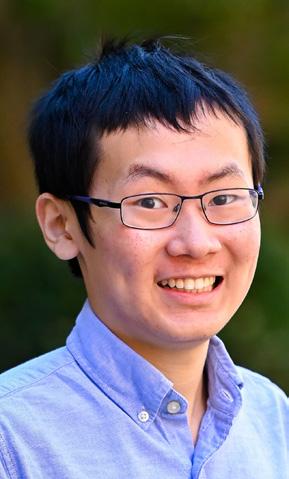
LIFELONG LEARNING AS THE ULTIMATE PURSUIT
Houston says she loves how the Middle School years are truly transformative for students.
“I feel like as teachers, we are constantly nurturing both the roots and branches of our students,” she says. “We need to recognize where they come from and use that to help them grow. I teach seventh and eighth graders yet the difference between a seventh grader in September and that same eighth grader in May can boggle the mind. I feel so lucky to be a part of this
time in a child’s life where they learn more about themselves and the kind of person they want to be.”
Coleen Hubler, who teaches 10th grade as well as electives and has been at the school for 26 years, adds that Tower Hill students themselves make the school an exciting place to teach because they are truly interested in learning.
WRITTING RECOGNITION
“You also have a chance to get to know lots of students over a long period of time,” she says. “You see them grow, change and develop interests. And, they always bring in new ideas.”
In her educational philosophy statement, Hubler wrote: “Literature tells us who we are as a people, what matters to us and what problems we need to address. It is the microscope through which we examine ourselves.”
She also says she hopes all her students realize that learning is, in Merlin’s speech from T.H. White’s The Once and Future King, “the only thing which the mind can never exhaust, never alienate, never be tortured by, never fear or distrust, and never dream of regretting.”
Hubler concludes, “For then they have discovered their own passion to take with them wherever they go, and all that remains for me to do is wish them a glorious journey.”
The strength of Tower Hill’s English department is evidenced by the number and level of awards and recognition our students receive. The English department has seen students find success with their application of skill outside the classroom year after year in the Scholastic Writing Competition, and this year with the creation of the Journalism course, in The New York Times contest.
Two notable examples were Claire Saunders ’23 who won the Scholastic Writing Awards, American Voices Award at the national level in both 2022 and 2023. This year’s winning piece was a short story titled Thyme and Time Again
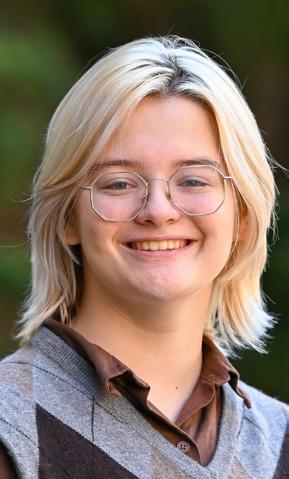
Gabe Huang ’23 was one of 11 winners of The New York Times Student Editorial Contest for his essay titled The Case for an A.I. Pause. This assignment was given by history teacher Dr. Andrew Brown as a culminating assignment for his spring semester course. To achieve the success he did, Gabe needed to utilize his research skills, developed in history, paired with the journalistic structuring and rhetorical techniques developed in his English courses.
No student is required to submit their work to these competitions, but teachers do present these competitions as opportunities for students to share their writing beyond the classroom and to, at times, a national audience. “It is the goal of the English department to help students find their authorial voice and entering these competitions can give students an additional sense of pride and validation that we want all of our student writers to own for themselves,” said English Department Chair Rachel Ashbrook.
41 Tower Hill Bulletin Fall 2023
ACADEMICS
TOWER TERM HIKING AND CANOEING
BY JACK ALLEN ’24
Although a large part of the school year is spent in a traditional classroom setting, Tower Term provides students with opportunities to pursue passions outside the classroom. My Tower Term selection, Hiking and Canoeing, was a multi-faceted outdoor adventure with different opportunities for students to explore the scenery surrounding Tower Hill.
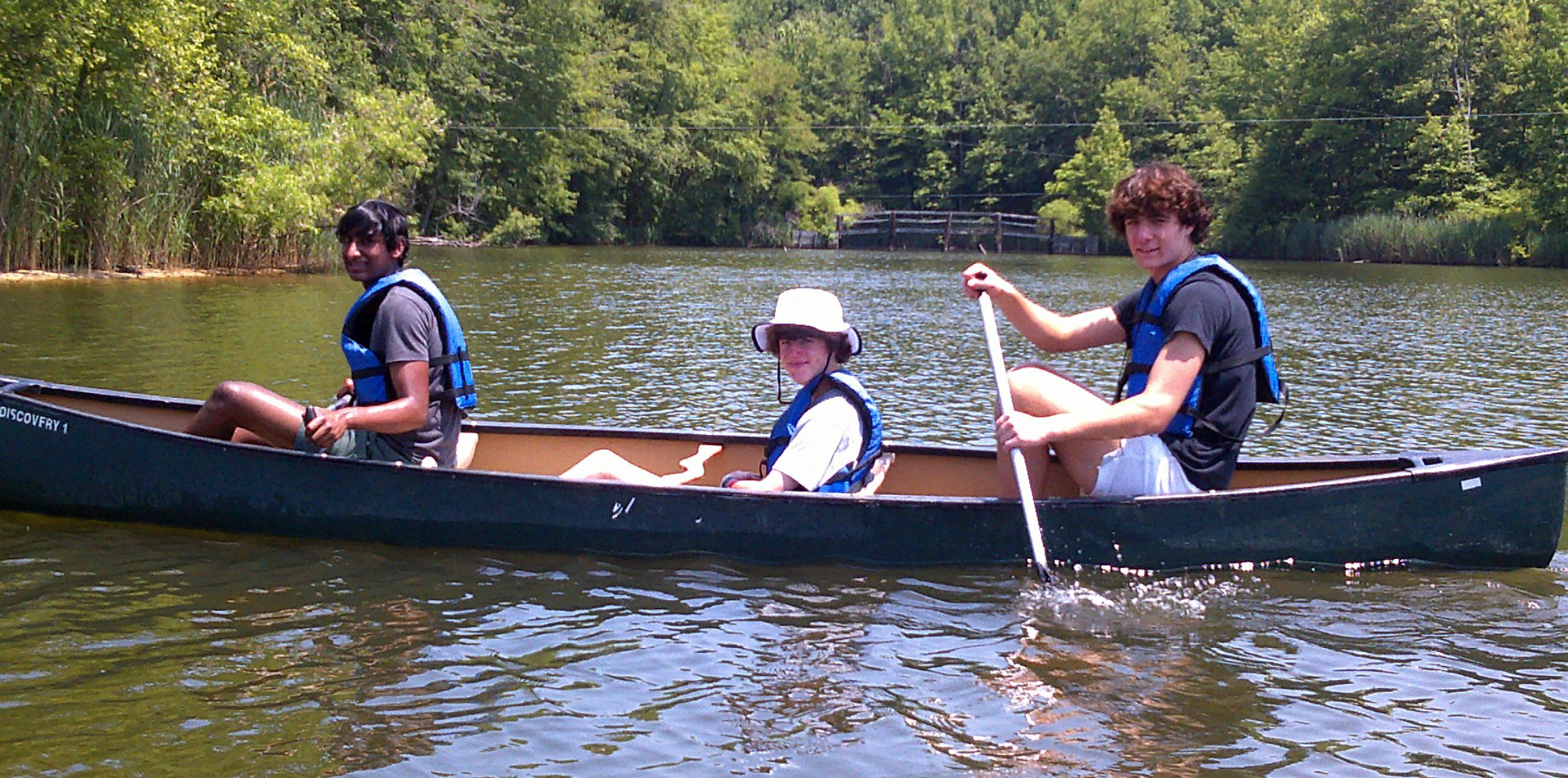
On the first day of Tower Term, students participated in hiking around Brandywine Creek State Park. As soon as the trail began and we entered the woods, we became absorbed with the beautiful forestry. Narrow walking paths and low hanging branches were the first things we noticed upon entering the trail. However, as we ventured further into the woods, we discovered the natural floral designs aside the trails. We designed theories about the best types of tree branches based on their durability and used experimental procedures to examine the question of the best branch.
After the experiments, the trail led us to a large lake that allowed us to witness more wonders of nature. We observed the life cycle of a frog due to the large
number of tadpoles, young and adult frogs that were present along the side of the lake. As we knelt down to examine the small amphibians, the frogs leaped into our hands, allowing us to closely see the delicacy of the animals. Then, we conducted further research around the lake by attempting to skip stones along the surface of the water the greatest number of times in one throw. We collaborated to try to discover the characteristics of the stone that would maximize the number of skips, as well as the optimal throwing technique. After leaving the lake and the frogs, we continued on our expedition through the woods and noticed more beautiful aspects of the park that we don’t get to observe throughout most of the school year, highlighting the benefits of the Tower Term experience.

42 Tower Hill Bulletin Fall 2023
The group shifted gears for day two, spending the day canoeing along the Brandywine Creek. We arrived at Northbrook Canoe Company in West Chester, Pennsylvania to embark on our aquatic expedition. After being driven up the river to the departure location, the staff at Northbrook prepared us for the day with a brief safety orientation that covered basic paddling skills as well as tactics to avoid obstructions along the river. As soon as the canoes set out on the river, the competition began. Canoes filled with groups of two and three paddled fearlessly, guiding away from shallow waters and the coast. Canoes that drifted with the current occasionally flipped (sometimes with the help of classmates).
After paddling down the river, we encountered the monstrous waterfall. In hindsight, the six foot tall waterfall was not as terrifying as it felt while paddling furiously toward it. While many groups got out of their canoes and carried them around the obstacle, a few adventurous groups bravely continued through the waterfall, using various techniques to navigate it. Our group chose to paddle as fast as possible through the fall and after getting stuck on rocks, we hopped out and pushed the canoe the remainder of the way. After picking up a friend from a different canoe and attempting the challenge of carrying four people on our canoe, we quickly discovered that adding people reduced the speed of the canoe, causing struggles through rough terrain and many canoe flips. After one such flip under a bridge where the water was especially deep, our canoe members swam and pulled our canoe to the shore. After standing on the mucky shore, we noticed the peacefulness of the scenery and the smooth ripples in the river. Additionally, Mr. Neilson identified a snapping turtle on the coast, which expedited our return to the canoe and the
speed with which we traveled from the area. We continued our paddling until we eventually returned back to the Northbrook Canoe Company, where we celebrated our victorious journey with a hot dog and burger cookout.
Our hiking expedition continued on the third day when we set out on the Alapocas Woods trails. During the hike we observed various types of trees, flowers and bugs that were dispersed around the path. The trail took the group over hills and steep terrain and fortunately there were no casualties. A highlight of the trip was arriving at a steep rocky cliff which several of the members of the group daringly climbed. Although the rocks were slippy, everyone who attempted the climb successfully scaled the rocks, and we posed for a triumphant picture. While returning to the beginning of the trail, we played games and strolled through the soft greenery.
Our Tower Term journey culminated with a final day of lawn games on Tower Hill’s Nitsche Pitch. Wiffle ball, soccer and cornhole were among the many games in which students challenged each other and teachers. The highlights of the day were Mr. Pratt hitting a home run in wiffle ball, which kept my team competitive in the game, and Mr. Rapp going undefeated in cornhole despite many challenges from students. Everyone had fun throughout the lawn games and the entirety of the Tower Term adventure.
Hiking and Canoeing provided students with a fun and conventional outdoor adventure for the last days of the school year. This Tower Term experience provided me with my first canoe trip, my first time hiking in the Alapaocas woods and Brandywine Creek State Park, as well as many other memories.

43 Tower Hill Bulletin Fall 2023 ACADEMICS
BY AILI INGUITO ’24
As it has become more convenient in our everyday lives to take out food, order food or go out to eat, it has taken more of an effort to cook at home. Cooking provides many benefits because it is an activity that can be fun, creative and accessible to everyone. In my Tower Term course, Top Chef Tower Hill: Restaurant Wars!, we refined our cooking skills, explored the restaurant industry and we competed in two teams to create the best restaurant.
I was interested in this Tower Term course because I wanted to take my cooking skills to the next level. Many of my peers in the course shared this same sentiment of wanting to learn how to cook, and a lot of us have watched YouTube videos and television shows about cooking. Our teachers, Ms. Baker, Mrs. Jordan and Ms. Wrambel, each shared with us their love of cooking, their personal experiences in the kitchen and their cookbooks with triedand-true recipes that we could use
as inspiration for the competition. They noted that cooking failures are important to learn from, which I think is a good approach that applies not only in the kitchen but in other areas of my life.
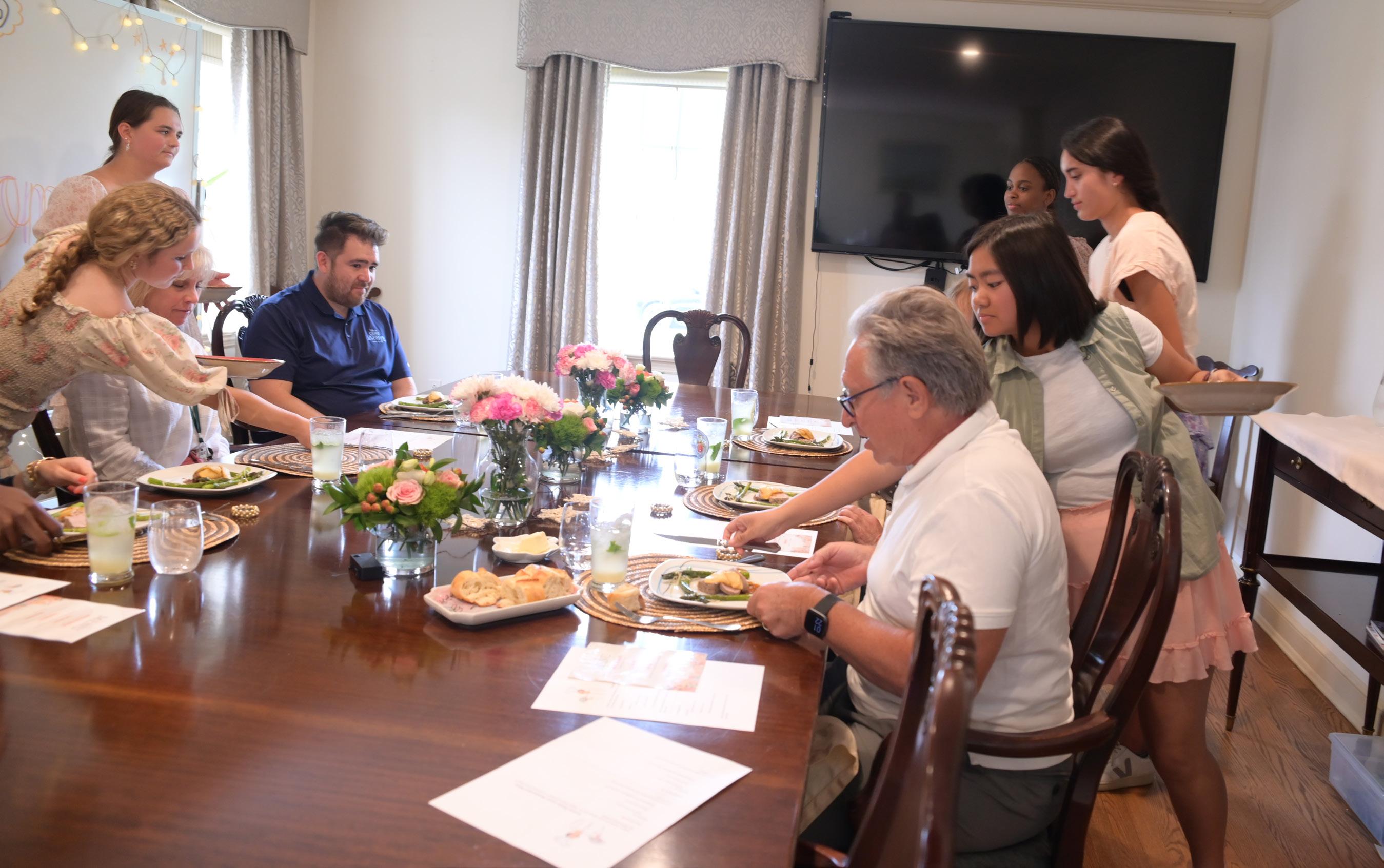
Thursday, June 1: On the first day, we were introduced to the idea of a cohesive concept restaurant, which is how the restaurant defines itself. Not only does this involve the type of cuisine served, but it also includes the menu design, service style and overall atmosphere. Since the course was based on the popular TV culinary reality show, we watched an episode from Season 14: Charleston to better grasp the final competition—creating our very own restaurants. In the show, we analyzed the different team dynamics of both groups of chefs and took notes on the various roles in a restaurant. We discussed how a positive leader can have a substantial impact on the team’s overall attitude and group interactions. We learned that the
roles include the Executive Chef, who serves as the food decision maker and the main leader to guide the team; the Line Cooks, who are each responsible for one to two dishes and report to the Executive Chef; and the Front of House Manager, who is primarily in charge of hospitality with their team of servers. With the context of the TV show in mind, we all developed a clear vision of the task that lay ahead of us and the journey that we were embarking on to get there.
During the rest of the morning, we split up into our two teams and attempted the Human Knot. This team-building activity served as a way to build clear communication. This tough group exercise also served as a precursor to how we would approach working together in the kitchen, because we now realized the effectiveness of strong communication. Afterward, we debriefed on the takeaways, discussed our initial ideas of the
44 Tower Hill Bulletin Fall 2023
food that we wanted to make and brainstormed questions to ask professionals in the restaurant industry.
Later that afternoon, we met Chef Peter Fontaine, who has been the Executive Chef at Greenville Country Club for 28 years. After a delicious lunch, he demonstrated different cutting techniques, gave us a tour of the kitchen and talked about his experiences on the job. We asked him about what a day in his life would look like and how he chooses the menu, to which he responded that it depends on whether the ingredients are readily available and in season. He emphasized how teamwork between all members of the kitchen, no matter their position of leadership, is crucial to the efficiency and success of the whole; for example, he mentioned that each morning at the start of the workday, he greets every staff member, from cook to dishwasher, because it helps to create a sense of trust, community and a more connected work environment. Hearing from an actual chef who has been doing this kind of work for decades, was an eye-opening experience.
Friday, June 2: On the second day, we attempted a blind taste test. Based on the taste and texture of the food, we were tasked to guess the mystery ingredients from two different samples. Although I was not very skilled at determining all the ingredients, I identified at least one item from each sample. For our snack, we learned how to make guacamole—our teachers demonstrated how to properly cut and slice avocados, onions, garlic, limes, tomatoes, jalapeno peppers and cilantro. After the demo lesson and washing our hands, each team made the dip, dividing the tasks between each person. After the work of cooking and the reward of eating, we toured the Business Office kitchen to see the place where we would have our restaurant, and we watched another episode of the TV show to gather more ideas, before departing for the weekend.
Monday, June 5: On the third day, we boarded the train for Philadelphia to explore the dining around Rittenhouse Square, with a list of well-themed concept restaurants, recommended by our teachers. We split up into small groups to walk around the area and collect information on the unique styles of different restaurants. My squad ate lunch at a restaurant called The Continental Midtown, which had a diner-esque interior design, an aesthetic ambiance and interesting menu combinations, such as their savory French onion soup dumplings. Using the information and inspiration we learned that day and throughout the Tower Term, we reconvened into our two big teams to decide the final plans for our restaurants.
Tuesday, June 6: On the fourth day, we had our big competition. We met at the Business Office kitchen in the morning, and we each brought in items from home— decor, plates, silverware and kitchen tools. The morning was prep time to take inventory, figure out last-minute plans and arrange the place settings while two members from each team went out grocery shopping with a max budget of $300. Once they arrived with the food, it was time to get into action in the kitchen.
As part of the Blossom restaurant, we aimed for a spring and summer vibe, so our menu consisted of items all incorporating fruit into their recipes. We served an agave mint lemonade as our specialty drink, strawberry salad with balsamic vinaigrette as our appetizer, pork tenderloin with apples and oven-roasted asparagus as our main course, and mango sorbet and pear custard pie as our dessert.
The grading criteria included the quality of service, food, presentation, ambiance and overall cohesiveness of concept. Amongst the panel of six judges, we invited renowned French pastry chef Patrick Gauthron, who founded Aux Petits Delices, a bakery in
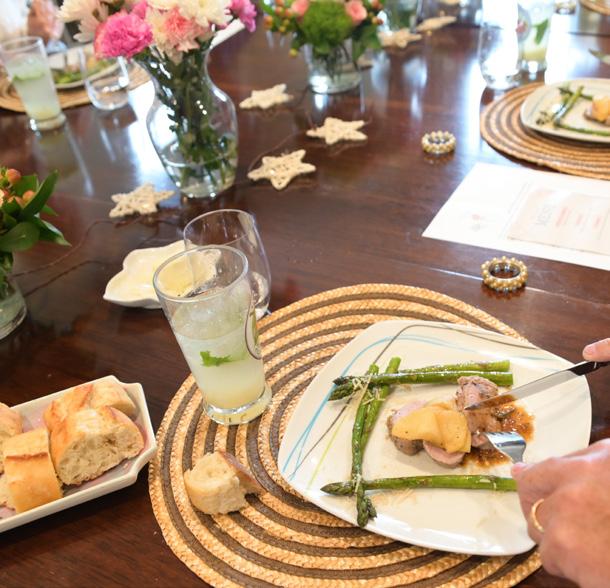

Wayne, Pa. We were allotted about thirty minutes to serve our food. Although at some moments it was stressful making sure each dish was ready in time, our team felt proud and relieved when we got the job done.
The competing team named their restaurant Evergreen and served a Christmas-themed holiday menu after us, and they ended up winning after both teams were given valuable criticism and compliments by the judges (who thought that my asparagus dish was perfectly cooked). Even though Blossom lost, I still felt like I learned many valuable lessons through this experience.
In line with the purpose to cook, eat and compete, this course helped me to better enjoy dining culture and to appreciate how restaurants curate their food. Furthermore, I learned that many culinary terms were derived from the French language— for example, a specific type of slicing vegetables into thin strips is known as julienne cutting or mise en place, which directly translates to “putting in place,” refers to the prep that goes before cooking, when all ingredients are chopped and ready to go, so I even found connections between Tower Term and academic classes like French. I liked how this course culminated in a fun, self-directed competition with so much freedom to create our own restaurants because it felt like a final project. So, while it might be easier or more tempting to go to a local drive-through, I challenge you to try cooking—or maybe even have your own Top Chef competition.
45 Tower Hill Bulletin Fall 2023 ACADEMICS
THE PERRY INITIATIVE
BY AMY SCHREI, DIRECTOR OF COMMUNICATIONS AND MARKETING
The Perry Initiative is a non-profit organization that is dedicated to addressing the gender gap in male-dominated fields and providing young women with opportunities to explore and pursue careers in engineering and medicine. In fall 2022, a group of 12 Tower Hill young women attended the Perry Outreach Program at the University of Delaware. The program is a one-day career exploration for young women in high school who are interested in careers in orthopaedic surgery, engineering or both. Participants completed six hands-on mock surgeries and learned directly from local medical professionals and engineers.
The Perry Initiative was introduced to the school by Emerson McCauley ’17 who earned an engineering degree from UD and presented to THS students at the girls STEM summit a few years ago. She said: “It’s great for the high school students to get to work alongside women who are a little further in life and their educational careers than them but still close in age. It’s also wonderful for the college students who hopefully benefit from seeing younger students excited to learn about the fields. I did The Perry Initiative in the fall of my senior year at Tower Hill and ended up going to University of Delaware to major in mechanical engineering, with minors in math, civil engineering, biomechanical engineering and integrated design.”
Bryce Twyman ’25 said, “I joined the program because I am very interested in pursuing the medical field after school. The Perry Initiative introduced me
to parts of the field that I wasn’t aware of, including the importance of biomechanical engineering. The hands on experiences like suture practice and splint placement gave me an opportunity to truly see what being a part of the surgical aspect of the medical field is like. It was definitely great to have an opportunity to be surrounded by smart and powerful women to look up to.”
Alex Rice ’25 described her experience: “Living in a world that typically grants males more opportunities, I will forever be grateful for The Perry Initiative program, because it offered me and other girls the chance to explore the engineering and medical field in a positive, motivating and curiosity-seeking environment. During the one-day workshop, I was mentored by many successful women working in STEM and was not only taught how to suture a pig’s foot and make an arm cast, but more importantly, the reasons why I should reach beyond my comfort zone, fight gender limitations and lead and encourage other girls along the way. Ever since I partook in this program, I have been more inspired than ever and am so fortunate to have heard from the powerful women I did. With this, I led the Culinary Chemistry Club at Tower Hill my freshman and sophomore year, because I am hoping to get more of my classmates excited about the sciences and involved in more activities that spark their interest.”
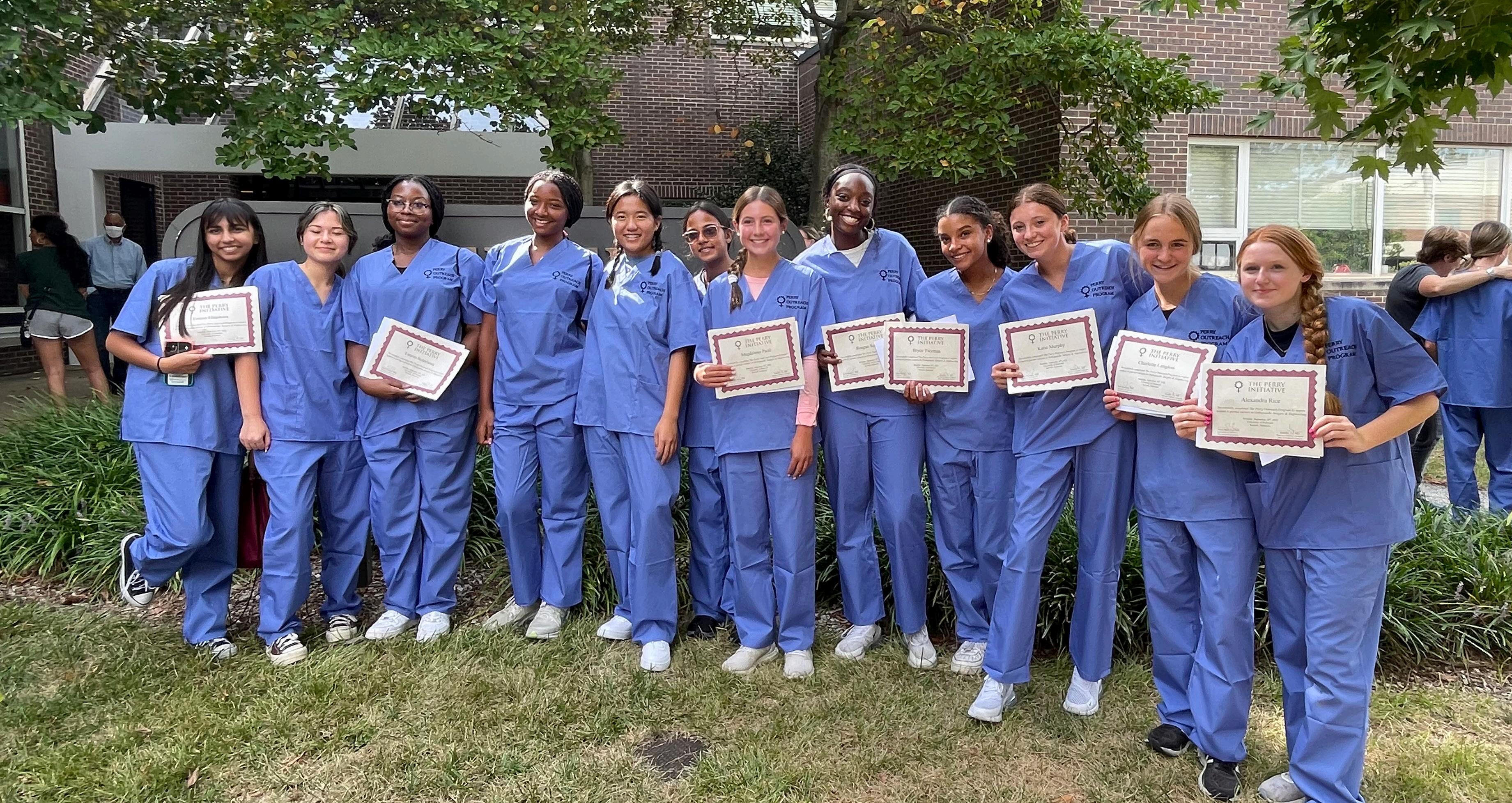
46 Tower Hill Bulletin Fall 2023
(L-R): Emaan Ehtasham, Nicole Neal, Lauren Bolarwina, Makayla Warthen, Cathy Li, Nidhi Gowda, Magda Paoli, Reagan Squire, Bryce Twymann, Katie Murphy, Charlotte Langlois, Alex Rice
SYMPOSIUM
 BY NATASHA MURRAY-EVERETT, DIRECTOR OF SOCIAL JUSTICE
BY NATASHA MURRAY-EVERETT, DIRECTOR OF SOCIAL JUSTICE
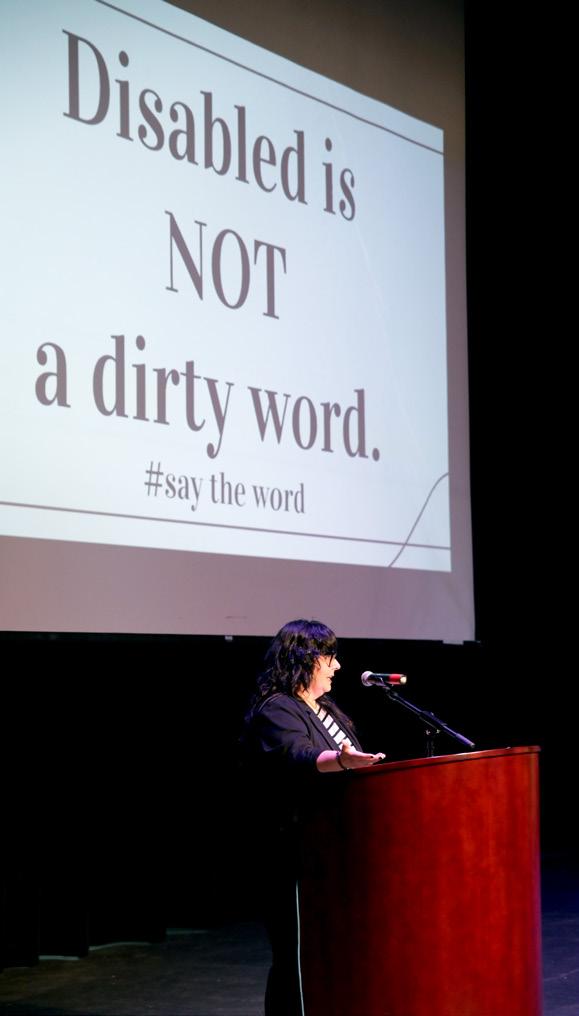
Each spring The Upper School Social Justice Symposium brings together our students and faculty for a day of workshops and discussions that allow a deep dive into a particular theme or topic related to advancing our understanding of diversity, equity and inclusion. The 2023 Symposium focused on a topic often overlooked—abilities and disabilities. More specifically, the Symposium highlighted how ability is a form of privilege. Students and faculty alike learned about both cognitive and physical disabilities how they impact one’s access.
This year’s Symposium began with a keynote speaker, Stella Mask, a long time educator with a background in special accessible education. She herself is both autistic and disabled and shared her disabilities with authenticity, candor and humor. She provided students with legislative information about accessibility. Other topics included how the disabled are portrayed in the media and society at large. She highlighted for students things they could do to be more mindful and supportive of the disabled community, including ableist language to stay away from, ways to take action and how to be advocates and allies for the disabled community. Stella’s opening keynote was well received and impactful for many. A testament to this was the words shared by a student immediately following her presentation: “I felt like you were telling my story up here. I felt seen and just wanted to say thank you.”
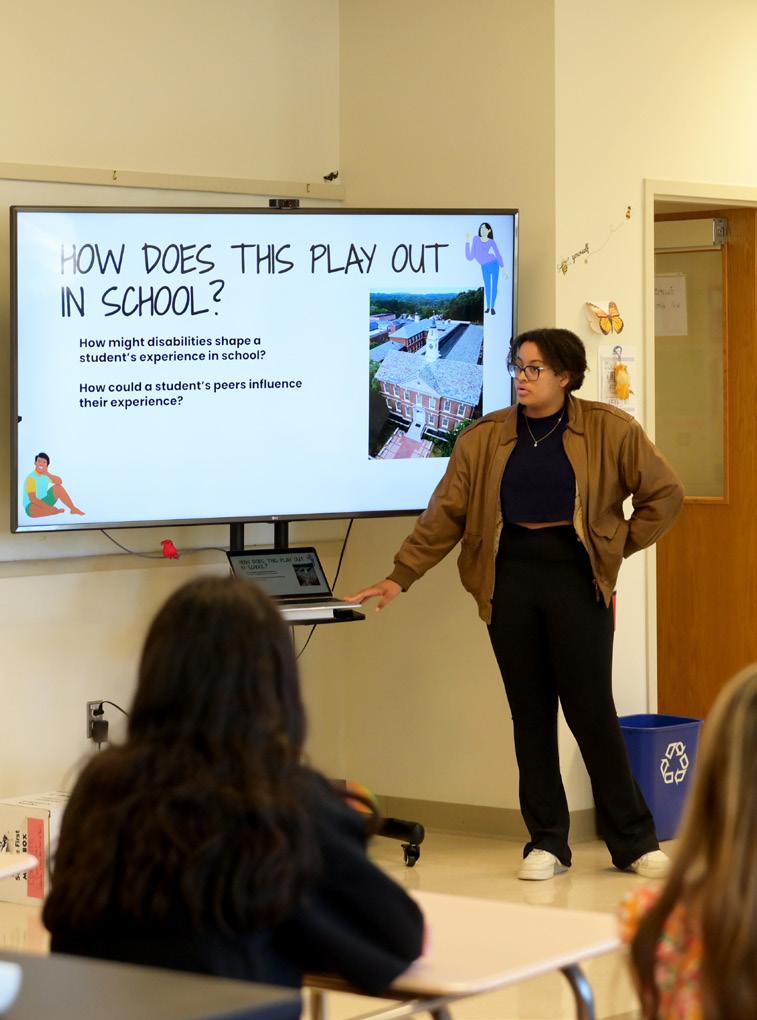
“I felt like you were telling my story up here. I felt seen and just wanted to say thank you.”
Symposium day also included morning and afternoon breakout sessions that were co-facilitated by students and faculty this year. Student and faculty facilitators engaged students in broad activities and discussions about privilege as well as specific discussions focused on disabilities. Students were led on a walking tour of Tower Hill where they were provided with scenarios and encouraged to think about accessibility for those with both physical and cognitive disabilities. Back in small group discussions, they engaged in action planning and thought about ways to better enhance the accessibility of Tower Hill.
Faculty and students alike shared how Symposium opened their eyes to privilege in a way that is not traditionally discussed but that takes into account who has access in society and who does not. Sessions were well received and found to be not only interactive and inclusive but on a topic that needs more discussion in our community and society at large.
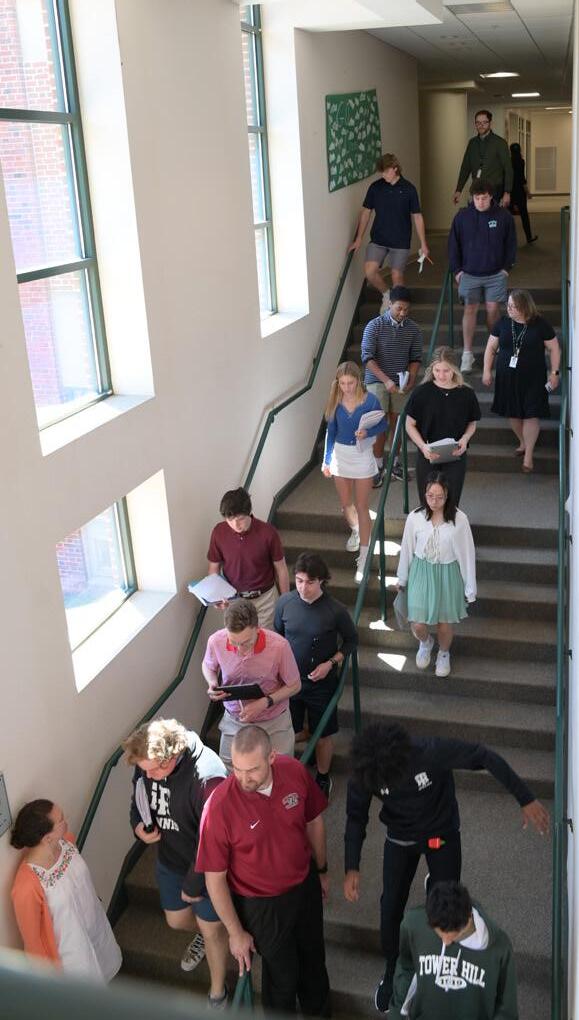
47 Tower Hill Bulletin Fall 2023 ACADEMICS
FACULTY FOCUS
DR. KELLY HUNTER: A LIFELONG PASSION FOR STUDENT LEARNING AND LITERACY
BY MAURA CICCARELLI, FREELANCE WRITER
Over her more than 30-year career helping children, teens and adults overcome challenges with reading, writing, learning and critical thinking, Dr. Kelly Hunter has always looked for the intervention points where support can be most meaningful.
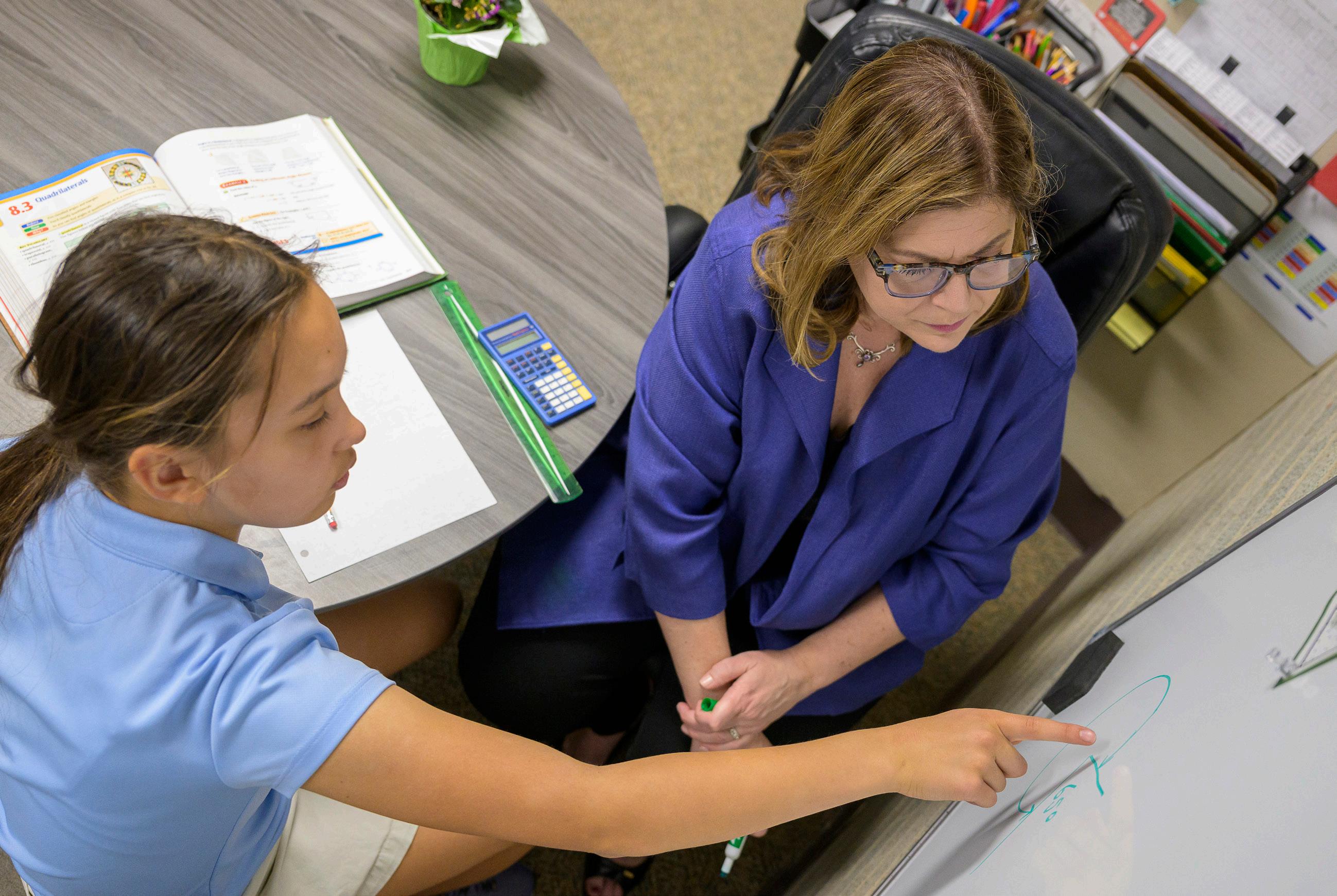
Dr. Hunter began her teaching career in Orleans, France where she taught English as a Foreign Language (EFL). After returning to the U.S., she taught reading, writing and literacy to students of all ages from early childhood to adults.
“After I returned to the U.S., I realized that without that foundation of literacy, which cuts across everything, it makes it difficult to access math, impacts learning science and history,
and so forth,” says Dr. Hunter, who joined the Teaching and Learning Center (TLC) at Tower Hill in 2020. “That literacy component was at the center of accessing education.”
Dr. Hunter has strong ties with the University of Pennsylvania, where she received her Doctorate of Education in Reading/Writing/Literacy, her Master’s degree and Reading Specialist Certification. While at Penn, she coached and taught teachers and school leaders nationally and internationally.
In addition to her vast teaching experience, she’s led a number of literacy, educational and advocacy programs for the University of Pennsylvania. She served as Executive
Director of the Children’s Literacy Initiative, which improved students’ literacy rates in school districts across the country, including Philadelphia, New York City, Chicago, and Newark, N.J. Dr. Hunter has also taught at several public and private schools in the area, such as The College School at the University of Delaware, and was the Director of Early Learning for the Delaware Department of Education. Prior to joining Tower Hill, where her daughter, Maya, was already a student, she was Director of Learning Services for The Tatnall School.
TLC’S VISION
This fall, Dr. Hunter became Director of the TLC and Chair of Learning Support, the in-school learning
48 Tower Hill Bulletin Fall 2023
support resource for students throughout their time at Tower Hill.
Dr. Hunter’s vision for the TLC is to serve as a “GPS” for student support, meaning the TLC will help students navigate their network of support and learn how to access help from a variety of resources. Being able to connect with and ask for assistance is a skill that benefits students into college and beyond.
“We should not be trying to educate children today for the jobs of the future,” says Dr. Hunter. “Instead, we should be trying to teach them how to learn and how to be critical thinkers, so they are prepared for life and able to excel in any career, even those we have not yet foreseen.” While it’s important to learn all the academic subjects, that becomes just the baseline.
“If you don’t learn how to learn, you’re not going to be able to grasp that future job, even those we cannot yet imagine,” she explains. “Those are the lifelong skills that we’re helping with in the TLC.”
Students come to the TLC to learn how to improve academically in a particular content area as well as to learn how to take notes, study for and take tests, how to ask critical questions and to think and infer in a deeper way. “We’re also teaching them how to use their network. We’ll help them learn how to go to their teachers, to talk to their dean and their advisor, to work with their peer tutors, school psychologists and more,” she says.
The TLC team comprises five learning specialists: two in the Lower School, one solely for the Middle School and two others who will overlap the Middle and Upper School. This is an evolutionary change in structure to allow for more flexibility and to provide consistent and familiar support for students as they move from Middle to Upper School. Dr. Hunter herself will continue working with some of her Middle School students, along
with a new set of Upper School students.
TLC’s goal, Dr. Hunter says, is to help students build their academic, learning and networking skills toward independence in Tower Hill and beyond.
Another goal is to train teachers to integrate student support into their own teaching practice.
“For example, when I talk about study strategies, I see teachers making changes and incorporating those things into the materials they already use,” she says. “It’s no longer an isolated thing that just happens over in the TLC. Our work is all integrated. I’ll do a presentation for students about how to get ready for their finals, and then the teachers make sure they have wonderful study guides so that students can chunk up their work. That’s the collaboration for creating good practices.”
“The students have such a passion for learning,” she says. “Their engagement in the learning process, their questions and their thoughtfulness about the world around them is really exciting. The level of excellence of the faculty and their openness to keep learning and doing more, such as being available when students need them, is tremendous. They have a real willingness and passion for the work.”
For Dr. Hunter, asking deeper questions about learning and education has always been gratifying. “I’ve always been a learner first. I always ask, what do I take from that learning and how do I pass it on? Education’s larger purpose is to create critical thinkers, and that will make the world a better place,” she concludes.
Kelly and her husband, Deepak Doraiswamy, have a 14-year-old daughter, Maya Doraiswamy, who joined Tower Hill in fifth grade before her mom became a learning specialist here.
“My daughter is bi-racial and my husband was born and raised in India. A big draw for us was Tower Hill’s diverse population. What the school does for diversity and inclusion is really impressive,” Dr. Hunter says.
For fun, she and her family love to read, travel and play games of all sorts. “We also love to cook as a family,” she says.
They also have a Cavalier King Charles Spaniel named Asha. She’s named after the Hindu word for hope, the core of what Kelly believes as a person and as an educator, which undergirds all that she does.
49 Tower Hill Bulletin Fall 2023
FACULTY TLC
t G Provides students with the skills and tools to learn how to learn Guides students to access the network of student support Synergizes student support by combining and coordinating all activity to produce a joint effect greater than the sum of their separate effects S P Learning Specialists Teachers Athletic Trainers & Coaches School Psychologists & Nurses Grade Dean & Division Heads Directors of Mindfulness & Social Justice Advisor Network of Student Support. Writing Center & Peer Tutors TLC
is the GPS for student suppor
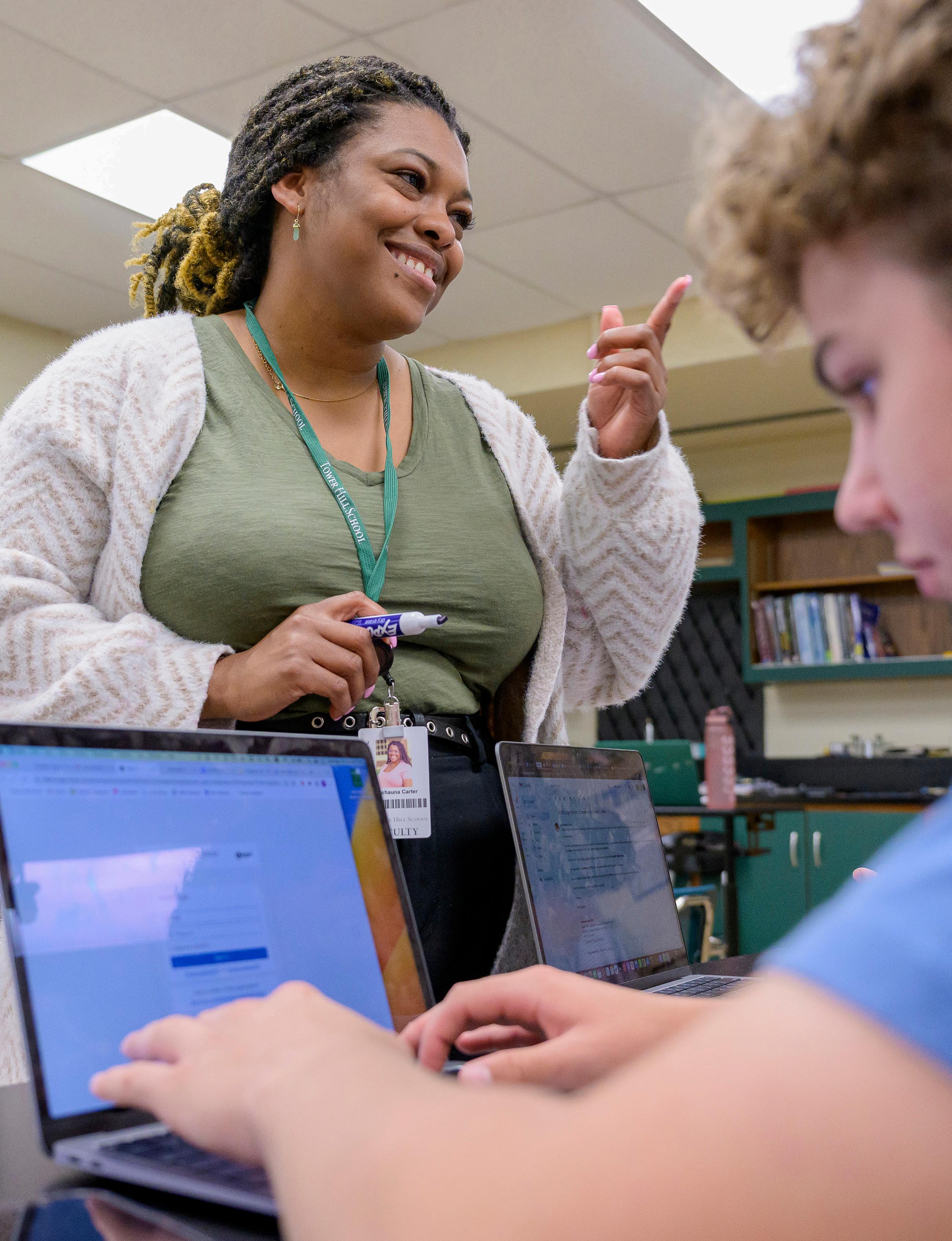
FACULTY FOCUS
STASHAUNA CARTER: A PASSION FOR SCIENCE & HARNESSING TECH IN THE CLASSROOM
BY MAURA CICCARELLI, FREELANCE WRITER
Upper School biology teacher
Stashauna Carter has been passionate about science since she was very young. Biology and genetics, in particular, held the answers she sought, including why her younger brothers suffered from sickle-cell disease but she did not.
“As a kid, I was so confused,” she says. “Why were my brothers always sick? I didn’t like it. I didn’t get sick because I didn’t have the genetic trait for the disease.” That desire to understand her brothers’ chronic condition inspired her to pursue a career in science and become a teacher.
“My fifth grade teacher really encouraged and pushed me to be excellent in the sciences because it was something I was passionate about,” says Carter, who grew up in Kingston, Jamaica, before moving to Baltimore during high school.
She earned her bachelor’s in biology at Morgan State University and began teaching high school science in 2015. While earning her master’s degree in molecular biology at University of Delaware, she was a microbiology teaching assistant and worked in a UD hematology research lab that studied blood and blood disorders. Her specific research focused on erythropoiesis, which is the production of red blood cells.
In 2019, she returned to teaching biology, environmental science, human anatomy and physiology at Alexis I. DuPont High School in Wilmington. While there, she decided to tackle her own reluctance to use technology in the classroom by pursuing a master’s in instructional technology at Lehigh University, which made her fascinated by what tech could do for teachers and students.
“During the pandemic, I wanted to explore how to incorporate technology into instruction so it could be just as effective a teaching and learning method as in a classroom setting. It was very
important for me to be proficient in how to use technology to do just that,” explains Carter, who joined Tower Hill in fall 2022. “I want the best for my students, so I’ll do whatever it takes, whatever the best method is.”
Since then, she’s integrated a wide variety of programs and websites to engage and educate students in the science, technology and math aspects of STEM. For example, her students looked at online heat maps of the Wilmington area encompassing Tower Hill. They learned why some areas that included plants, trees and natural ground covers like grass were cooler in an urban area, even if they included pavement and buildings.
“They learned how to look at GIS [geographic information system] maps, collect data, build a ‘story map’ to explain why some areas were cooler than others and make recommendations to reduce the heat effect,” she says. “They could use their phone and their computers but they had to use them effectively. It’s been really fun doing stuff like that.”
She added, “Just watching my students grow has been amazing. To see them come in with no strong understanding of concepts and leaving being confident with certain science skills has really been great.”
TOWER HILL COMMUNITY
“The second that I had my first Zoom interview, I fell in love with the people here,” she says. “When I came on campus, everyone was so warm and welcoming. Tower Hill is very dedicated to academics but also has such a strong family community. I wanted to be part of a school that wanted kids to not just succeed in academics but to live up to Tower Hill’s motto, which is Multa Bene Facta, or Many Things Done Well.”
The school’s close community became a critical support for Carter’s family in early 2023, she says. Fire destroyed their home in the middle
of a school day, leaving Carter, her husband Kyle, and their then 3-yearold daughter, Avery, without a place to live.
She remembers how kind her colleagues were, stepping in to tell her they’d take over her classes for the rest of the day. They also picked up Avery to keep her safe while she and her husband dealt with the challenges that ensued.
“It was amazing the amount of support I got even before I left the building for the day. And, the amount of support Avery got when she returned to school, too. People in the Home and School Association and PAATH [Parents of African Americans at Tower Hill] were also so helpful, asking what we needed. My colleagues said they would be there for me if I needed to leave to take care of stuff about the house. The parents have been very understanding,” she recalls.
Her home’s renovations are projected to be completed in early 2024.
OUTSIDE ADVENTURES
On the personal side, Carter and her family go hiking every Sunday, first thing in the morning. “It’s our time to reset before the start of the week and to take that time as a family to really reconnect to ourselves,” she says.
Along the way, they have meaningful conversations, particularly spurred by her daughter’s questions about how the natural world works. After Carter told her daughter about photosynthesis, her daughter turned to her dad and said, “The trees need sun to make food.” Then, she asked, “Do the fungi do that?”
“It is great having her ask science questions,” says Carter, who seems to have passed on to her daughter a deep curiosity about science and the world around her.
51 Tower Hill Bulletin Fall 2023
FACULTY
NEW ADMINISTRATORS
MOLLY ELTON

Mrs. Elton will serve as Interim Director of Social Justice from August 2023 through January 2024 while Natasha Muurray-Everett is on leave. Molly has served in the Upper School since 2019 as Associate Director of College Counseling. She has worked closely with PAATH and THS alumni to plan HBCU week in September and facilitated conversations at the Upper School Symposium. In this interim role, Molly will work with our DEI coordinators in each division on programming and serve as a point of contact for families.
JESSICA DOUGLASS
Ms. Douglass will serve as Interim Dean of Students for the 2023-2024 school year. Jessica has served Tower Hill in various roles including teacher, learning specialist, Class of 2024 Dean and DEI Coordinator since 2018. Mrs. Douglass is currently completing her Doctorate in Education at the University of Virginia with a focus in social and emotional learning. We are grateful to have Jessica’s experience and scholarship, along with the strong relationships she carries with our students.
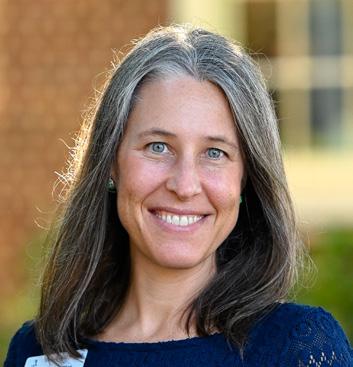
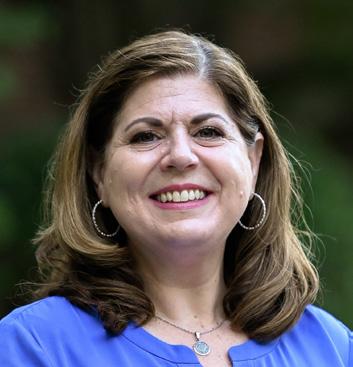
KELLY HUNTER, ED.D.
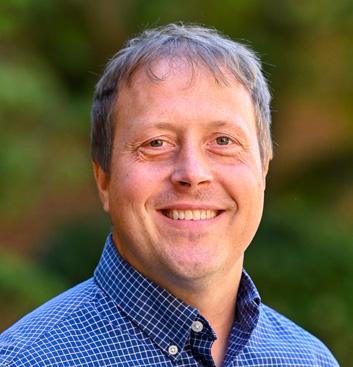
Dr. Hunter is now serving as Director of the Teaching and Learning Center (TLC) and Chair of Learning Support. In her new position, Kelly will devote her full attention to overseeing all aspects of learning support in the Middle and Upper Schools and will collaborate with Lower School Learning Specialists, fellow Department Chairs, faculty, the school psychologists and others to ensure a robust and fully supportive environment for all students at Tower Hill. She will also continue to work directly with students in the Middle and Upper Schools as a Learning Specialist.
BRET KROEGER
Mr. Kroeger assumes a new role as Director of Scheduling and Registrar, taking an all-school scheduling role; supervising all grade and transcript-related record-keeping and serving as primary contact for Blackbaud; and overseeing any eventual schedule or crediting redesign processes we undertake. Bret will sit on the school’s Administrative Council, where he will represent a classroom teacher’s perspective, consider how decisions affect and are affected by the use of time and spaces, and use his keen eye for data to the school’s benefit. Bret will continue to teach two sections of Upper School mathematics.
NEW TRUSTEES
LOGAN WEAVER READ ’10
Logan is a “Lifer” THS alumnae, class of 2010. Logan graduated from Georgetown University in 2014 with a BA in American Studies. She received her Master of Communication Management from Annenberg School for Communication and Journalism at USC in 2021. While in college, she interned at Freeh Group in Wilmington, The White House Operations and Advance office for then Vice President Joe Biden, and with the FBI as an economic crime intern. Her first job after undergrad was with Oracle as a sales and market development representative. She then worked for Virgin Pulse as manager of client communications. She is currently working at MIT as a communication specialist in the Office of Government and Community Relations.
Logan is very engaged both with her time and giving. She is currently on the Advancement Committee, is a five-year consecutive donor, Annual Fund Leadership Donor and has volunteered as a Class Agent since 2011. She was a panelist for THS Career Day in November 2021. She and her husband, Tyler Read, were married in 2018. They reside in Boston and have a son, Landon, who was born in 2022. She is also part of the Boston Public Library’s Emerging Leaders program. Her father, Lance Weaver and grandfather, Bill Daiger are former trustees. Her sister, Loring ’08, is also a “Lifer.”
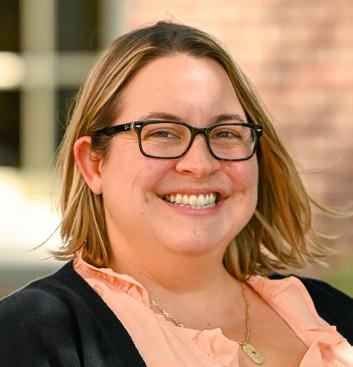
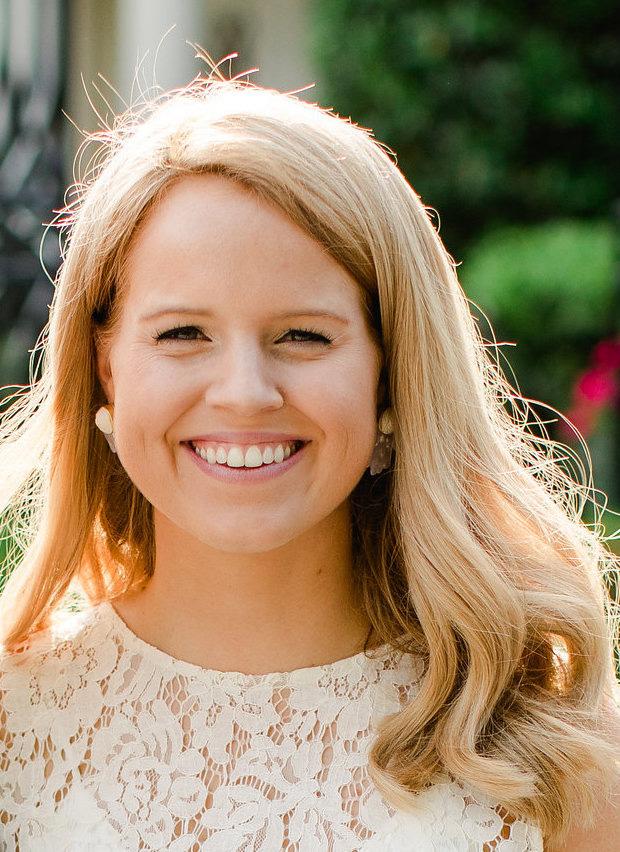
52 Tower Hill Bulletin Fall 2023 Welcome
BRENT MCKNIGHT
Mr. McKnight will serve as Director of Campus Safety and Security. Brent joins from Coast Guard Investigative Services, where he served as Regional Director of Physical Security and Investigations and led a team responsible for security issues, crisis management and security planning in multiple states. Prior to this role, Brent was a Special Agent with the U.S. Secret Service for seven years. He holds a B.A. in Political Science from Montclair State in N.J.
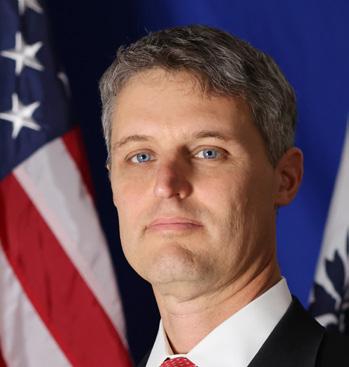
GREG SPEAR

Mr. Spear will serve as Interim Assistant Head of Upper School for the 2023-2024 school year. Since 2011, Greg has served our Middle and Upper Schools in a variety of roles including History teacher, Interim History Department Chair, Head Class Advisor, Class of 2026 Dean and FDC Chair. He has also supported our athletics program as a coach of three sports, including Head Coach of Varsity Wrestling and Middle School Athletics Coordinator. We are grateful to have Greg’s commitment to students, attention to detail and collaborative nature in this role.
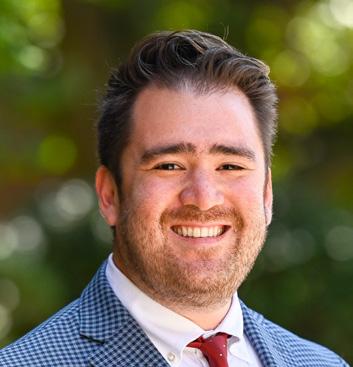
EDUARDO SILVIA
Mr. Silva will serve as Interim Head of Upper School for the 2023-2024 school year. Eduardo has served as Assistant Head of Upper School and Dean of Students, teacher, Department Chair and and the school’s first Director of Global Initiatives. Throughout his tenure he has worked closely with the Director of Social Justice and has demonstrated a deep commitment to that work. In addition, he has participated in the school’s growth by serving on and leading several key committees and initiatives since joining Tower Hill as a faculty member in 2013.
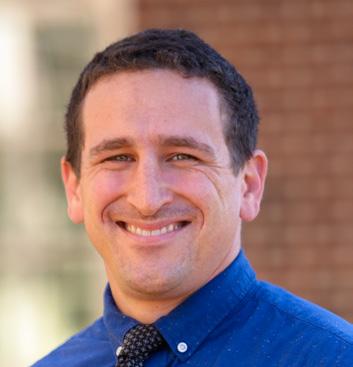
PATTY TARTAGLIA
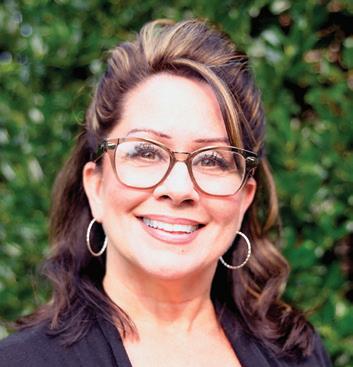
Ms. Tartaglia will serve as Executive Assistant to the Head of School. Patty comes to Tower Hill with 39 years of experience as a legal and executive assistant, paralegal and project coordinator, most recently at the law firm of Faegre Drinker Biddle & Reath LLP for the last nine years. She has also worked at Harkins and Harkins in Philadelphia and Blank Rome LLP in Cherry Hill/Princeton, N.J. Patty graduated from Taylor Business Institute.
SONAL SHEPPARD
Sonal Sheppard is an attorney and former in-house counsel for Actavis Inc., a generic pharmaceutical company. In her role as in-house counsel, she was able to bring her legal acumen to the dynamic and ever-evolving landscape of the pharmaceutical industry while navigating regulatory complexities and safeguarding the company’s interests. Prior to her role in corporate America, she began her professional journey in the field of legal services at Delaware Legal Services, Inc. It was here that her passion for making a difference and helping people became a driving force throughout her career. Sonal has been characterized by her unwavering commitment to help, her ability to adapt to diverse environments and her dedication to making a positive difference. In that vein, Sonal has dedicated countless hours to various initiatives within the Tower Hill community. She has co-chaired Home and School Association committees including the Thrift Shop by Tower Hill School and Book Fair. Sonal also recently held positions on the Home and School Executive Committee as Assistant Treasurer and Treasurer. Sonal is a graduate of the University of Delaware and Widener University Delaware Law School. She is a THS parent of Sadie ’28 and Jayden ’28 who started at Tower Hill School as Tower Tots.
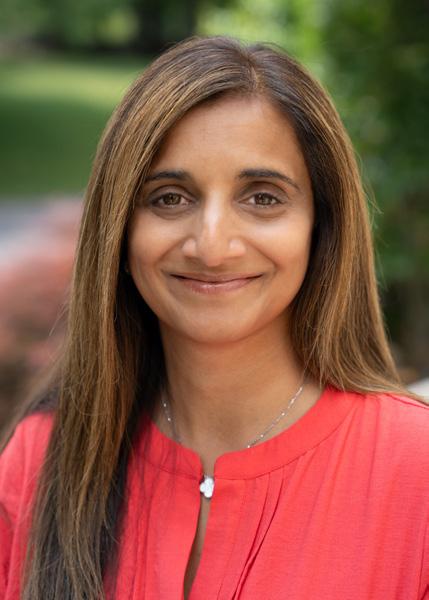
FACULTY
53 Tower Hill Bulletin Fall 2023
NEW FACULTY & STAFF
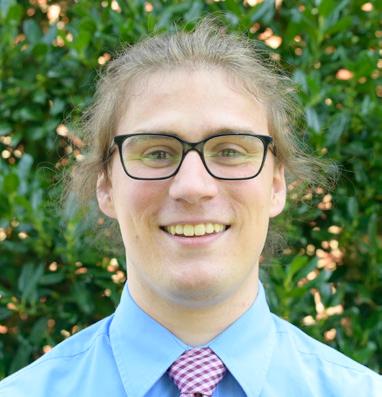
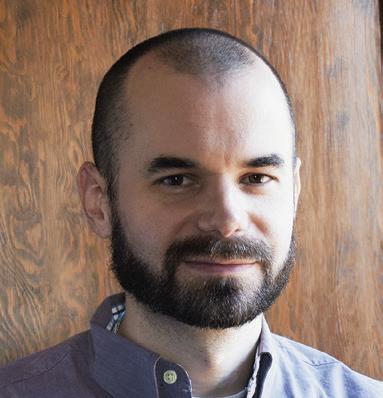
CAROLINE FELDMAN
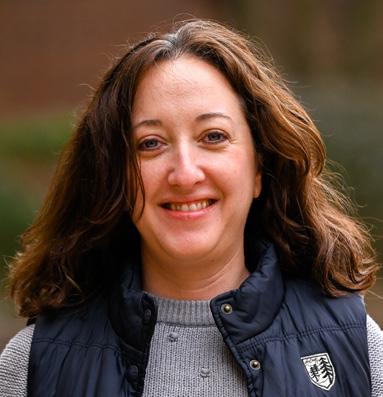
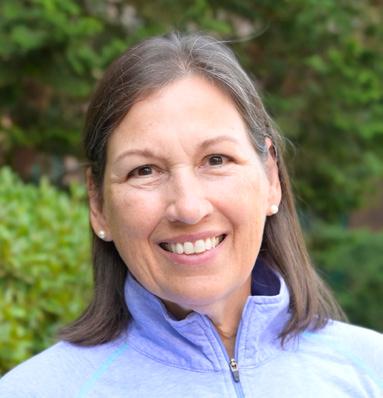
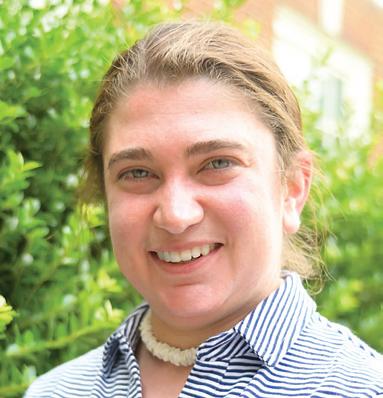
NATALIE
KIMBERLY SMITH Associate Director of Communications and Marketing
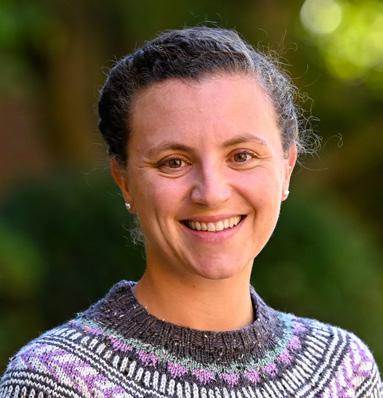
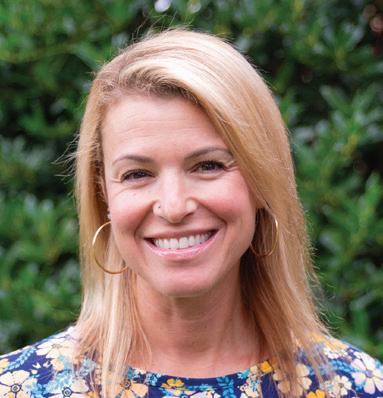
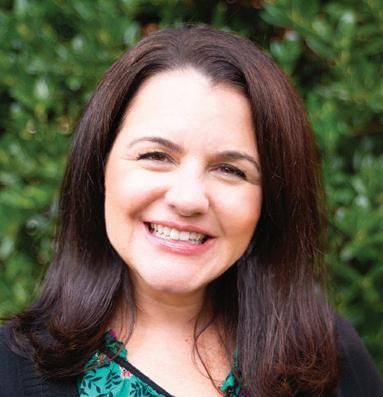
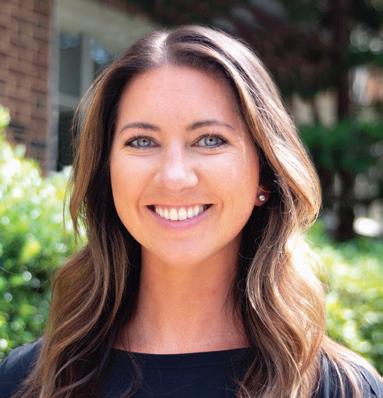
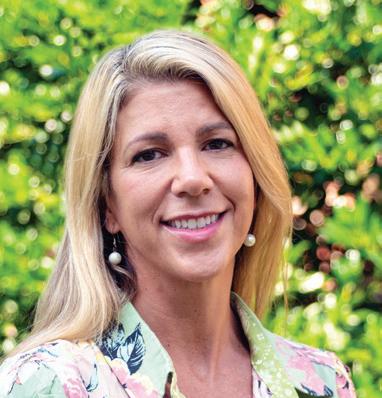
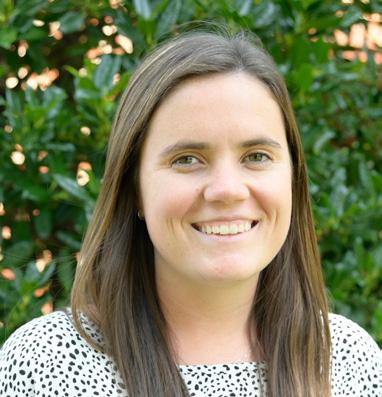
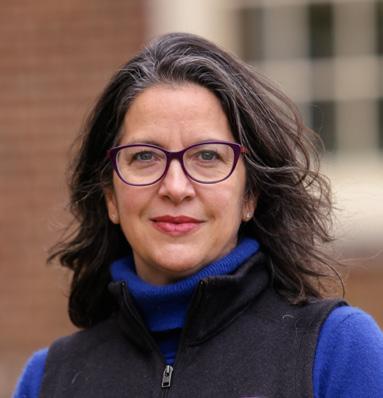
54 Tower Hill Bulletin Fall 2023
JENNIFER MEEKER Associate Director of College Counseling
Middle and Upper School Math and Science Teacher
JEFF HART Middle and Upper School Music Teacher
HOBBS Communications Specialist
SARAH ORYSIEK Middle and Upper School Learning Specialist
NICOLE RAFFERTY Middle School Learning Specialist
JACOB VISCUSI Upper School Math Teacher
GRETCHEN LACEY Lower School Teacher
JACKIE YOUNG Associate Director of Business Operations
TORI HEALY Interim Theater Department Chair
Welcome
MIRIAM PALLANT Interim Language Department Chair
YEARS OF SERVICE RECOGNITION
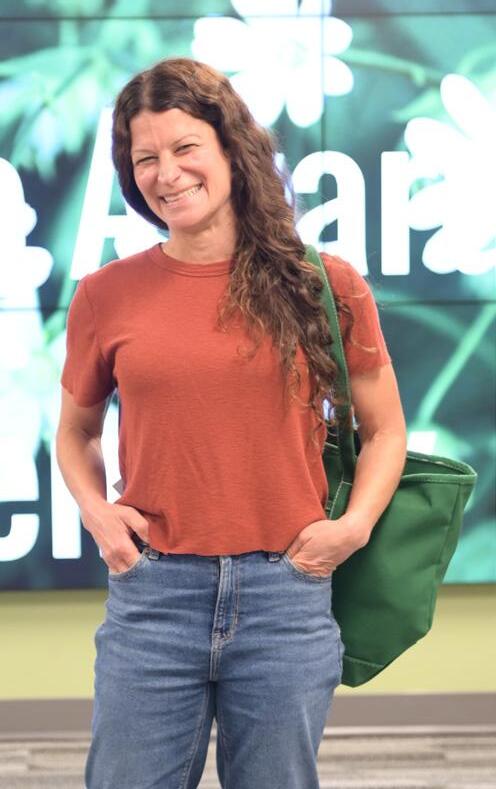
Faculty and staff were recognized in April for their years of service to the school at an event hosted by the Tower Hill Board of Trustees.
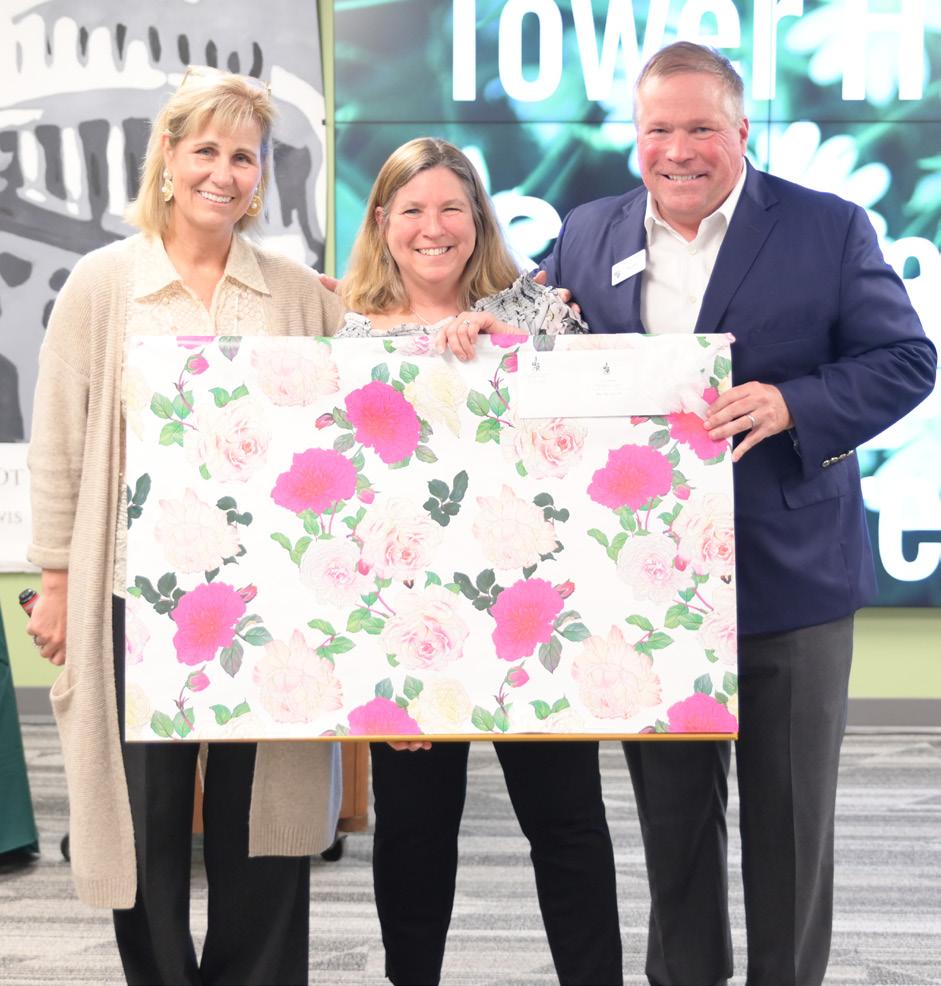
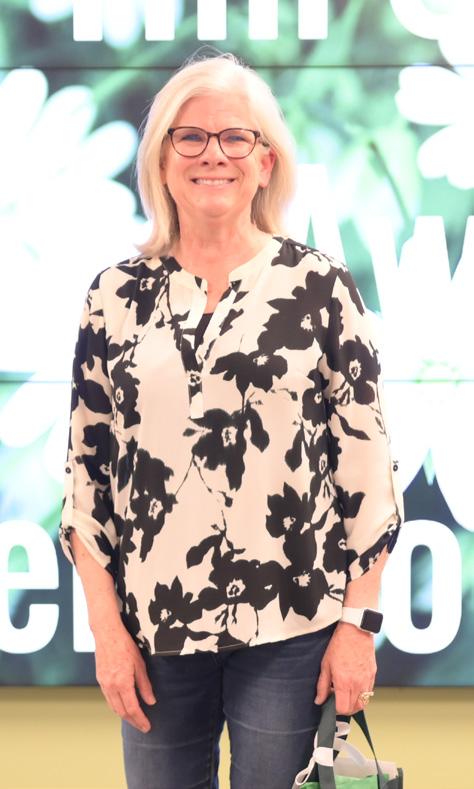
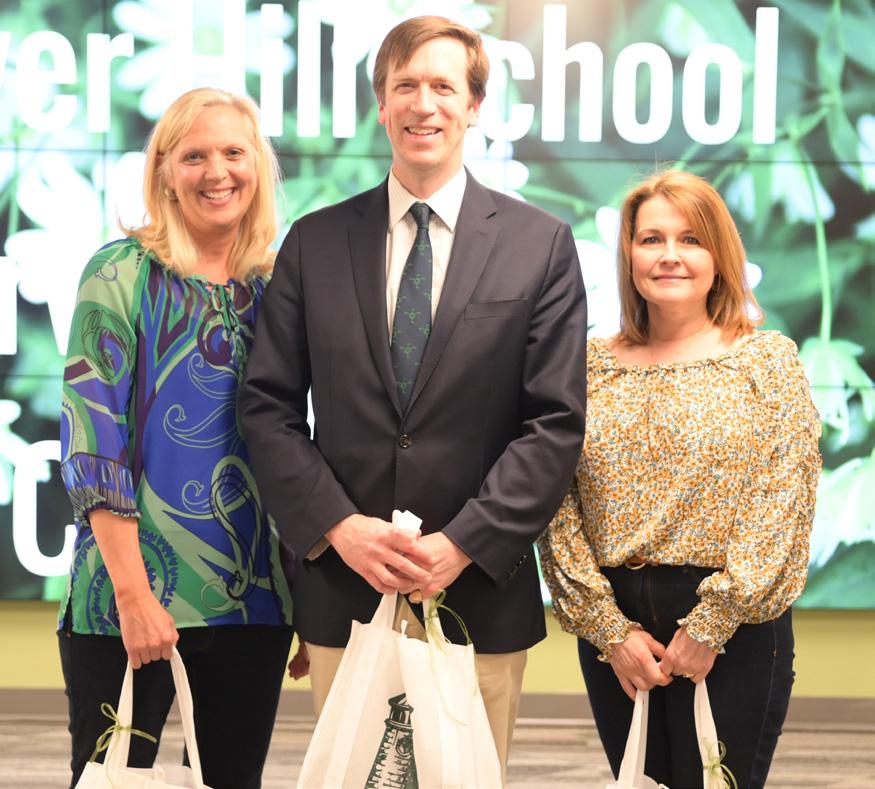
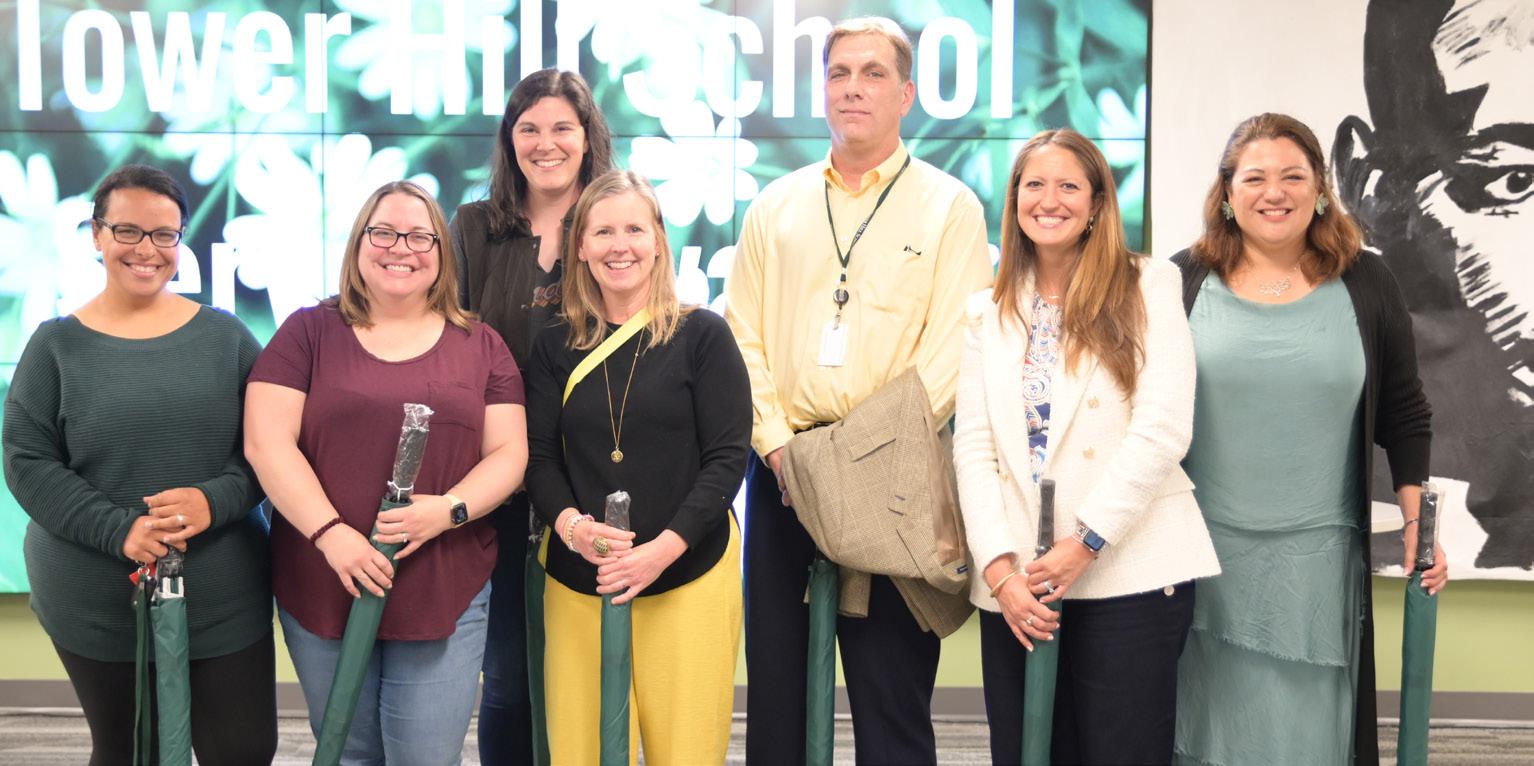
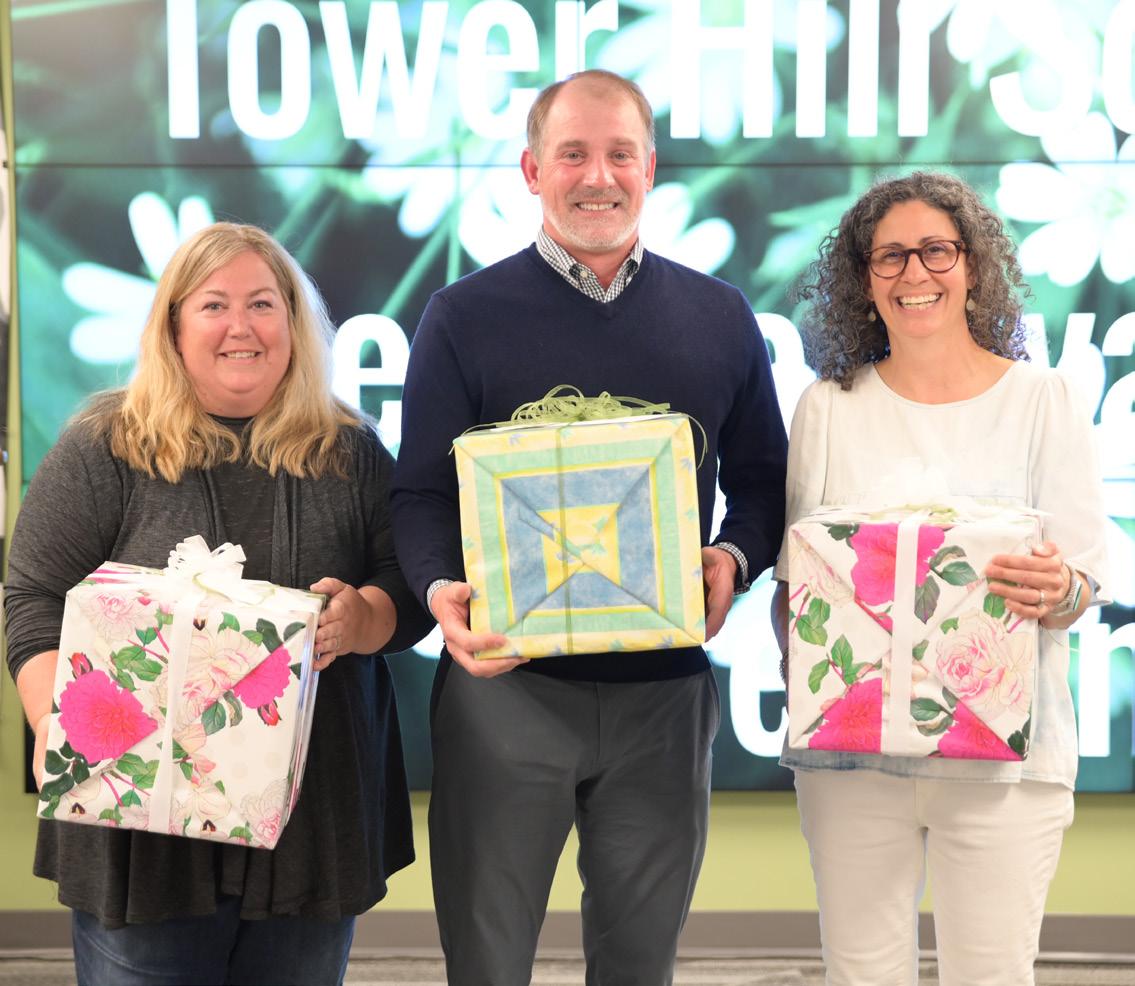
55 Tower Hill Bulletin Fall 2023
1. Laurie Edinger is recognized for 35 years at Tower Hill (pictured with 10th Head of School Bessie Speers and Board Chair Ben duPont ’82). 2. Beth Orsetti, Julie RocaBristowe, Charles Sharon are recognized for 25 years at Tower Hill. 3. Jeannie Snyder is recognized for 20 years at Tower Hill. 4. Natalie Moravek is recognized for 15 years at Tower Hill. 5. Vilma Andrews, Eduardo Silva, Deb Steubing, Tim Weymouth are recognized for 10 years at Tower Hill. 6. James Conover, Jessica Douglass, Lexy Herbein, Torrey Kist, Bret Kroeger, Lauren Lineback, Carmen Martinez-Flores, Dr. Anna Miller, Eric Norman, Miriam Pallant, Melissa Pizarro, Maurice Rapp, Michelle Wrambel, Casey Yuros are recognized for five years at Tower Hill.
2 FACULTY 1 4 3 5 6
STATE CHAMPS
DIAA Champion
Congratulations to Vincent Grillo ’23 on winning the Division 2 Boys Shot Put event at this year’s DIAA Championship Meet with a throw of 50-4.5! He later earned a 2nd place finish with a throw of 51-9.5 at the DIAA Meet of Champions, which is a meet that brings together the best of the best from Divisions 1 and 2 based on performances at the DIAA Championship Meet.
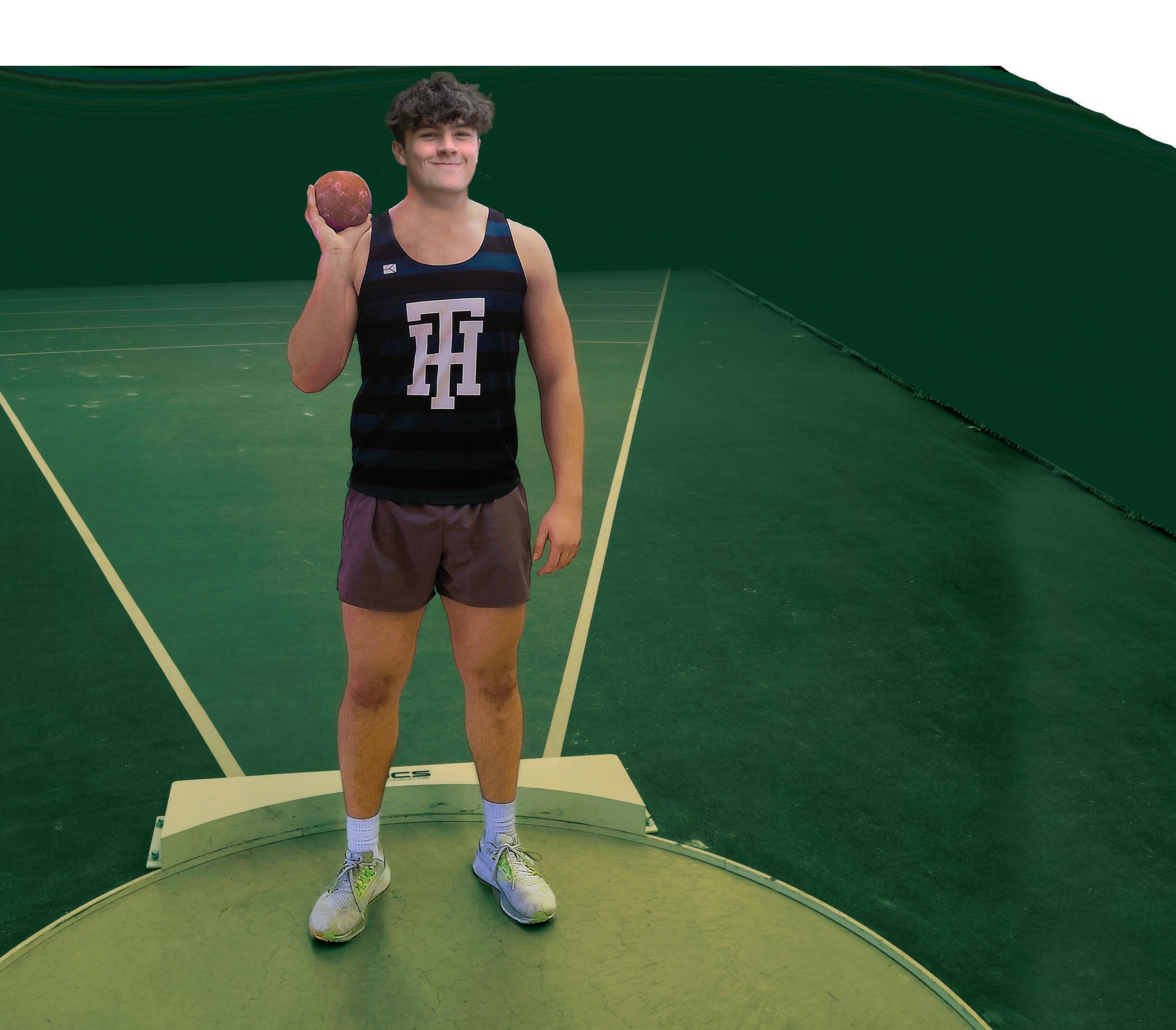
2023 | ATHLETIC SPRING SEASON
GOLF TEAM WINS DIAA CHAMPIONSHIP AFTER ROUND 2 COMEBACK

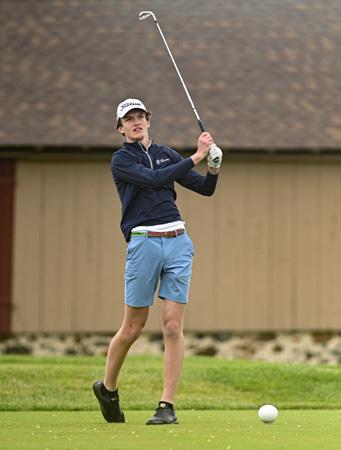

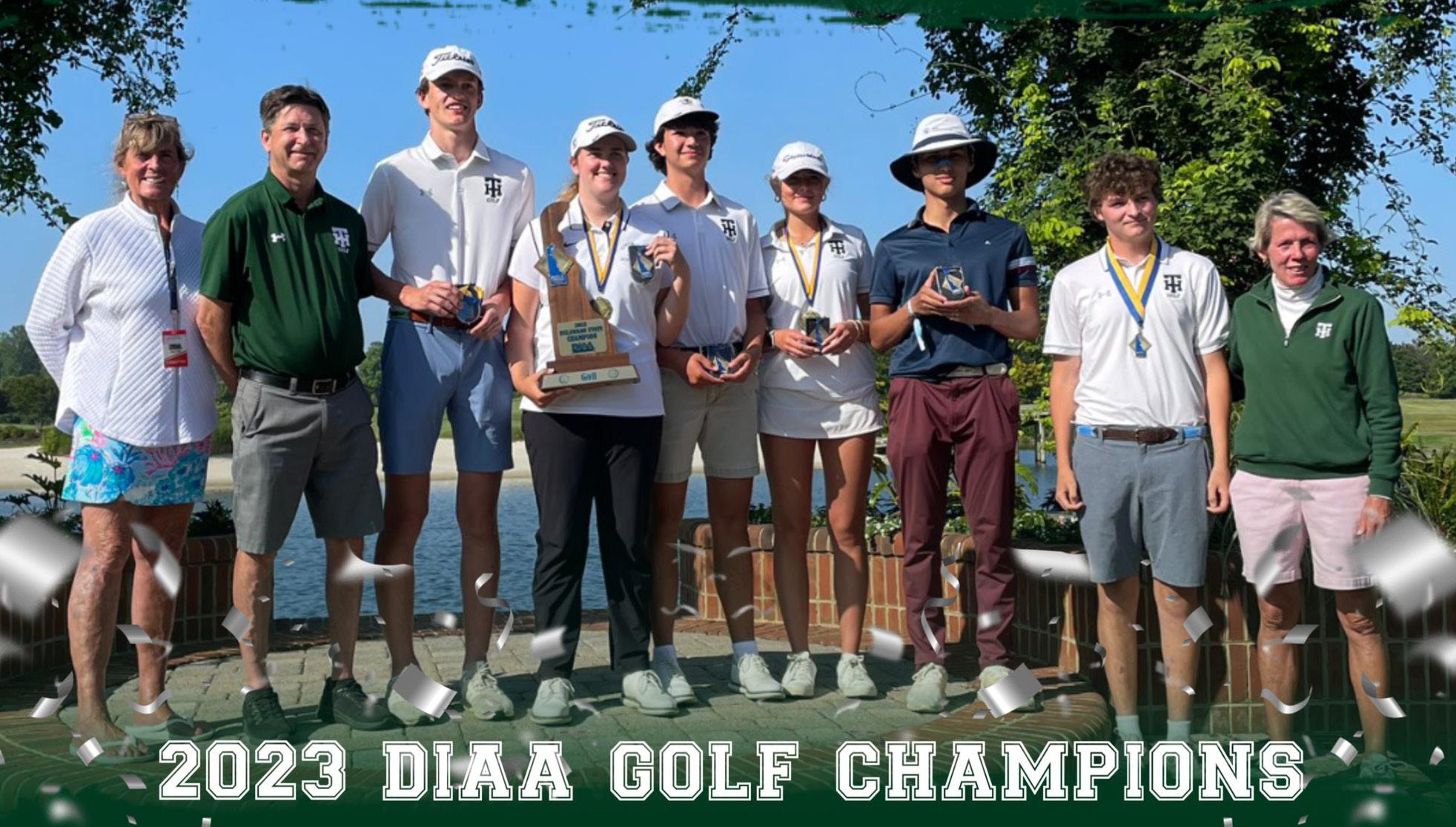
The varsity golf team overcame a 5-stroke deficit heading into Round 2 to force a playoff vs Tatnall before clinching their 6th state championship in the last seven seasons! Avery McCrery ’25 won the Girls Individual title, shooting a 65 in Round 2 and finishing -8 overall for the championship, seven shots clear of any other golfer in the field. She now holds the record for the lowest single round score (65) and lowest overall score (136) in the history of the DIAA Golf Championships! Sawyer Brockstedt ’25 finished +5 overall to earn the 5th place medal for the girls. For the Boys Individual championship, Michael Dignazio ’24 finished in 9th place and Nate Zehner ’24 finished in 43rd place. As a team, the Round 2 score of 217 was the lowest of any of the six championship teams in Tower Hill history. Overall, the five qualifying team members scored as follows: McCrery: -1 | -7; Brockstedt: +2 | +3; Dignazio: +13 | +5; Zehner: +11 | +25; Justin Solacoff ’24: +22 | MC
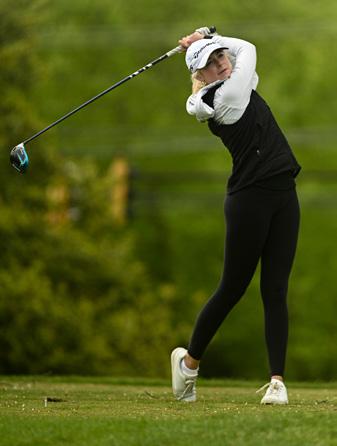
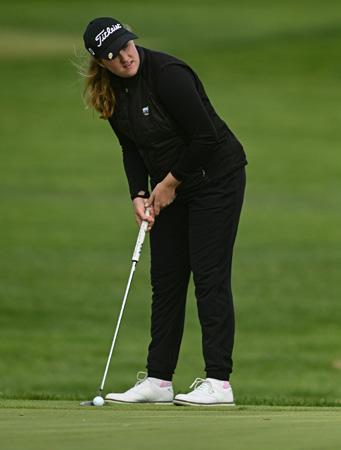
57 Tower Hill Bulletin Fall 2023
ATHLETICS
Avery McCrery
Nate Zehner
Justin Solacoff
Michael Dignazio Sawyer Brockstedt
ATHLETICS
SPRING SPORTS HIGHLIGHTS
BASEBALL
The varsity baseball team finished the regular season 13-5 and earned the 11th seed in the DIAA Baseball Championship but lost a tough game in round 1 vs Lake Forest. Congratulations to Marty Coyne ’23 for exceeding 200 strikeouts.
BOYS LACROSSE
The varsity boys lacrosse team finished the regular season 11-4 and earned the 8th seed in the DIAA Boys Lacrosse Championship but ultimately fell in round 1 vs Salesianum.
GIRLS LACROSSE
The varsity girls lacrosse team finished the regular season 11-4 and earned the 6th seed in the DIAA Girls Lacrosse Championship. The team fell in the quarterfinals vs Archmere.
GIRLS SOCCER
The varsity girls soccer team finished the regular season 7-8.
TENNIS
The varsity boys and varsity girls tennis teams each earned 2nd place finishes at the DIAA Championships. Individually, Ava Emrich ’25 (Girls 1st singles), Drew Allen ’23 (Boys 2nd singles), Constantine Moutsatsos ’23 (Boys 3rd singles), Anna Schiltz ’24 (Girls 3rd singles), Matthew Heinle ’23 and Demetri Moutsatsos ’24 (Boys 1st doubles), Meghan Mumford ’24 and Bridget Heinle ’25 (Girls 1st doubles), and Jack Allen ’24 and Samuel DeSantis ’26 (Boys 2nd doubles) all earned

2nd place finishes in their respective events. Both teams won their respective DISC championships! For the boys (11-0), this marks their 10th consecutive conference title, and they have now won 72 straight conference matches dating back to 2013. For the girls (12-0), this is their third conference title in the last four seasons and their first undefeated DISC season since 2017.
TRACK AND FIELD
The varsity boys and girls track and field teams competed in a number of highly competitive invitationals throughout the regular season amongst the very best in Delaware, which included our boys and girls track and field teams who both earned 1st place finishes at the 2nd Annual Bob Behr Invitational with over 20 personal records set! In the signature event of the meet, the Bob Behr Mile (1600m Run), Catherine Farnan ’25 earned a 1st place finish for the girls and Colby Twyman ’25 finished in 2nd place for the boys. Vincent Grillo ’23 won the boys shot put event with a personal best 52-0¾ to win by more than 7 feet. A select group of runners from our boys and girls track and field teams competed in the 127th running of the Penn Relays at the University of Pennsylvania’s Franklin Field. In the 4x100m relay events, the girls relay team, consisting of Danielle Soleye ’26, Charlotte Theuring ’24, Bryce Twyman ’25, Madison Dennis ’24, and Kennedy Haskins ’26 as an alternate, earned a 1st place finish in their respective heat with a time of 53.21, while the boys relay team, consisting of Tisyn Witcher ’26, Joshua Hall ’23, Leo Liu ’25, and Dominick Pietlock ’23, finished in 3rd place in their respective heat with a time of 45.50.
Congratulations to our student-athletes who will continue their athletic careers in college!
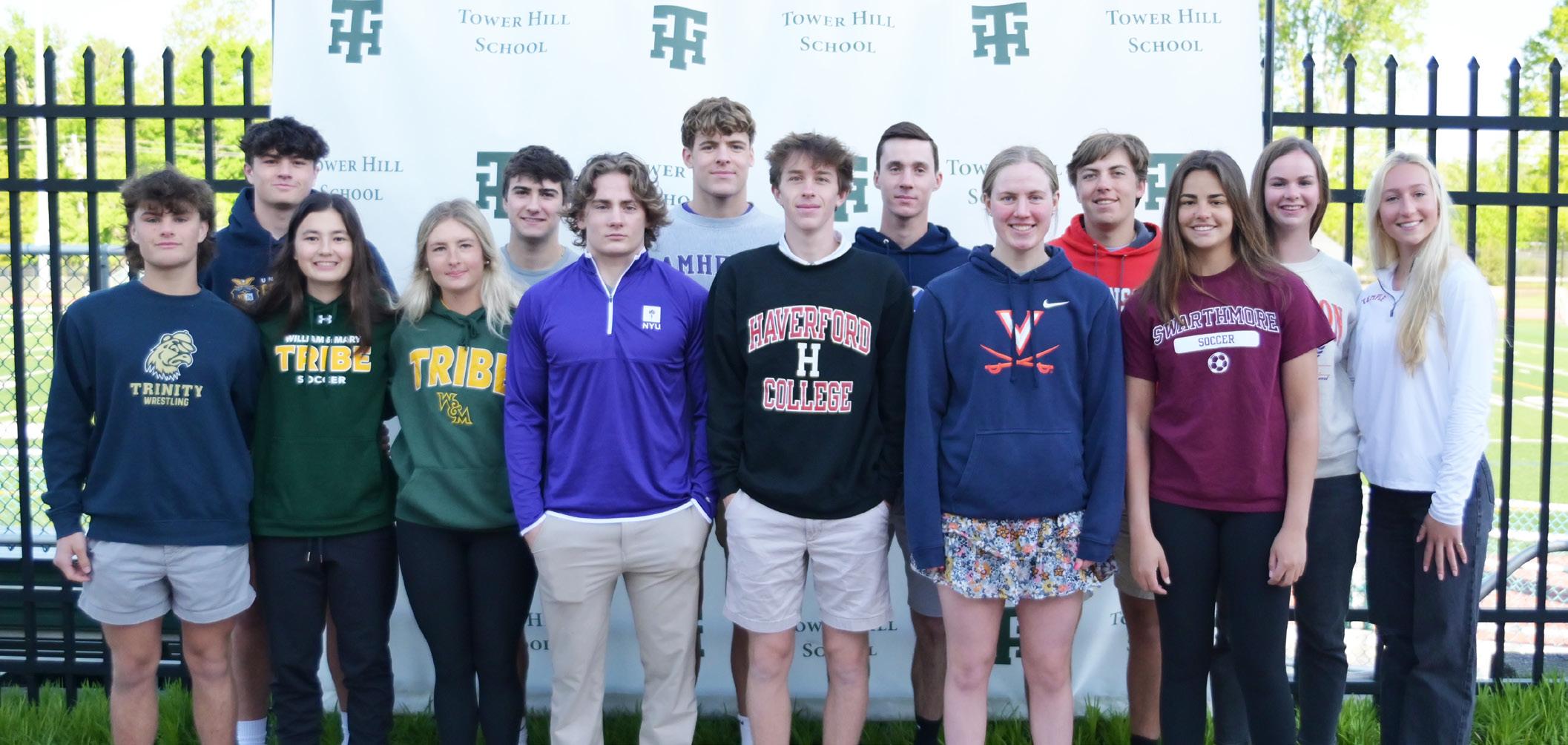
Sofie Aird - Swarthmore College - Soccer
Drew Allen - Dickinson College - Tennis
Tom Conaty - Amherst College - Swimming
Marty Coyne - University of Pennsylvania - Baseball
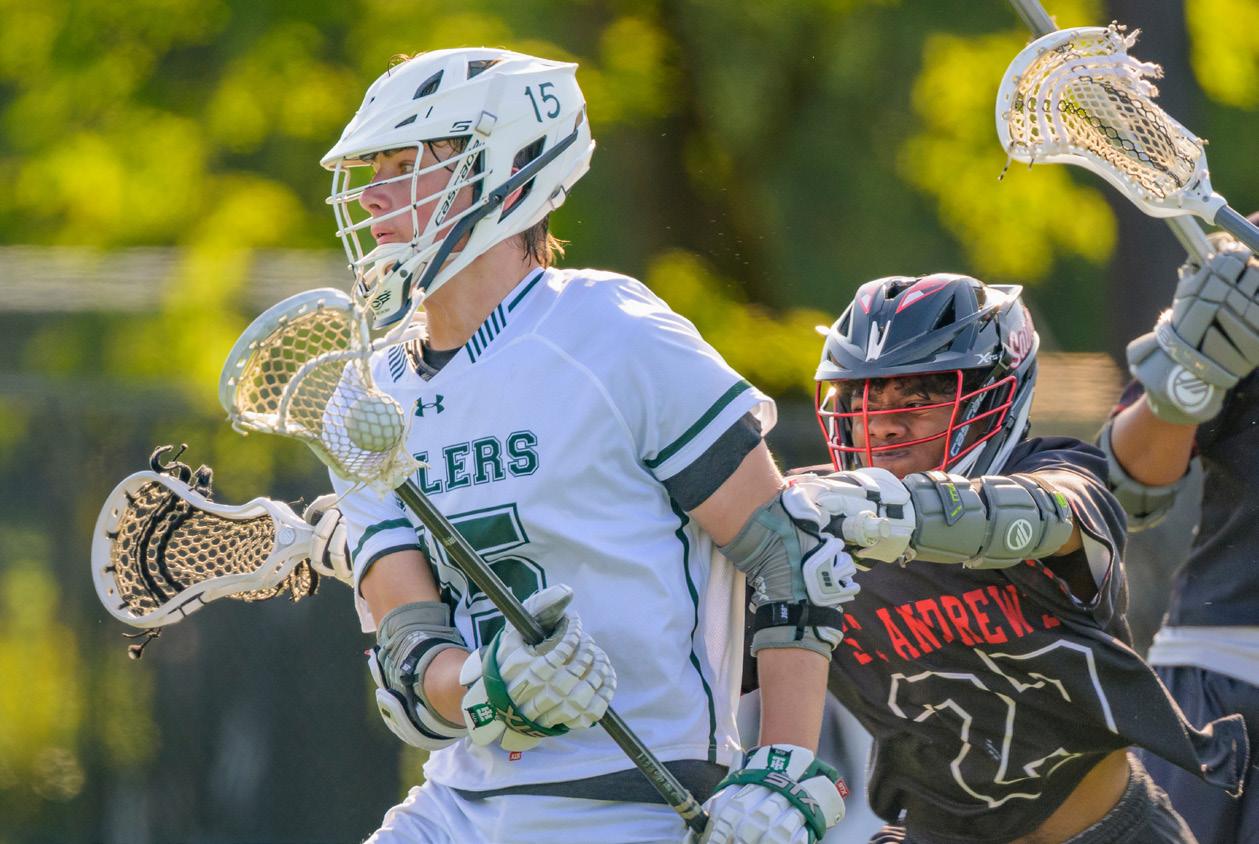
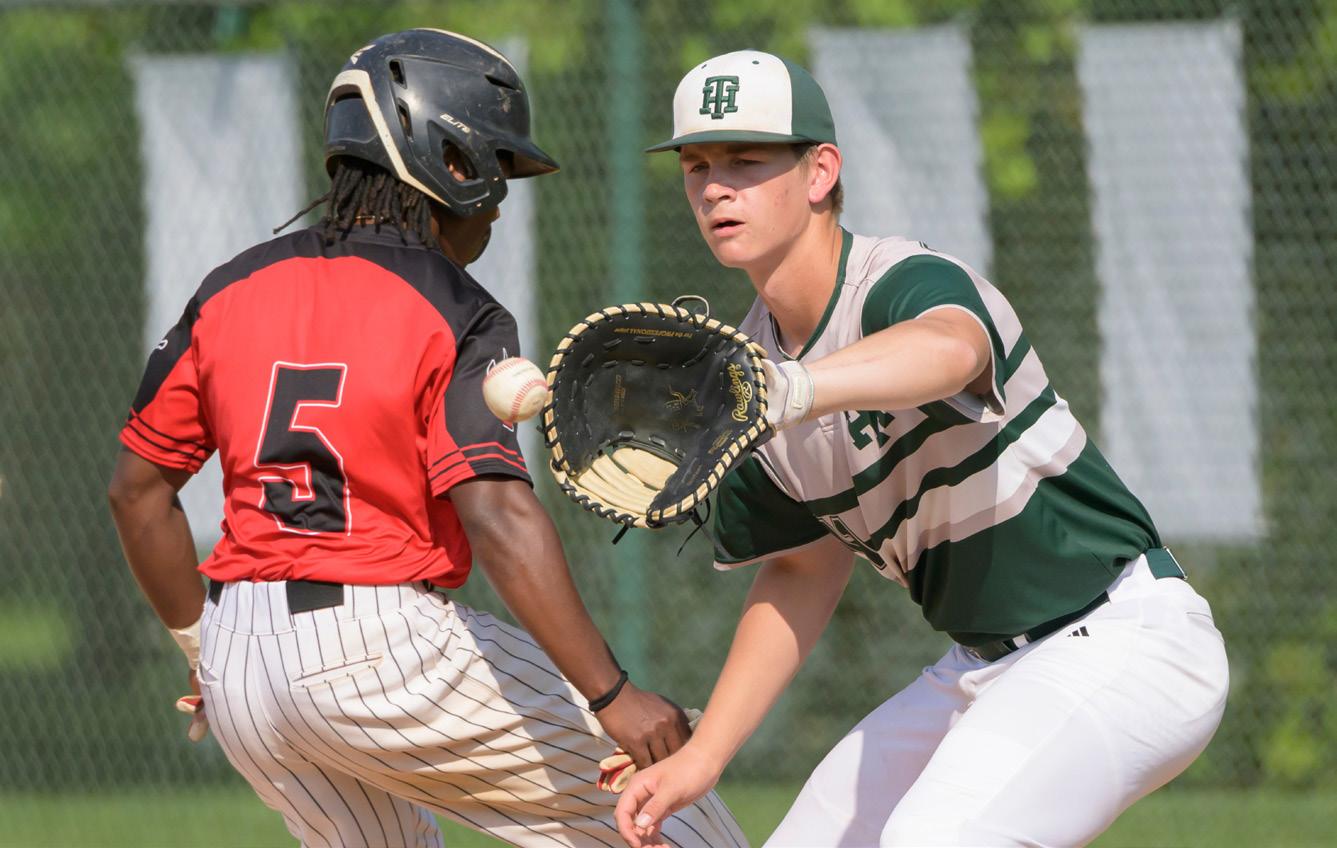
Rachel Graveline - Clemson University - Rowing
Brooke Griffin - Temple University - Rowing
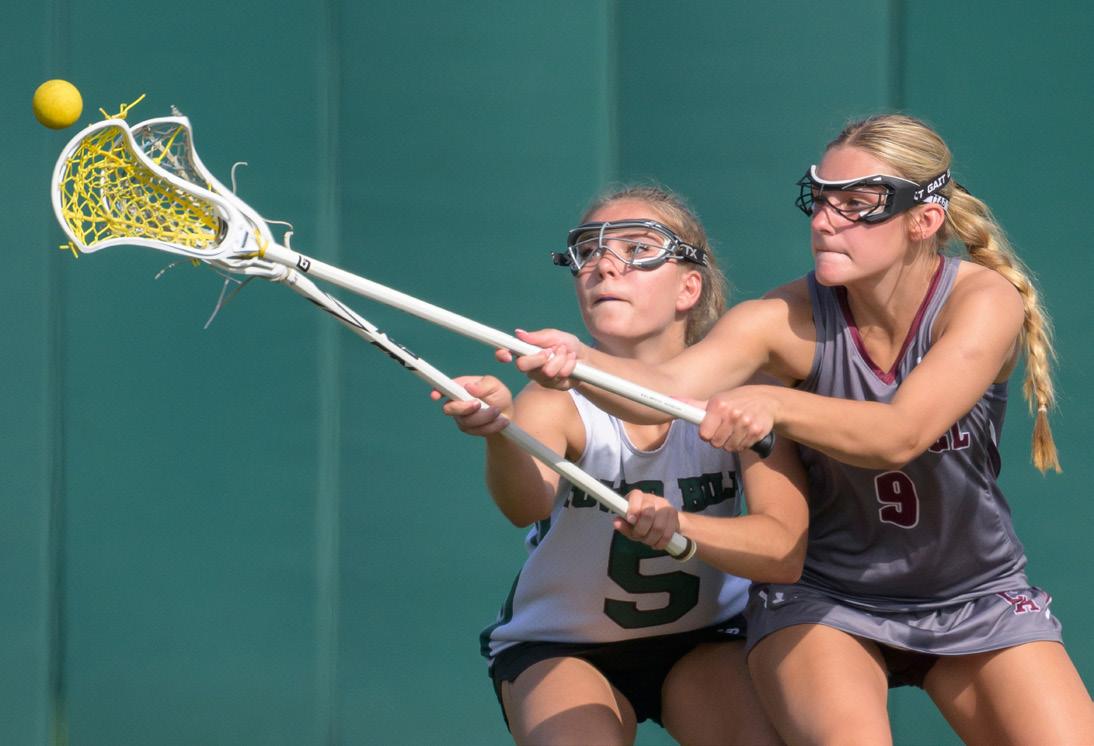
Vincent Grillo - United States Coast Guard Academy - Track & Field

Anthony Lucian - New York University - Wrestling
Lainey Mullins - University of Virginia - Swimming
Dominick Pietlock - Gettysburg College - Football
Drew Pratt - Trinity College - Wrestling
Dean Shepherd - Delaware State - Basketball
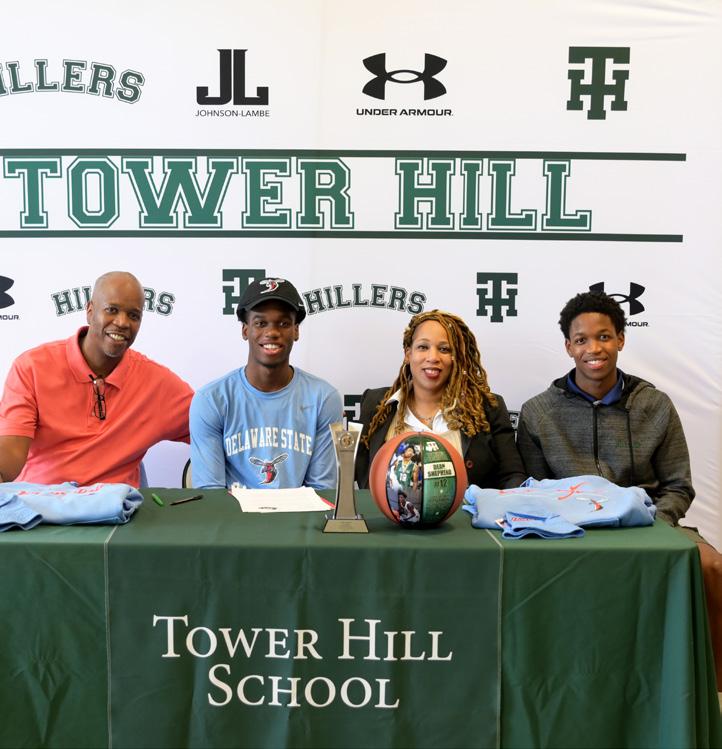
Caitlin Smith - The College of William & Mary - Soccer
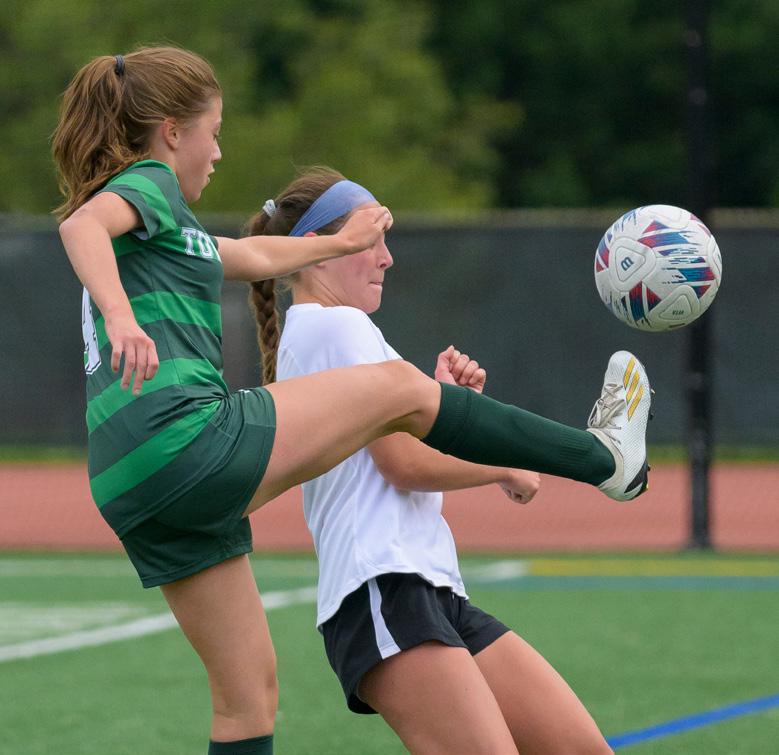
Ava Svindland - The College of William & Mary - Golf
Thomas Vanni - Haverford College - Soccer
SCHOOL LIFE ATHLETICS
TOWER DAY
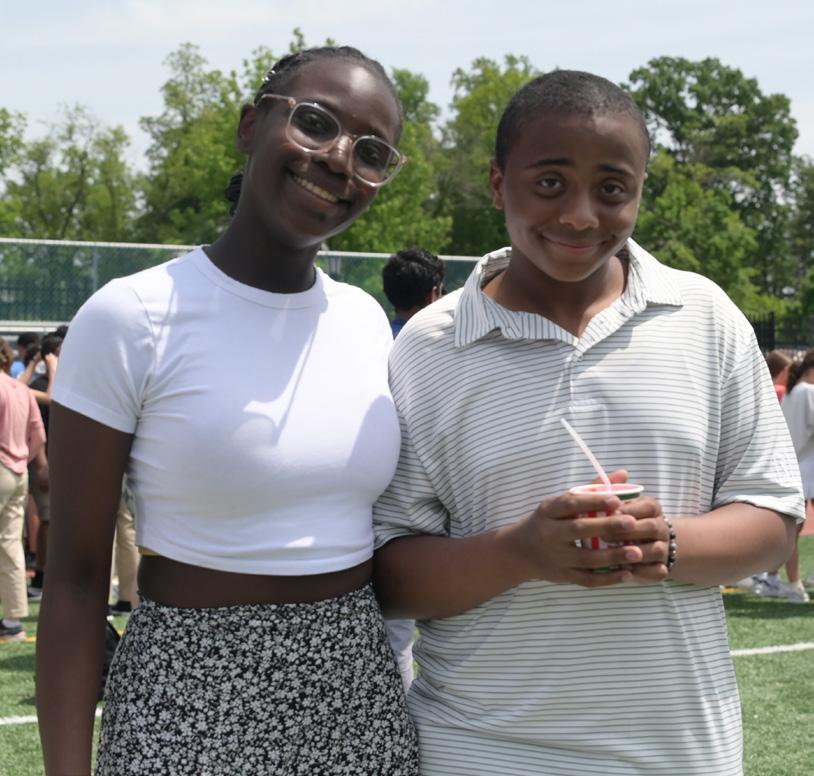
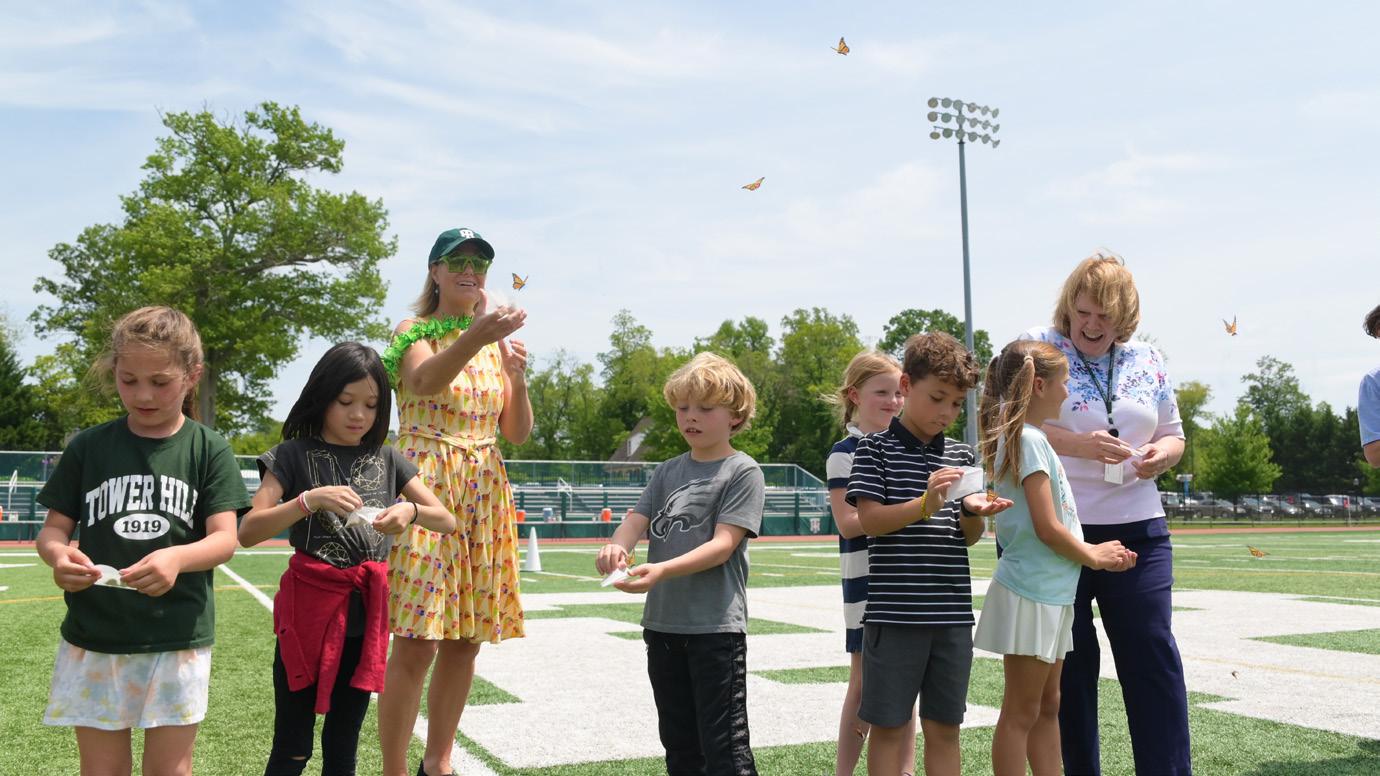
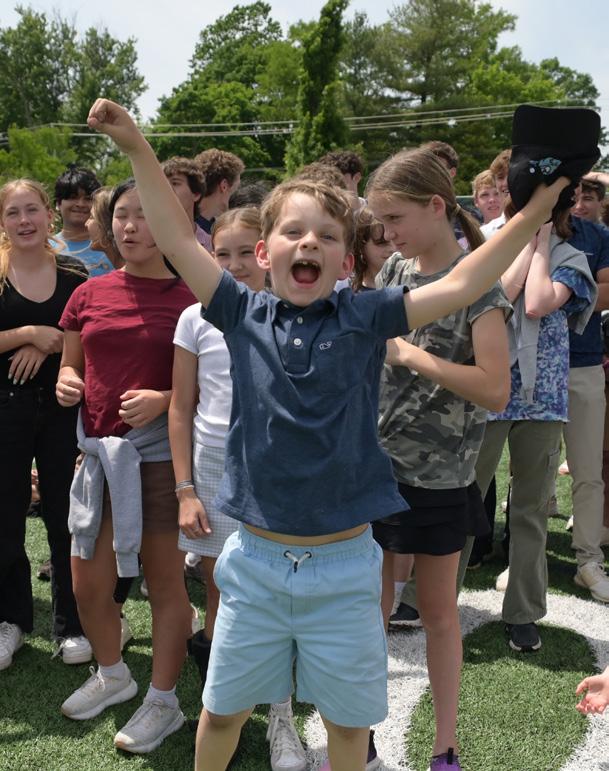
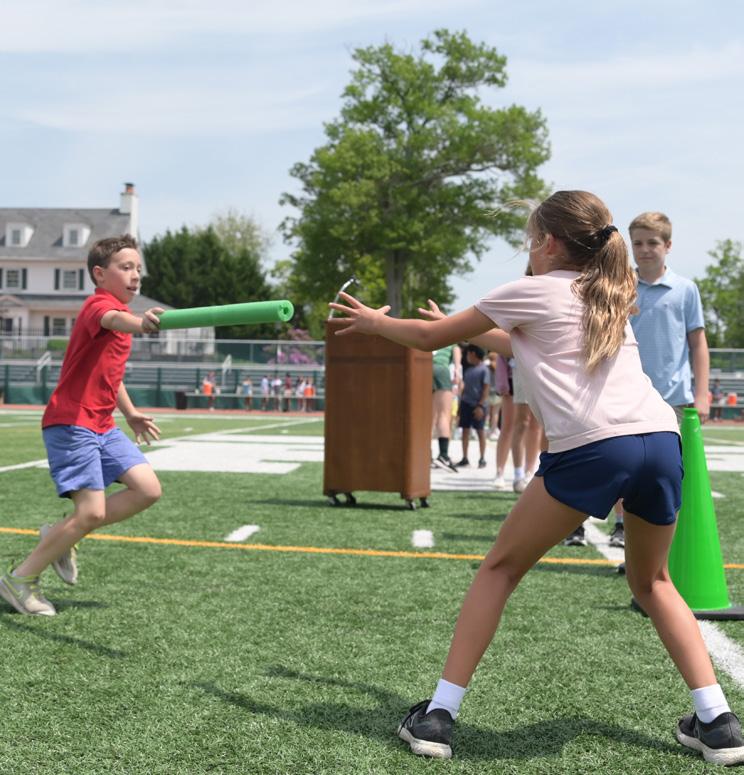

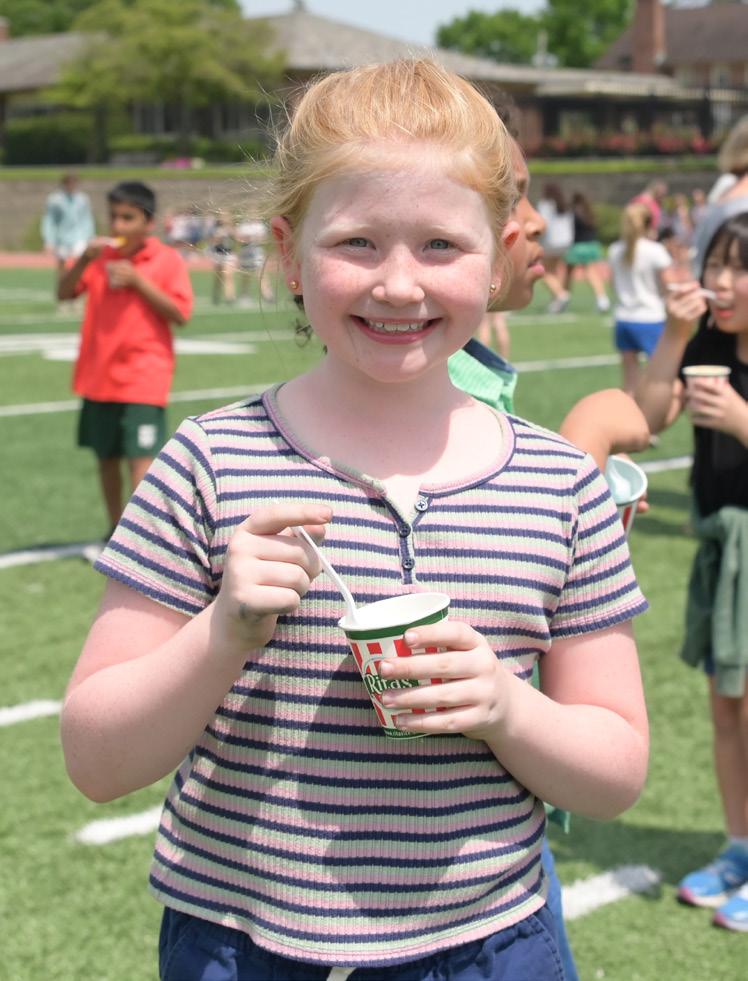
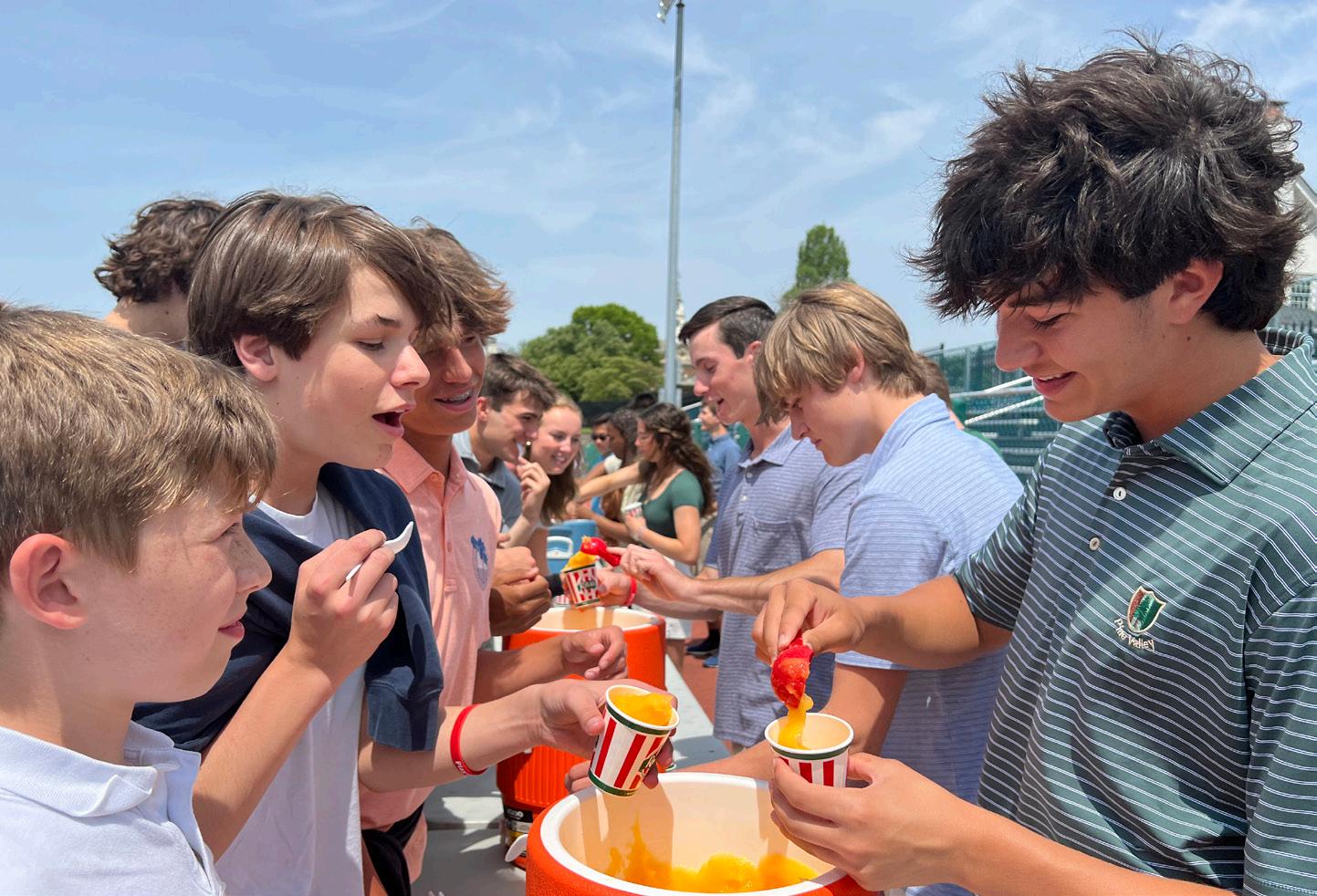
60 Tower Hill Bulletin Fall 2023
1 2
3 4 5 6 7
Tower Day is a tradition introduced in 2016 where the entire school enjoys a surprise afternoon outside celebrating spring. 1. Upper Schoolers scoop water ice for the students. 2. Third grader Lauren Remming enjoys her water ice. 3. Everyone enjoyed the beautiful weather. 4. The capstone event was a relay race. 5. Hudson Socha ’35 cheers on his classmates during the relay games. 6. Sixth grade friends Kaira Swain and Christian Barksdale hang out together. 7. Students and teachers released butterflies to honor 10th Head of School Bessie Speers.
GRANDPARENTS’ AND FRIENDS’ DAY
More than 450 visitors came to campus and joined students via Zoom for a wonderful Grandparents’ and Friends’ Day on April 14! Visitors received an update on teaching and learning at Tower Hill by
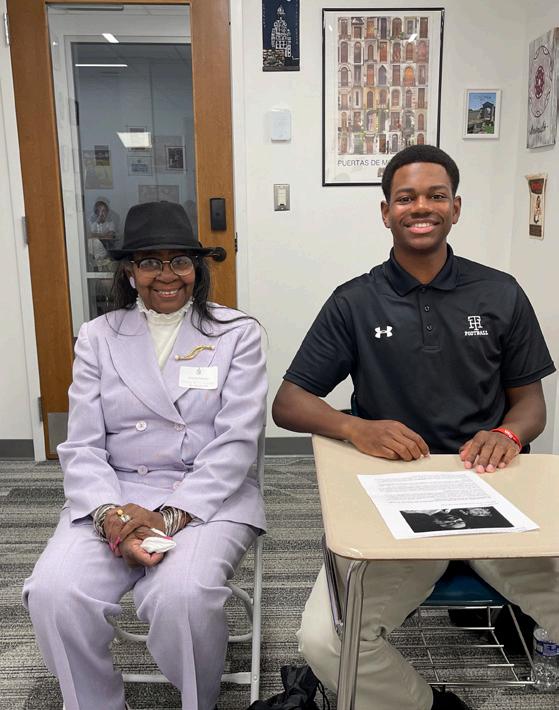
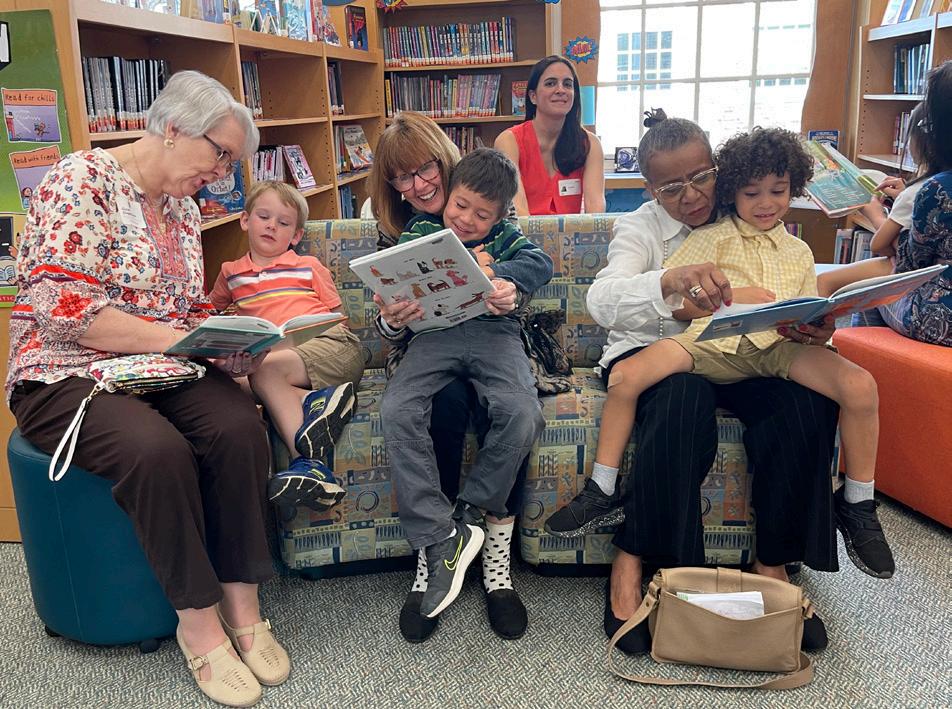
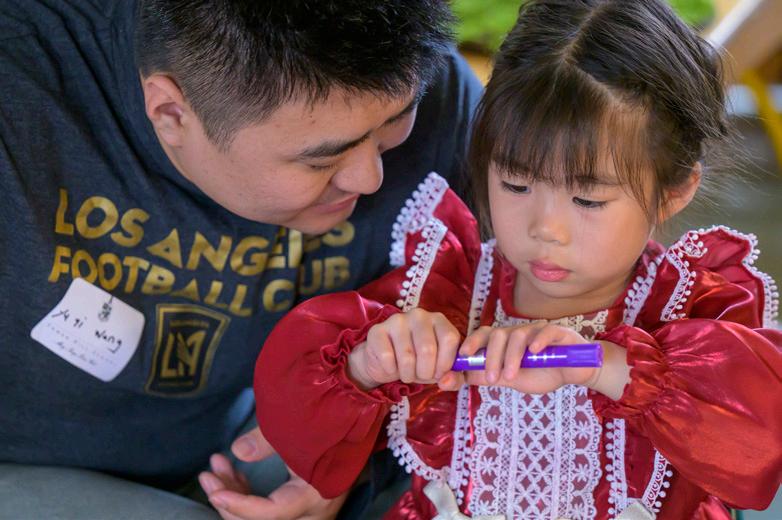
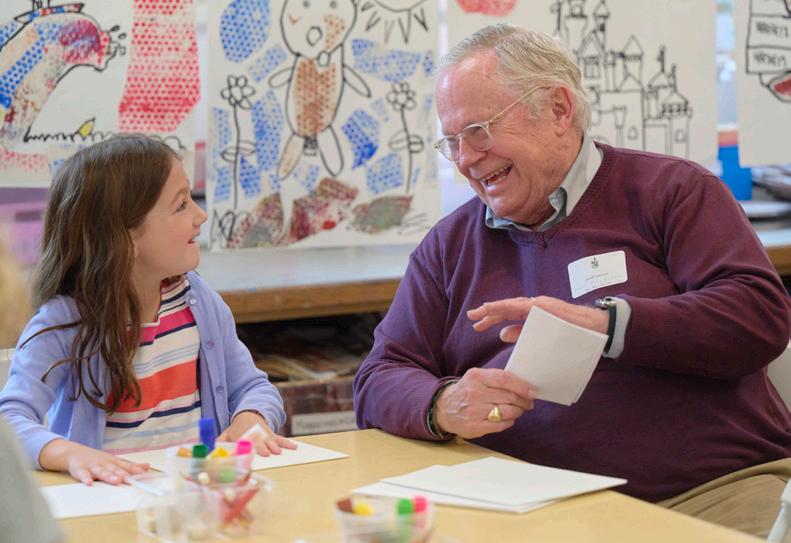
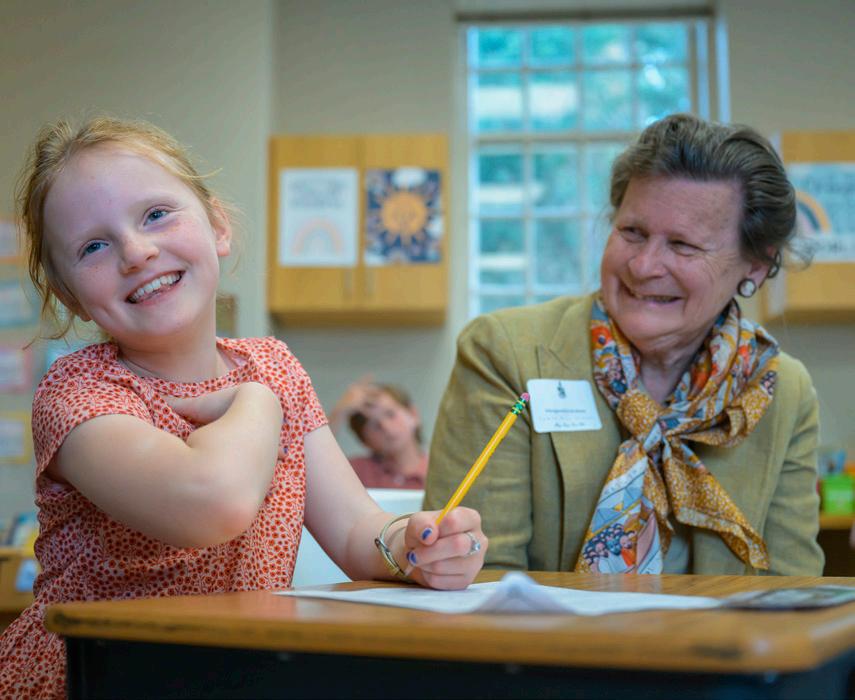
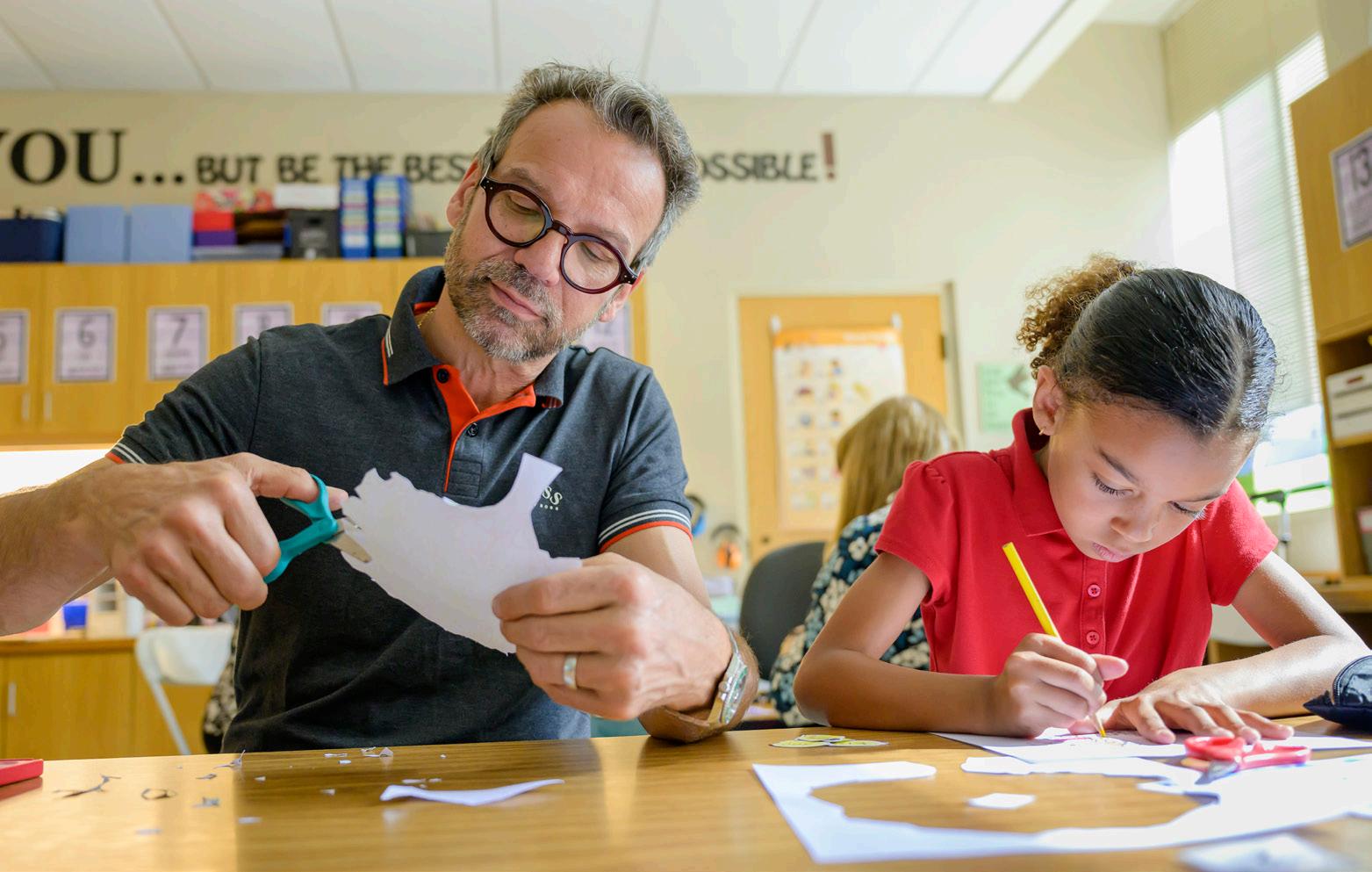
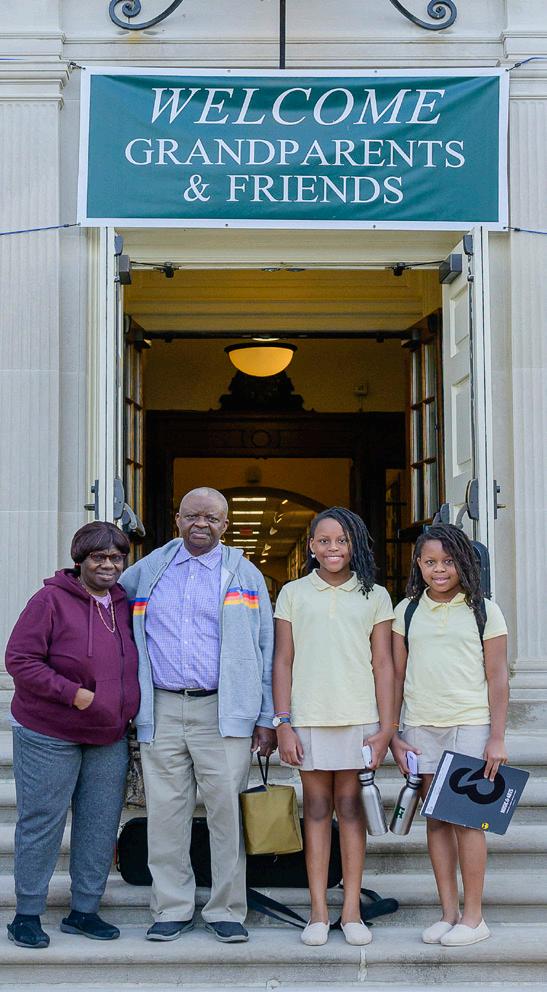
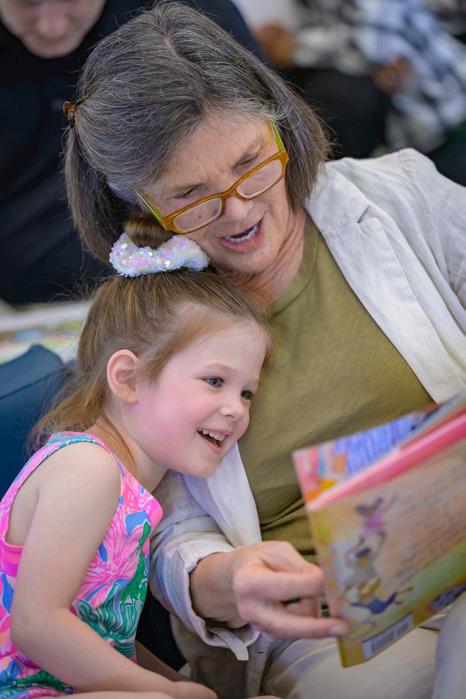
followed by musical performances and
visits.
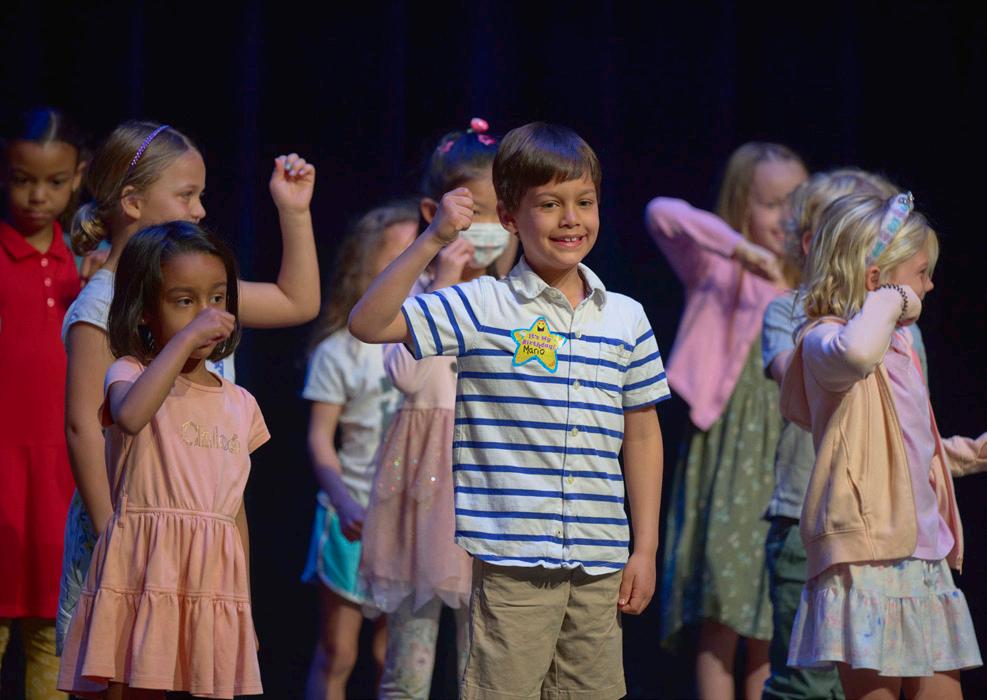
61 Tower Hill Bulletin Fall 2023
1 2 3 4 5 6 7 8 THS IN PHOTOS 9
10th Head of School Bessie Speers,
classroom
1. Addison and Allison Gisanrin ’29 pose with their grandparents. 2. Luna Chardonnet ’34 works on a project with her father. 3. Jordan Harmon ’23 with his grandmother. 4. Consie Davidson ’33 smiles with her grandmother. 5. Grandparents gathered in the Lower School library to read to their grandchildren. 6. Lower Schoolers performed for special friends in the morning. 7. Ellie Larned ’37 reads with her grandmother. 8. Lucy Sawyer ’34 in art with her grandfather. 9. Skylar King ’36 draws with her father.
TEACHER APPRECIATION WEEK
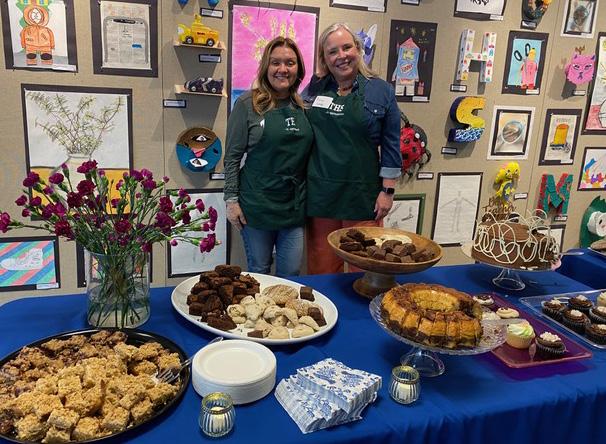
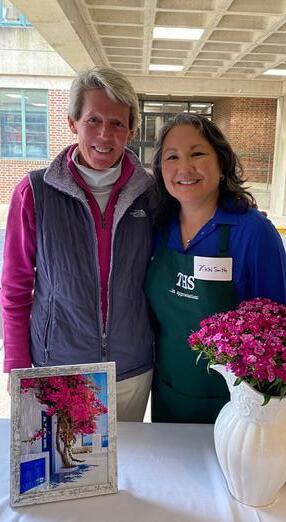
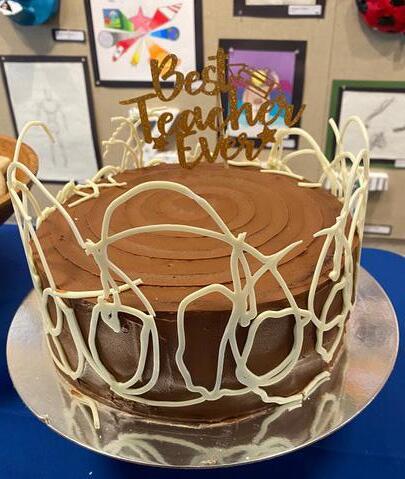
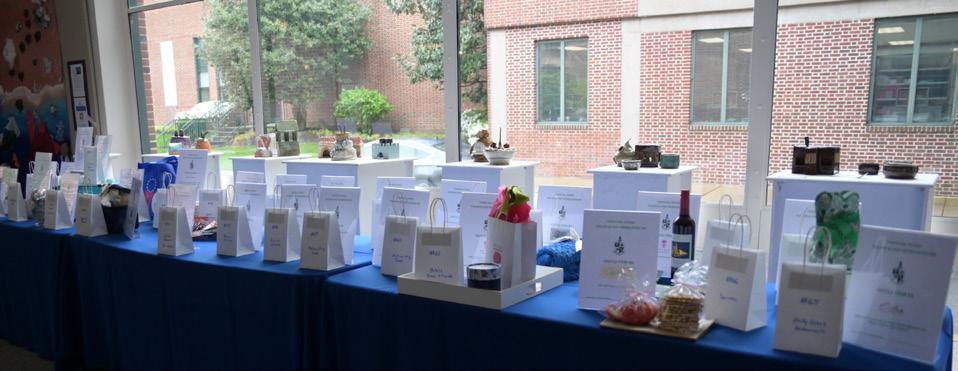
Teachers and staff were treated to a delicious, homemade lunch and raffle on behalf of Home and School in recognition of Teacher and Staff Appreciation Week in May. 1. Teachers Julie Roca-Bristowe, Ashley Gillerlain and CiCi Cai enjoy the delicious Mediterranean food. 2. There was an amazing spread of desserts including a Best Teacher Ever cake. 3. Vice President (and 2023-2024 President) Yvonne Deadwyler and Tracy Long help with the event. 4. (L-R): Laurie Edinger, Jill Zehner, Jen Houston, Kathryn Reese and Cherie Martinez enjoy lunch together. 5. There was an amazing assortment of generously donated raffle items. 6. Parent volunteer Myungee Geerts runs the faculty and staff games. 7. Teacher Kathy Franklin and
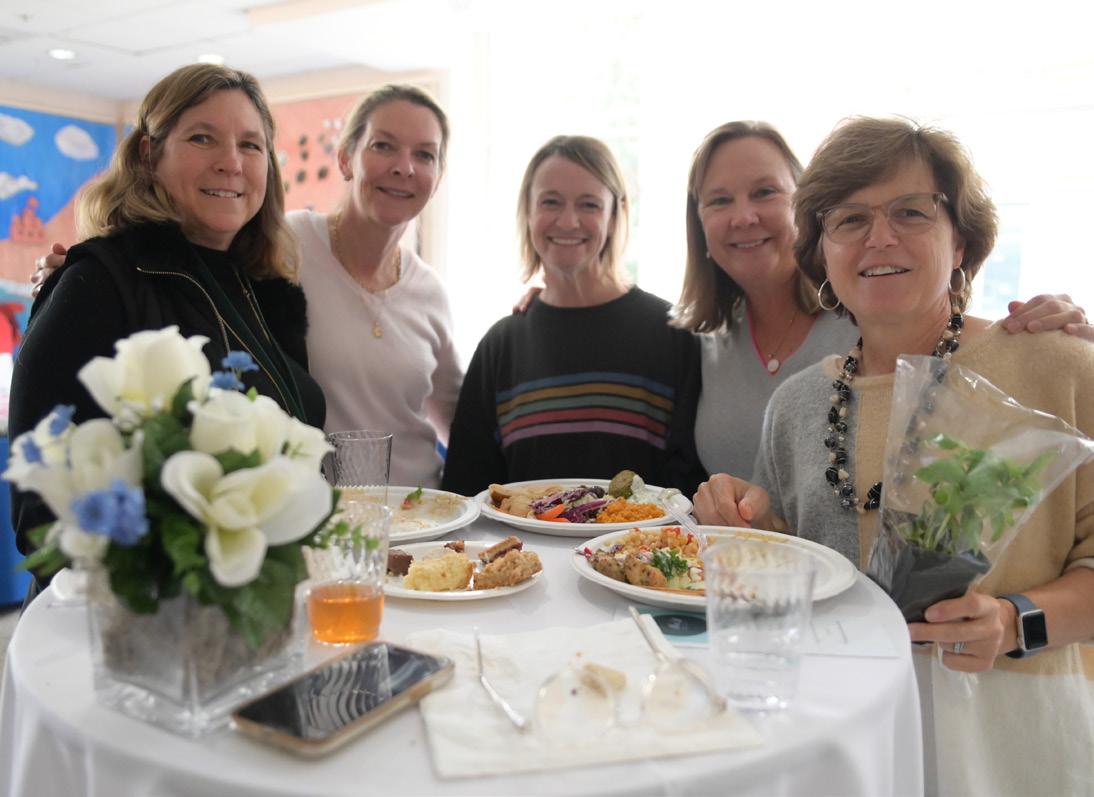
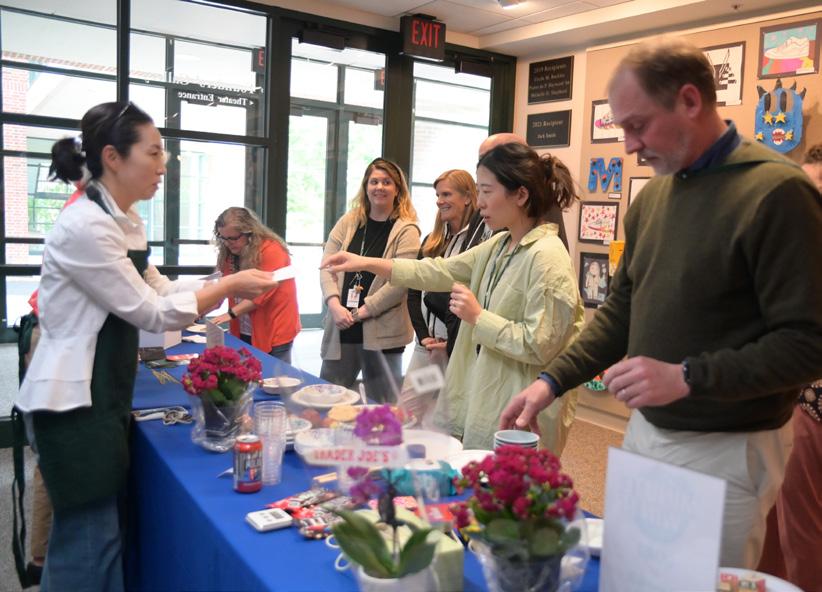
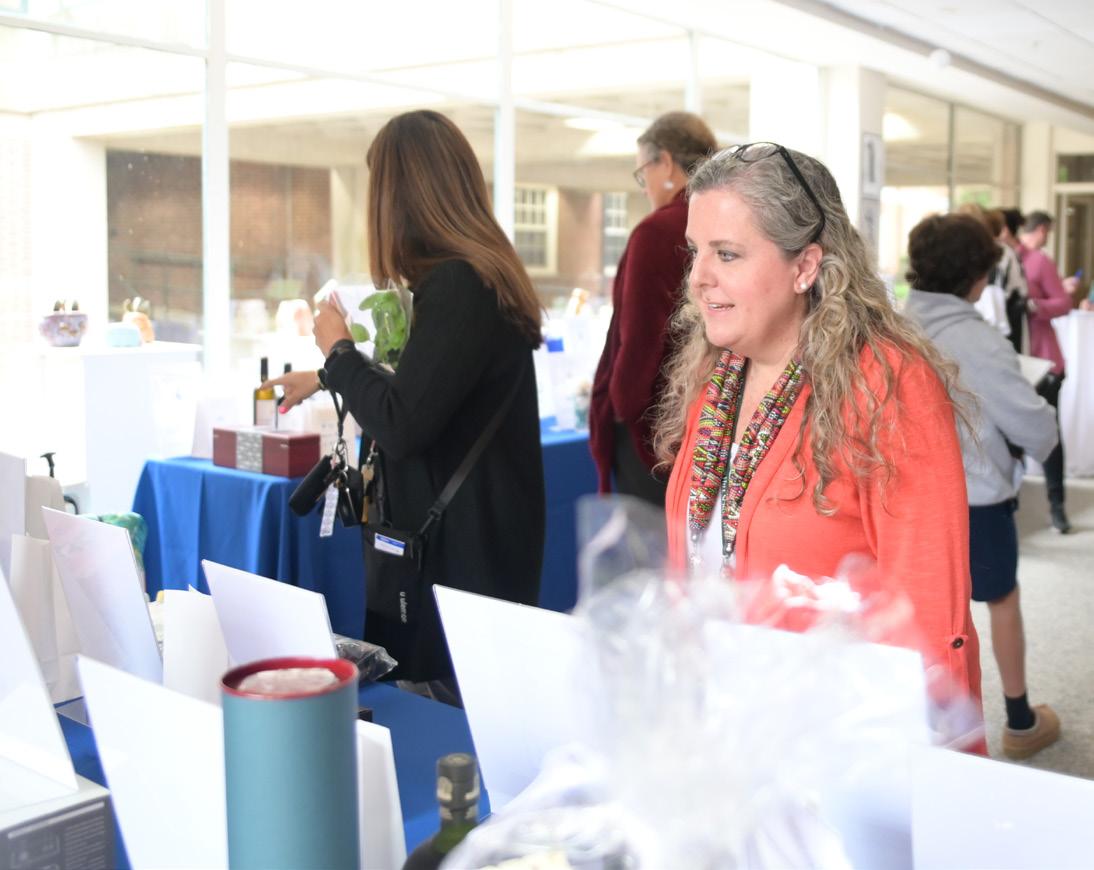
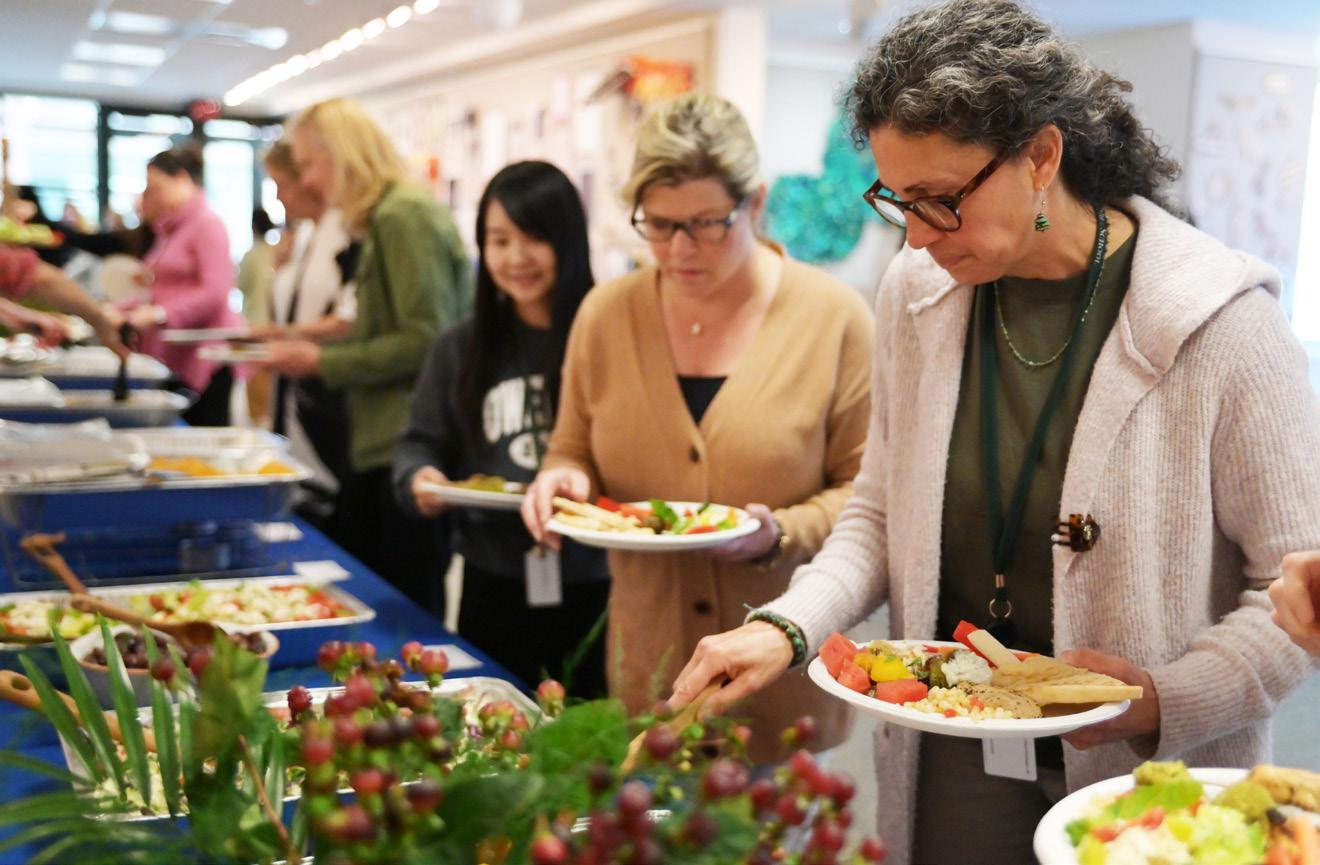
62 Tower Hill Bulletin Fall 2023
5
1 2 3 4 7 6 8
President Vikki Smith. 8. Lindsay Owen checks out the raffle items.
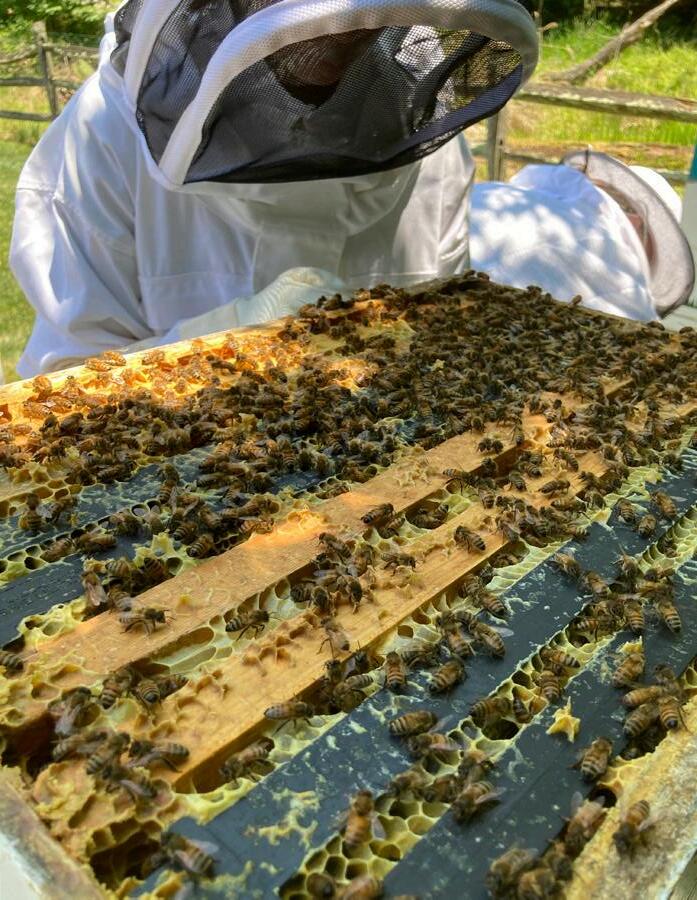
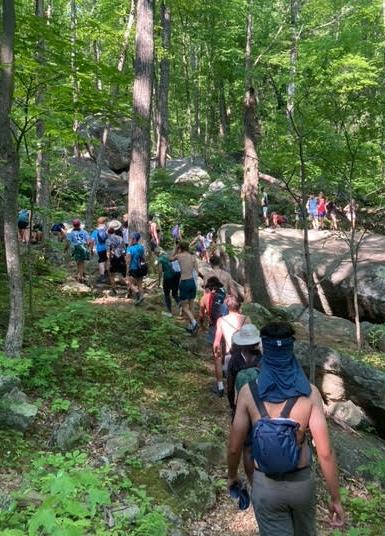
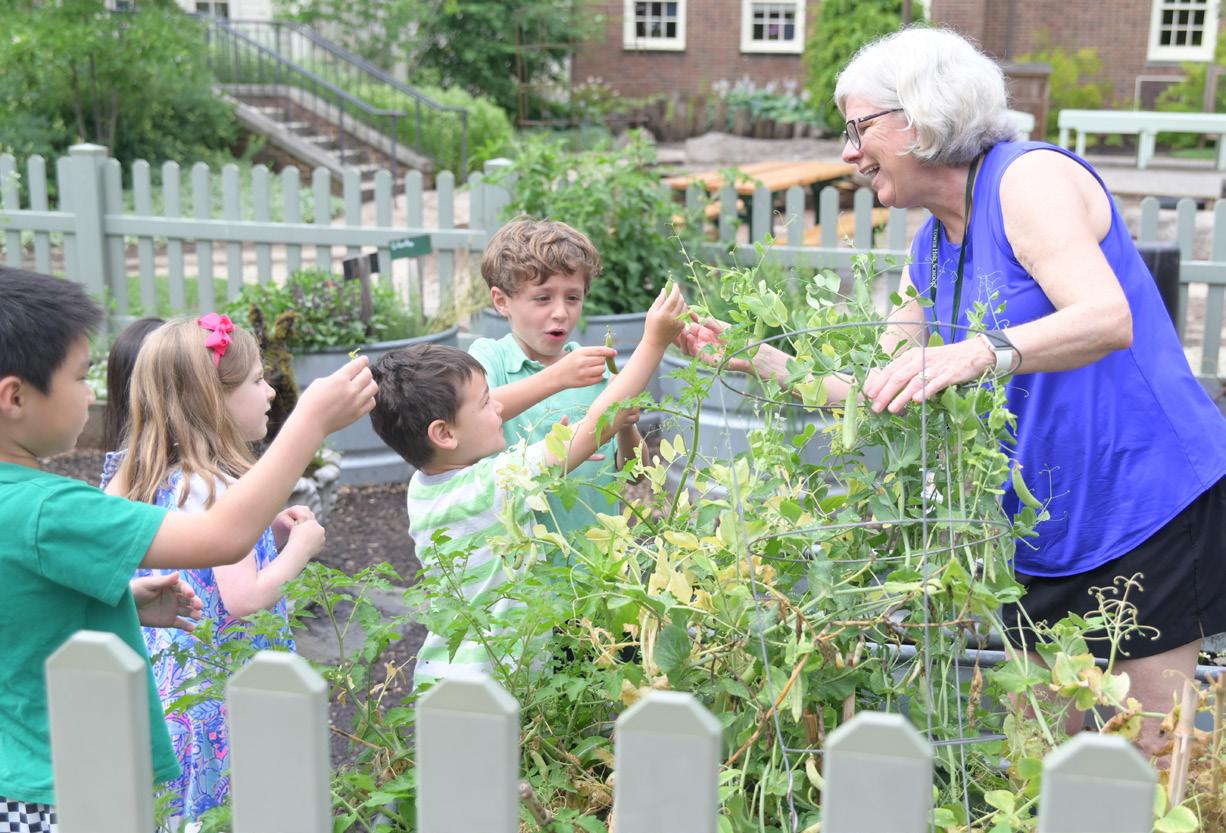
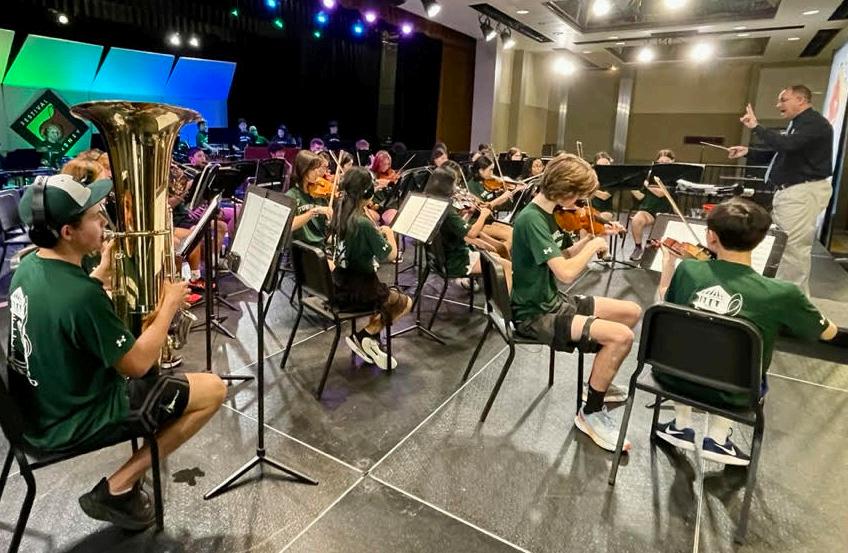
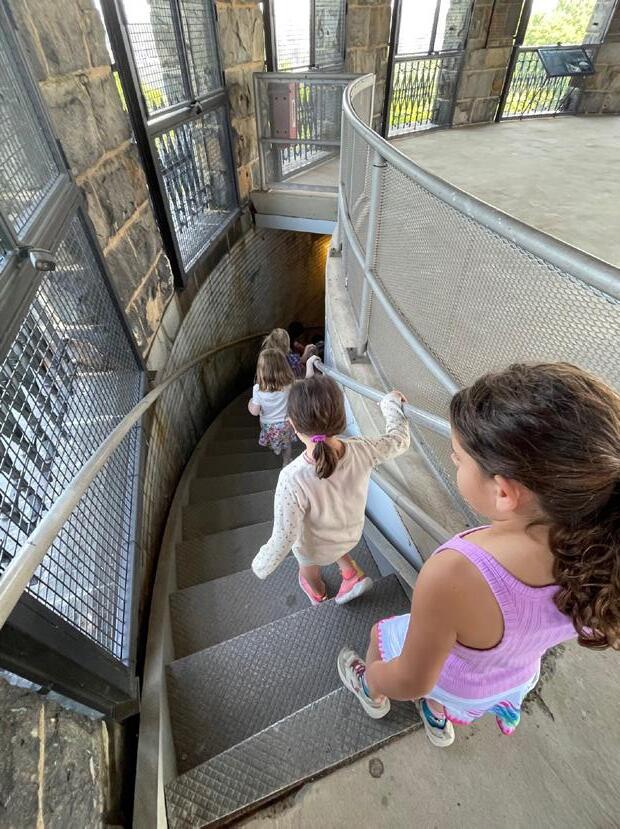
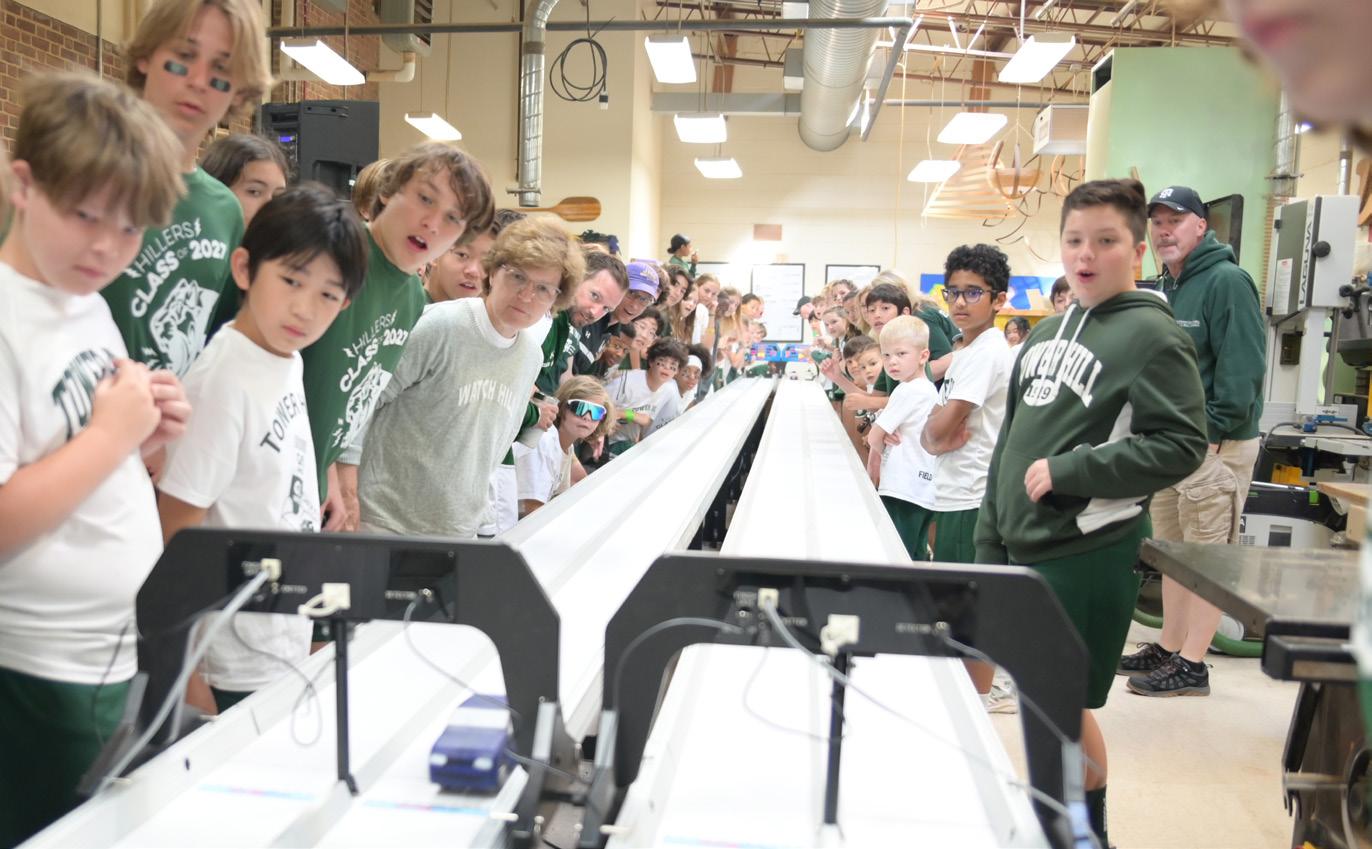
63 Tower Hill Bulletin Fall 2023 EXPERIENTIAL
THS IN PHOTOS
LEARNING
1. Students study the Tower Hill apiary during the Tower Term course Life Among the Bees. 2. Students participate in a Soundtrack Session Workshop with a Disney conductor in Orlando, Fla. 3. A Tower Hill tradition, seventh grade woodworkers crafted vehicles of all sorts that rocketed down the track with fanfare from all grades. 4. A large group of Upper School students went backpacking in Shenandoah. 5. Jeannie Snyder gardens with Lower School students in the Experiential Outdoor Classroom. 6. Kindergartners visit Rockford Tower to learn about its history.
1
2 3 4 5 6
THE ARTS
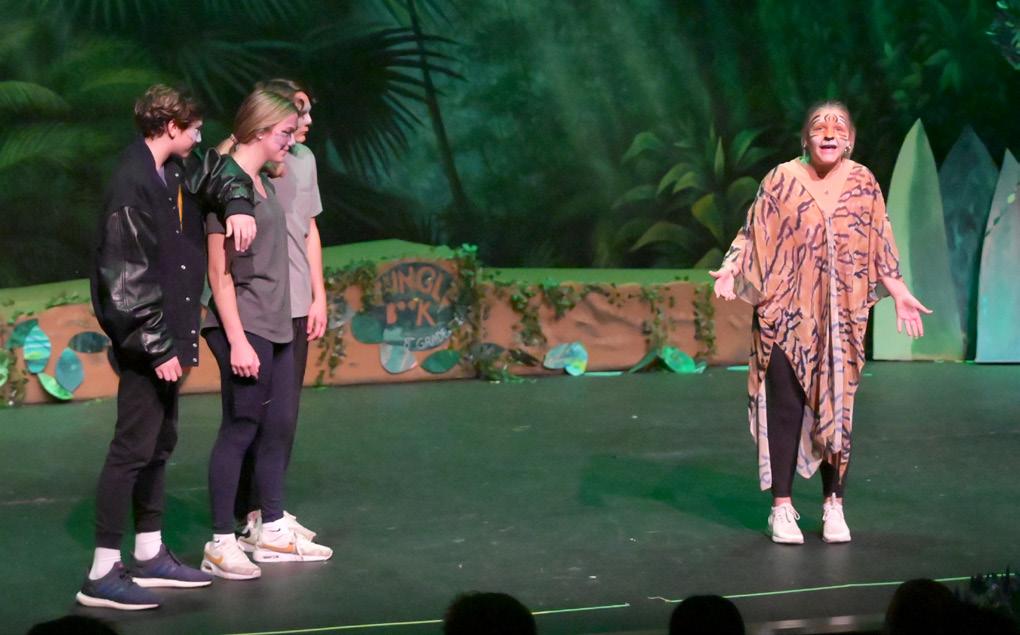
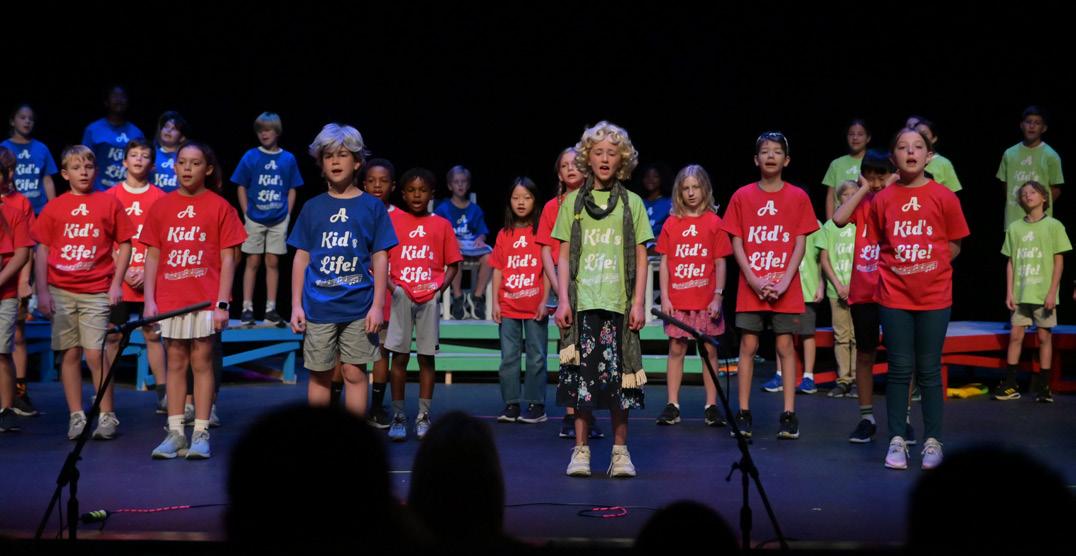
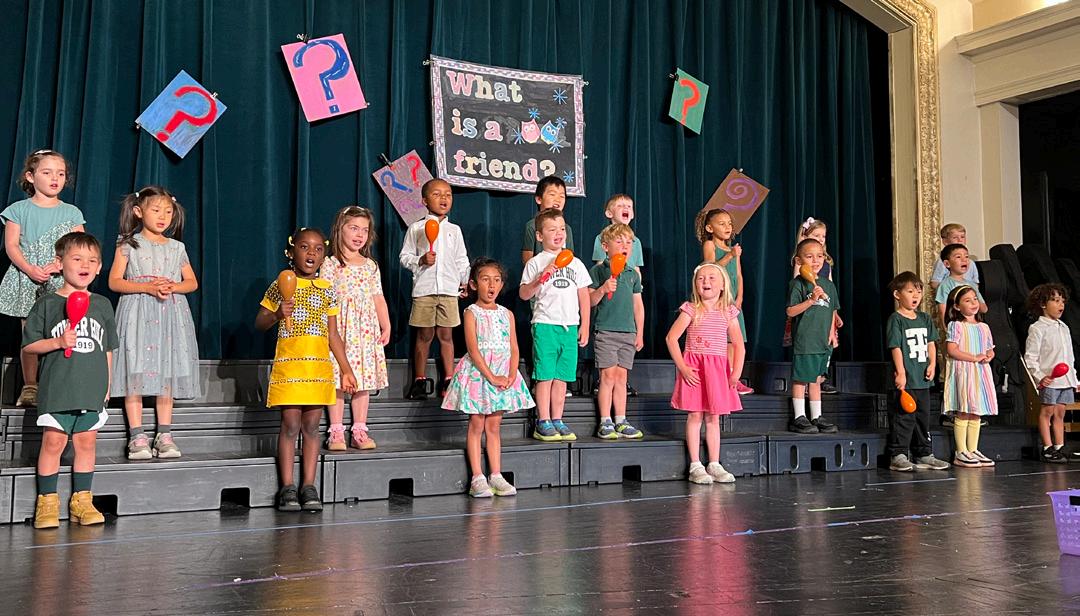
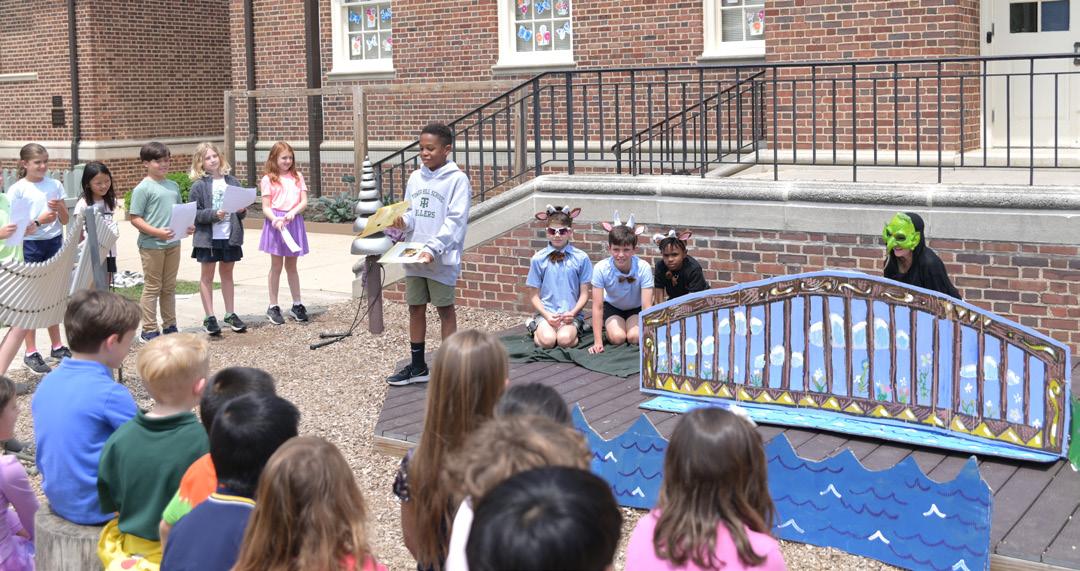
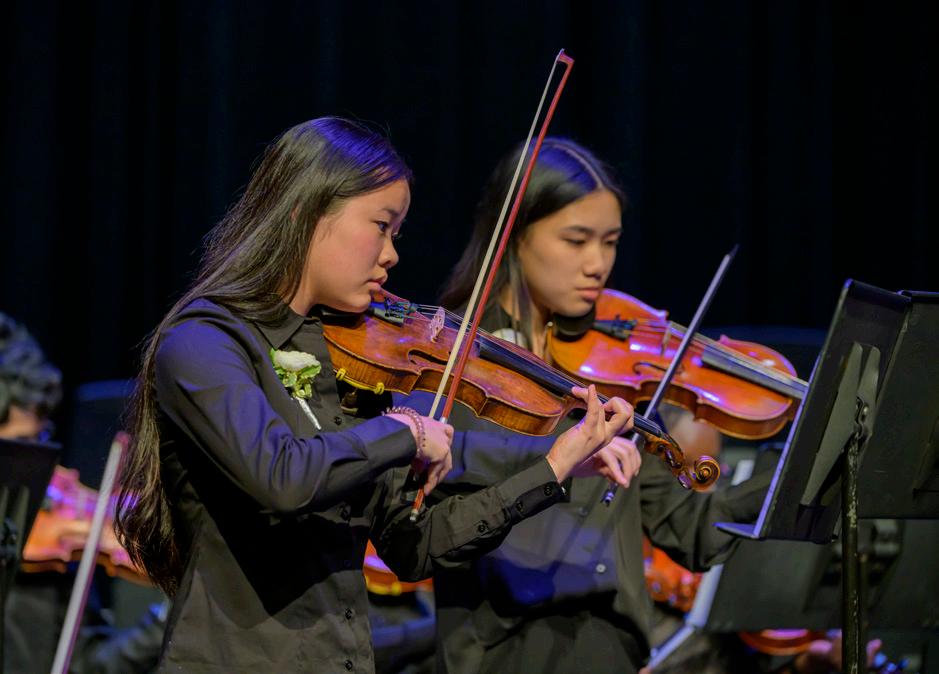

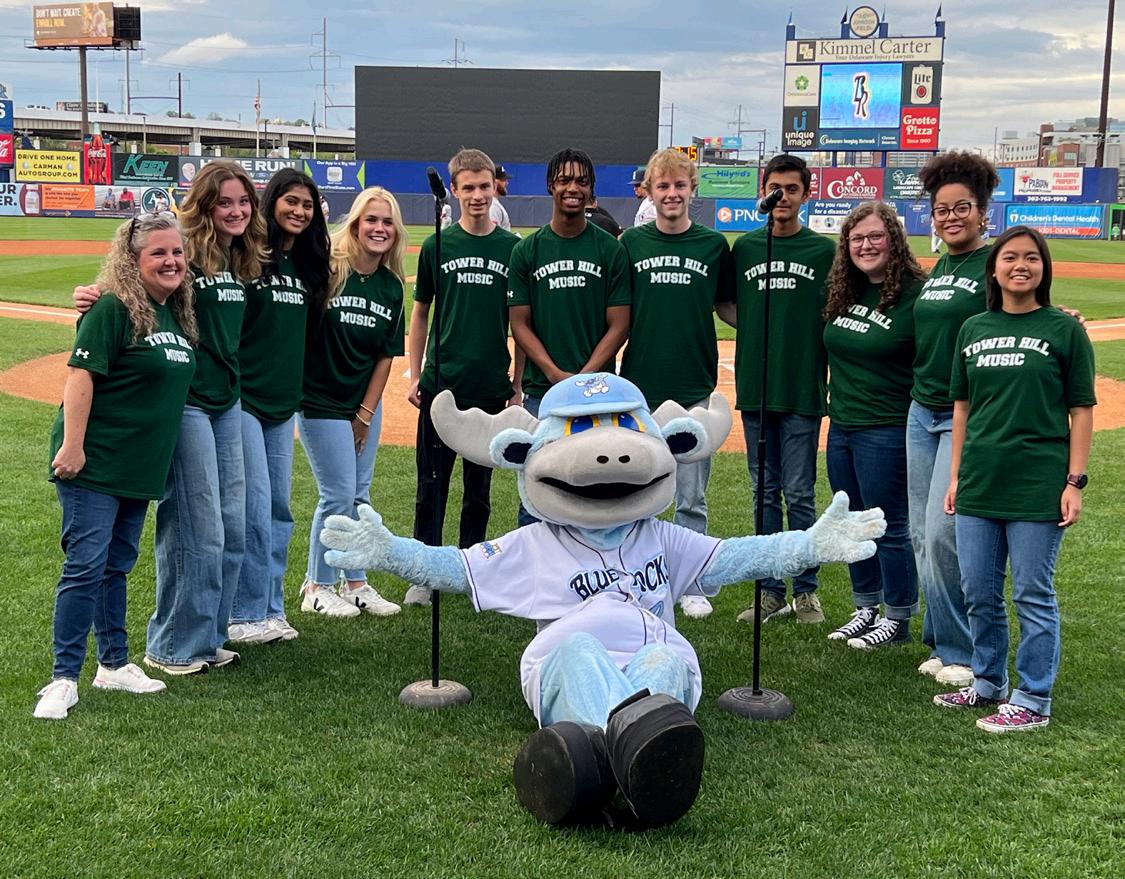
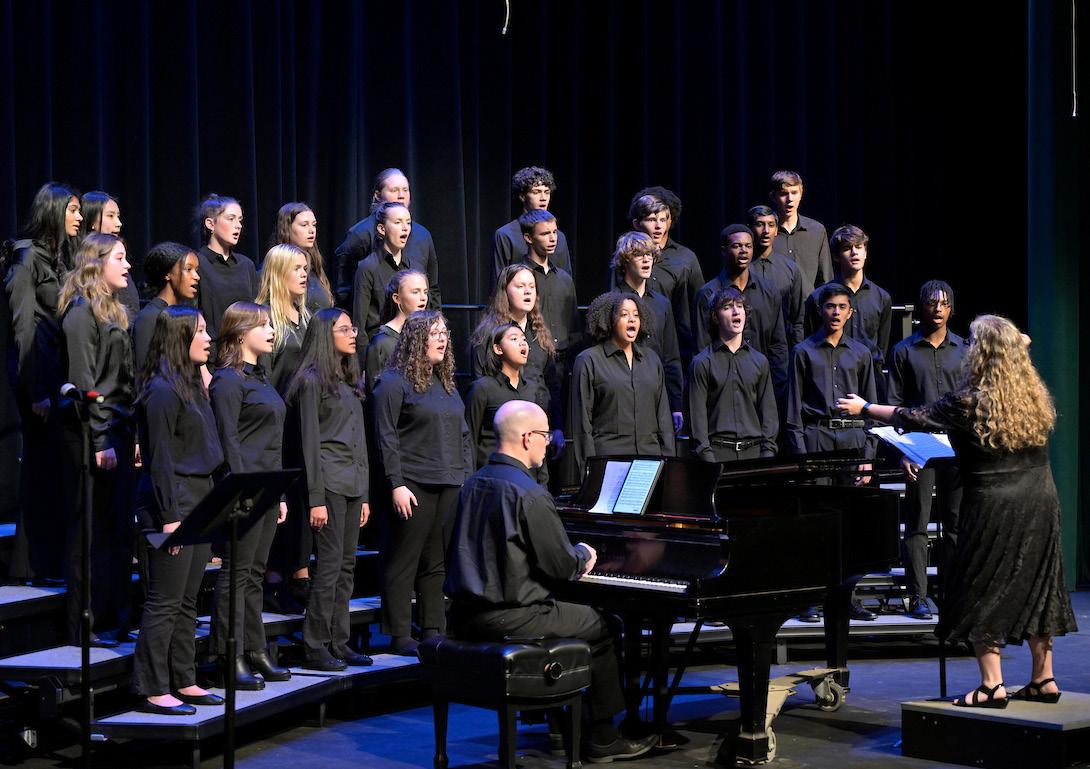
1 2 3 4 5 6 7 8
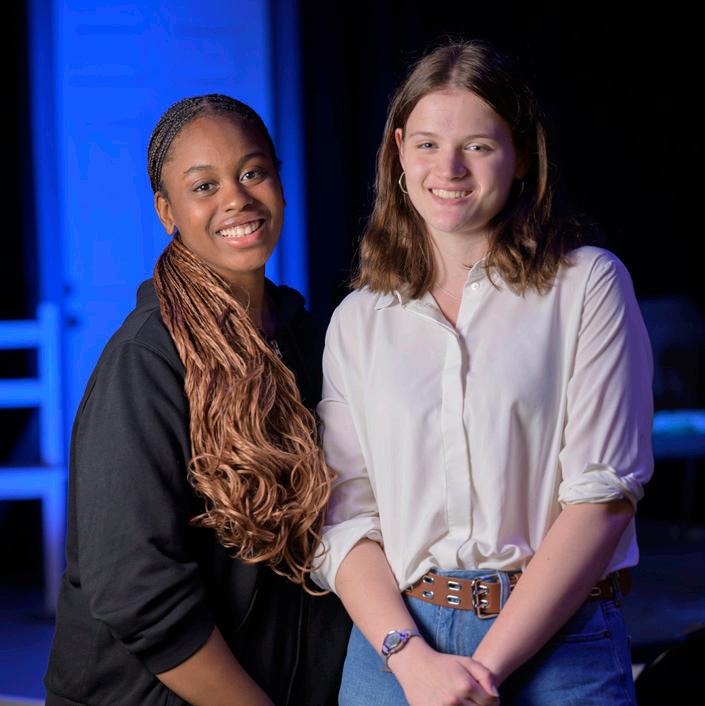
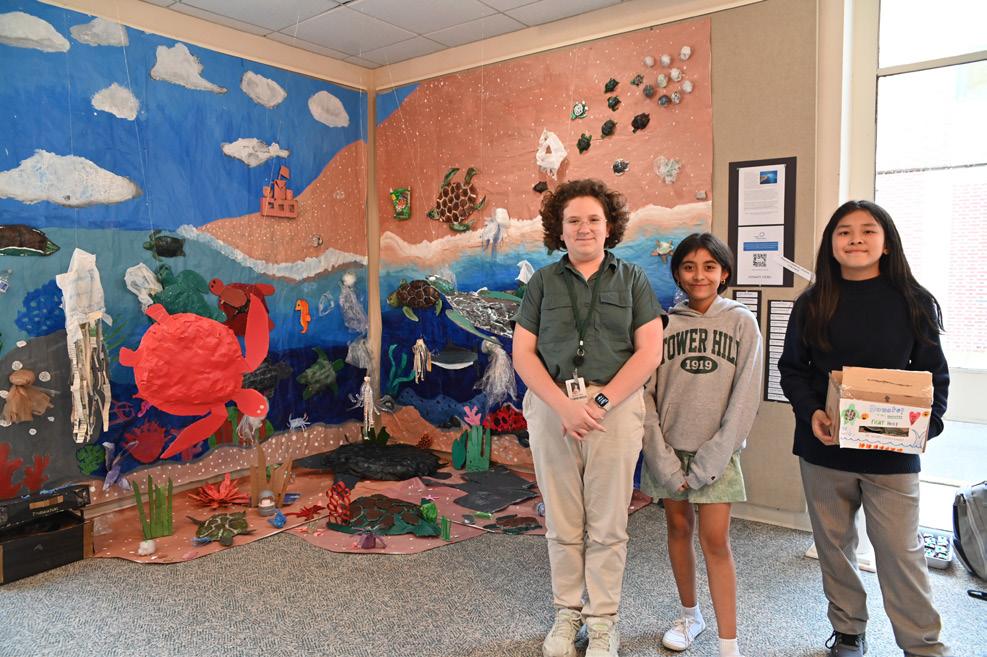
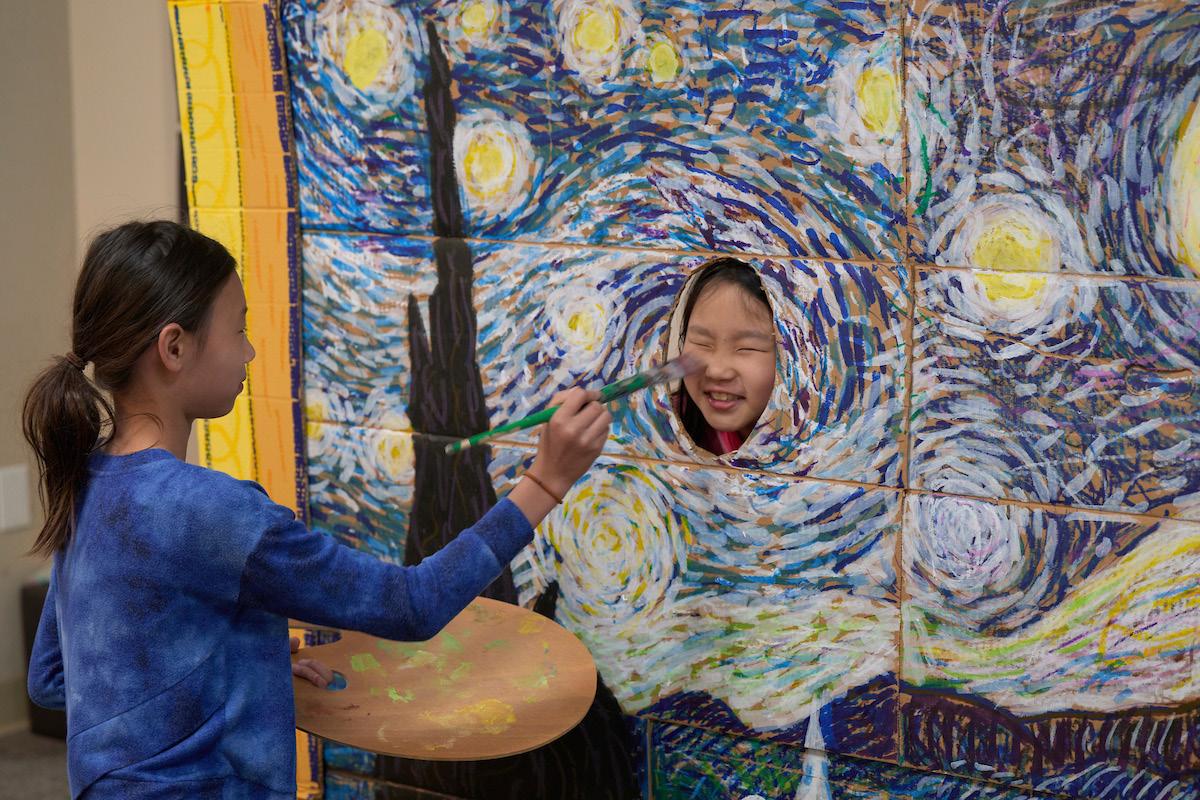
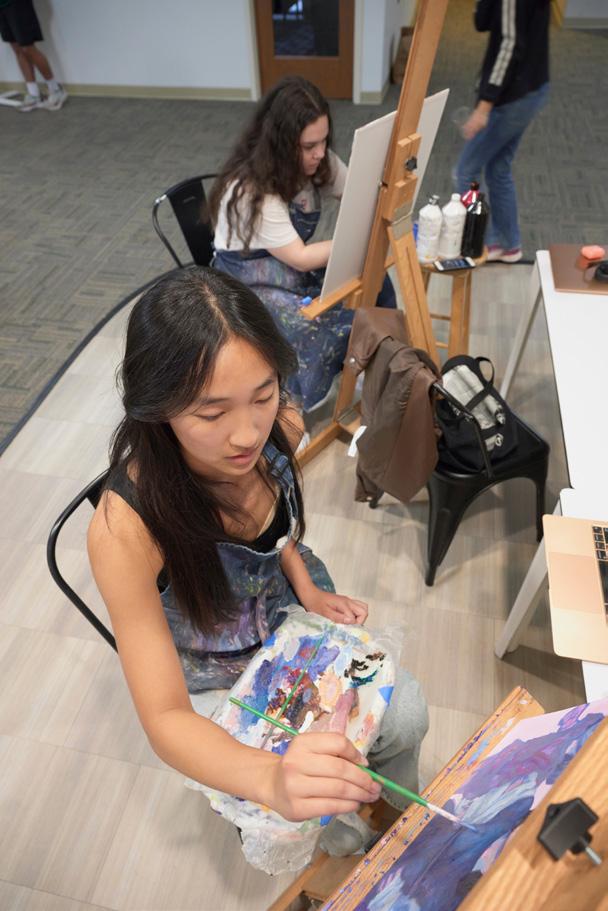
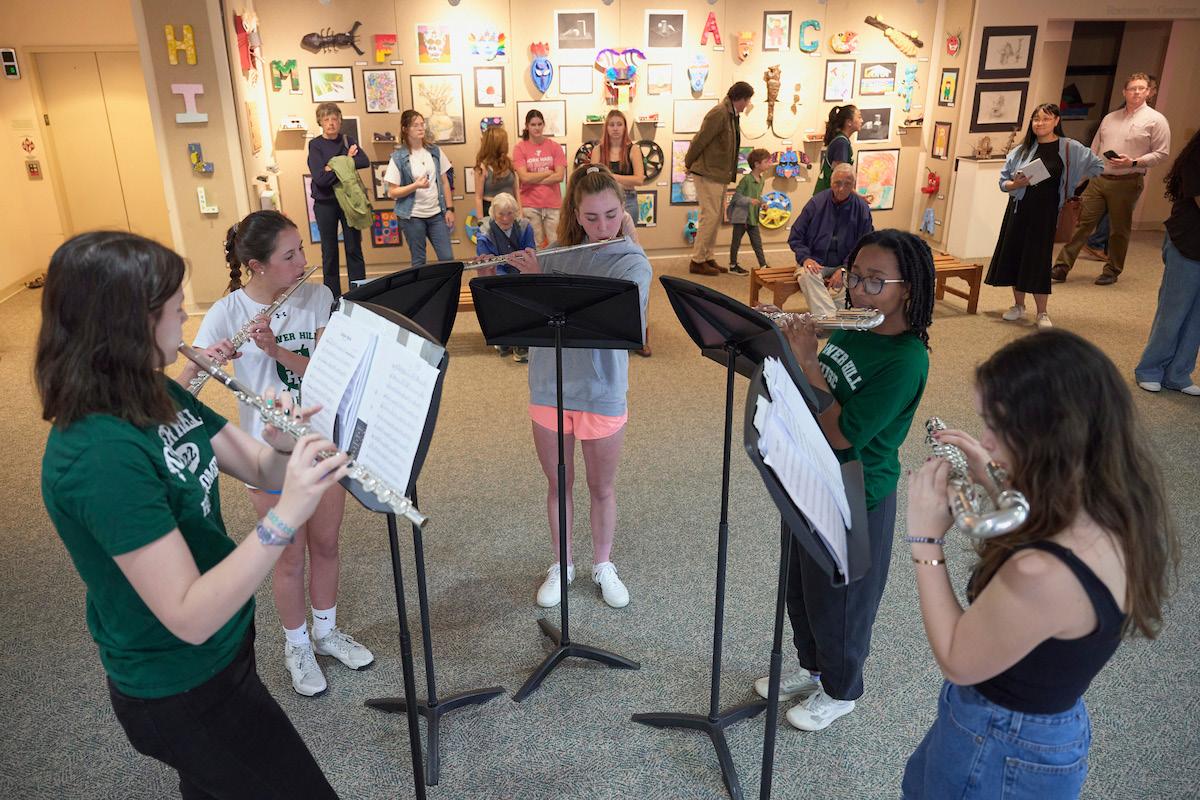
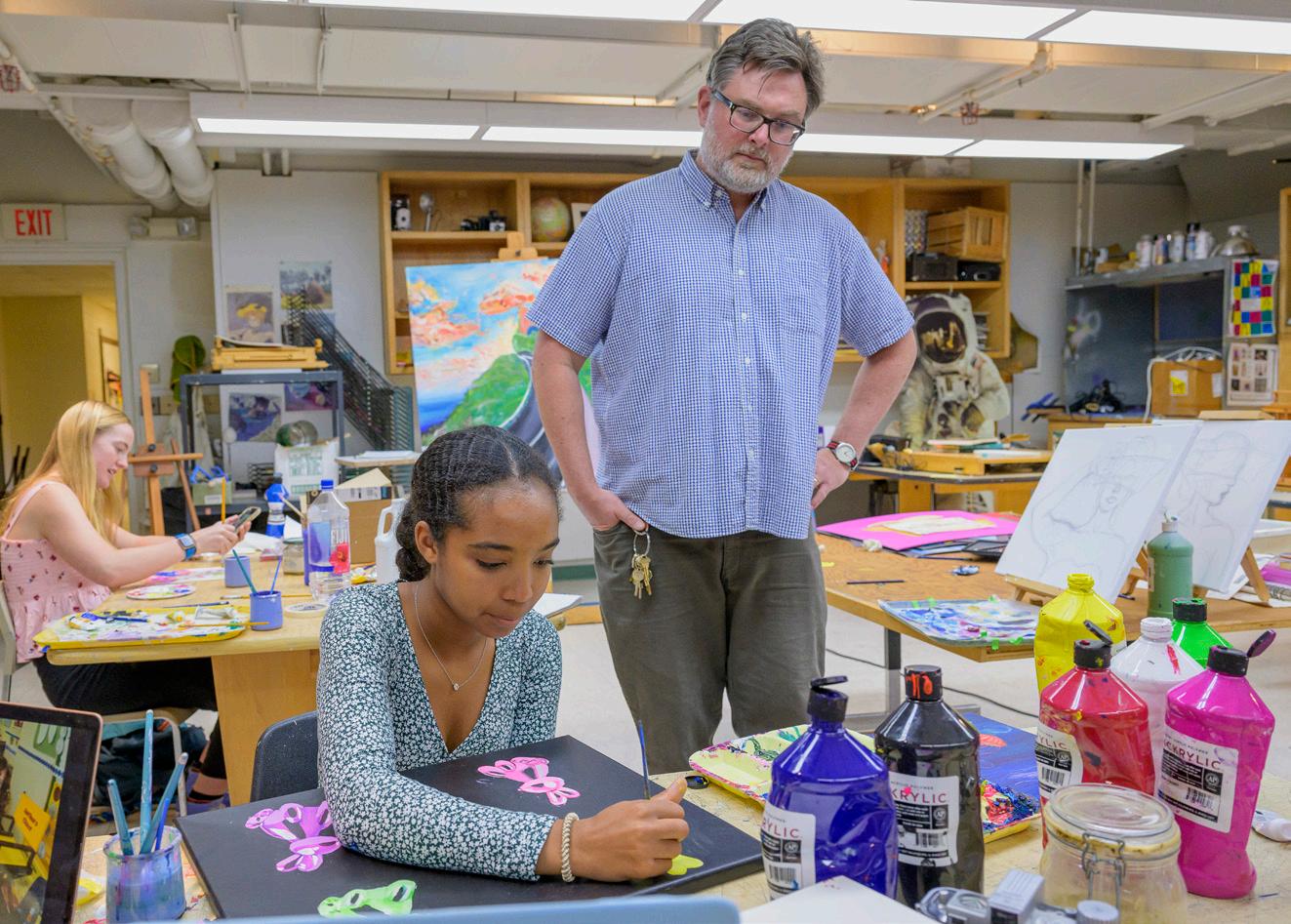
65 Tower Hill Bulletin Fall 2023
THS IN PHOTOS
THE ARTS
1. The spring band concert. 2. The spring chorus concert. 3. The spring orchestra concert. 4. Fourth graders perform the Three Billy Goats Gruff.
5. The Vocal Ensemble sang the National Anthem at the Wilmington Blue Rocks’ game this spring. 6. 4th grade show. 7. 8th grade play. 8. Pre-K
9 10
11 12
13 14 performance. 9. Two students try out an installation at the Evening of the Arts (EoA). 10. Katherine Niu ’24 painting during EoA. 11. Middle Schoolers created a sea turtle installation at EoA that raised money for conservation. 12. Flautists perform during EoA. 13. Seniors Emani Larkin (L) and Katie Saunders (R) directed the play Proof this spring. 14. Art Department Chair John Bartlett observes Isabela McIntosh ’24 working on her art.
101ST FIELD DAY
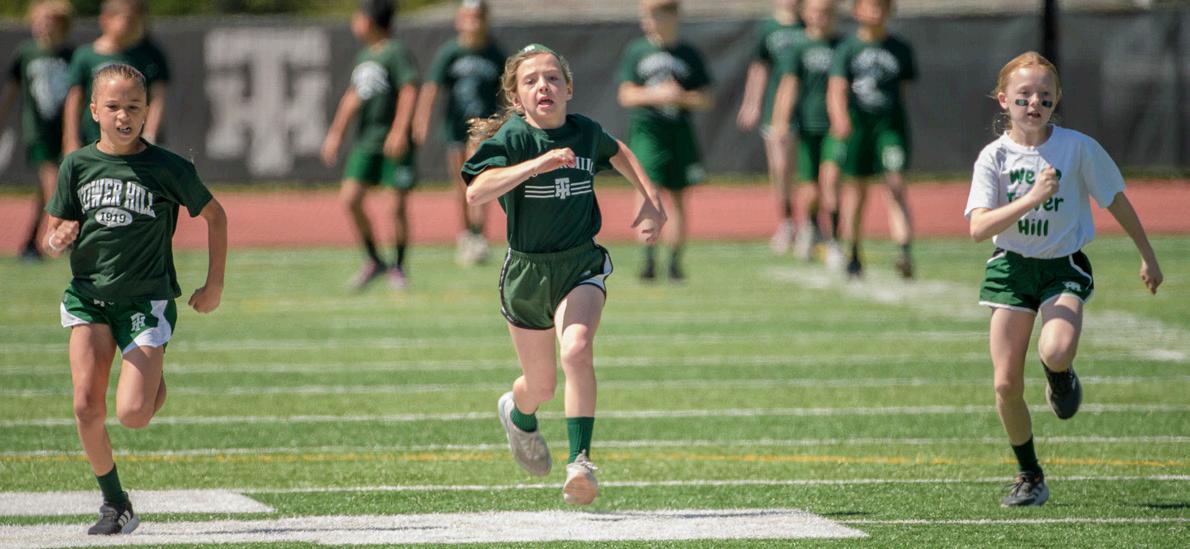
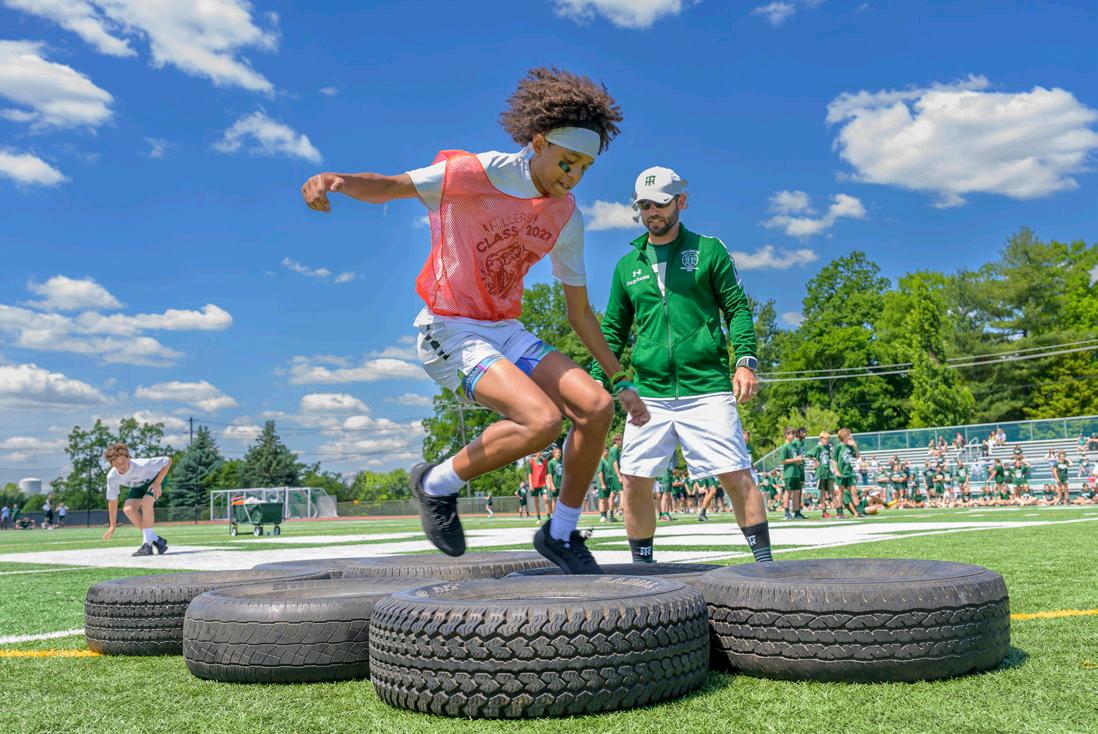

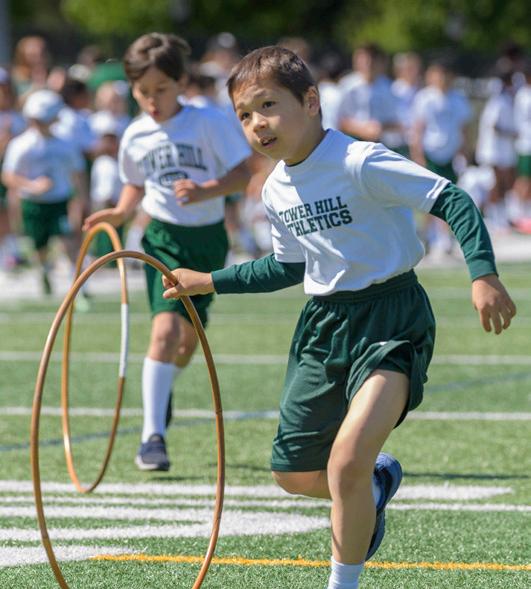
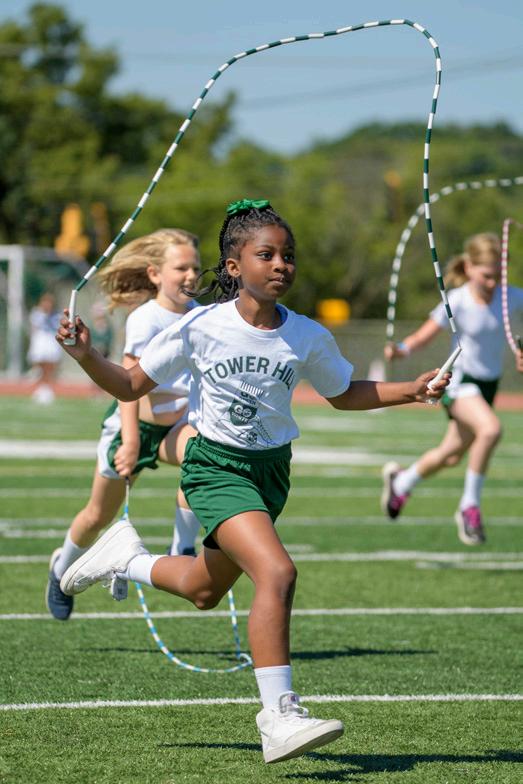
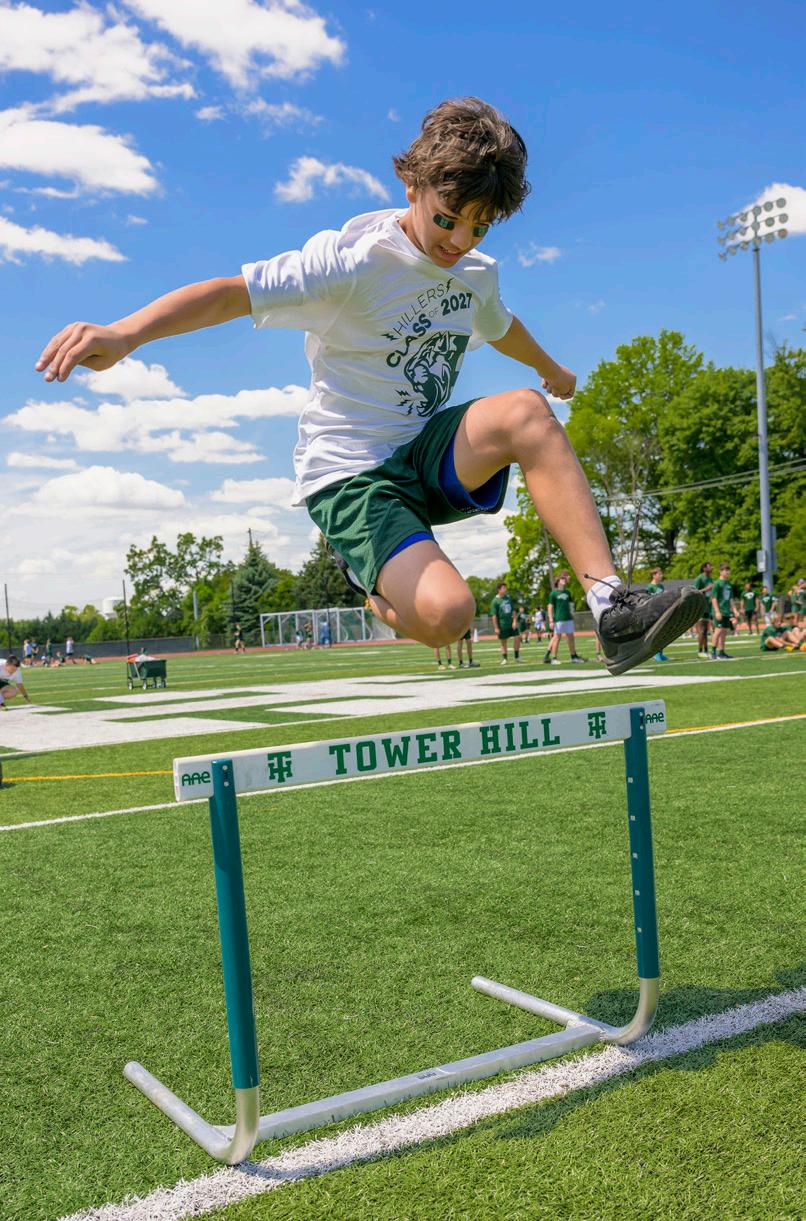
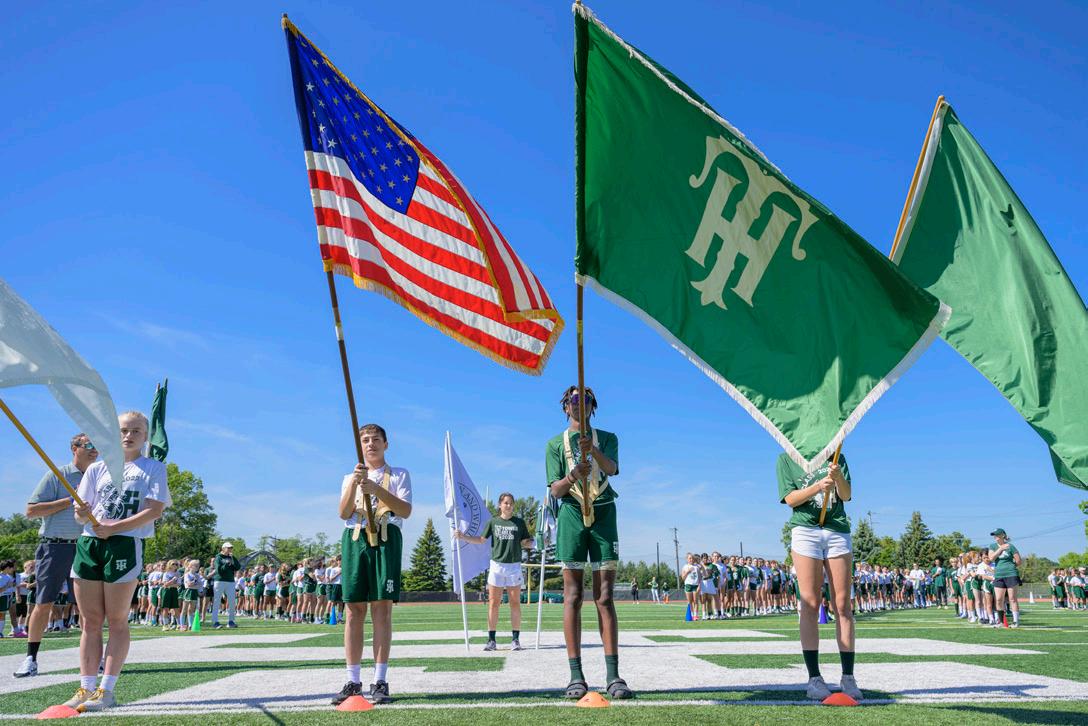
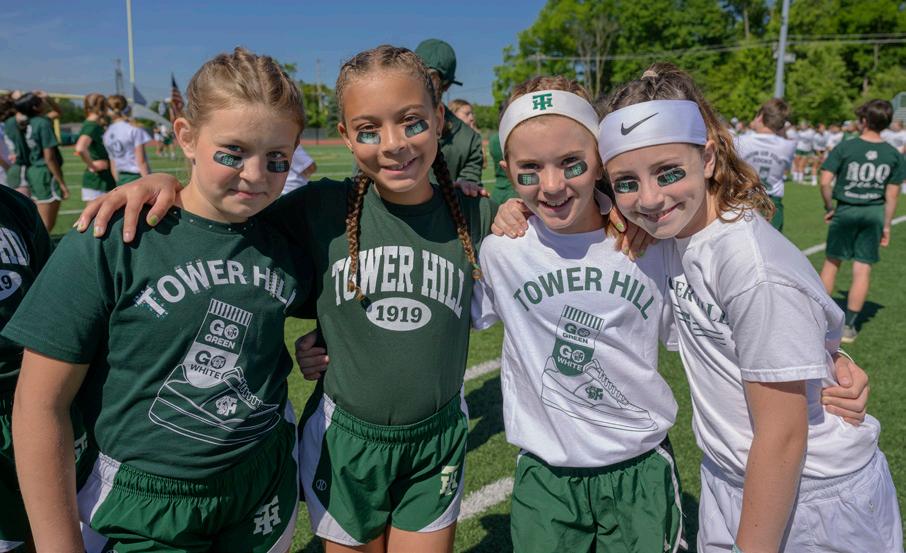


1 2 3 4 5 6 7 8
1. Chandan Chakravertti ’27 jumps the hurdles. 2. Eighth graders Isabelle Daniel, Eli Browne, Jamar Taylor and Hailey Allen carry the flags with pride. 3. Third graders Saige Saull, Cady Buonocore and Flynne McAndrew run the dashes. 4. Jaden Deadwyler ’27 in the Obstacle Relay while Patrick Kaiser ’02 supervises. 5. Kendall Thompson ’33 runs the Jump Roap Race. 6. A time lapse photo of a student rushing to Carry the Colors 7. Fifth grade friends enjoy the day. 8. Victor Bai ’34 in the Rolling Hoop Race.

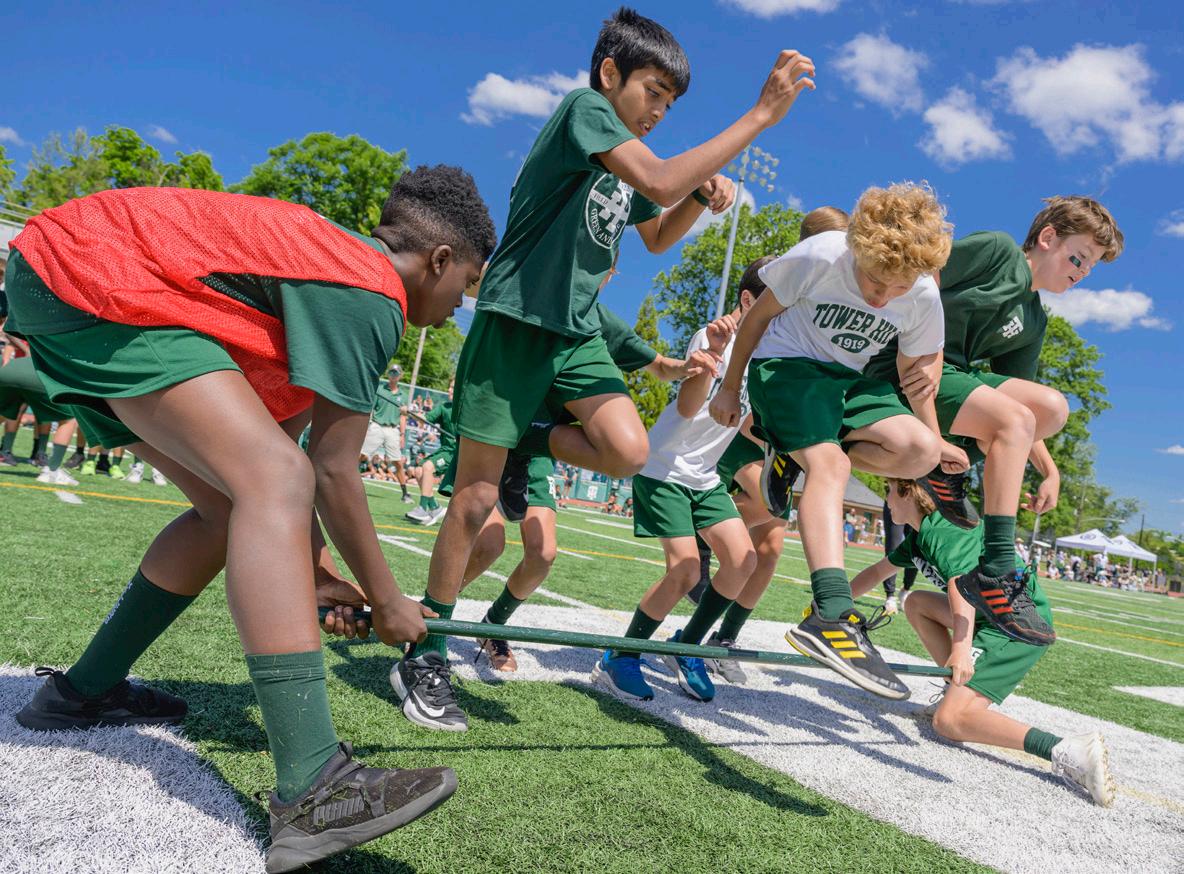
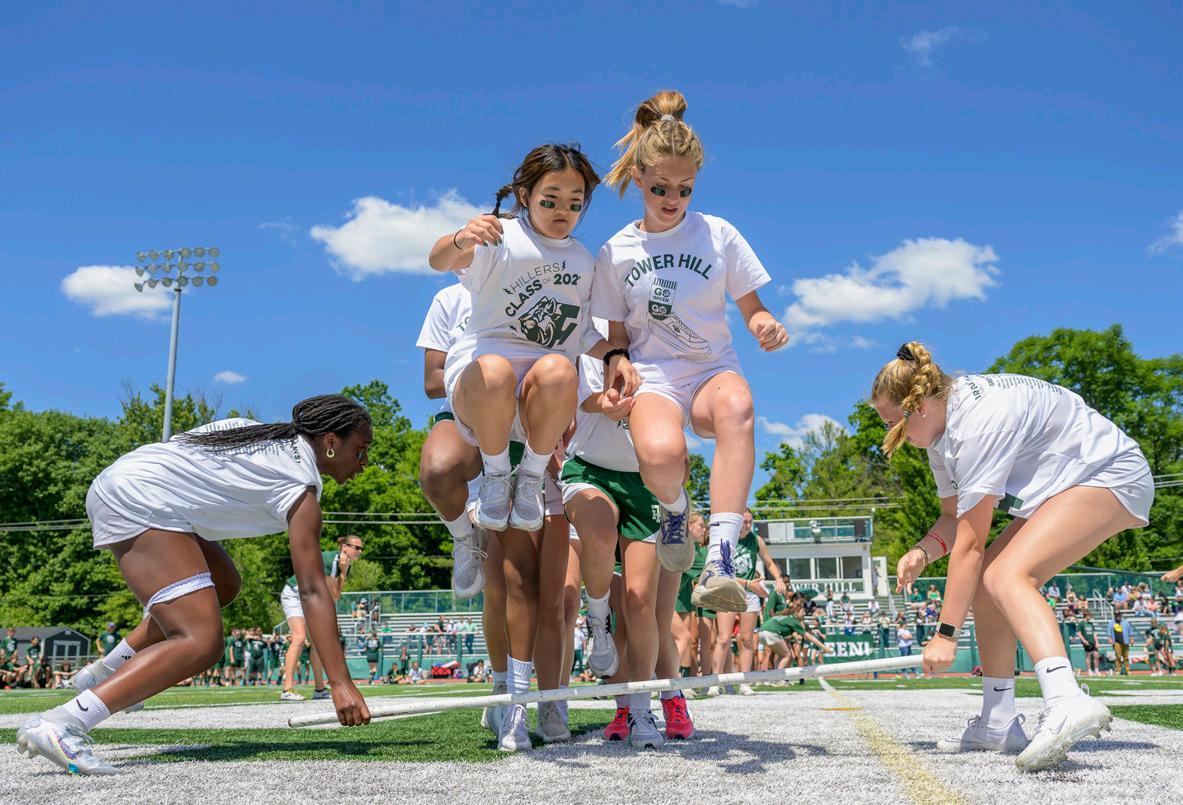
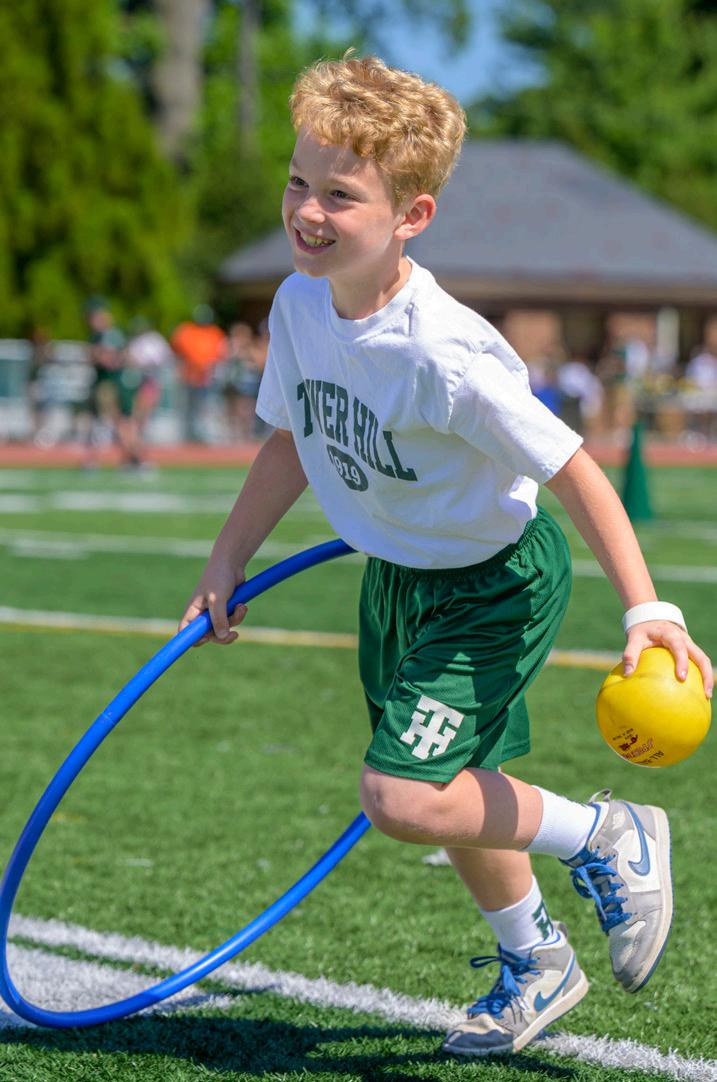
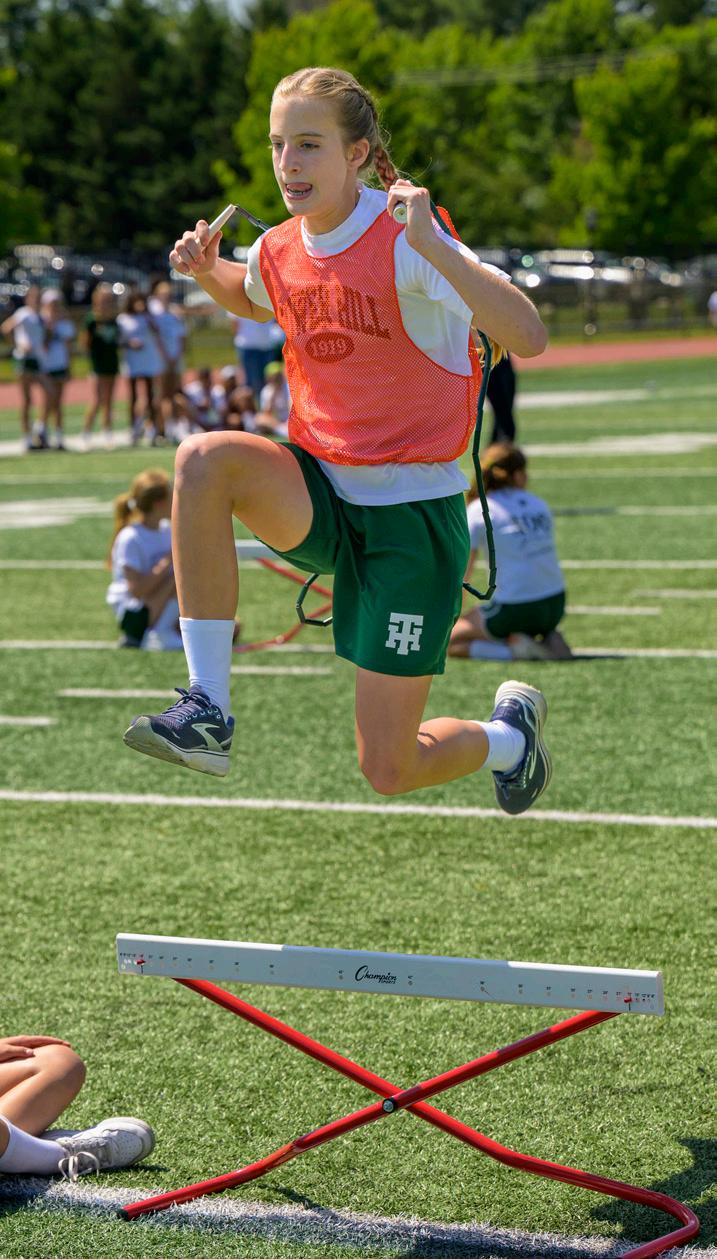
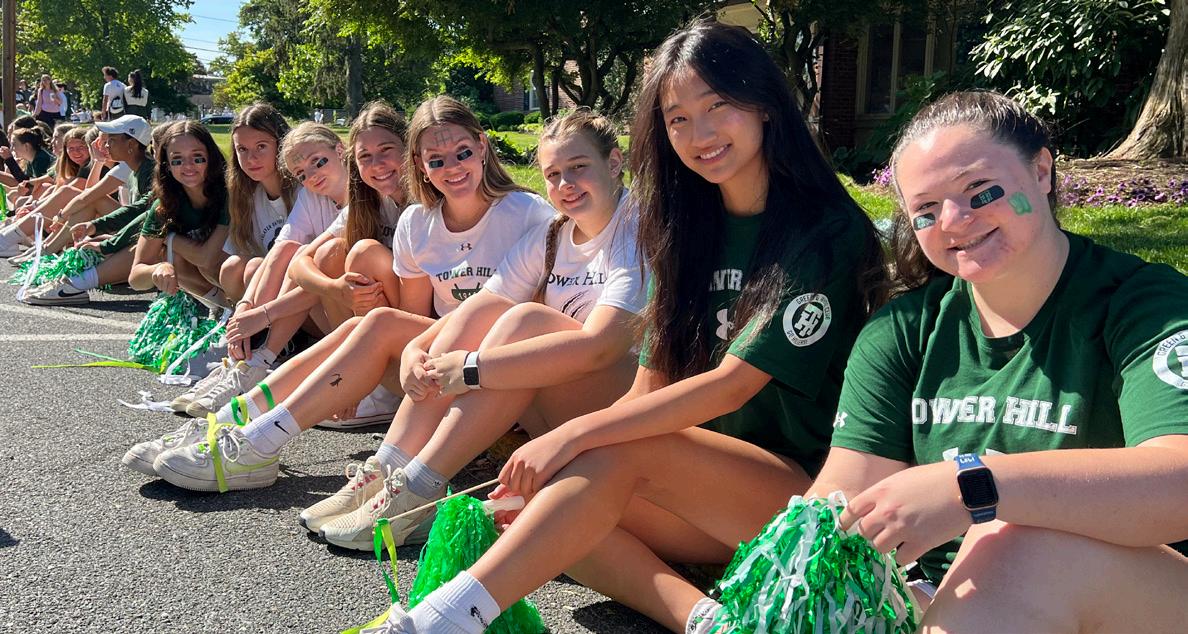

THS IN PHOTOS
1 2 3 4 5
1. The girls White Team completes in the Pole Relay. 2. Mark D’Emilio ’32 works hard at the 12-Hoop Ball Relay. 3. The boys Green Team completes in the Pole Relay. 4. Vivienne Daniel ’29 jumps in the Hurdle Jump Rope Race. 5. Upper Schoolers cheer on the Middle and Lower Schoolers as they march into the stadium.
Campus Improvements
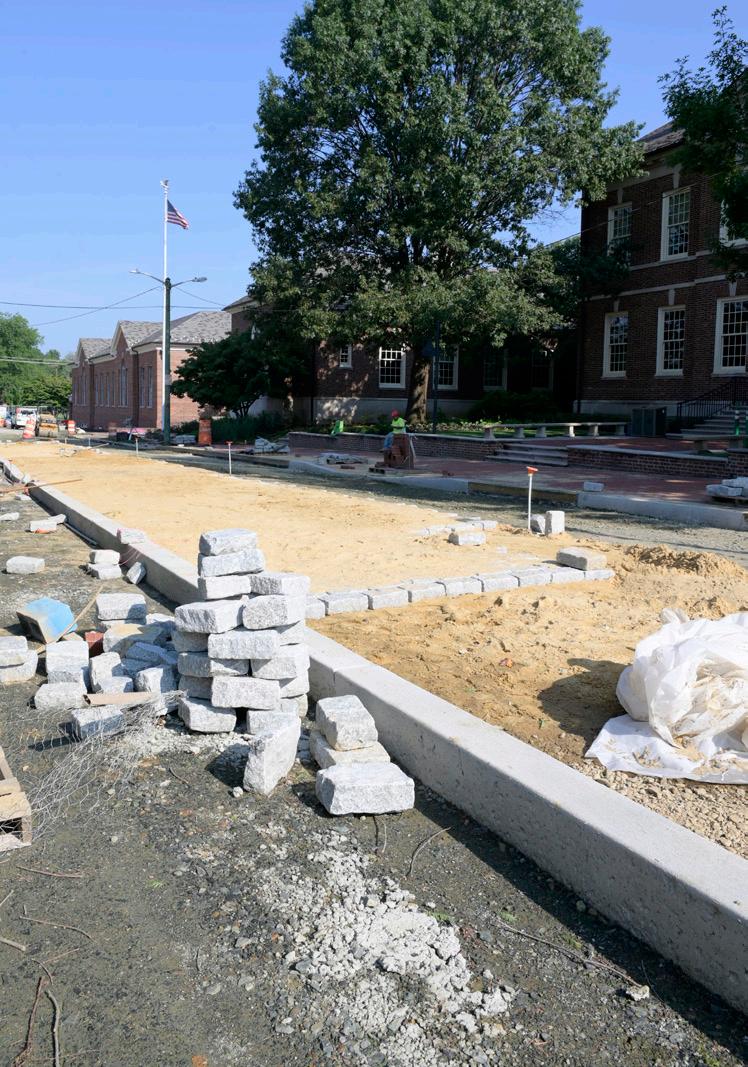
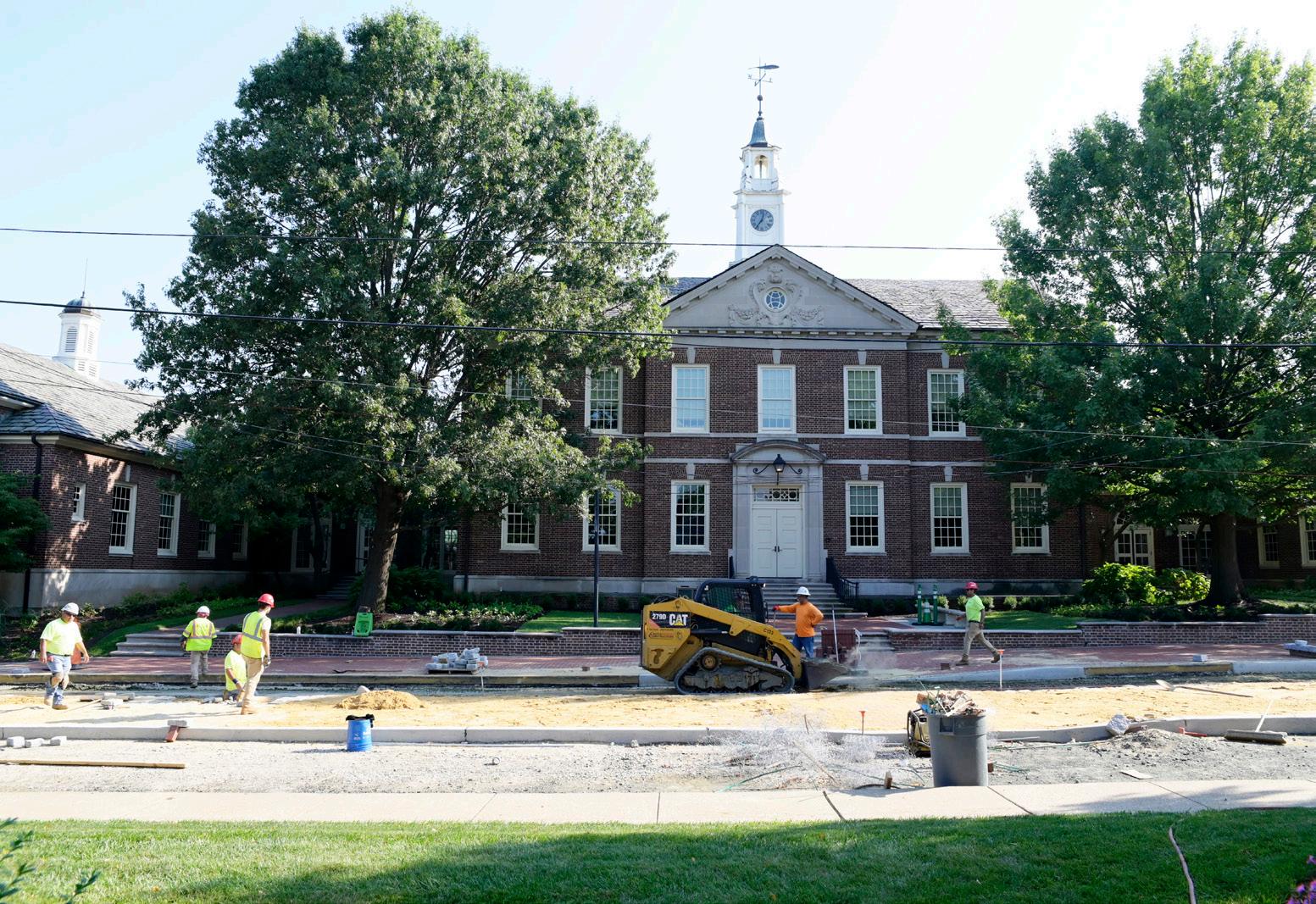
This summer the Tower Hill campus was buzzing with activity. The Weaver Gym locker rooms rennovations started and will include the addition of accessible bathrooms. The work will continue through spring 2024. Improvements to 17th Street include quieting to make it more safe and upgrading the landscaping. A new Daktronics scoreboard was installed on DeGroat, and the turf was replaced on Richardson Field. A lacrosse wall is also being constructed. Note: photos were as of Aug. 9, 2023.
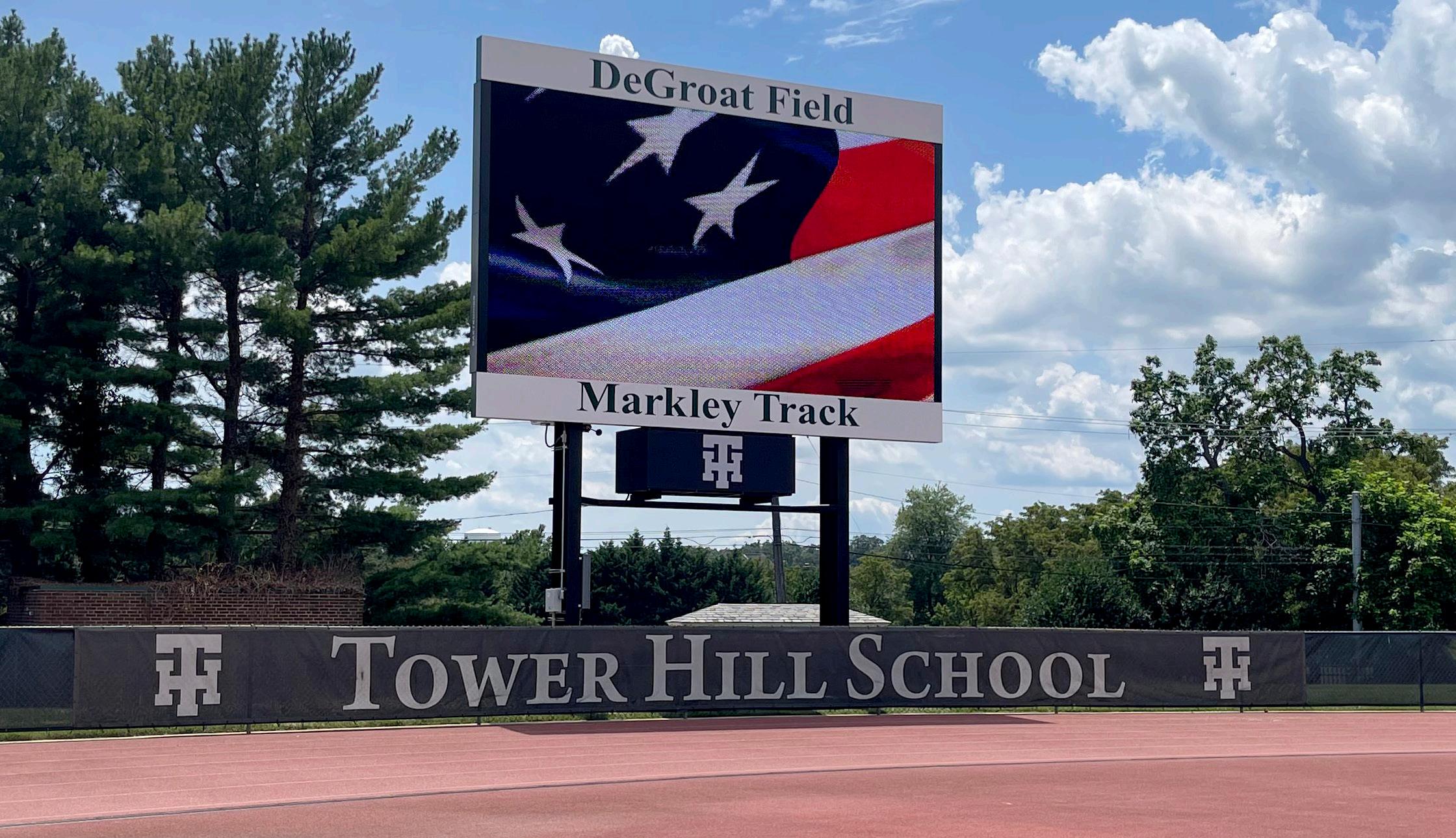
17th STREET
DEGROAT SCOREBOARD
WEAVER GYM

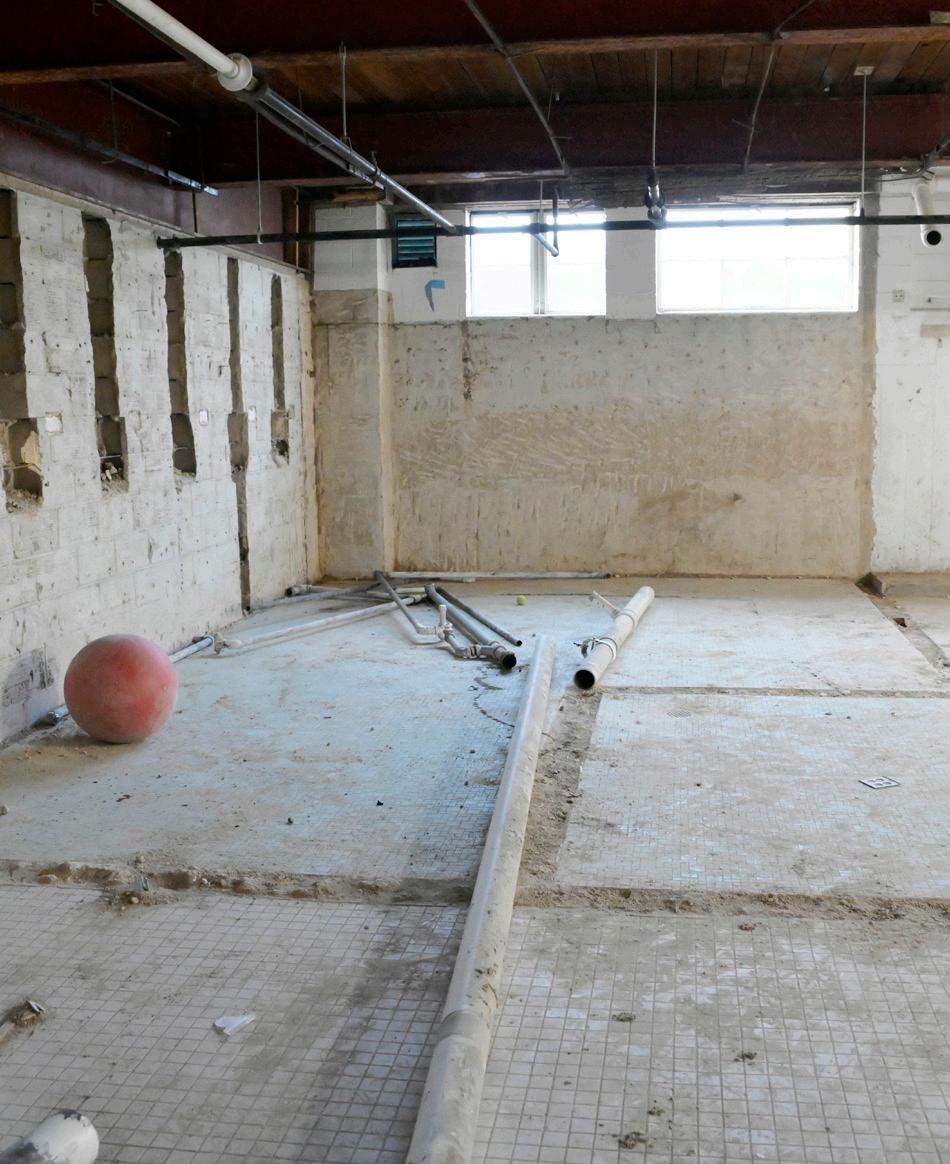
RICHARDSON FIELD
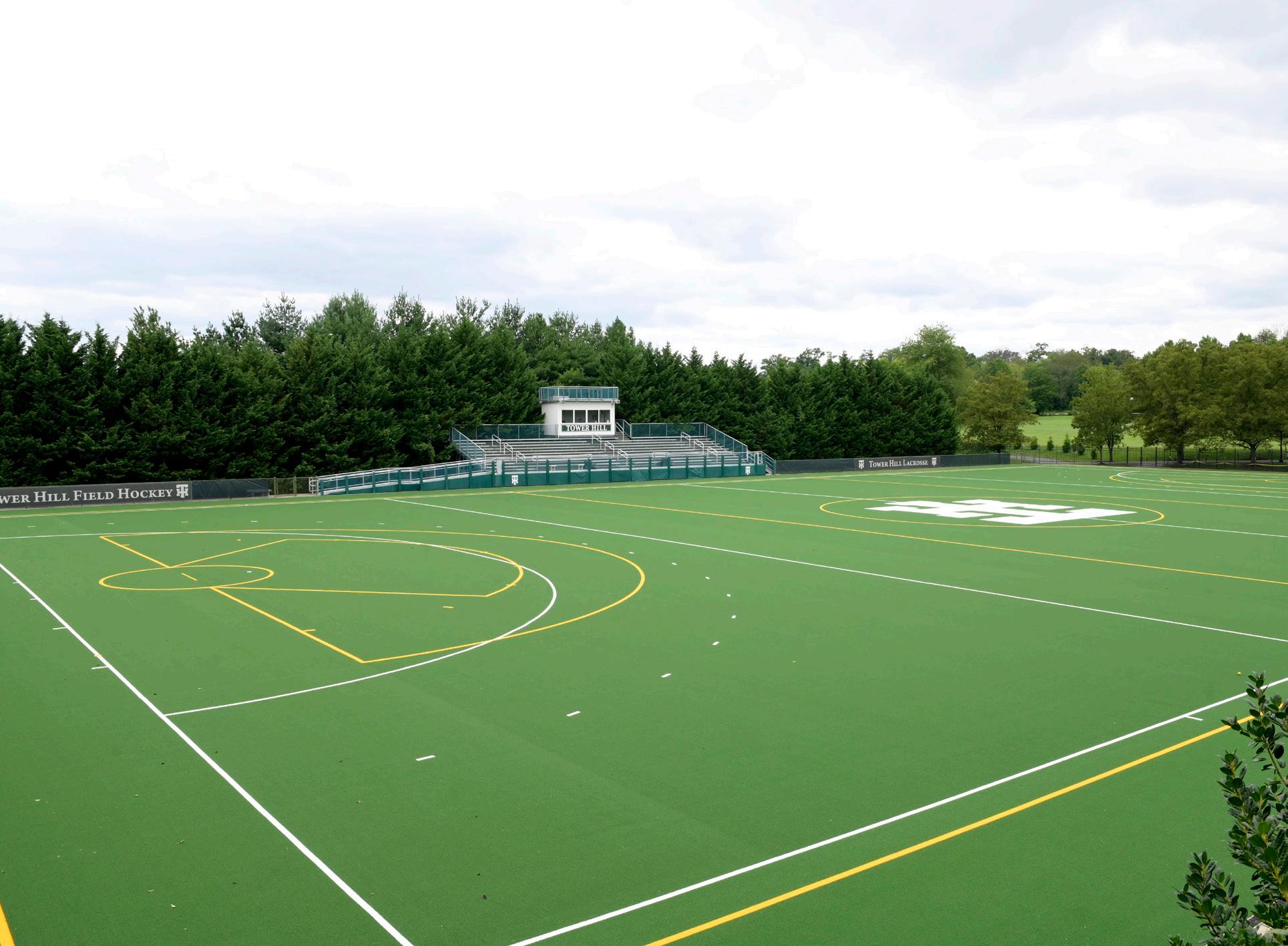
CAMPUS IMPROVEMENTS
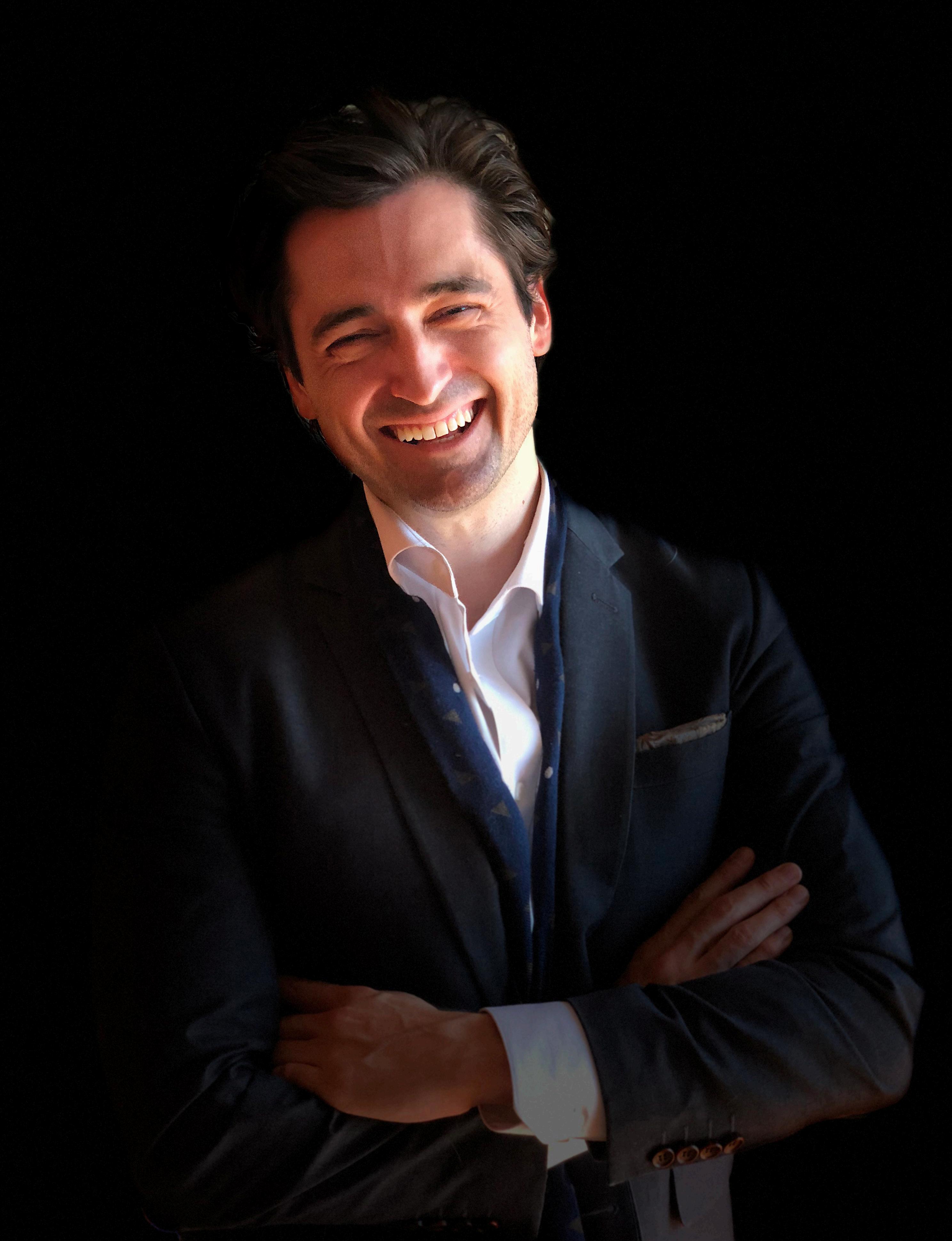
TOM VILLALÓN ’02
THE ROOTS OF BECOMING A HERO IN YOUR OWN LIFE
BY MAURA CICCARELLI, FREELANCE WRITER
Longtime international disputes lawyer Tom Villalón ’02 remembers each situation in vivid detail. Specific circumstances changed, but the threats were still the same.
The Taliban were going door-to-door in Afghanistan, hunting down the Afghan women who once hunted them.
A woman, hiding in her home, would text desperate questions on her cell phone as the Taliban searched for her, circling her house.
On the other side of the world in Honolulu, Villalón and his team would text them what to do.
Together with his group, Villalón helped guide the women through desperate situations. Send pictures of military IDs and destroy the originals if necessary. Have a child answer the door and say their father was out getting medicine because the family was sick. Change their own appearance by messing up their hair, wearing ragged clothing, and putting dirt onto themselves— anything to make themselves as ugly as possible. That might help hide their true identity and save them from being sexually assaulted.
These women were once police officers, soldiers, midlevel military officers and pilots in the former Afghan National Army. Some of them were members of the Afghan Military’s elite Female Tactical Platoon (FTP), Afghanistan’s only all-female special forces group who were trained by, and deployed alongside, U.S. special forces. Their role before the Taliban retook control in August 2021 was to find and capture Taliban forces.
If found, the women faced certain execution, along with their families.
While he stayed on the phone to keep the women as calm as possible, his own heart raced. He had connected with these women before they were in imminent danger. He and his team got their passports, military IDs, and other legal paperwork in order, and gave them connections so they could move to safe places if they were being actively sought.
The most important application of all is the USRAP Priority-1 Referral—a form that would eventually give a US visa to Afghans personally known to the U.S. government during its 20-year mission, and who were in imminent danger.
Seeing the treacherous plight of these women and their families inspired him in May 2022 to quit his
international law firm job with Covington & Burling LLP to focus fulltime on the effort.
He’s working with three other volunteers with the group Rescue Afghan Women Now (RAWN), which he cofounded with a U.S. Army Reserve Captain who goes by a pseudonym to protect her identity. They raise money to pay for the rescues and work their extensive network to save these women’s lives.
As of this summer, the RAWN team has heroically saved about two dozen women and their families. About 183 more await help.
FINDING THE PATH
How did Villalón go from being a successful international disputes lawyer to literally saving lives? As the U.S. forces pulled out of Afghanistan in August 2021, thousands of Afghan citizens who had worked with the U.S. were unable to escape. Law firms like his donated their time to help some on a pro bono basis, which means “for the public good.”
“As the U.S. withdrawal unfolded, the interpreter I helped with a U.S. visa reached out to me and said his extended family of brothers and sisters and their children, along with his elderly mother, were being targeted by the Taliban, which was canvassing door-todoor,” he says. “It was only a matter of time before they all ended up executed.”
It was not work he or his firm was accustomed to doing, but, at a deep moral and ethical level, he just couldn’t turn away.
He began searching. He drew ever wider concentric circles around his personal network of lawyers, family and friends to find the help that was needed. His Tower Hill classmate and good friend Alex Fortunato ’05 helped him craft the right social media searches to find specific veterans who might help. He reached out to U.S. military and intelligence organizations, as well as other refugee support groups around the world.
“Eventually, we got 11 of the 13 family members out of the country from an overland exfiltration route,” says Villalón. “I refused to quit.”
LIFE CHANGING VOLUNTEERING
Some of the stories he tells have details that are too brutal and heartbreaking to share in these pages. But, they live in his memory, spurring him to continue to help.
71 Tower Hill Bulletin Fall 2023 ALUMNI PROFILE
The rescue work contrasts with his own personal life. For the past decade, he’s been a successful global attorney. He speaks Chinese, Spanish, Korean and English, and is conversational in Arabic, German and Farsi/Dari. He’s also been tackling other languages in the Afghan region, including Pashto and Hindi/Urdu.
His bachelor’s in Chinese language and culture is from Dartmouth, and his J.D. is from the University of Hawaii at Manoa. He lived and worked in Seoul, Korea for five years before joining Covington & Burling in New York City in 2019. He and his attorney wife, Natalie, live in Hawaii and go surfing whenever they can.
Although he was born in the U.S., he and his family spent time back in Chile, where his father was originally from. After returning to the U.S., he came to Tower Hill in second grade and grew up with classmates who would become close, lifelong friends. He credits the school with why he has felt so comfortable living in places so far away from Wilmington.
“You don’t realize how valuable it is until later in life but when you’re with the same people every single day for 12 years, you form relationships that are more stable and familial than most relationships you make in your adult life,” he says, noting that he recently went to his 2002 classmate Tyler Akin’s wedding in Paris in June, where they hung out with fellow Hillers Laird Hayward ’02, Brad Hayward ’04, Taylor Paterson ’02, Wilson Braun ’01 and Alex Mackenzie ’02. One of his closest childhood friends, Pat Kaiser ’02, now teaches and coaches at Tower Hill.
“It anchors a part of you in familiarity and enables a part of your intellect and your heart to be fearless and wander out into the world. When you have such a strong sense of home and where you’re from, then every path away from home just becomes an adventure,” he says.
Just before founding RAWN, Villalón decided to leave his job with the law firm, cash in his retirement account and focus full-time on saving these Afghan women.
“In some ways, I thought this would be a minor blip in my life and career, but it spiraled into something bigger and more important than I ever thought would be possible or imaginable,” he says.
TOWER HILL ROOTS
Villalón traces the roots of his inspiration to help back to his English classes at Tower Hill.
“A seed was planted deep in me that every experience in your life is a story that you both simultaneously create and discover about yourself,” he explains. “At any time, you can actually change that story. I think that was probably the most powerful lesson. That’s the kind of root that connects me to this Afghanistan work.”
He adds, “I remember thinking [that] I would love to help but it’s just not my skill set. That’s not my story.
Then, I thought, ‘well, maybe you don’t know what your story is just yet.’”
The final assignment in his world myth English class taught by John Robinson was “Are you the hero of your own life? Please explain.” To inspire them, they had read literature like The Brothers Karamozov and David Copperfield and also studied Joseph Campbell’s Hero of a Thousand Faces.
“It was such a simple, elegant, beautiful prompt,” he recalls. “It has stayed in my mind for the past 20 years. I still don’t know the answer to it. I think the answer is just the process of struggling with that question itself.”
When he began working on rescuing Afghans, he says he didn’t consider himself a hero in his own life. Then, he realized, “Maybe this is an opportunity to do something about it and become that hero.”
TACKLING THE CHALLENGE
The rescue efforts work requires a close attention to detail, one of his specialties as a “nerdy” lawyer, he says, is creating detailed spreadsheets. His growing knowledge of Afghan languages helped him identify errors in some women’s legal papers that, if left unfixed, might have scuttled their chances of escape.
“Once the visa application is in, it probably takes a year or more before the U.S. government can find a way to get them to a U.S. base or a U.S. controlled area in Central Asia. If they aren’t successful and are left behind, these women and their kids will likely be killed,” he says.
Sometimes, the women and their families are moved out of the country one-by-one. In other cases, Villalón and his team give the women strategies for playing a successful cat-and-mouse game with the Taliban, using a series of safe houses until they can do an overland evacuation to leave.
The polar opposite of the panicked across-the-world calls are the joyful video conversations after the women and their families reached safety outside of their country.
“They really wanted to see the faces of the ‘guardian angels’ who helped save them,” Villalón explains. “They’re so thankful and don’t understand how complete strangers would do so much to help them. We tell them its our honor as Americans to help them. I really do hope one day to meet these people in person. Even if I never do, it’s a really important connection I have with this group of absolute strangers.”
Villalón will share his story as this year’s first 2023-2024 Tower Hill Forum speaker focusing on global service to others. He also will receive the Tower Hill School Young Alumni Award at the Oct. 14 Alumni Reunion and annual Alumni Association meeting.
72 Tower Hill Bulletin Fall 2023
HOMECOMING & REUNION 2023 SCHEDULE
Check towerhill.org/homecoming for updates
FRIDAY, OCT. 13
10-11 a.m. Installation of Sarah D. A. Baker as the 11th Head of Tower Hill School
4 p.m. Thirds Boys Soccer vs Wilmington Friends (Nitsche Pitch)
4 p.m. Thirds Girls Volleyball vs Wilmington Charter (Carpenter Field House)
5:30 p.m. JV Girls Volleyball vs Wilmington Charter (Carpenter Field House)
5:30-7 p.m. Alumni Tailgate before Varsity Volleyball game vs Wilmington Charter (Timothy B. Golding Alumni House)
7 p.m. Varsity Volleyball vs Wilmington Charter (Carpenter Field House)
SATURDAY, OCT. 14
ALL DAY Art Exhibit - Founders’ Gallery (Main Building)
10 a.m. JV Boys Soccer vs Wilmington Friends (DeGroat Field)
10 a.m. Student-led school tours - Beginning at W. 17th St. entrance
11 a.m. Varsity Field Hockey vs Wilmington Friends (Richardson Field) 11-12:15 p.m. State of the School and Alumni Association Annual Meeting and Presentation of Distinguished and Young Alumni Awards (1919 Auditorium)
12 p.m. Varsity Boys Soccer vs Wilmington Friends (DeGroat Field)
12:30 p.m. JV Field Hockey vs Wilmington Friends (Richardson Field)
12:30-2:30 p.m. Picnic Lunch under the Homecoming Tent (Next to Alumni House)
3 p.m. Varsity Football vs Tatnall (DeGroat Field)
5:30-7 p.m. Alumni Reunion Reception for Classes Ending in 3 and 8 All alumni are invited to attend. Group class photos will be taken throughout the evening. (Hayward House lawn tent)
73 Tower Hill Bulletin Fall 2023
JENNIFER CLEARY ’20
THE APPEAL AND REWARDS OF HARD WORK
From an early age, Jennifer Cleary ’20 exhibited a remarkable talent for golf, following in the footsteps of her father, Blake, and older brothers, Ryan ’15 and Matthew ’16. Her passion for the sport blossomed, and by the age of 11, she eagerly embraced competitive play. Today, Cleary is a force on the University of Virginia’s golf team, where she finds herself immersed in an environment that fosters growth and constant improvement and is surrounded by teammates and coaches that motivate each other both on and off the course.
During the 2022-2023 season, Cleary showcased her skills with top-15 finishes in three out of six tournaments, including an impressive T-5 placement in the esteemed Mercedes-Benz Intercollegiate in the fall of 2022. Additionally, she reached the quarterfinals of the North & South Women’s Amateur in the summer of 2022, and made it to the Round of 64 in the U.S. Women’s Amateur.
Perhaps the pinnacle of her accomplishments this past year was her invitation to participate in the illustrious Augusta National Women’s Amateur competition in April 2023. Reflecting on her experience, Cleary humbly acknowledges her 37th place finish out of 72 participants, acknowledging a few errors that cost her precious shots. Nevertheless, she described the opportunity as “awesome,” emphasizing the pristine condition of the course and the profound sense of history that surrounded her as she walked its greens. Cleary remarks that “having my supportive UVA teammates in attendance definitely added an extra layer of significance to the event for me.”
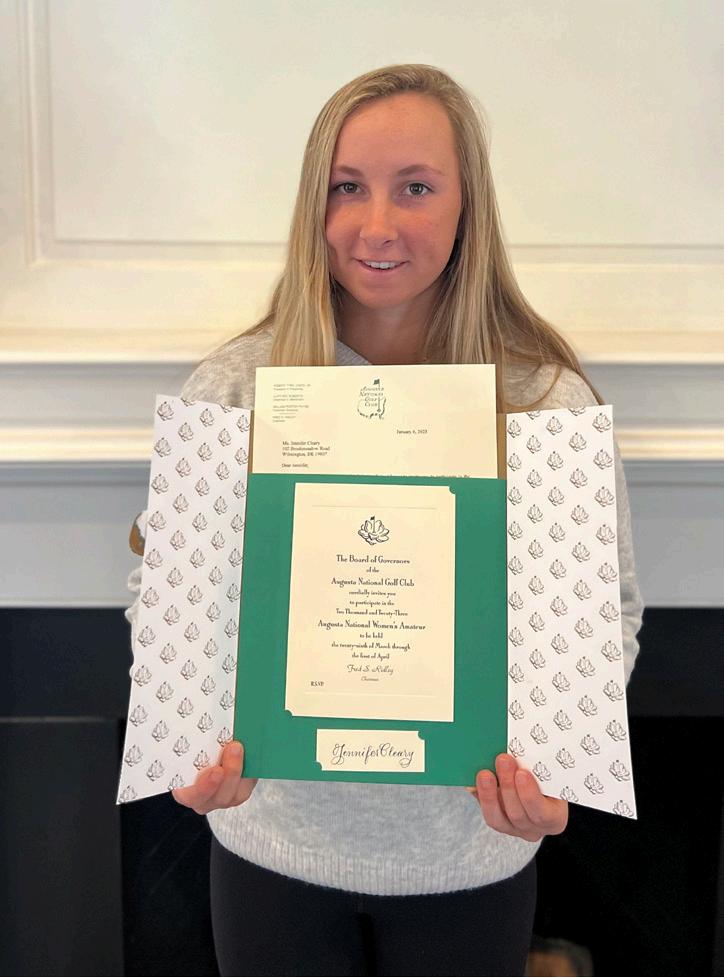
When reminiscing about her profound love for golf, Cleary attributes it to her fond memories of spending time with her brothers and teammates. This camaraderie provides an important balance to the solitary nature of the game. It satisfies her competitive spirit, and she notes, “I really enjoy playing golf because it is a metaphor for life. The mental fortitude and problem-solving skills that are developed on the golf course serve as preparation for life’s challenges off the greens as well.”
Reflecting on her formative years at Tower Hill, Cleary acknowledges that “Tower Hill’s environment of excellence” inspired her from a young age to do well in school and on the athletic field. In true Multa Bene Facta fashion, Cleary, a three sport varsity athlete
in field hockey, squash and golf, not only immersed herself in sports but also explored her artistic side through studio art classes. This multidimensional approach not only challenged her to think differently but also enabled her to forge connections with a wide array of friends.
The influence of Tower Hill’s commitment to cultivating well-rounded individuals carried over into Cleary’s collegiate years. Enrolling at the University of Virginia’s McIntire School of Commerce, she is currently studying finance and information technology, lured by the institution’s reputation of a challenging academic environment and a strong sense of community. As she enters her senior year, Cleary is interested in exploring a future in finance or the continuation of her competitive golf career.
When contemplating her passion for golf along with her affinity for hard work, Cleary humorously acknowledges her inability to remain idle. She strives to constantly better herself despite the inherent pressure that accompanies four and a half hours of play. Cleary finds solace in the deliberate pace of golf and the inherent challenge of “figuring it all out for yourself.” Her profound connection to the sport and her drive to improve make golf an unwavering source of fascination and fulfillment.
74 Tower Hill Bulletin Fall 2023
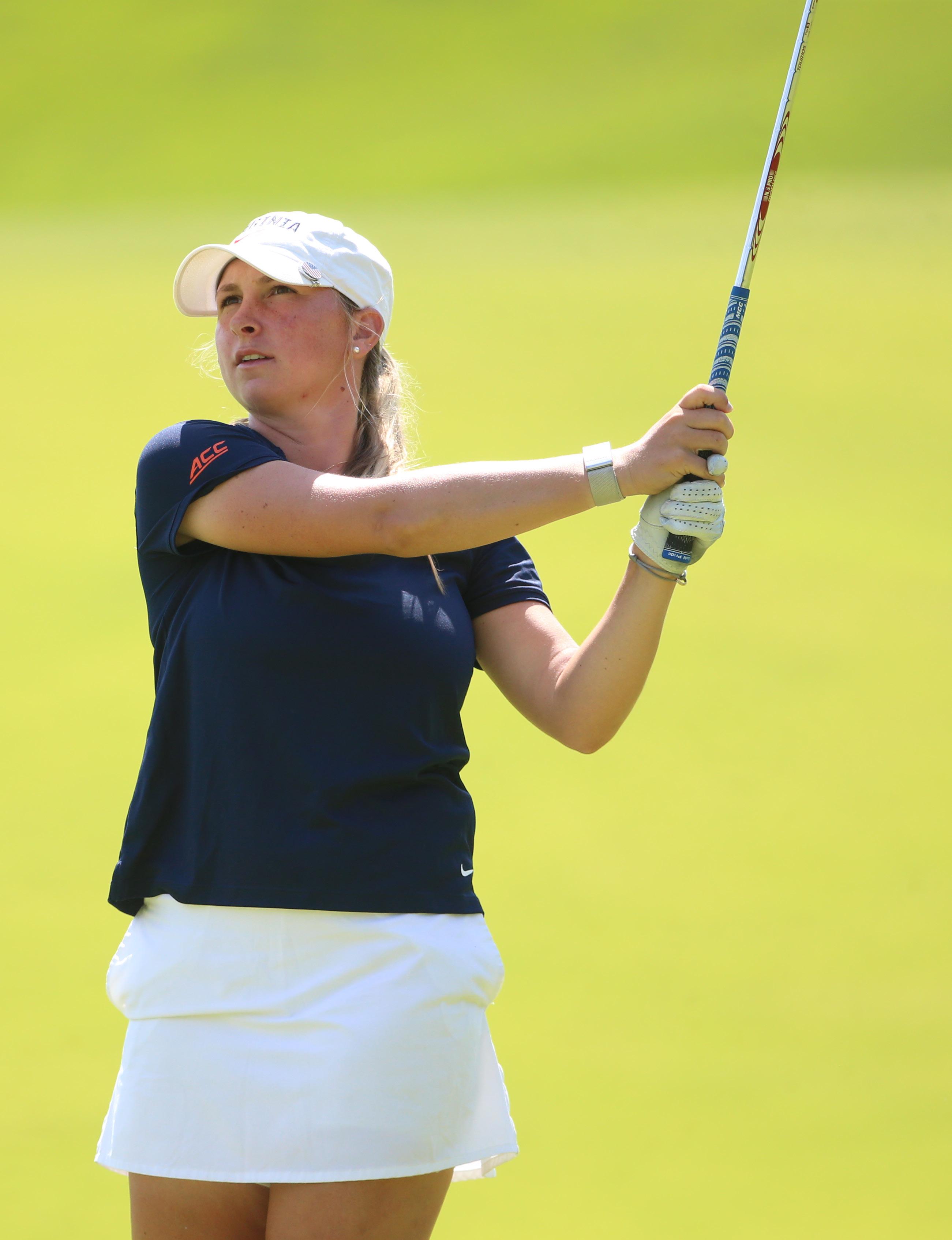
ALUMNI PROFILE
FINANCIAL OVERVIEW
NARRATIVE ON FINANCE AND FACILITIES - SUMMER 2023
BY ERIC NORMAN, CFO
Budget Overview
Each year, the school develops a detailed operating budget that is based upon a number of parameters and assumptions made for significant areas such as enrollment, financial aid, the Annual Fund, compensation and benefits, operational and instructional costs, and endowment returns. Those parameters are the primary drivers of a comprehensive financial model which gives us multi-year projections that ensure each annual budget is part of a long range focus on financial sustainability. Our budgets also include debt service requirements and capital expenditures from the resultant cash flow.
The composition and trends for our operating revenues and expenses are as follows:
Operating Revenues
Fiscal Year Results for the Year Ending June 30, 2023
The financial results exceeded the budgeted net operating income as revenues were 6.3% over the original budget (and 8.4% higher than last year), driven primarily by higher net tuition from increased enrollment as well as improved auxiliary (aftercare, summer programs, café) revenues and significantly higher interest income. Operating expenses were 2.0% higher than budget (and 4.6% higher than last year) led by increases in educational and administrative areas, as well as professional fees as inflationary pressures, along with incremental initiatives (strategic planning, head transition, professional services), increased our cost base. Health care costs were significantly under budget as the school is self-insured and experience during the year was good. In summary, while inflation dominated the headlines in 2023, we were able to strategically manage both our revenues and expenses in a way that yielded a better-than-budgeted bottom line from operations.
Non-operating financial highlights included:
• Preliminary Endowment Returns were +10% which yielded $4.6M in positive returns;
• Capital Gifts (non-Annual Fund) totaled $1.5M;
• The school applied for and received tax credits under the ERC program in this fiscal year;
• Capital Expenditures for the year were nearly $1.6M; and
• Debt of $8.5M continued to amortize at favorable all-in average interest rates of 2.78%.
Net Tuition Per Student
Expenses for FY 23-24
Operating Expenses
We have been able to steadily grow our net tuition and annual fund per student, which has been critical in order to support our expanded academic and extracurricular programs, particularly in this rising cost environment.
Annual Fund Per Student
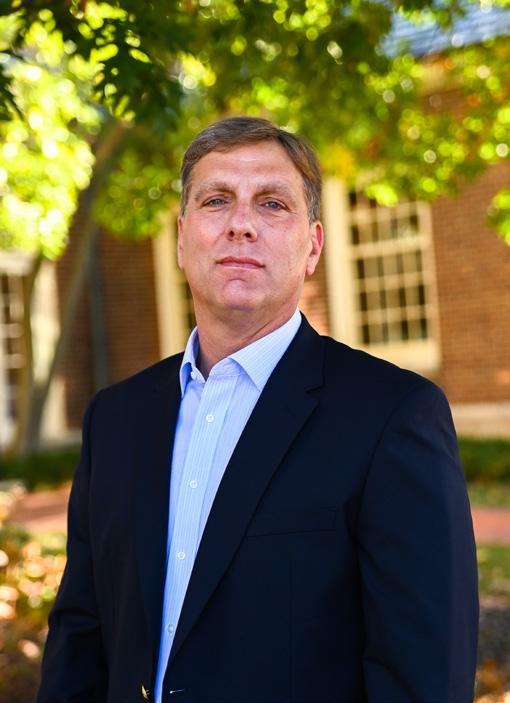
76 Tower Hill Bulletin Fall 2023
Net Tuition Endowment Draw Annual Fund Dining Fees Auxilary Revenues Other • • • • • • Core Compensation & Benefits Instruction Depreciation Maintenance/Facilities General Administration FundraisingAdvancement • • • • • •
$1,200 $1,250 $1,300 $1,350 $1,400 $1,450 $1,500 FY 18/19 FY 19/20 FY 20/21 FY 21/22 FY 22/23 FY 23/24 $19,500 $20,000 $20,500 $21,000 $21,500 $22,000 $22,500 FY 18/19 FY 19/20 FY 20/21 FY 21/22 FY 22/23 FY 23/24 Net Tuition Dining Fees Annual Fund Endowment Draw Auxiliary Revenues Other
Core Compensation & Benefits 13% Instruction General Administration 1% Fundraising/Advancement Maintenance/Facilities 7% Depreciation $22,500 $22,000 $21,500 $21,000 $20,500 $20,000 $19,500 FY18/19 FY19/20 FY20/21 FY21/22 FY22/23 FY23/24 $1,500 $1,450 $1,400 $1,350 $1,300 $1,250 $1,200 FY18/19 FY19/20 FY20/21 FY21/22 FY22/23 FY23/24
Combining both operating and non-operating activity for the year, net assets increased by approximately $8.3M, which is indicative of the overall financial strength of the school.
During this past fiscal year, we completed renovation of our theater, enhanced security with additional card access, surveillance and emergency lighting. We designed and began renovation of the Weaver Gym locker rooms, along with the addition of accessible bathrooms, started installation of a new scoreboard on DeGroat and began the roadwork and landscaping on 17th Street. The front of the school will have a much improved look as the school year commences and our students will be dramatically safer with the calming of that road. Construction of Weaver will continue into the spring of 2024.
Operating Budget/Projection for This Coming Fiscal Year
The operating budget once again projects to have a positive gross margin for the upcoming year. The school expects modest growth in enrollment and auxiliary services, which will help offset inflationary pressures that it will see across all of its operations, as well as provide funds for some growth in staffing. This year’s increase in enrollment will likely be spread evenly across all three divisions, versus last year’s which was primary in the Lower School.
In the coming year we will continue with our strategic planning process and other initiatives and will closely monitor our financial targets and assumptions and will adjust if we see significant variances from expectations. While the stock markets, the economy and inflation have all stabilized, we will watch all macro-activity closely in order to anticipate any impact on school and/or family finances.
For this coming year, the largest capital project will be the ongoing renovation of the Weaver Gym locker rooms. Other large projects include the calming of 17th Street along with the landscaping, installation of a lacrosse wall, resurfacing of our tennis courts and replacement of carpeting on the lower floors. We also engaged a consulting firm to complete a facilities assessment in order to help us identify our deferred maintenance, quantify the replacement value of our campus buildings and to study the utilization of our current spaces. Finally, the endowment stands at $55.7M as of June 30, 2023 reflecting the improving but challenging investment markets this year, and the endowment draw (which supports operations) was lowered to 3.95% of the average market value as part of a five-year plan to get to a 3.75% rate. We will continue to work with our investment advisor to ensure asset allocation, manager selection and our investment policy maximizes our returns while minimizing downside risk. We have engaged a new investment advisor for this coming year that specializes in managing endowments for independent schools.
ANNUAL FUND RESULTS
$1.2M
Total raised for the Annual Fund New donors gave to the Annual Fund
Total donors
195 999 28%
of the $1.2M was raised through days of giving (Giving Tuesday, Hiller Heroes Challenge, Field Day)
DONORSHIP BY CONSTITUENCY
Alumni: 452
Parent: 268
Friends: 180
Former Parent: 158
Faculty/Staff: 85
Grandparent: 85
Trustees: 20
TOP REUNION GIVING
Chart Title Trustees Alumni Parents: 268 Grandparents Former Parents
Class of 1972 - 50th Reunion 26%
CLASS OF 1972
We hope this provided a good snapshot of where we stand after last year and headed into a new year!
77 Tower Hill Bulletin Fall 2023
•
• • • •
• •
ANNUAL
REPORT
Thank You
From the DIRECTOR OF ADVANCEMENT
Dear Tower Hill Supporters,
Thank you for your support of Tower Hill School this year. The 2022-2023 Donor Honor Roll recognizes Tower Hill alumni, students, parents, former parents, grandparents, trustees and faculty and staff who contributed to the successful fundraising for this extraordinary school.

Thanks to your investment, over $4 million was raised in total for Tower Hill this year, and the Annual Fund surpassed the $1 million mark for the fifth consecutive year, reaching its highest ever at $1.2 million. In addition, leadership funds were raised to establish new endowments for financial aid and faculty professional development and to contribute to the 63 existing endowment funds. Campus enhancements such as the renovation of Weaver Gym, the new DeGroat Daktronics scoreboard and lacrosse wall were also made possible through philanthropy this year. This strong and deliberate investment in our students, faculty, programs and campus ensures Tower Hill’s tradition of educational excellence continues.
I would also like to extend sincere appreciation and thanks to all of Tower Hill’s dedicated volunteers, whose loyal service contributed to the successful fundraising year: the Advancement Committee; the Alumni Council; Annual Fund parent captains; Alumni class agents and reunion coordinators; Home and School; and Green & White. We are grateful for your time, enthusiasm and tremendous efforts for the benefit of Tower Hill School.
This is an important time in Tower Hill’s history, and your generous contributions continue to make the remarkable happen for this extraordinary school. Thank you for answering the call to support Tower Hill’s mission and for investing in our students and teachers.
With sincere gratitude,
 Kristin B. Mumford Director of Advancement and Enrollment Management
Kristin B. Mumford Director of Advancement and Enrollment Management
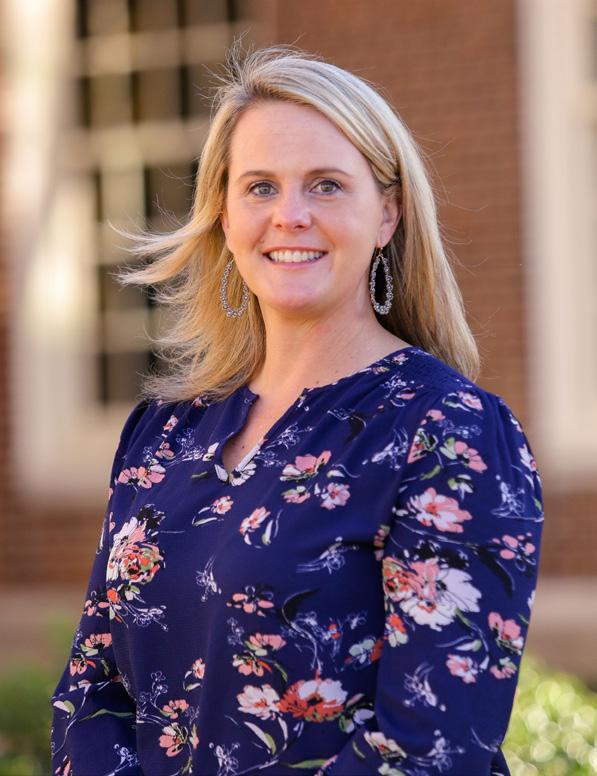
Special thanks to the ADVANCEMENT
David Nowland ’85, Chair
Ashley Altschuler ’90
Suzanne Ashley
Robert DeSantis
John Gavenonis, Ph.D.
COMMITTEE
Lisa A. Olson ’76
Régis de Ramel
Logan Weaver Read ’10
Isabella Speakman Timon ’92
78 Tower Hill Bulletin Fall 2023
Donor Roll
On behalf of the students, families, faculty and staff at Tower Hill School, thank you. Your generous gifts make a difference in the lives of our students.
Donors by Giving Circle
ALL FUNDS INCLUDING THE ANNUAL FUND
JULY 1, 2022–JUNE 30, 2023

Cornerstone Circle
$50,000+
Anonymous
The Bear Gulch Foundation
Mr. Richard S. Cobb and Mrs. Kathleen Kreusch-Cobb
Mr. Régis A. de Ramel
Mr. Benjamin F. duPont ’82 and Mrs. Laura Lemole du Pont
David F. du Pont ’52 Trust*
Ms. Heather Richards Evans
Mr. Henry R. Evans
Ms. Imogen M. Evans
Mr. William G. Evans
Mr. and Mrs. Alexis S. Flint
Mr. Bradford L. Hayward ’04
Mr. Laird R. Hayward ’02
Mr. Pierre duP. Hayward ’66 and Mrs. Martina Combs Hayward
Mr. Douglas R. Jamieson ’73
Mr. and Mrs. Christopher Keith
Mrs. Ellen Jamison Kullman ’74 and Mr. Michael E. Kullman
Ms. Samantha M. Lemole
Mr. and Mrs. Christopher R. Lemole
Ellice & Rosa McDonald Foundation
Mr. and Mrs. David M. Shepherd
Mr. and Mrs. John Sheppard
Stratus Foundation
Mr. and Mrs. Thomas D. Whittington, Jr. Yaverland Foundation
Mr. Bruce B. Yelton* ’67
Multa Bene Facta Circle
$25,000 - $49,999
Robert and Suzanne DeSantis
Mr. E. B. Bradford du Pont ’82
Dr. John M. Flynn ’81 and Mrs. Mary Flynn
Mr. and Mrs. Robert D. Habgood
Mr. and Mrs. Henry C. S. Mellon
Dr. and Mrs. Nisheeth R. Patel
Mr. and Mrs. H. Murray Sawyer, Jr.
W.A. Speakman Family Foundation
THS Alumni Council
Mrs. Isabella Speakman Timon ’92 and Mr. Philip C. Timon
Mr. Geoff and Mrs. Ellet Kidd Veale
Founders’ Circle
$15,000 - $24,999
Mr. Nicolas Jafarieh and Ms. Suzanne E. Ashley
Mrs. William A. Bours III *
Dr. John Gavenonis and Dr. Sara C. Gavenonis
Mr. Michael A. Jenkins ’80 and Mrs. Ann Kallfelz Jenkins ’80
Mr. James W. Morris ’73
Mr. and Mrs. Michael R. Nestor
Mr. and Mrs. Gregory Pettinaro
Mr. and Mrs. J. Mathieu Plumb
Mr. Randolph W. Urmston ’62
Tower Hill Fellow
$10,000 - $14,999
Mr. and Mrs. Vincent T. Abessinio
Dr. G. Mark Bussard ’90
Mr. and Mrs. William H. Daiger, Jr.
Mr. Christopher R. Donoho III ’87 and Mrs. Erica Reedy Donoho
Mrs. Grace du Pont Engbring ’76
Mr. and Mrs. Richard E. Franta, Esq.
Ms. Elizabeth A. Garrigues ’45*
Dr. and Mrs. Eric T. Johnson
Mr. and Mrs. Gregory J. Koch
Mr. and Mrs. Timothy J. Langlois
Ms. Lisa A. Olson ’76 and Mr. Roger S. Hillas, Jr.
Ms. H. Donnan Sharp ’56
Sharp Foundation
The Hon. and Mrs. Kenneth A. Simpler
Mr. and Mrs. Rodger D. Smith, II
Mr. and Mrs. Michael L. Steiner
Mrs. Susan Wood Waesco ’90 and Mr. Kevin M. Waesco
Mr. Rodman W. Ward III ’83 and Mrs. Gina Farabaugh Ward
Trustees’ Circle
$5,000 - $9,999
Mr. Ashley R. Altschuler ’90 and Mrs. Shoshana M. Altschuler
Mr. Eric J. Brinsfield and Dr. Martha Lynn Brinsfield
Mrs. Margaretta Bredin Brokaw ’66
Ms. Anne Casscells ’76
Mrs. Nickie Julian Currie ’90
Mrs. Phoebe Brokaw Davidson ’97 and Mr. Charles B. Davidson
Mrs. Katie Arrington D’Emilio ’97 and Mr. Matthew P. D’Emilio
Mr. and Mrs. Joseph DeSantis
Dr. Everett T. Dickerson ’97
Mr. and Mrs. Dino Dullbson
Mr. Charles J. Durante ’69 and Mrs. Janice F. Durante
Dr. Gary A. Emmett ’68
Mr. Michael J. Flynn ’91 and Mrs. Melissa Wagner Flynn ’91
Mrs. Amanda Walker Friz ’92 and Mr. Robert W. Friz
Mr. Adam Gould and Ms. Nicholle R. Taylor
Mr. Thomas J. Hanna ’91 and Dr. Lynne A. Hanna
Mrs. Nancy L. Hayward ’60
Mr. and Mrs. Christopher P. Heck
79 Tower Hill Bulletin Fall 2023 2022-2023
Dr. Irfan M. Hisamuddin and Dr. Laetitia N. C. Charrier
Mr. Liang Huang and Ms. Di Yang
Mrs. B. Holliday Hoopes Hudimac ’73
Mr. and Mrs. Michael J. Hynansky
Mr. John Hynansky
Mr. and Mrs. Brian D. Long
Mr. C. Ronald Maroney ’59 and Mrs. Eleanor Silliman Maroney
Mr. Whitney M. Maroney ’87 and Mrs. Katharine Fisher Maroney
Mr. and Mrs. Jay R. Miller
Mr. and Mrs. Garrett Moritz
Mrs. Neela Patel
Ms. Christine Kane Plant ’69
Ms. Elizabeth H. Richardson
Mr. John E. Riegel, Jr. ’90 and Mrs. Amanda Golding Riegel ’94 Rock Oak Foundation
Mr. and Mrs. Joseph Setting II
Mr. and Mrs. David A. Soleye
The Rev. and Mrs. Thomas G. Speers III
THS Home & School Association
Mr. Carmen M. Wallace ’93
Mrs. Susan Hill Ward ’54 Wilcox Landscaping
The Windfall Foundation
St. Amour Society
$2,500 - $4,999
Dr. William W. Beck, Jr. ’57
Mr. Richard L. Bender and Ms. Alison Frost
Mr. and Mrs. Lewis S. Black, Jr.
Mrs. Joan Ross Bolling ’47
Mr. Todd Buonocore ’87 and Dr. Allison D. Kolody Buonocore
Mr. John Buonocore, Jr.
Ms. Phoebe Craven ’66
Dr. Anthony L. Cucuzzella
Dr. Anthony R. Cucuzzella ’82
Ms. Louise E. Cummings-Lewis
Mr. Brent Daniel and Mrs. Margaret Carlo-Daniel
Mr. and Mrs. Alexis S. Flint
Mr. and Mrs. William A. Goeller
Mr. John V. W. Harvey
Mr. Tarik Haskins and The Hon. Natalie J. Haskins
Dr. Charles L. Hobbs ’65 and Mrs. Sandra K. Hobbs
Mr. and Mrs. Samuel I. duP. Hyland ’89
Mr. Donald N. Isken
Dr. Mehdi Jadali and Dr. Bahareh Assadi
Mr. and Mrs. Jason Jowers
Mr. and Mrs. Francis Julian
Mr. and Mrs. Lee Knackstedt
Mrs. Sheila Cavanagh Marshall ’63
Modern Controls, Inc.
Mr. and Mrs. James R. Muse
Mr. David T. Nowland ’85 and Mrs. Cathleen C. Nowland
Ms. Tucker T. Pierson ’93 and Mr. Travis J. Elliott
Mr. and Mrs. Andrew R. Remming
Mr. Peter E. Rothschild ’92
Dr. Jonathan H. Salvin and Dr. Karen J. Lefrak
Dr. Jonathan N. Saunders ’75 and Mrs. Charlene Stegura Saunders
Mr. Michael M. Sawyer ’75
Dr. John D. Statler ’86
Mr. and Mrs. Michael Sullivan
Mr. Edward J. Tucker and Mrs. Gaozhen Hang
Mr. and Mrs. Michael J. Vanni
Ms. Anne A. Verplanck ’76
Mr. and Mrs. William L. Wallace
Whiting-Turner Contracting Company
Mr. David N. Williams ’53 and Mrs. Elisabeth O’Hear Williams
Dr. and Mrs. Roger D. Wu
Dr. Zhenyi Xue and Mrs. Chunhong Qiao
Mr. Wenoao Yang and Mrs. Ji Jin
1919 Society
$1,919 - $2,499
Mr. and Mrs. Javier Acuna
Mr. and Mrs. Randolph Barton, Jr. ’59
Mr. and Mrs. Daryl S. Bartow
Mr. and Mrs. Perry S. Beberman
Mr. and Mrs. J. Matthew Belger
Mr. Robert M. Bird* III ’62
BPGS Construction LLC
Dr. and Mrs. Drew A. Brady
Dr. and Mrs. Evan H. Crain
Mr. and Mrs. Kevin C. Erkenbrecher
Dr. and Mrs. John R. S. Fisher
Mr. David Gibson ’85
Mr. John V. E. Hardy, Jr. ’67
The Hompe Foundation
Mr. and Mrs. Charles R. Hudson
Mrs. Danielle Peterson Hyland
Dr. Matthew Jordan and Dr. Trisha Jordan
Mrs. Deborah Gibson Kiernan ’70 and Mr. James Kiernan III
Ms. Emily A. Kiernan ’99
Mr. and Mrs. Alan M. Majewski
Mr. and Mrs. Colin Malone
Mr. Jonathan H. Marvel ’65
Mrs. Antonia Bredin Massie ’73
Mrs. Diana Wardenburg Maxmin ’55
Mrs. Jeanie Cucuzzella McCuskey ’89
Mr. and Mrs. Paul L. Okenczyc
Dr. Munish Pahwa and Dr. Anjala Pahwa
Ms. Aleni M. Pappas ’96 and Mr. Anthony G. Kyriakakis
Mr. Anthony R. Pisapia and Dr. Allison M. Pisapia
Dr. and Mrs. Jonathan S. Russ
Mr. Robert M. Silliman, Jr. ’96 and Mrs. Kelly Silliman
Mr. and Mrs. John B. Swayne III
Dr. Anthony W. Vattilana ’89 and Mrs. Patricia Conomon Vattilana
Dr. and Mrs. Peng Wei
Mrs. Tracy Anne Graham Wenzinger ’86
Dr. Mona G. Yezdani ’01 and Mr. Peter Gillen
Head of School’s Circle
$1,000 - $1,918
Mr. and Mrs. Harry N. Baetjer III
Dr. Jun Bai and Dr. Xiaolan Song
Mrs. Sally Beck Baker ’62
Mr. Richard H. Bayard ’67 and Mrs. Josephine M. Bayard
Dr. Laurence H. Beck ’58
Dr. and Mrs. Sean M. Bidic
Mr. and Mrs. Steve Boyden
Mr. and Mrs. Peter M. Bradshaw, Jr.
Mr. and Mrs. Chase Brockstedt
Dr. and Mrs. Matthew Brooks
Mr. and Dr. Pierce Buller
Mr. Lalor Burdick ’58
Dr. Gordon A. Bussard ’61 and Mrs. Patricia Margraf Bussard
Mr. and Mrs. Stephen A. Caffrey
Ms. Ellen Cannon ’72
Mr. Vincenzo Carbone and Mrs. Daniella W. Guo
Mr. W. Timothy Cashman III ’79
Dr. Kimberly Wright Cassidy and Mr. Bart Cassidy
Mr. Zihao L. Castine and Mrs. Xingyu Song
Mr. and Mrs. Laurent R. Chardonnet
Mr. Barrett J. Cobb ’69
Mr and Mrs.Joseph A. Cooke, Jr.
Mr. John C. Coombs
Mr. and Mrs. Martin Coyne
Mr. and Mrs. Robert T. Crouch
Mr. and Mrs. Derrick M. Deadwyler, Jr.
Mrs. Andrea I. Debold
80 Tower Hill Bulletin Fall 2023
Mr. and Mrs. Robert J. Denning III
Mrs. Yolande Brown Dobbs ’62
Dr. Deepak Doraiswamy and Dr. Kelly Ann Hunter Doraiswamy
Mr. Eleuthere I. du Pont II ’84 and Ms. Darla Pomeroy
Mr. John S. Edinger, Jr. ’78 and Mrs. Laurie Edinger
Ms. Elizabeth M. Fortunato ’02
Mr. Robert T. Franklin and Mrs. Ping Li
Mr. and Mrs. Kevin M. Gallagher, Esq.
Mr. and Mrs. Alexander K. Garnick
Mr. and Mrs. Timothy B. Golding
Mrs. Victoria Maxmin Gravuer ’86
Mrs. Joan F. Gummey ’61
Mrs. Katherine Carol Hughes Halpern ’75 and Mr. John D. Halpern
Mr. and Mrs. Arthur P. Helmick
Mr. and Mrs. Scott W. Henry
Mr. and Mrs. Robert M. Hewes IV
Mrs. Elizabeth Taylor Hirsch ’71
Hord Coplan Macht, Inc.
Mr. Samuel M. Hughes ’72
Mr. Scott L. Hunter ’72
Ms. Paula S. Janssen ’91
Mrs. Hilary C. Johnson
Mrs. Ann Lunger Jones ’58
Mr. Richard R. Joyce, Ph.D. ’61
Mr. Abdullah L. Kesen and Mrs. Sebnem Kesen
Mr. and Mrs. Paul Kim
Mr. Lawrance Kimmel ’97
Mr. and Mrs. Joseph O. Larkin, Esq.
Mrs. Leslie Harvey Lemonick ’75
Mr. and Mrs. Nikolaos T. Liappis
Mr. Jeffrey Liu ’84
Mrs. Heather Weymouth Lowry ’97 and Mr. Matthew M. Lowry
Mr. Tao Luo and Ms. Wei Xu
Mrs. Gale Pierson McNish ’61 and Mr. Douglas McNish
Mr. Desta Mideksa and Dr. Maedot Semo
Mr. and Mrs. Anwar L. Miller
Mr. Edwin L. Mongan III ’69
Mr. and Mrs. Eric J. Monzo
Mountain Laurel Foundation
Mr. and Mrs. Mark Mumford
Mr. Frank H. Nickel, Jr.
Mr. Henry E. Nickle ’76 and Mrs. Anne Nickle
Mr. and Mrs. Nello M. Paoli, Jr.
Ms. Taylor S. Patterson ’02
Mr. Charles S. Phillips ’92
Mr. and Mrs. Srinivas M. Raju
Mr. Thomas B. Rice and Mrs. Cynthia M. Mahaffey-Rice
Mr. and Mrs. Matthew T. Rice
Dr. and Dr. Scott I. Rothbart
Mr. Michael D. Sachs ’86 and Mrs. Robin P. Sachs
Mrs. Beth Carney Salter ’82 and Mr. Dennis M. Salter
Dr. Catherine R. Salva ’90 and Mr. Marcus D. Heifetz
Mr. and Mrs. Todd C. Schiltz
Mr. Thomas M. Schorn
Mrs. Alice Woodcock Smith ’59
Dr. Andrew D. Sparks ’91 and Mrs. Laura Q. Permut Sparks ’93
Dr. Ernest F. Tark III ’73
Mrs. Sara Toner-Wagner
Ms. Genelle S. Trader ’70
Ms. Tracey D. Twyman ’85
Union Park BMW
Mr. and Mrs. Andrew Vella
Dr. Philip L. Verplanck ’77
Mrs. Mary Griffenberg von der Luft ’79 and Mr. Christopher A. von der Luft
Mr. and Mrs. F. Grier Wakefield
Mr. Yu Wang and Mrs. Yinqing Hu
Mr. Min Wang and Mrs. Li Zheng
Mr. Feng Wang, Ph.D. and Hongmin Jiang, Ph.D.
Mrs. Carla A. Wasniewski
Mrs. Roberta Bussard Whiting ’65 and Mr. William B. Whiting
Mr. John L. Williams ’94
Dr. Tarra Boulden Winchell ’01 and Mr. Kevin M. Winchell
Mr. and Mrs. Robert A. Winfree, Jr.
Mrs. Jane K. Wood
Dr. Zugui Zhang and Dr. Fang Fang Chen
Benefactors’ Circle
$500 - $999
Mrs. Lindsay P. Acevedo ’95 and Mr. Michael Acevedo
Mr. and Mrs. Christopher F. Aitken
Mr. and Mrs. Michael D. Allen
Mr. Kurt M. Anstreicher ’74 and Ms. Jane L. Van Voorhis
Ms. Sarah D. A. Baker and Mr. Scott A. Adams
Dr. and Mrs. Andrew M. Barrett
Mr. and Mrs. Hamid Belkadi
Mrs. Erica Bickhart Berger ’08
Dr. and Mrs. Paul D. Biery
Mr. Lewis S. Black III ’95 and Mrs. Nicole A. Black
Mr. David C. Blickenstaff ’86
Mr. and Mrs. Keith A. Boulden
Mr. Chadd E. Boulden ’97
Mr. and Mrs. Charles Bowes
Mrs. Catherine Brown-Butler ’82
Mrs. Margaret Savage Brownell ’75
Mrs. Alisha Wayman Bryson ’91
Mrs. Stephanie C. Carpenter ’58
Mr. Willis S. Colburn ’58
Mr. Peter Conn ’91
Mr. and Mrs. Robert Coyne
Mr. and Mrs. Stephen B. Craft
Mr. and Mrs. Scott Craig
Mr. Robert W. Crowe, Jr. ’90
Dr. Amy Cuddy and Mr. Brian Cuddy
Ms. Lisa D. Daudon ’75
Mr. Ernest F. Delle Donne ’75 and Mrs. Joan C. Delle Donne
Mr. Matthew D. Dinneen ’02 and Mrs. Meredith C. Dinneen
Mrs. Alice Warner Donaghy ’58
Mr. Willis H. du Pont ’54
Mr. Robert H. Dugger III ’63 and Mrs. Joan M. Huffer
Mr. John C. Falcone
First Choice Cleaning Services
Ms. Mary Fitzpatrick
Mr. Andrew Y. Fong ’99
Mrs. Lisa Harrington Foote ’72 and Mr. George B. Foote, Jr.
Ms. Kathryn F. Fortunato ’02
Mrs. Alice Kitchel Fulweiler ’72 and Mr. Peter C. Fulweiler
Mr. Millard G. Gamble IV ’61
Mr. and Mrs. Guido Geerts
Mr. and Mrs. Richard J. Giacco
Mr. and Mrs. Dimeji Gisanrin
Mrs. Michele du Pont Goss ’59
Dr. Francis M. Green ’47
Mrs. Mary Grover Hagan ’81 and Mr. David B. Hagan
Mr. and Mrs. Kurt A. Heister
Mr. Robert D. Hempstead ’61
Mr. Morgan L. Hendry IV ’01
Ms. Vita P. Hendry
Mr. and Mrs. Kevin Herbein
Mr. and Mrs. David P. Hogan
Mr. Joseph C. Hoopes, Jr. ’61 and Mrs. Lesley Bissell Hoopes ’64
Mr. Edward P. Hughes ’69
Mrs. Deanna P. Hynansky
Mr. and Mrs. Joseph W. Janssen, Jr.
Johnson-Lambe Co.
Mr. and Mrs. Rob Jorgensen
81 Tower Hill Bulletin Fall 2023
HONOR ROLL
Jostens Eastern Shore
Ms. Jill Kolody
Mr. and Mrs. Dimitrios Kolovos
Mr. Robert J. Krapf ’69 and Mrs. Jean A. Krapf
Kreston’s Wine & Spirits
Ms. Erika Kurtz
Mr. and Mrs. Jacob Laksin
Mrs. Cynthia Lewis LaMothe ’58
Dr. Peter E. Larned, D.P.M. ’02 and Dr. Caroline Bashore
Mr. Leslie Leach and Dr. Kathleen Leach
Mrs. Julia Johnson Lindquist ’58
Dr. and Mrs. Jingqiang Liu
Mrs. Alice Flaherty Long ’65 and Mr. John R. Long
Mr. and Mrs. Michael Lu
Mr. Guotao Lu and Mrs. Zhaochun Li
Mrs. Dolores Mahaffey
Mr. and Mrs. Terry Malloy
Mrs. Jane Edwards McKinstry ’53
Mr. Anthony Muscelli II ’84 and Dr. Stephanie Elam Muscelli
Mr. Ruijie Niu and Dr. Lihua Wang
Mr. William T. Pease ’69
Dr. and Mrs. Michael B. Peters, Jr.
Dr. and Mrs. Morris Peterzell
Dr. Margaret Boyer Proctor ’72
Mr. Jun Qian and Mrs. Guojiao Wu
Mr. and Mrs. Spencer J. Qualls
Mrs. Lea Gummey Quimby ’86 and Mr. Steven H. Quimby
Mr. Randy J. Rasmussen and Mrs. Emma A. Blair
Mr. and Mrs. Andrew C. Rose
Sage Dining Services
Mr. Anthony J. Salva ’94 and Mrs. Mandy J. Salva
Mr. David G. Santiago ’86
Mr. H. Rodney Scott ’66 and Mrs. Andrea Martz Scott
Simon Eye Associates
Mr. Curtis R. Smith, Jr. ’99
Dr. Jorge M. Soares and Dr. Elizabeth B. Bayley
Mr. and Mrs. Marshall Soss
SSS Clutch Company, Inc.
Stamford Screen Printing
Mr. Sibo Sun and Mrs. Hao Li
Mr. Yu Tian
Ms. Lynne D. Twyman
Dr. Ellis A. Wasson
Ms. Elizabeth A. Way ’79
Wayman Fire Protection, Inc.
Mr. and Mrs. Robert H. Welshmer
Mr. Charles M. Weymouth ’56
Ms. Sarah I. Whittington ’00 and Mr. Tanard E. Nixon
Mr. James H. Worth ’51
Mr. Ding Zhang and Dr. Lan Li
Mr. and Mrs. Hong Jun Zhao
Dr. Shihong Zhu and Dr. Shaoceng Wei
Mr. Yu Zhu and Ms. Lei Zheng
Mrs. Jennifer Zuck
Forever Green Circle
$100 - $499
Ms. Ann K. Abernathy ’68
Mr. Henry H. Abernathy, Jr. ’62 and Mrs. Pamela Mendolia
Abernathy ’62
Mrs. Fleming McCoy Ackermann ’90
Mr. and Mrs. Brian L. Adderley, Sr.
Ms. Grace J. Aitken
Mr. and Mrs. Paul J. Aitken
Mr. and Mrs. Roger A. Akin
Mr. Tyler T. Akin ’02
Mrs. Marjorie E. Altergott
AmazonSmile Foundation
Ms. Grace E. Anderson
Mrs. Stabler Andrews ’75
Mr. Christopher J. Arntzen ’88
Dr. Mario Aycart and Mrs. Michelle Roditti-Aycart
Mr. Patrick B. Baetjer ’99
Dr. Anthony Bahinski and Mrs. Patricia A. DeFeo
Mrs. Ann Kaiser Ballinger ’86
Mr. Robert A. Bank ’78
Ms. Amy Banocy
Mr. and Mrs. Douglas R. Barr, Sr.
Mr. Peter A. Barry ’72
Judge and Mrs. J. Albert Barsamian
Mr. Joseph M. Barsky III ’67 and Mrs. Frances C. Barsky
Mr. Randolph Barton III ’89 and Mrs. Louise A. Barton
Mr. and Mrs. David R. Batman
Ms. Louisa Bayard
Dr. Gregory L. Beatty and Dr. Alexis Ogdie
Mr. Yaseen Belkadi ’22
Mrs. Danielle Bellingham
Dr. Edell Bernfeld ’92
Mr. and Mrs. Paul Bickhart
Mrs. Marilyn Birmingham
Mr. Craig Bloom
Mr. Keith Bloom
Mr. Martin W. Bond ’74 and Mrs. Mary W. Fuller Bond ’76
Mr. and Mrs. Luke H. Borda, Sr.
Mr. and Mrs. Josh Boughner
Mrs. Tabitha Rust Bradley ’91
Mrs. Emily Ernst Branscome ’51
Mr. Kenneth Brown and Ms. Kerry King-Brown
Mr. Paul Bryant ’82
Mr. Christopher W. Byrne ’74
Mr. Robert J. Cannon ’73
Mr. and Mrs. Peter Cappelli, Jr.
Mr. and Mrs. John Carlo
Mrs. Anne-Louise Baker Carroll ’47
Mr. and Mrs. Kyle Carter
Mr. Christopher W. Casscells ’02
Dr. Jack Castro and Dr. Amanda C. Castro
Catalyst Strategies
Ms. Susan H. Cates ’69
Mr. and Mrs. Steven Cavallero
Dr. and Mrs. John J. Chabalko
Mrs. Jeanne T. Checkel
Dr. and Mrs. Yili Chen
Mr. Kevin Chen and Mrs. Sophie Shen
Dr. Xudong Cheng and Ms. Maggie Qian
Allison Chi
Ms. Brianna Chi
Mr. Jimmy C. Chong ’96
Dr. Cantwell Clark V ’73
Dr. Regina Wells Clark ’81
Mr. Andrew T. Cloud ’99
Mr. and Mrs. Thomas B. Cloud
Mrs. Debbie Coates
Dr. Michael Cohen ’76
Ms. Deborah E. Colbourn ’92
Mr. and Mrs. Brian B. Conaty
Mr. Eric A. Conner ’92
Mr. James E. Conover, Jr.
The Hon. and Mrs. Richard R. Cooch, Sr.
Dr. Juan P. Cordoba and Dr. Olga X. Beltran
Mrs. Susan Chase Corkran* ’55
Ms. Selene Costello
Mrs. Lindsey Edinger Crane ’09
Mrs. Ruth M. Cromwell
Mrs. Lucianne C. Cuddy
Mr. and Mrs. Christopher M. Cummins
82 Tower Hill Bulletin Fall 2023
Dr. David R. Cundiff ’70
Dr. Edward L. Cussler, Jr. ’57
D&S Real Estate Investment LLC
Mr. Marc D. Daudon, Jr. ’73
Mr. and Mrs. Michael D. DeBaecke
Mr. Marc E. Dennis and Dr. Erika F. Dennis
Mr. Robert L. Dewey ’71
Mrs. Doris Harvey Dickerson ’47
Mr. Corbin R. Director ’03
Mr. Clarence E. DiSabatino III
Mr. Stanley M. Diver ’74 and Mrs. Martha Allin Diver
Dr. and Dr. Meidui Dong
Mr. and Mrs. Thomas M. Donlon
Mrs. Julie Donohue and Mr. Michael Donohue
Mr. and Mrs. Mike Donohue
Mr. and Mrs. Dan Dugan
Dr. Laurence J. Durante ’71
Ms. Lauren A. C. Easton ’01
Ms. Jane Edell ’96
Mr. Rodman W. Edmiston III ’86
Dr. Jesse M. Ehrenfeld ’96
Mr. Jim L. Ehret ’75
Mr. Jeff Eissinger and Mrs. Sabrena Sinanan
Dr. Jane Maroney El Dahr ’75
Mr. and Mrs. Charles R. Erhardt, Jr.
Mr. Thomas B. Evans III ’81
Ms. Baily A. Faller ’20
Mr. and Mrs. Nicholas Fanandakis
Ms. Nicole Fanandakis
The Hon. and Mrs. Joseph J. Farnan, Jr.
Ms. Karen D. Farquhar ’65
Paityn G. Farrow
Mr. Ronald S. Felix ’62
Mr. and Mrs. Bill Fennen
Mrs. Elizabeth Hoopes Field ’63
Mrs. Gina Bahr Finn ’81
Dr. and Mrs. John D. Fiss
Mr. Daniel J. Fleming III ’63
Mr. Malcolm M. Fleming ’61
Mrs. Tara M. Fletcher
Mr. K. Cole Flickinger ’94 and Mrs. Tonya Norris Flickinger
Flowers by Yukie
Dr. Blair Wardenburg Fosburgh ’82 and Mr. James H. Fosburgh
Ms. Mary W. Foulk ’87
Ms. Eleanor Oldach Francis ’64
Ms. Elise Bayard Franklin ’97
Ms. Kathryn Franklin
Dr. and Mrs. John W. Freebery, Jr.
Mrs. Janay Freebery-Hannah and Mr. Robert Bruce Hannah
Mrs. Sara Casscells Fry ’05
Ms. Mary Candler Fulweiler ’02
Mr. Shawn Futch, Jr. ’16
Mr. Scott H. Gakenheimer ’82
Mrs. Sarah Cashman Gersky ’79
Mr. Christopher Getman ’59
Mrs. Tucker Ranken Giddens* ’67 and Mr. Howard R. Giddens, Jr.
Mr. and Mrs. Gregory Glowatz
Lucas R. Glowatz
Mr. and Mrs. Jerome Gouge
Mrs. Karen Graham
Mr. and Mrs. Brien Graveline
Mr. Marc L. Greenberg ’81 and Mrs. Nancy Ann Greenberg
Mr. and Mrs. Vincent J. Grillo, Jr.
Mr. Ryan C. Gunther ’97
Mr. and Mrs. Chris Hall
Mr. John S. Hamilton, Jr. ’77
Mrs. Nancy B. Harvey Hanna
Ms. Bonnie L. Harper
Dr. Richard T. Hart ’71
Mr. Edward H. Hawfield ’66
Mr. and Mrs. John C. Hawkins
Ms. Meg R. Haydon ’76
Mr. Gavin Heck
Dr. David A. Hehir and Dr. Amanda J. Shillingford
Dr. Richard L. Hehir
Dr. Maxwell Helfgott
Mrs. Judith Carpenter Herdeg ’57
Dr. Stephen L. Hershey ’59 and Mrs. Betsy Hershey
Mr. Justin M. Hicks ’09
Mr. and Mrs. John Hilyard
Ms. Lauren B. Hoelzer, Esq. ’97
Mr. and Mrs. John F. Holloway
Mrs. Elizabeth Homsey
Mr. Andrew R. Homsey ’83
Mr. and Mrs. Matthew Houston
Mr. and Mrs. Neal J. Howard
Mr. John A. Hughes ’78
Mr. Michael W. Hyde ’87
Mr. D. Stephen Hyde* ’59 and Mrs. Alice W. Hyde
Mr. Terrence Jackson and Ms. Lisa Van Horn
Ms. Susan D’Alonzo Jaques ’02
Mr. David M. Jaquette ’97
Mr. and Mrs. Thomas A. Jeanson
Ms. Elizabeth A. Jenkins ’79
Ms. Elizabeth H. Jennings ’97
Mr. Christopher A. Jewett ’01
Mr. and Mrs. John F. Johnston
Dr. Robert C.W. Jones, Jr. ’63
Mr. and Mrs. John Jordan
Ms. Päivi K. Jukola ’77
Mr. William D. Kahn and Ms. Jane A. Irving
Ms. Sarah Kalamchi ’02
Mr. Stephanos Karakasidis ’96
Mr. and Mrs. John R. Keim
Mrs. Deanna H. Kelly
Ms. Kalee G. Kennedy ’15
Mrs. Hae S. Kim and Mr. Han B. Kim
Mr. and Mrs. Robert King
Mr. William L. Kitchel III ’77 and Mrs. Elizabeth M. Kitchel
Ms. C. Victoria Kitchell ’57
Mr. Robert L. Kline III ’77
Mr. William D. Koffenberger ’86
Mr. and Mrs. Vasilios Kolovos
Mr. Harish Koya and Ms. Himabindu Yalamati
Mr. Jeffrey A. Kreshtool ’73
Mrs. Katherine Chinn Kristol ’59 and Mr. Daniel M. Kristol
Ms. Margaret O. Kullman ’08
Mr. Douglas H. Lagarde ’80
Ms. Elise P. Laird ’72
Mr. and Mrs. Sean M. Laird
Mr. David H. LaMotte ’72
Mr. William O. LaMotte III ’61
Mr. and Mrs. Karl Langlois
Mr. David L. Larson ’74
Ms. Carolyn B. Law ’86
Mrs. Deborah S. Layton
Mr. Jay Russell Lewis ’01
Mr. and Mrs. Jerome R. Lewis
Mr. Raymond D. Lewis ’04
Mr. Theodosios N. Liappis
Dr. and Mrs. George P. Liarakos
Mr. Garrison du Pont Lickle ’72
Mr. and Mrs. Bing Lin
Mr. Edmond L. Lincoln ’67
Mrs. Sandra Loving Linder ’58
Dr. and Mrs. Di Liu
83 Tower Hill Bulletin Fall 2023
HONOR ROLL
Mr. Kai Liu and Mrs. Jiahuan Chen
Dr. Xiao Liu and Dr. Yi Cheng
Mr. John A. Lockwood ’60 and Mrs. Nancy T. Lockwood
Mr. William H. Lockwood, Jr. ’57
Mrs. Kathleen Joyce Lofstedt ’63
Miss Madeline M. Long
Ms. Evelyn deHaven Lovett ’84
Mr. Anthony W. Lunger ’89 and Mrs. Jennifer Barsema Lunger
Ms. Emily M. Mackey ’09
Mr. and Mrs. Don MacLeod
Mrs. Marika Mayr Malfitano ’82
Mr. John S. Malik and Ms. Diane Batoff
Mr. William H. Marmion, Jr. ’60
Mr. and Mrs. Gerald Martinez
Ms. Carmen Martinez-Flores
Mrs. Katie Cavanagh Maslow ’61
Mr. Richard H. May ’53
Mrs. Sandra Jellinghaus McClellan ’53
Mr. Robert C. McCoy ’54 and Mrs. Elizabeth McCoy
Mrs. Amy Boyer McElroy ’74
Ms. Judith F. McGeorge ’73
Mr. Sean P. McGuinness ’72
Mrs. Elisabeth Webster McLane ’97
Ms. Carolyn Meadows
Mr. Michael Mersic and Mrs. Qiong Wang
Mrs. Robin Chamberlin Milburn ’75
Ms. Nancy Miller-Baiz
Mrs. Linda Mitchell
Ms. Martha R. Mitchell
Mr. R. Rhett Mitchell ’91
Ms. Julia C. Molin ’17
Mr. and Mrs. Albert Moretti
Ms. Alexandra Vest Morris
Ms. Alice H. Morse II ’66
Mr. John B. Morton III ’85
Mr. Matthew D. Moyer ’05
Ms. Deborah M. Moyer
Mr. Ross B. Mudrick
Dr. William F. Mullis ’60 and Mrs. Linde Lowdon Mullis ’60
Mr. and Mrs. Richard Mumford
Mr. Nicholas Neal
Mr. William E. Neff, Jr. ’65
Mr. and Mrs. Frank H. Nickel III
Ms. Elizabeth A. Nickle ’02
Mr. and Mrs. Eric Norman
Mr. Robert Norris and Dr. Deborah Hess-Norris
Mr. and Mrs. Edward T. Novak
Mr. and Mrs. Ryan O’Donnell
Mr. Misael Gonzalez and Ms. Megan O’Neill
Mr. Daniel N. Oren, USN ’99
Mr. and Mrs. Donald G. Oren
Mr. and Mrs. Brian Orsetti
Mr. Charles A. Page ’93
Mr. Roland C. Pamm ’74
Mrs. Frances Heckert Pane ’57
Mrs. Susan Bissell Parker ’60
Mr. R. Paul Peddrick ’84 and Mrs. Monica R. Peddrick
Mrs. Amy Porter Peoples ’51
Mrs. Laura Goeller Piacentini ’03 and Mr. Michael E. Piacentini
Mr. and Mrs. Raymond Piacentini
Mr. and Mrs. Richard B. Pierce
Mr. John C. Pierson III ’87 and Mrs. Heather R.B. Pierson
Mr. and Mrs. Michael Pietlock
Mrs. Sharon Pietlock
Mr. John P. Plant ’56
Ms. Anne Rickards Poskitt ’89
Ms. Cynthia A. Prendergast
Mrs. Elizabeth Johnston Preston ’44
Mrs. Caroline Gee Prezzano ’97
Mr. William L. Prickett ’81
Ms. Karen E. Randolph
Dr. Lawrence Rasero, Jr.
Mrs. Logan Weaver Read ’10
Mrs. Lindy Savage Recht ’71
Mr. and Mrs. Barton Reese
Mrs. Stefanie Weickert Reponen ’61
Mrs. Carolyn Lewis Richmond ’58
Mrs. Jane Savage Riley ’74
Ms. Bianca Roberson
Mr. Douglas C. Roberts ’71
Ms. Tiffany Robinson ’01
Mr. Mark W. Bristowe and Mrs. Julie A. Roca-Bristowe
Ms. Diane L. Rohman
Dr. Melissa Bonder Rose ’91
Mr. Frederick B. Rose ’66
Mr. Anton H. Rosenthal and Ms. Ruth E. Ganister
Mrs. Deborah Komins Ross ’89
Mrs. Jane Richards Roth ’52
Mr. Jeffrey L. Rothschild ’89
Mr. Joseph Rubini ’78
Mr. Spencer B. Rumsey ’71 and Dr. Jane L. Gudaitis ’72
Mr. Bradley R. Ruprecht
Ms. Lynn F. Rusten ’77
Mr. and Mrs. Robert E. Salvin
Ms. Cynthia Sardo
Mr. and Mrs. Roland Sarko
Mr. D. Curtis Saunders ’06
Mr. and Mrs. Robert S. Saunders
Mr. and Mrs. Geoffrey A. Sawyer, Jr.
Ms. Luisa Sawyer
Mrs. Allegra Hamman Schmidt ’73
Mrs. Amy Schrei
Mr. H. Konrad Schuermann ’59
Mr. H. Wesley Schwandt ’86 and Mrs. Michelle A. Schwandt
Mr. and Mrs. William M. Scott III
Ms. Mary Beth Searles ’87
Mr. and Mrs. James W. Semple
Dr. Robert J. Sepelyak
Mr. and Mrs. Chester E. Sharrar II
Mr. and Mrs. Chester E. Sharrar
Mr. C. Russell H. Shearer
Mr. Alphonso L. Shepherd and Ms. Guirlene S. Clervoix
Mrs. Heidi Hunter Siegrist ’76
Mr. Andrew A. Smith, Sr. ’59 and Mrs. Sarah C. Smith
Dr. Andrew A. Smith III ’87
Dr. and Mrs. Daniel L. Smith
Mrs. Melva Carveth Smith ’72 and Mr. Jack Smith
Judge Thomas P. Smith ’60
Wade H. B. Smith, Ph.D. ’62
Mr. Geoffrey R. Snelling, Jr. ’81
Mr. Merwin A. Soash ’58 and Mrs. Margaret Soash
Mr. and Mrs. Michael M. Socha
Mr. and Mrs. Jeffrey F. Somers
Dr. William Sommers and Ms. Kathryn E. Lee
Mrs. Alexis Altschuler Spikes ’87
Mr. W. Halsey Spruance ’56 and Mrs. Gretchen Vosters Spruance
Mr. Stanley R. Stager III ’58
Ms. Susan L. Stephenson
Mr. Richard Stetson II ’81
Mr. Hunt Stockwell ’58
Ms. Sydney L. Strasser
Mr. and Mrs. David B. Stratton
Mrs. Barbara Dawson Streuli ’60
Mr. and Mrs. James Strickland
Mr. and Mrs. Geoffrey Stroud
Mr. and Mrs. James D. Stroud
84 Tower Hill Bulletin Fall 2023
Mr. and Mrs. Dennis Sullivan
Dr. Xianfeng Sun and Dr. Yanyan Cao
Mr. and Mrs. Jason Supernavage
Mr. Andrew P. Taylor ’76 and Mrs. Robin L. Taylor
Mr. John E.T. Taylor ’76 and Mrs. Susan T. Taylor
Mr. Ronaldo I. Tello and Ms. Maria N. Tello Bernabe
Mr. John B. Tepe, Jr. ’65
Dr. Susan B. Thayer, V.M.D. ’59
Mr. Douglas A. Thomas ’79
Mr. Zion M. Thomas ’13
Mr. D. McCarty Thornton IV ’65
Mr. Hardoncourt B. Trepagnier ’72
Mr. Pierre C. Trepagnier ’65
Mrs. Edith Fenton Tuckerman ’60
Mr. Matthew T. Twyman III ’88 and Mrs. Carmen Morris Twyman
The Rev. Richard L. Ullman ’57
Mr. and Mrs. Jacob Unuigbe
Dr. Thomas H. Valk ’65
Mr. and Mrs. Bruce M. Vrana
Mr. and Mrs. Amit Wadhwa
Mrs. Ann Beh Wagner ’78
Mr. David Wagner and Ms. Madonna McGrath
Mr. and Mrs. Rudolph R. Wagner
The Rev. Donald B. Wahlig ’81
Ms. Moira E. Walker ’80
Dr. Michael B. Wang
Mr. Shen Wang and Mrs. Wanying Zhao
Mr. Wanming Wang and Dr. Wenyu Zhang
Mr. Yuqi Wang and Mrs. Miao Tang
Ms. Katherine S. Ward ’62
Mr. David B. Warren ’55
Mr. Robert S. Watson ’81 and Mrs. Christine H. Watson
Mr. Nathaniel A. Webster ’94
Mr. Daniel P. Weinstein ’92
Mrs. Mary Jane Weldin
Mr. Bede W. Wellford ’72
Mrs. Patricia T. Wells
Weymouth, Swayze & Corroon Insurance, Inc.
Dr. Katharine Lopez Weymouth ’94 and Mr. Timothy B. Weymouth
Mr. and Mrs. Larry Wheeler
Mr. Ryan J. Whitaker and Dr. Maria Martinez Whitaker
Dr. and Mrs. Robert A. White
Ms. Carol C. Williams ’55
Mr. Joseph D.C. Wilson III ’64 and Mrs. Sarah W. Wilson
Mr. Michael T. Wilson ’03
Ms. Ann Witsil-Draudt ’72
Mr. William T. Wood III ’86
Mrs. Jeanne Dora Woodbury ’87
Dr. Wei Yang
Mr. Gary J. Yovanovich ’92
Mrs. Elise du Pont Zoller ’76
Ms. Elizabeth K. L. Zubaca ’06
Loyal Hillers’ Circle
Up to $99
Mr. Andrew D. Allen ’23
Mr. William C. Amos ’67 and Mrs. Josephine Eccel
Anonymous
Mr. and Mrs. Michael W. Ashbrook
Ms. Elena B. Attix ’18
Mr. Matthew G. Auerbach ’97
Mr. Douglas R. Barr, Jr.
Mrs. Elizabeth Bynum Barr ’83
Ms. Elizabeth W. Barr ’23
Ms. Lisa H. Barsky ’70 and Mr. William Blauvelt
Ms. Sophia N. Bellingham ’23
Mr. R. Hugh F. Bender ’03
Ms. Meredith A. Beyer ’22
Mr. Ryan Beyer ’23
Ms. Leyna R. Bidic ’23
The Rev. James G. Birney III ’68
Mr. Kunle Bolarinwa and Mrs. Kemi Adeleye
Mr. Luke H. Borda, Jr. ’15
Ms. Ava R. Borowski ’12
Mr. Liam Boulos ’23
Box Tops for Education
Mr. Durrell Brady
Mr. and Mrs. Stephen Braverman
Dr. W. Brayman ’58
Ms. Taylor Brennan
Mrs. Marion Brinsfield
Ms. Riley D. Brinsfield ’23
Mrs. Sheryl Sachs Brotman ’82
Mrs. Heather Hering Brown ’78
Ms. E. Talley Brown ’81
Mr. and Mrs. Patrick F. Bush
Mr. and Mrs. Richard B. Bush
Mr. Richard C. Byrne, Jr. ’72
Mrs. Patricia Carlozzi
Dr. and Mrs. Charles G. Case, Sr.
Mr. Charles G. Case, Jr. ’97 and Mrs. Theresa Collins Case ’97
Mrs. Ann Sawyer Chilton ’85 and Mr. Edmund R. Chilton
Ms. Sage M. Cimalore ’23
Mr. Kurt Clawson and Mrs. Tina L. Hannagan
Mr. John Clough and Dr. Suzanne Clough
Mr. Kevin D. Coleman and Ms. Nina Broome
Ms. Lindsay Coleman
Mrs. Courtney Collier-Beyer ’82 and Dr. Bradley D. Beyer
Mrs. Theresa F. Collurafici
Ms. Louise T. Conaty ’17
Mr. Thomas P. Conaty V ’23
Mr. Michael E. Connolly ’23
Ms. Kasa Lowndes Cotugno ’61
Mr. Brendan R. Coulter ’17
Mr. Marty Coyne ’23
Ms. Katelyn A. Craft ’20
Mr. and Mrs. James C. Curtis
Mr. and Mrs. Kyle M. Daihl
Mr. Derrick M. Deadwyler III ’21
Jaden M. Deadwyler
Zachary Deadwyler
Mr. John F. DeSantis ’19
Mr. Peter A. DeSantis ’19
Mrs. Eleanor Griggs Diemar ’62
Mr. Steven R. Director ’70
Ms. Laura DiVincenzo
Mr. and Mrs. Robert A. Douglass
Mr. Ford B. Draper, Jr. ’60 and Mrs. Brian D. Draper
Mr. Benjamin F. du Pont, Jr. ’20
Ms. Maria S. du Pont ’72
Mr. C. Glen Dugdale ’61
Ms. Aleezah F. Ehtasham ’23
Mr. Nabil El Majdi and Mrs. Fatima Ezzahra Sabre
Mrs. Ellen Ellis
Mr. and Mrs. Edward Emrich
Mr. Eric R. Epstein ’82
Mr. Thomas Evans
Mr. and Mrs. Giuseppe T. Finamore
Mrs. Lauren Smith Finnical ’98
Mr. James E. Fleming ’17
Rev. Katherine Franta
Ms. Marie L. Freebery ’20
Mr. Charles W. Friz ’23
Mr. and Mrs. T. Patrick Gamble
Mr. John P. Gaz
Mrs. Gwendolyn Marrs Gillies ’93 and Mr. James T. Gillies
85 Tower Hill Bulletin Fall 2023
HONOR ROLL
Mrs. Caroline Stetson Goulding ’87
Ms. Rachel E. Graveline ’23
Brody M. Gravuer
Mr. Conrad B. Gravuer ’22
Mr. Elliot Mitchell and Mrs. Cheryl Gray Mitchell
Ms. Sarah R. Greenberg ’20
Ms. Amelia L. Gregory ’23
Ms. Brooke I. Griffin ’23
Mr. Vincent J. Grillo III ’23
Mrs. Elizabeth Levy Gula ’88
Mr. Robert C. C. Habgood ’23
Mr. Joshua A. Hall ’23
Ms. Sophia Halmagyi ’23
Ms. Mary Seyffert Hamblin ’72
Mr. Jordan I. Harmon ’23
Mr. and Mrs. Warren Harmon, Sr.
Dr. Steven Harris
Mr. Howard D. Hartough, Jr.
Ms. Cameron F. Haskins ’23
Ms. Avery O. Heflin ’23
Ms. Aileen D. Heiman ’00
Mr. Matthew Heinle ’23
Mr. and Mrs. Daniel Helfgott
Ms. Natalie W. Hobbs ’18
Mr. and Mrs. David A. Holmes
Mrs. Barbara A. Hoover
Mrs. Catherine Sullivan Horner ’92
Ms. Gabriel Huang ’23
Mr. Edmond M. Ianni and Mrs. Ann Marie Johnson Ianni
Mr. Alan T. Jewett and Dr. Marilyn K. Lynam
Dr. D. Randolph Johnson ’60
Mr. Alexis C. Jolly ’01
Mr. Aidan D. Jones ’63
Deborah L. Jones, Ph.D. ’66
Mr. Benjamin M. Jordan ’23
Mr. and Mrs. Patrick J. Kaiser
Dr. Kiran M. Kattepogu and Dr. Kaveeta V. Kumar
Dr. Jennifer Cloud King ’94
Dr. Kathryn Sepelyak Kirsch ’05
Ms. Janet Kline
Mrs. Arati Kohli
Mrs. Joanne Kim Kolowrat ’82
Ms. Jenny Korn
Ms. Anvitha Koya ’23
Mr. James H. Kramer ’62 and Mrs. Judith Kramer
Mrs. Tracy S. Kramer
Mr. and Mrs. Bret Kroeger
Ms. Ava L. Kyranakis ’23
Ms. Gretchen L. Lacey
Mr. and Mrs. Robert Laffey, Jr.
Ms. Charlotte H. Langlois ’23
Ms. Emani Larkin ’23
Mrs. Blakely Ashley Larrabee ’06
Mr. and Mrs. Tom M. Laskas
Ms. Nina S. Lee ’23
Ms. Dawn M. Leeson
Mr. Eason Y. Li ’23
Ms. Nicole D. Liarakos ’86
Dr. Lauren S. Lineback and Mr. Brian R. Selander
Mr. Jacob L. Lisa ’23
Ms. Sarah E. Liu ’23
Ms. Alice Liu ’23
Dr. John P. Lorand ’54
Mrs. Robert S. Lovett
Mr. Anthony Lucian ’23
Mr. Ryan Luo
Ms. A. Rosalind Lynam ’04
Mrs. Meghan Lyons Mahoney ’09
Ms. Julianna K. Malick ’23
Mr. Leo J. Malik ’23
Mr. Henry F. Maroney ’23
Mrs. Kayla R. Martell
Ms. Melinda J. Martin
Mr. Steven T. Martinenza ’01
Mr. Richard B. Marvin ’74
Mrs. Gail Morris Mazzei ’74
Mrs. Kelly McAndrew
Ms. Emerson V. McCauley ’17
Ryan McGuire
Mr. Jim McKay ’71
Ms. Beatriz Mendez
Ms. Susan Miller
Mr. Evan M. Mitchell ’13
Mr. Aaron MoDavis
Ms. Robin Moody
Ms. Natalie Moravek
Mrs. Owen Morris, Jr.
Ms. Zipora Morrison ’23
Mr. Constantine G. Moutsatsos ’23
Ms. Lainey Mullins ’23
Mr. Paul Mulvena
Emma G. Murphy
Katherine R. Murphy
Mr. Anthony F. Muscelli III ’23
Mr. Drake M. Muse
Mr. Jackson Muse
Mrs. Paula Marvin Myer ’53
Drs. Ananth and Sunanda Nabha
Mr. Edward M. Nace ’23
Mr. Robert E. Naylor III ’82
Mr. and Mrs. John E. Newlin III
Margaret A. Newswanger
Mr. Scott C. Nickle ’07
Mr. Charles B. Nutting ’06
Mr. and Mrs. William V. Nutting
Ms. Marisa Nygard ’23
Mr. and Mrs. John O’Donnell
Ms. Linda M. Ogden
Mr. John H. Orr ’70 and Mrs. Saralinda J. Orr
Mrs. Francesca W. Pabon
Ms. Miriam Pallant
Mr. and Mrs. Donald R. Palmer
Ms. Eleuthera P. Passigli
Ms. Anya M. Patel ’23
Ms. Ariana M. Patel ’23
Mr. Angel Pedraza ’23
Mrs. Madalyn Schultz Petit and Mr. George D. Petit
Mr. Dominick E. Pietlock ’23
Mr. and Mrs. Derek A. Pizarro
Ms. Sarah W. Poston ’83
Dr. and Mrs. Andrew J. Pratt
Mr. Daniel J. Pratt and Ms. Amy Samperisi
The Rev. John B. Pumphrey
Ms. Marion Grover Radin ’80
Mr. Lawrence J. Rasero III ’87
Ms. Elizabeth Dougherty Raskob ’66
Mr. Charles R. Rickards, Jr. ’82
Ms. Penny Rodrick-Williams and Dr. Chris Williams
Mrs. Natalie Heiman Roisman ’92
Ms. Rhonda L. Rombach
Ms. Grace E. Rovner ’14
Ms. H. Cheryl Rusten ’73
Ms. Chloe E. Sachs ’23
Ms. Kerry A. Sallee ’02
Mr. Francisco D. Salva ’88
Dr. Nicole D. Salva ’00
86 Tower Hill Bulletin Fall 2023
Ms. Claire B. Saunders ’23
Ms. Katherine J. Saunders ’23
Ms. Lauren Scribner
Ms. Tasha A. Seago-Ramaly ’85
Dr. Bruce W. Shackleton ’65
Mr. John W. Shackleton, Jr. ’63
Mr. Charles W. Sharon III
Mr. Michael H. Sheer ’95 and Ms. Sonia M. Duprez ’97
Mr. Dean J. Shepherd ’23
Mr. Dylan A. Shepherd’ 23
Mrs. Peyton Bird Sise ’63
Ms. Caitlin D. Smith ’23
Mr. and Mrs. John A. Snyder
Mr. and Mrs. Kevin Somerville
Mr. and Mrs. Matthew M. Spagnolo
Ms. Marjorie Bradford Stanford ’70
Dr. John R. Steinfeld ’60 and Mrs. Henrietta Steinfeld
Ms. Jordan R. Stepanic ’23
Mrs. Helen Gunn Ruppe Stevenson ’73
Mr. John B. Stratton ’05
Mr. and Mrs. Jea P. Street
Ms. Deborah Stuebing
Ms. Molly K. Sugalski ’23
Mr. Kieran R. Sullivan ’23
Mr. and Mrs. Patrick M. Sullivan
Mr. Patrick J. Sullivan ’23
Ms. Ava C. Svindland ’23
Mr. Tom M. Swartz ’68
Ms. Roseanne Swift
Mrs. Alice Spruance Talbot ’62
Ms. Mallory Tamburri
Ms. Ava R. Tatasciore ’23
Ms. Margaret C. Thomson ’71
Mrs. Lindsay Wise Tonderys ’96
Mrs. Laura LeRoy Travis ’85
Mrs. Margaret Cist Ughetta ’78
Mr. and Mrs. Brian T. Urbanek ’23
Ms. Holly R. Urbanek
Ms. Alessandra Valentine ’23
Ms. Caitlin F. Van Sickle ’08
Mr. Thomas M. Vanni ’23
Mr. and Mrs. Lorenzo A. Villalon
Mr. Gautam Wadhwa ’23
Mrs. Patricia Attix Wanner ’59
Mrs. Carolyn T. Weymouth
Williams College Athletic Department
Mr. and Mrs. Jack W. Williams, Jr.
Mrs. Judith Herdeg Wilson ’80
Mr. Steven Wolhar ’23
Ms. Alyssa Worrilow
Dr. Creighton B. Wright ’57
Tianyi Yang
Mr. Jackson D. Yovanovich ’23
Mr. Joseph J. Zakielarz V ’20
Ms. Hannah Zhao ’23
Horizons at Tower Hill
Mrs. Lindsay P. Acevedo ’95 and Mr. Michael Acevedo
Ms. Sarah D. A. Baker and Mr. Scott A. Adams
Mr. Mark W. Bristowe and Mrs. Julie A. Roca-Bristowe
Robert and Suzanne DeSantis
Mr. and Mrs. Joseph DeSantis
Mrs. Julie Donohue and Mr. Michael Donohue
Mr. and Mrs. Gregory Glowatz
Mr. and Mrs. Ronald A. Hall
Horizons National Student Enrichment Program, Inc
Mr. and Mrs. Lynn C. Jones
Mr. Robert J. Krapf ’69 and Mrs. Jean A. Krapf
Mr. and Mrs. Charles S. McDowell
Mrs. Jennie L. Moore
Mr. and Mrs. Mark Mumford
New Castle County’s ARPA Program
Mr. Jose Oromi
Mr. and Mrs. William L. Sheffer
The Rev. and Mrs. Thomas G. Speers III
Mrs. Violeta Castro Stolpen ’05
Dr. Katharine Lopez Weymouth ’94 and Mr. Timothy B. Weymouth
* deceased
87 Tower Hill Bulletin Fall 2023
HONOR ROLL
NAMED & ENDOWED FUNDS
THE INFLUENTIAL IMPACT OF TEACHERS AND INDEPENDENT SCHOOLS
Tower Hill is fortunate to receive gifts to endowed funds each year, which are vital to keeping the budget in balance and maintaining the quality and breadth of the school’s programs.
Tower Hill is most appreciative to the generous donors who have established these funds and to those who continue to contribute to them. Please note that gifts to endowed funds cannot be credited to the Annual Fund or other capital programs and are restricted for the purposes noted.
Unrestricted Endowment
Income from Tower Hill’s unrestricted endowment fund is used each year to help support operating expenses.
Unrestricted Financial Aid Fund
Income from Tower Hill’s unrestricted financial aid fund is used each year to help support students in need of financial assistance.
FACULTY SALARIES
Charles H. Arrington III Faculty Chair in Science
Established and endowed in 1989 with a grant from the Regenstein Foundation in memory of Charles H. Arrington III ’63 for Science Department faculty salaries.
Faculty Salary Fund
Established and endowed in 1987 with a grant from the Longwood Foundation.
Timothy B. Golding Faculty Chair in English
Established and endowed in 2005 by the Trustees in honor of Timothy B. Golding, Tower Hill Headmaster from 1986 to 2005.
William L. Kitchel II Faculty Chair
Established and endowed in 1979 by the Trustees in memory of William L. Kitchel II ’47, Tower Hill Trustee from 1971 to 1978.
James W. Williams Faculty Salary Fund
Established and endowed in 2005 in memory of James W. Williams, Tower Hill faculty from 1934 to 1952, by Mrs. James W. Williams, Carol C. Williams ’55, Patrick L.M. Williams ’58 and Ruth W. Cornelison ’61. Income is to be used to support salaries of Tower Hill School faculty.
FINANCIAL AID
African-American Scholar Endowment Fund
Established in 2016 with gifts to Tower Hill School by alumni, parents and grandparents in support of the outstanding opportunity that Tower Hill provides to students. Income will provide financial assistance for one or more African-American students entering Tower Hill in grades 7-12 who demonstrate academic excellence and ambition with an aptitude in athletics and the arts.
David C. Altrock Memorial Fund
Established in 2000 with a bequest from Joan Roberts Altrock, this endowed fund was given in memory of her husband, David C. Altrock ’42. Each year, income from the fund is used to award financial aid to students attending Tower Hill School.
Alumni Association Financial Assistance Fund
Established in 1996 by the Alumni Association with proceeds from Tower Hill’s Golf Outing. Annual income supports one or more financial aid awards for students enrolled in grades prekindergarten through grade 12.
The William W. & Mary Y. Beck Memorial Fund
This endowment was established in 2005 by William W. Beck. Jr. ’57, Laurence H. Beck ’58 and Sally Beck Baker ’62 in honor of their parents, William and Mary Beck. The proceeds of this fund are used to award, annually, need-based financial aid to one or more Tower Hill students enrolled in prekindergarten through grade 12.
John Buonocore III Memorial Financial Aid Award
This endowment was established in 2004 in memory of John Buonocore III ’83, with gifts from family and classmates. Income supports one or more financial aid awards for students enrolled in grades 9-12 who demonstrate athletic ability.
Class of ’57 Financial Aid Fund
Established by the Tower Hill Class of ’57 in celebration of their 50-year Tower Hill Reunion in 2007. Income to be awarded, annually and in perpetuity to a Tower Hill student (or students) “as a sign of our gratitude for the fine education, the friendships and other deep gifts we received at Tower Hill School near the start of our life’s journey.”
88 Tower Hill Bulletin Fall 2023
Class of 1969 Scholarship Fund
This endowment was established in 2019 by the Tower Hill Class of 1969 in honor of their 50th reunion celebration. Income is awarded annually to a student who demonstrates “talent and moxie” and would not otherwise have the opportunity to attend Tower Hill.
Ruth J. Davis Financial Aid Fund
This award was established in 1996 in memory of Ruth Jo Davis ’75, with an initial gift from her husband, Robert J. Schmitt. Income is used to award financial aid to a female student in the Upper School who has demonstrated proficiency in mathematics and/or the sciences.
Arthur F. DiSabatino Financial Aid Fund
This endowment was established in 2002 in memory of Arthur F. DiSabatino, father of David ’83, Steven ’85 and Timothy ’93. Income is used to award financial aid to a student (or students) enrolled in prekindergarten through grade 12 who demonstrate high moral character and genuine compassion toward his or her peers.
Harry E. DiSabatino Financial Aid Fund
Established in 1976 by Mr. and Mrs. Clarence E. DiSabatino Jr., this endowed fund is in memory of their son, Harry ’73. An award is made each year to the boy or girl in the Middle or Upper School whose all-around qualities of enthusiasm, energy, concern for others and athletic interest and ability would reflect Harry’s qualities.
Diversity Financial Aid Fund
This endowment was established in 2002 with an initial gift from Margaret Aspril Boyer ’33, to promote ethnic diversity among students. Annual income supports one or more financial aid awards for students enrolled in prekindergarten through grade four.
Flynn Family Scholarship Fund
The fund, established and endowed in 2014, was inspired by the sacrifices made by Frances and Jimmy Flynn, both Delaware school teachers, to give their children (Jack THS ’81, Jim WFS ’82, Terry THS ’85, Tracey SMHS ’86, Dan THS ’89, Michael THS ’91) extraordinary educations. The goal of the Flynn Family Scholarship Fund is to pay forward on their vision: That a Tower Hill education should be in reach for those willing to make it a priority. The fund will assist with tuition for students entering or continuing in the
Upper School at Tower Hill who have demonstrated academic excellence and ambition, with promise in athletics, music or the arts.
Elizabeth A. Garrigues ’45 Financial Aid Fund
Established in 2006 and endowed in 2013 by Elizabeth Garrigues ’45, annual income supports one or more financial aid awards for students enrolled in the Lower School.
Hyde Family Scholarship Fund
Established in 1990 with an initial gift from Mrs. George A. Hyde, this endowed fund honors all members of the Hyde family who attended Tower Hill School. Annual income supports one or more financial aid awards for students enrolled in grades 7-12.
The Chip MacKelcan ’67 Scholarship
Established and endowed in 2011 with a gift to Tower Hill School to honor alumnus Chip MacKelcan for his years of dedication and service as an independent school educational leader.
Grace Houck Margraf Scholarship Fund
Established in 2018 by Mark Bussard ’90 and his family in honor of Mark’s grandmother Grace Houck Margraf. This fund celebrates Grace’s love for family and friends by providing qualified students with limited means the opportunity to benefit from a Tower Hill education. Income from this fund will be awarded each year to a student who shares Grace’s warmth, kindness, sense of humor and love for the outdoors.
Rosa ’34 and Ellice McDonald Endowed Scholarship
The Rosa ’34 and Ellice McDonald Endowed Scholarship was established and endowed in 2019 with a generous gift from the Ellice and Rosa McDonald Foundation. Income will be awarded annually to an exceptional student who demonstrates financial need and academic promise enrolled in grade 9-12.
John E. Newlin Jr. and Barbara C. Newlin Endowed Fund
Established and endowed in 2008 with an initial gift from John E. Newlin Jr. and Barbara C. Newlin. Annual income is used for financial aid awards.
John C. Pierson Jr. ’59 Scholarship Fund
Established by John C. Pierson III ’87, Corbin Pierson Woods ’89 and Tucker T. Pierson ’93, in memory of their father John C. Pierson Jr. ’59, Tower Hill School alumnus, teacher, coach and parent from 1968-2009.
89 Tower Hill Bulletin Fall 2023
The merit-based scholarships are awarded to newly admitted 9th grade students for their demonstrated commitment to excellence, community involvement and service, and athletics.
Sawyer Family Scholarship Fund
Established in 2020 by Murray and Randy Sawyer in honor of the Sawyer family legacy at Tower Hill School. This scholarship fund celebrates the Sawyer family’s commitment to the value and power of education by providing a qualified student with very limited means the opportunity to benefit from a Tower Hill education. Income from this fund will be awarded each year to an incoming Middle or Upper School student who resides in the city of Wilmington and who exemplifies the school’s motto, Multa Bene Facta, in all facets of student life.
Speers Family Scholarship Fund
The Speers Family Scholarship was established in March 2023 in recognition of Tower Hill’s 10th Head of School Elizabeth C. Speers and her steadfast commitment to increasing the accessibility of a Tower Hill education and fostering more community engagement. Under Bessie’s tenure, the financial aid endowment grew significantly, nearly doubling the aid provided to families in need. In honor of Bessie and her family’s contributions to Tower Hill and the community, the Board of Trustees created this endowment fund. Income will be awarded annually to an exceptional student who demonstrates financial need and academic promise.
Spiller Financial Aid Fund
Gifts to Tower Hill School in memory of Paul and Judy Spiller and their sons Harvey and David, were used to establish this endowed fund in 1989. Each year, an award is made to a Lower School boy or girl deemed especially noteworthy as a school citizen and student.
James W. Straub Financial Aid Fund
Established and endowed in 2005 with gifts to Tower Hill School in memory of alumnus James W. Straub ’62 and Tower Hill faculty from 1989 to 2005. Income will be awarded, annually, by members of the Faculty Fund to Aid Students (FFAS) to a male athlete in the Upper School.
Charles S. Sutton ’31 Memorial Scholarship Fund
Established and endowed in 2017 with a gift from the Edna M. Sutton Trust. Income will be awarded annually for need-based academic scholarships to one or more Tower Hill students enrolled in prekindergarten through grade 12.
The Whittington Family Financial Aid Fund
Established in 2019 by Marna Cupp Whittington, Ph.D. and Thomas D. Whittington, Jr. Annual income supports financial aid awards to a student or students enrolled in prekindergarten through grade 12.
William L. Wild Financial Aid Fund
The William L. Wild Financial Aid Award was established and endowed in 1991 with gifts to Tower Hill School in memory of Bill Wild, long-time member of the faculty from 1937 to 1975. An award is made annually to a student enrolled, or who wishes to enroll, at Tower Hill who has demonstrated academic ability.
PROGRAMS AND AWARDS
Algard Fund
Established and endowed by the Class of ’59 in memory of Harry E. Algard, Tower Hill faculty member from 1942 to 1958, for the Algard Mathematics Award.
Arsht Fund
Established and endowed in 1981 by Mr. and Mrs. S. Samuel Arsht in memory of their daughter Alison Arsht ’61 for the Arsht Leadership Award.
Baetjer Fund for Faculty Development
Established and endowed in 2017 to honor Harry Baetjer for his 47 years of service to Tower Hill. The fund supports faculty through professional development and stipended summer opportunities.
Buckles Fund
Established and endowed in 1986 in memory of Cecile M. Buckles, Tower Hill faculty member from 1926 to 1965, for the program of instruction of English language and composition and the Buckles Award.
Carolyn
Ackart Bussard ’39 Faculty Fund
Established in 2018 by Mark Bussard ’90 and his family in honor of Mark’s grandmother Carolyn Ackart Bussard ’39. Selfless, generous, and altruistic, Carolyn loved Tower Hill. She rarely missed an opportunity to cheer on one of Tower Hill’s athletic teams or to participate in the school’s Tree Trim. Income from the fund will provide funding for teachers and coaches to pursue graduate studies and/or participate in professional development opportunities.
Bythewood Fund
Established and endowed in 2000 in memory of Barbara H. Bythewood, Tower Hill faculty member from 1988 to 1999, for the reading program.
Cartmell Fund
Established and endowed in 2000 in memory of Terry Cartmell, mother of Katie ’02 and Jamie ’04, for the Spanish language program.
Class of ’56 Library Fund
This fund was established by Tower Hill’s Class of ’56 in celebration of their 50th reunion in 2006. Support from it, provided annually and in perpetuity, will enable the Lower School library to buy books and audio/visual
90 Tower Hill Bulletin Fall 2023
supplies. The fund is given “in gratitude for Tower Hill’s nurturing us all to read for both learning and pleasure.”
Class of ’66 ‘Of Wilmington and of the World’ Fund
Established and endowed by Tower Hill’s Class of ’66 for their 50th reunion as a way to recognize and honor a Tower Hill student in the Upper School who has demonstrated through superior academic work and extracurricular pursuits, that he or she is an engaged citizen of the world, with a strong interest in and commitment to the world outside of Tower Hill.
Ehret Fund
Established and endowed in 1982 in memory of Lisa O. Ehret ’72, for an annual art scholarship and the Ehret Art Award.
English Department Faculty Development
This fund was established and endowed in 2004 by a Tower Hill family whose child was inspired by Corinne C. Bailey, Tower Hill faculty member from 1979 to 2004, in honor of her retirement. Annual income is used to provide professional opportunities for English Department faculty.
Haon Fund
Established and endowed in 1991 by Anne Haon Cook ’47 and Harry J. Haon III ’52 in memory of their father Harry J. Haon Jr., Tower Hill Trustee from 1943 to 1955, for the Haon Art Award.
The Hankins Sustainability and Innovation Award
The Hankins Sustainability and Innovation Award, established in 2022 by the Hankins family, celebrates their daughter’s commitment to science and to recognize the support she received from the science and math faculty at Tower Hill. Each year, it honors a 9th, 10th or 11th grade student or students who, individually or as a team, develop a proposal for a STEM project, which focuses on (but is not limited to) the environment and sustainability. Award winners will receive grant money to develop and implement their project and/or continue it through travel, the purchase of materials or similar.
Robin Adair Harvey Endowed Coach for Field Hockey
Created in 2019 by Thom Harvey, the Robin Adair Harvey Endowed Coach for Field Hockey honors Robin Adair Harvey, who taught physical education and coached field hockey for 29 years at Tower Hill School. Dedicated, hard working and passionate about coaching, Robin’s success on and off the field has inspired students and colleagues of all ages. She is a role model for all in the Tower Hill community, showcasing the importance of teamwork, persistence and sportsmanship. Income from this fund will support the stipend of the Varsity Field Hockey Head Coach position in perpetuity.
Dwayne Hicks ’86 Memorial Student Assistance Fund
The Dwayne Hicks ’86 Memorial Student Assistance Fund was established by the Class of 1986 in 2021 in honor of their 35th reunion and in memory of their dear friend and classmate, Dwayne Hicks. This permanently endowed fund helps Tower Hill families who receive financial aid cover the additional costs of books, athletic equipment and technology needs, enabling these students to participate in all aspects of student life.
Home and School Faculty Development Fund
Established and endowed in 2004 by the Tower Hill Home and School Association. Annual income is used to provide professional opportunities for faculty.
Hughes Fund
Established and endowed in 1992 in honor of P. Edward Hughes, Tower Hill faculty member from 1958 to 1992, by his children for the Hughes History Award.
Gretchen Hupfel Art Fund
Established and endowed in 2004 in memory of Gretchen Hupfel ’82, by family, classmates and friends. Annual income is used for the acquisition of art for Tower Hill School’s permanent collection and to support lectures held in conjunction with art purchases.
Jennings Fund
Established and endowed in 1990 in memory of Lorie S. Jennings, mother of Elizabeth ’97 and Pam ’01, for Lower School activities and programs.
Library Book Endowment Fund
Established in 2003, the fund offers an opportunity to honor or remember a special person or group. For the acquisition of new books in an area specified by the donors.
Rosenthal Modern Language Fund
Established and endowed in 2003 by Ruth Ganister and Tony Rosenthal in recognition of the Tower Hill education received by their son, David J. Rosenthal ’03. For the acquisition of materials, other than textbooks, to aid in the teaching of modern languages.
The Walter S. & Beverley W. Rowland Historic Preservation Award Endowed Fund
Awards a 7th grader who writes the best essay on the subject: Why historic preservation is important to me and my community. The winning student receives a prize certificate and a gift certificate for the purchase of books. He or she also reads the essay at the Middle School Awards Assembly. An additional amount is donated to the Middle School history department that may be used either to fund a visiting lecturer or to increase the library holdings in the history field. The award was established in 2000, with the endowed fund instituted in 2006.
91 Tower Hill Bulletin Fall 2023
Jack Smith Teaching Excellence Award
Established in 2021 by the Langlois family in honor of beloved faculty member Mr. Jack Smith. This fund celebrates Jack’s passion for teaching and learning, love of mathematics, and desire to support faculty. Income from this fund will be awarded every other year to honor a mathematics teacher at Tower Hill in Jack’s name in perpetuity.
William R. Smith Endowed Fund for FFAS
The William R. Smith Endowed Fund for Financial Assistance was established and endowed in 2009 to honor one of its Faculty Fund to Aid Students (FFAS) founding members, William R. Smith. This endowment provides continual support to FFAS and is a reminder to our community of the commitment to Tower Hill School—its values and ideals—that Bill Smith and other faculty members, past and present, maintain.
Student Assistance Endowment Fund
The Student Assistance Endowment Fund was established in December 2019 through a generous grant from the Laffey-McHugh Foundation. This endowment helps to provide the full Tower Hill experience for students receiving need-based aid, allowing them to participate in all aspects of student life. Annual income supports non-tuition costs for items such as books, athletic gear and equipment, and technology needs—specifically personal computers required for 7-12th graders.
Tower Hill Forum
Established and endowed in 1998 by the Rappolt family to honor Gabrielle ’93, Sarah ’96 and Bill ’99 and in recognition of the dedication, scholarship and professionalism of the Tower Hill faculty. Annual income is used to bring experts and scholars to Tower Hill to speak to students about themes related to history, citizenship and international affairs.
The Dr. Ellis Wasson Fund for Faculty Development
The Dr. Ellis Wasson Fund for Faculty Development was established and endowed in 2021 by the Tower Hill Class of 1996 in honor of their 25th reunion celebration and the profound impact that beloved History teacher Dr. Wasson had on Tower Hill School and his students during his tenure from 1991 to 2014. Annual income from this endowment will provide funding for teachers to participate in professional development opportunities.
Sandy Weymouth ’60 Fund for Wellness
The Sandy Weymouth ’60 Fund for Wellness was established in 2018 by the Anthony E. Weymouth Foundation and in honor of Anthony ‘Sandy’ E. Weymouth ’60. Selfless, generous and compassionate, Sandy loved Tower Hill and his experience at the school. Income from the Sandy Weymouth ’60 Fund for Wellness will provide funding for institution-wide training and programs each year at Tower Hill that support the physical, emotional, social and intellectual development of its students and parents.
Income from named and endowed funds is generated annually and in perpetuity. Income is restricted to the purposes specified. Additional contributions to such funds are welcomed at any time, and you can give online at www.towerhill.org/giving.
92 Tower Hill Bulletin Fall 2023
REMEMBRANCES STEVE
Tower Hill mourns the loss of Steve Hyde ’59 Steve leaves an amazing legacy at Tower Hill. His character, talent and dedication as a student, teacher and coach surely exemplified the school’s motto Multa Bene Facta many things done well.
Steve attended Tower Hill School for thirteen years. He was captain of the basketball and baseball teams and was one of the best football halfbacks in the state. He was also the sports editor of the school paper. After graduating in 1959, he attended Williams College (MA) and majored in American History and Literature. He played football and captained the baseball team.
As a member of the Class of 1959, Steve was a true leader, having been the President of the Senior Class and leading his basketball and baseball teams as captain. He also played varsity football and received the Senior Athletic Award.
Steve was an exceptional athlete and revered teacher and coach, returning to Tower Hill in 1974. He served Tower Hill for 33 years, teaching U.S. History, AP U.S. History, Modern European History, Sixth and Eighth Grade History and serving as an Assistant College Guidance Counselor for 12 years. After he completed his teaching career, he worked with the Development Office for several months in alumni relations and as school historian, organizing the school’s archives. Steve’s knowledge and love for Tower Hill ran deep, and he coauthored the book, “Forever Green, A Commemorative History of Tower Hill School” published in 1994.
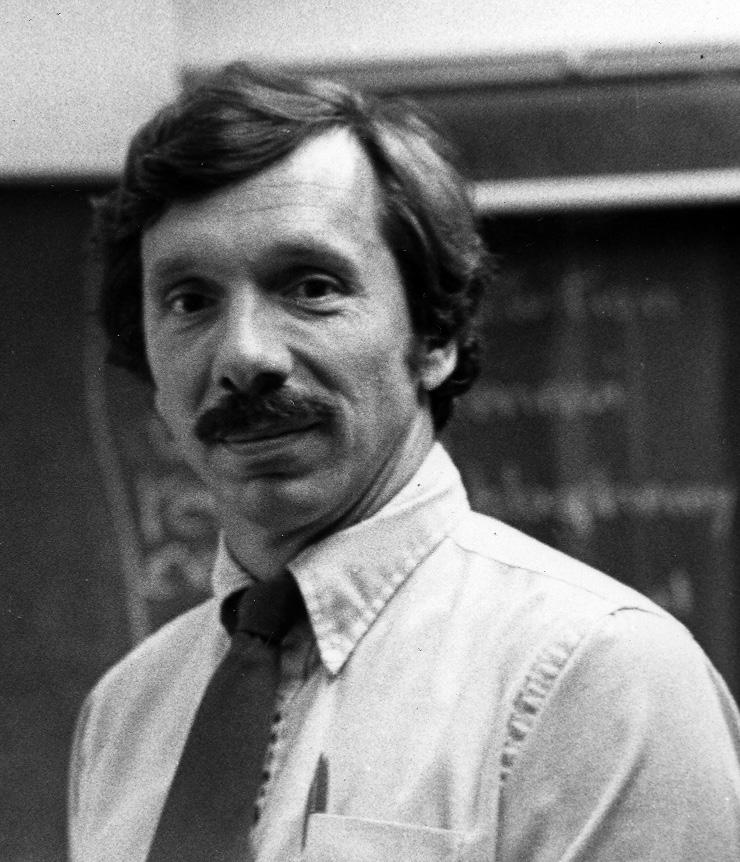
His positive influence impacted students in the classroom and as varsity football coach, varsity baseball coach, and both assistant coach and head coach of the Delaware Blue-Gold All Star Game. He became head football coach in 1973, filling the shoes of the legendary Bob DeGroat who coached Steve at Tower Hill. Steve’s 15-year record included 79 wins, 47 losses and six ties, along with six conference championships. Steve was awarded Coach of the Year in 1984 and 1987.
Steve believed in the life lessons one could learn from striving for excellence, teamwork and competition. He was multifaceted and played the piano and acted in faculty plays. He loved telling stories, often pausing and savoring some marvelous, unknown details about the lives of famous figures.
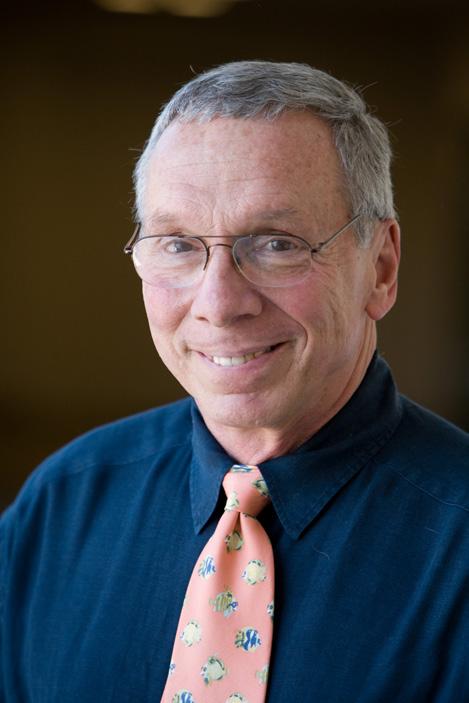
HYDE ’59
“Whether you had him as a teacher, a coach, or if you were lucky you had him as both, you learned life lessons that are likely still important to you today no matter how long ago you learned them.” Jay Pierson ’87.
“Steve Hyde changed my life when he arrived at THS in the fall of my freshman year. He was a swashbuckling leader who ensured that his players had as much swagger as him. More importantly, he reinforced the trifecta of hard work, team work and class work. But the reason that Coach Hyde was one of the first guests on my TV show (tough booking by the way) was his conviction that only our beliefs would hold us back from achieving greatness. Coach Hyde wanted us to have as much confidence in our abilities as he did. It worked. We started to believe that we could defeat large public schools and even end a 13-year streak of losses to dreaded Friends football. Both came true and our lowly football team won the conference championship by my senior year. Coach Hyde launched a generation of THS graduates into the stratosphere and most shared his many lessons with their children and collaborators, just like me. We love you coach and will miss you terribly.” Mehmet Oz, M.D., ’78
The Hyde family has deep ties with Tower Hill, with Steve’s three children having attended: Michael Hyde ’87, Alix Hyde Barrale ’89 and Kathleen Hyde ’92, as well as his four siblings: George Hyde ’44, Elizabeth Eaton ’46, John Hyde ’48 and Arthur Hyde ’52
The Hyde Family Scholarship Fund was established in 1990 with an initial gift from Mrs. George A. Hyde; the fund honors all members of the Hyde family who attended Tower Hill School. Income from this fund supports deserving students enrolled in grades 7 through 12. Steve believed in the power of school communities and going the extra mile for students.
We will remember Steve as an exceptional human being who touched the lives of so many at Tower Hill. His enthusiasm, passion and friendship have made a profound impact within the Tower Hill community, and his legacy will surely live on in the hearts and minds of all those fortunate enough to have known him. If we listen hard enough, we can hear his wonderful laugh, rooting on Tower Hill as well as his many friends and former students!
93 Tower Hill Bulletin Fall 2023 ALUMNI NEWS
CONDOLENCES
Tower Hill mourns the loss of Nancy Keith LeFevre ’53 who passed away on June 24. LeFevre holds the Tower Hill record for most varsity letters at 16: six in field hockey, five in basketball, three in softball and two in tennis. She started varsity level sports in seventh grade, and her record is still unbroken, although Caitlin Smith ’23 tied the record. LeFevre was inducted into the inaugural class of the school’s Athletic Hall of Fame in 2021.
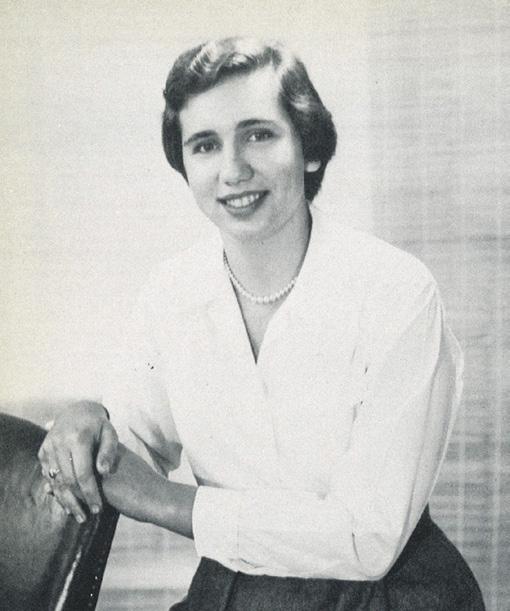
CLASS NOTES ’60s
Jon Marvel ’65 and his son, Adam, visited campus from Idaho earlier this month. Jon’s grandfather, Josiah Marvel, was one the school’s founders in 1919. Jon attended Tower Hill from 1951-1960 before leaving after eighth grade to attend Phillips Academy. Pictured is Jon Marvel with Head of School Sarah Baker.
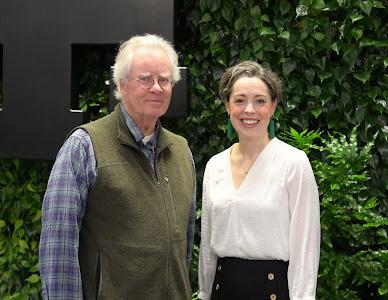
Edward Carpenter White ’49 passed away on June 4.
Robert (Bob) M. Bird III ’62 passed away on May 8.
Bruce Vernon ’63 passed away on April 19.
Kyle St. Claire ’64 passed away on March 26.
Thomas Clarkson Taylor Brokaw ’64 passed away on June 4.
Elizabeth Linville (Beth) Bowen ’69 passed away on Dec. 22.
Tucker Ranken Giddens ’67 passed away on April 9.
Anne Hollyday Flaherty ’71 passed away on March 19.
David Morton ’89 passed away on March 15.
Miles Bingham ’94 passed away on May 3. Constance Logothetis, a former science teacher, passed away on Feb. 16.
Congratulations to Ginger Smith ’66 on being inducted into the Delaware Sports Museum and Hall of Fame! A standout athlete at Tower Hill, Smith was the first Delaware runner to qualify for the Olympic Trials as a 10th grader. Smith has won numerous championships throughout her career, and she has helped pave the way for women’s athletics. She was the first woman to run at the Penn Relays, won the 100m at the 1967 California State Championships for the Millbrae Lions Track Club (prior to Title IX when there was no women’s track team at Stanford University), and was the elected president of the Stanford University Women’s Athletic Association in 1968. Smith was inducted into the Delaware Track & Field Hall of Fame in 1996.
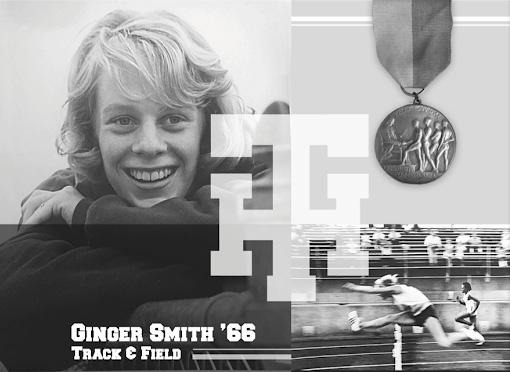
94 Tower Hill Bulletin Fall 2023
CLASS NOTES
’70s
Christopher Byrne’s ’74 latest book A Man of Much Importance: The Art and Life of Terrence McNally was published by Applause in July. Named a “must-read” by Playbill magazine, it has been favorably reviewed, and he has been appearing on various podcasts and TV shows talking about the life and work of one of the leading playwrights of the 20th Century... including how David Shearer inadvertently introduced me to his work when I was in ninth grade.
’80s
In March, a few members of the class of 1987 gathered in Palm Springs to celebrate their 35th Reunion, as well as their gratitude for THS, fond memories and lifelong friendships. They are looking forward to the next! Pictured left to right are: Kira Fuchs, Susan Reed Allabashi, Mary Warren Foulk, Kate Voshell and Sue Lee Kim
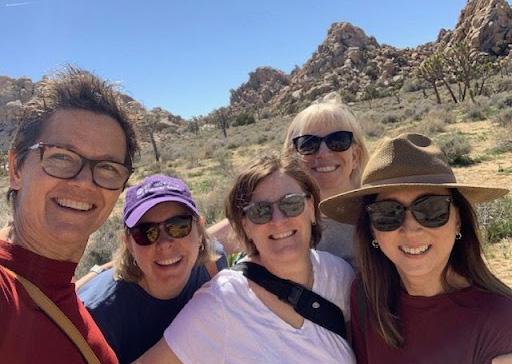
Curtis finished 1st place overall for the Men’s Indoor Pentathlon, 4th place overall in the Men’s Long Jump, 3rd place overall in Men’s High Jump, 2nd in the 4x200m relay, as well as other notable finishes. Justin finished 6th Place overall in the 30-34 age group for the 60m dash.
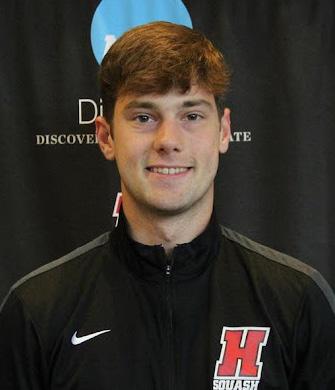
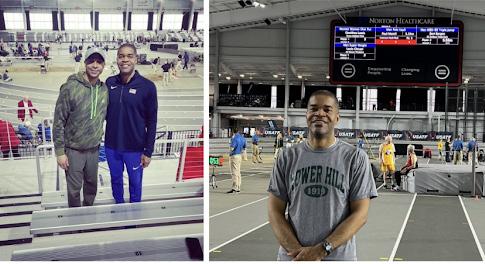
’00s
Tom Villalón ’02 was recently featured in The Atlantic article, “We Are Not Ordinary People.” The article discusses the impact and mission of Rescue Afghan Women Now (RAWN), a group of five Americans, including Villalón, trying to help women and families in Afghanistan. (Read more on page 70.)
’90s
Brett Smith ’08 is currently volunteering as a reunion coordinator for the class of 2008 in anticipation of this year’s Homecoming and Reunion celebrations and, most recently, became a new Tower Hill parent onboarding Carson Smith. The Carson Development group is doing exceptionally well and includes the following THS alumni: Brett Smith ’08, Danielle Smith ’08 and Max Friedman ’10
’20s
The College Squash Association (CSA) ScholarAthlete Award was granted this season to varsity juniors or seniors who have played on the team throughout their college career, earned at least two varsity letters, participated in the majority of
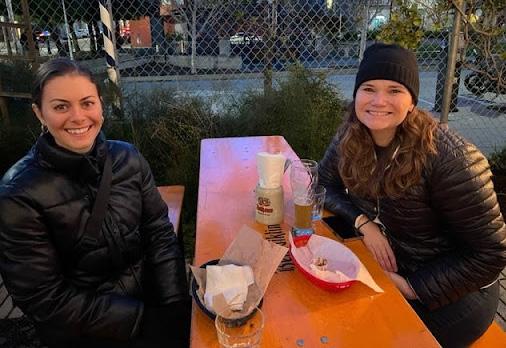
95 Tower Hill Bulletin Fall 2023
Curtis Smith ’99 and Justin Hicks ’09 competed at the 2023 Indoor Master’s National Championships in Louisville, Kentucky. In the 40-44 age group,
Lauren Ianni ’08 and host Maggie Kullman ’08 met up at the Cheers to Hiller Heroes San Fransisco Region Gathering.
ALUMNI NEWS
CLASS NOTES
the team’s matches in the top 10 of the lineup during the season, and achieved a high academic standing at their institution. Ben Schiltz ’20 was selected as one of the representatives who embody the values of the association, specifically including student-athletes achieving a high level of play on court while excelling in the classroom. Haverford finished the 2022-2023 season with a 10-10 record, and the future looks extremely bright. (photo c/o haverfordathletics.com)
WEDDINGS
While attending two college counselor programs in Scotland at the University of Edinburgh and the University of St Andrews, Associate Director of College Counseling, Molly Elton, connected with
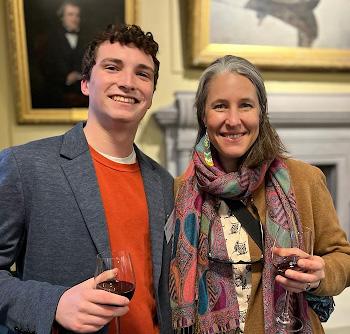
his experience at the University of St Andrews.
Christy Wray Greenberg ’01 and Sam Greenberg ’10 were married on July 3, 2022 in Greenville, Del. They celebrated their marriage surrounded by friends, family and many Tower Hill alumni. Front row; Kelsey Bair-Robinson
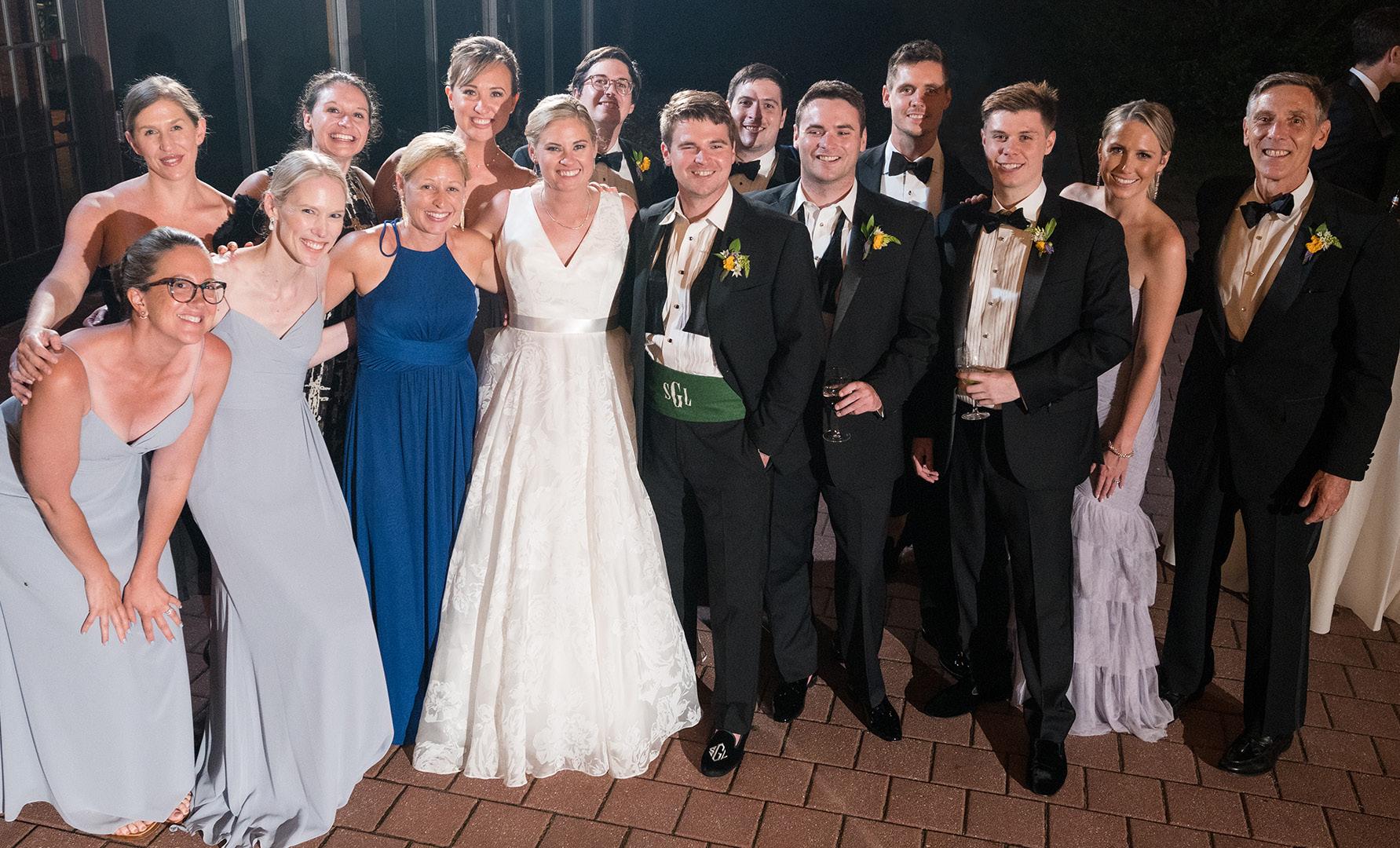
’01, Landon Wellford ’01, Katie Singles ’01, Christy Wray Greenberg
’01, Sam Greenberg ’10, Benjamin Greenberg ’15, Parker Thompson
’17, Abbey Thompson Lyon ’11 and Marc Greenberg ’81. Back row; Becca Chodroff Foran ’01, Lauren Easton
’01, Heidi Johnson Davis ’01, Nick Thompson ’14, Harry Greenberg ’11 and Preston Boyden ’10.
Special thanks to the ALUMNI COUNCIL
Ashley R. Altschuler ’90 - President
Tyler T. Akin ’02
Alisha Wayman Bryson ’91
Ellen Cannon ’72
Deborah E. Colbourn ’92
Christopher R. Donoho III ’87
Charles J. Durante ’69
Baily A. Faller ’20
K. Cole Flickinger ’94
Melissa W. Flynn ’91
Amanda Walker Friz ’92
Victoria Maxmin Gravuer ’86
Thomas J. Hanna ’91
Margaret O. Kullman ’08
Peter E. Larned, D.P.M. ’02
Jeffrey Liu ’84
John C. Pierson III ’87
Catherine R. Salva, MD, MSEd ’90
H. Wesley Schwandt ’86
Curtis R. Smith, Jr. ’99
Susan Wood Waesco ’90
Tarra Boulden Winchell, OD ’01
Mona G. Yezdani, MD ’01
96 Tower Hill Bulletin Fall 2023
Dylan Bemis ’21. Dylan is enjoying
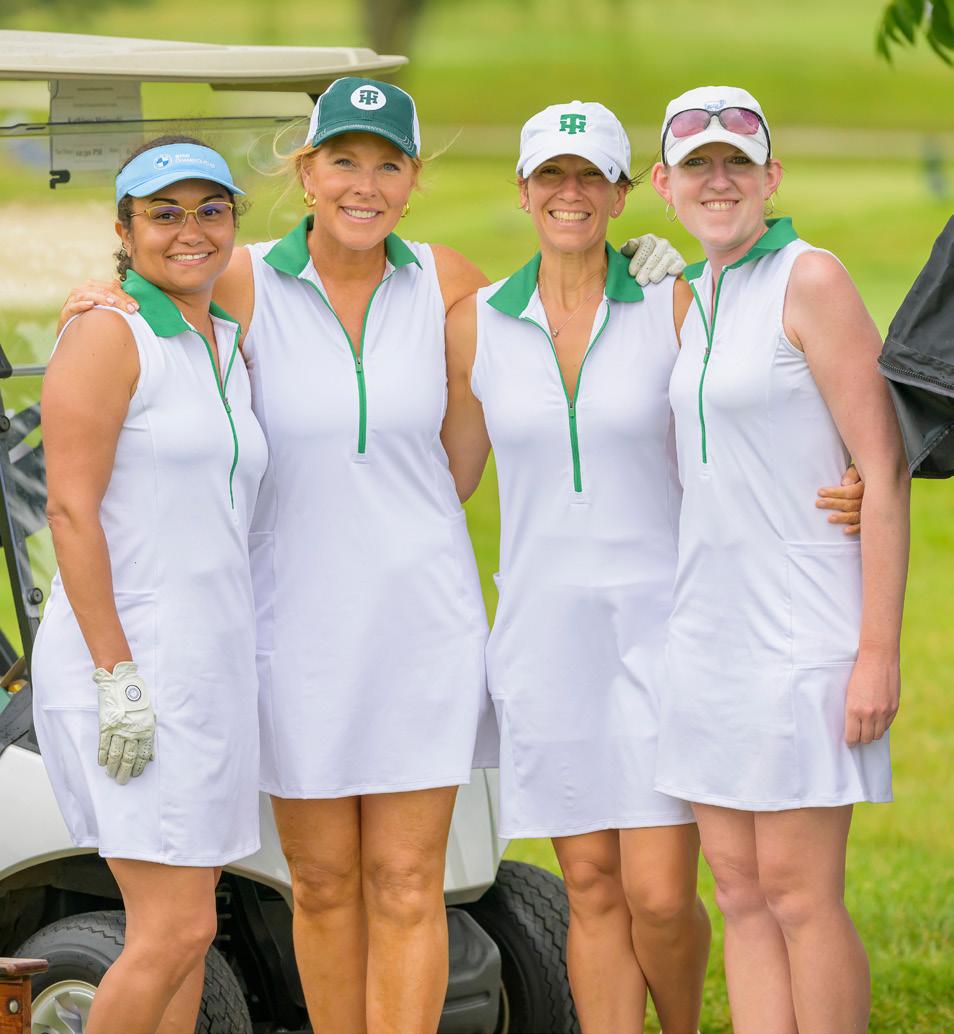

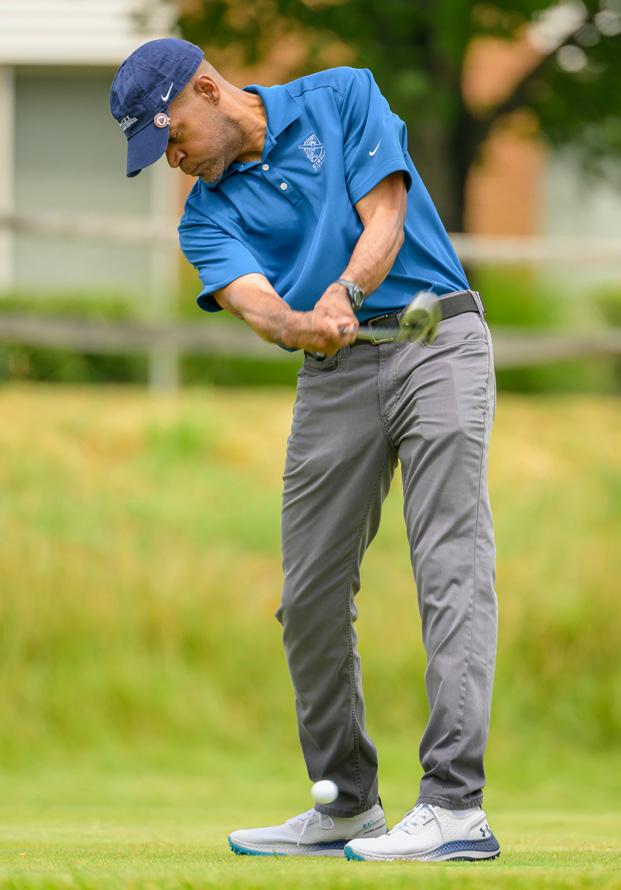
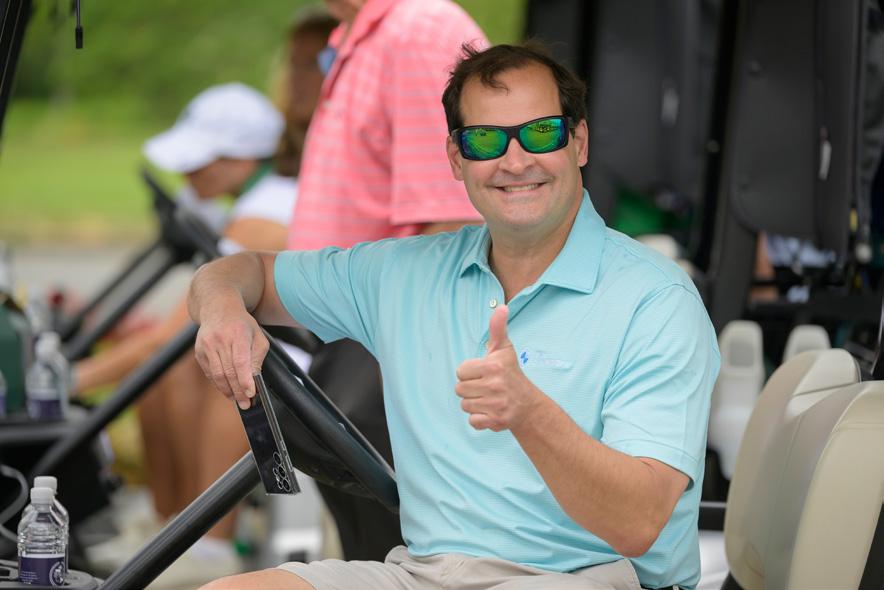

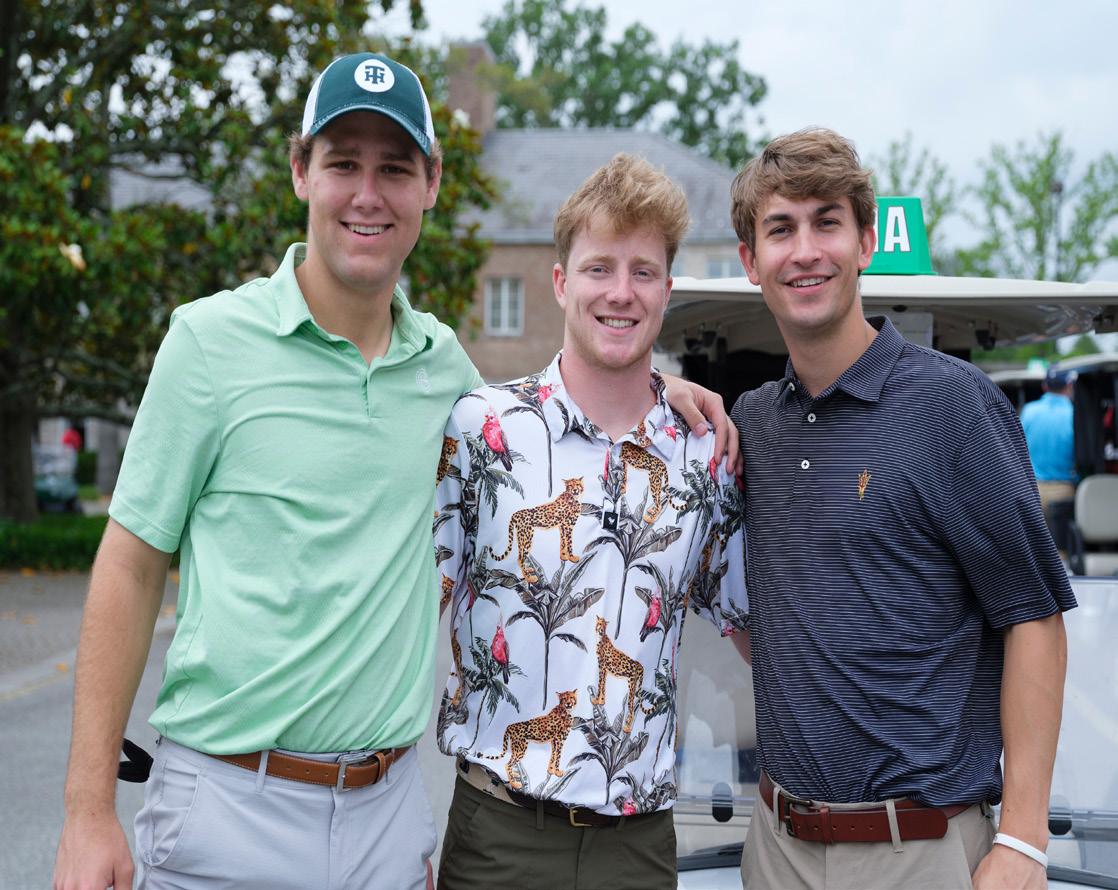
97 Tower Hill Bulletin Fall 2023
GOLF OUTING
ALUMNI NEWS 1 2 3 4 5 6
1. (L-R): Louise Cummings, Kara Vanni, Katheleen Majewski, Andrea Grier. 2. (L-R): Matt Martelli, Vicky Martelli, Peter Gillen, Mona Yezdani
Gillen ’01 The girls White Team completes in the Pole Relay. 3. (L-R): Curtis Smith ’ 99 takes a shot. 4. Young alumni Guthrie Speers ’19, Teddy Hughes ’19 and DJ Scott ’19 5. Golfers out on the course. 6. Alumni Council President Ash Altschuler ’90
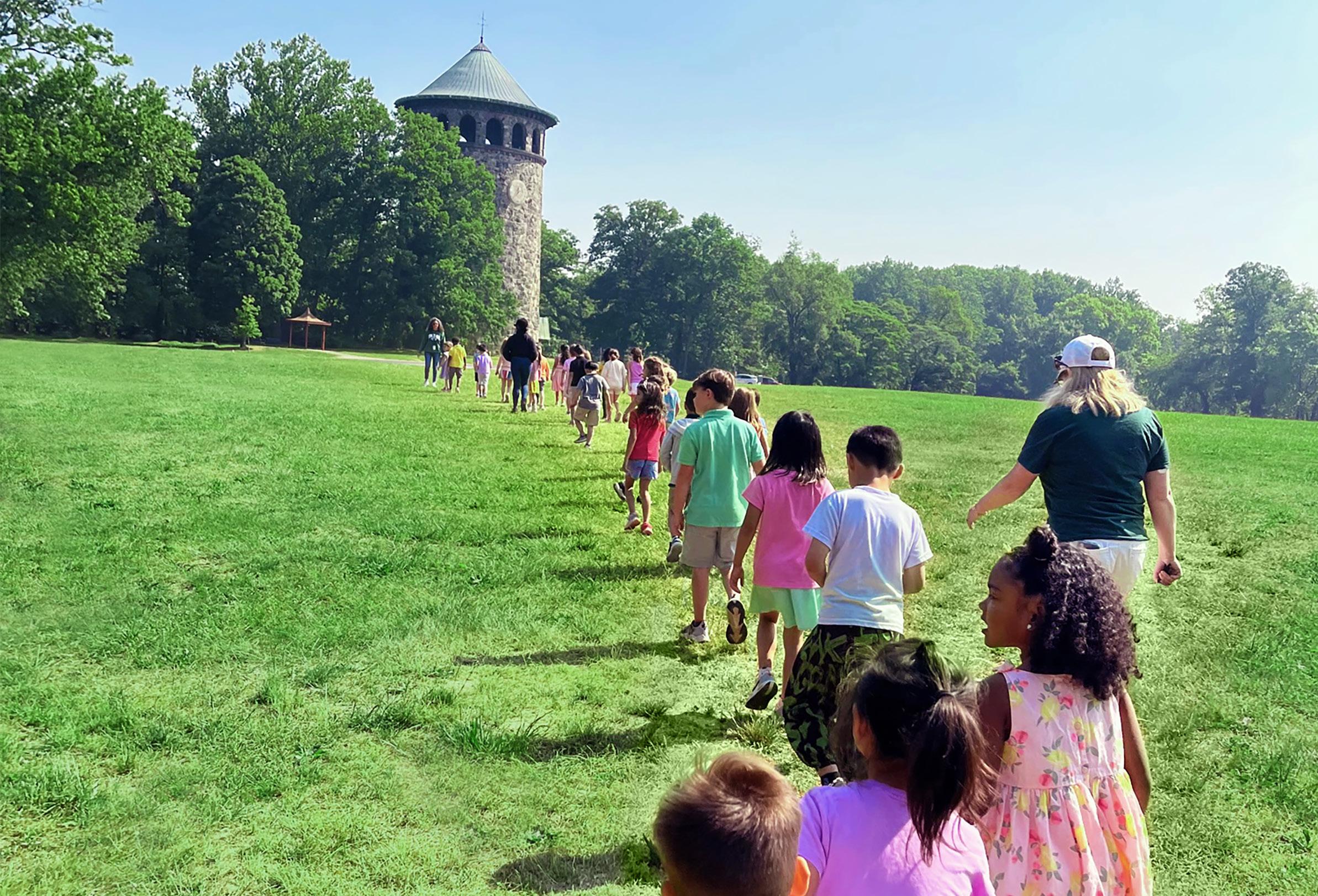
School 2813 West 17th Street
Tower Hill
Wilmington, DE 19806


 Sarah Baker moved into the school’s house, Hayward House, this summer and looks forward to welcoming the community at events this school year as Head of School.
Sarah Baker moved into the school’s house, Hayward House, this summer and looks forward to welcoming the community at events this school year as Head of School.
















































 — Elizabeth C. Speers 10th Head of School
— Elizabeth C. Speers 10th Head of School


 — Miriam Pallant, Spanish Faculty Member
— Miriam Pallant, Spanish Faculty Member


























































 BY NATASHA MURRAY-EVERETT, DIRECTOR OF SOCIAL JUSTICE
BY NATASHA MURRAY-EVERETT, DIRECTOR OF SOCIAL JUSTICE


























































































































 Kristin B. Mumford Director of Advancement and Enrollment Management
Kristin B. Mumford Director of Advancement and Enrollment Management



















